ZyXEL Communications NBG2105 Wireless Mini Travel Router User Manual Book
ZyXEL Communications Corporation Wireless Mini Travel Router Book
Users Manual

Quick Start Guide
www.zyxel.com
NBG2105
Wireless Mini Travel Router
Version 1.00
Edition 1, 11/2012
Copyright © 2012 ZyXEL Communications Corporation
User’s Guide
Default Login Details
LAN IP Address 192.168.1.1 (Router Mode)
192.168.1.2 (Other Modes)
Password 1234

NBG2105 User’s Guide2
IMPORTANT!
READ CAREFULLY BEFORE USE.
KEEP THIS GUIDE FOR FUTURE REFERENCE.
Screenshots and graphics in this book may differ slightly from your product due to differences in
your product firmware or your computer operating system. Every effort has been made to ensure
that the information in this manual is accurate.
Related Documentation
•Quick Start Guide
The Quick Start Guide shows how to connect the NBG2105 and access the Web Configurator. It
contains information on setting up your wireless network.

Contents Overview
NBG2105 User’s Guide 3
Contents Overview
User’s Guide .......................................................................................................................................11
Introduction .............................................................................................................................................13
Introducing the Web Configurator ...........................................................................................................19
Operation Modes .....................................................................................................................................21
Router Setup Wizard ...............................................................................................................................33
AP Setup Wizard .....................................................................................................................................41
Client Setup Wizard ................................................................................................................................45
WISP+UR Setup Wizard .........................................................................................................................51
Tutorials ..................................................................................................................................................59
Technical Reference ..........................................................................................................................67
LAN .........................................................................................................................................................69
WAN ........................................................................................................................................................73
Quality of Service (QoS) .........................................................................................................................79
Dynamic DNS (DDNS) ............................................................................................................................81
Wireless LAN ..........................................................................................................................................83
Firewall ....................................................................................................................................................99
Management .........................................................................................................................................105
Status .................................................................................................................................................... 111
Troubleshooting ....................................................................................................................................121

Contents Overview
NBG2105 User’s Guide
4

Table of Contents
NBG2105 User’s Guide 5
Table of Contents
Contents Overview ..............................................................................................................................3
Table of Contents .................................................................................................................................5
Part I: User’s Guide ......................................................................................... 11
Chapter 1
Introduction.........................................................................................................................................13
1.1 Overview ...........................................................................................................................................13
1.2 Applications .......................................................................................................................................13
1.3 Ways to Manage the NBG2105 ........................................................................................................13
1.4 Good Habits for Managing the NBG2105 .........................................................................................13
1.5 Resetting the NBG2105 ....................................................................................................................14
1.5.1 How to Use the RESET Button ................................................................................................14
1.6 The WPS Button ...............................................................................................................................14
1.7 The Clone MAC Button .....................................................................................................................15
1.7.1 Cloning a computer's MAC address ........................................................................................15
1.7.2 Restoring the default MAC address .........................................................................................15
1.8 General Hardware Features .............................................................................................................16
1.8.1 LEDs ........................................................................................................................................17
Chapter 2
Introducing the Web Configurator ....................................................................................................19
2.1 Overview ...........................................................................................................................................19
2.2 Accessing the Web Configurator .......................................................................................................19
2.2.1 Login Screen ...........................................................................................................................20
Chapter 3
Operation Modes ................................................................................................................................21
3.1 Overview ...........................................................................................................................................21
3.2 What You Can Do .............................................................................................................................21
3.3 Router Mode .....................................................................................................................................21
3.3.1 Setting Router Mode ................................................................................................................22
3.3.2 Navigation Panel .....................................................................................................................22
3.4 Access Point Mode ...........................................................................................................................24
3.4.1 Setting Access Point Mode ......................................................................................................25
3.4.2 Navigation Panel .....................................................................................................................25
3.5 Client Mode .......................................................................................................................................27

Table of Contents
NBG2105 User’s Guide
6
3.5.1 Setting Client Mode .................................................................................................................27
3.5.2 Navigation Panel .....................................................................................................................27
3.6 WISP + UR Mode ..............................................................................................................................29
3.6.1 Setting WISP + UR Mode ........................................................................................................29
3.6.2 Navigation Panel .....................................................................................................................29
Chapter 4
Router Setup Wizard ..........................................................................................................................33
4.1 Overview ...........................................................................................................................................33
4.2 Welcome Screen ...............................................................................................................................33
4.3 WAN Interface Setup ........................................................................................................................33
4.3.1 WAN Access Type: Static IP ....................................................................................................34
4.3.2 WAN Access Type: DHCP Client .............................................................................................34
4.3.3 WAN Access Type: PPPoE .....................................................................................................35
4.4 Wireless Network Name (SSID) Setup .............................................................................................36
4.5 Wireless Security ..............................................................................................................................36
4.5.1 Encryption: None .....................................................................................................................37
4.5.2 Encryption: WEP .....................................................................................................................37
4.5.3 Encryption: WPA-PSK, WPA2-PSK or WPA2-PSK Mixed .......................................................38
Chapter 5
AP Setup Wizard.................................................................................................................................41
5.1 Overview ...........................................................................................................................................41
5.2 Welcome Screen ...............................................................................................................................41
5.3 Wireless Network Name (SSID) Setup .............................................................................................41
5.4 Wireless Security ..............................................................................................................................42
5.4.1 Encryption: None .....................................................................................................................42
5.4.2 Encryption: WEP .....................................................................................................................43
5.4.3 Encryption: WPA-PSK, WPA2-PSK or WPA2-PSK Mixed .......................................................44
Chapter 6
Client Setup Wizard............................................................................................................................45
6.1 Overview ...........................................................................................................................................45
6.2 Welcome Screen ...............................................................................................................................45
6.3 Wireless Network Name Setup .........................................................................................................45
6.4 Wireless Security ..............................................................................................................................47
6.4.1 Encryption: None .....................................................................................................................47
6.4.2 Encryption: WEP .....................................................................................................................47
6.4.3 Encryption: WPA-PSK or WPA2-PSK ......................................................................................48
Chapter 7
WISP+UR Setup Wizard......................................................................................................................51
7.1 Overview ...........................................................................................................................................51

Table of Contents
NBG2105 User’s Guide 7
7.2 Welcome Screen ...............................................................................................................................51
7.3 WAN Interface Setup ........................................................................................................................51
7.3.1 Static IP ...................................................................................................................................51
7.3.2 DHCP Client ............................................................................................................................52
7.3.3 PPPoE .....................................................................................................................................53
7.4 Wireless Network Name Setup .........................................................................................................54
7.5 Wireless Security ..............................................................................................................................55
7.5.1 Encryption: None .....................................................................................................................55
7.5.2 Encryption: WEP .....................................................................................................................56
7.5.3 Encryption: WPA-PSK or WPA2-PSK ......................................................................................56
Chapter 8
Tutorials...............................................................................................................................................59
8.1 Overview ...........................................................................................................................................59
8.2 Set Up a Wireless Network with WPS ...............................................................................................59
8.2.1 Push Button Configuration (PBC) ............................................................................................59
8.2.2 PIN Configuration ....................................................................................................................60
8.3 Configure Wireless Security without WPS ........................................................................................61
8.3.1 Configure Your Notebook ........................................................................................................63
Part II: Technical Reference............................................................................ 67
Chapter 9
LAN ......................................................................................................................................................69
9.1 Overview ...........................................................................................................................................69
9.2 What You Can Do .............................................................................................................................69
9.3 What You Need To Know ..................................................................................................................69
9.3.1 IP Pool Setup ...........................................................................................................................70
9.3.2 LAN TCP/IP .............................................................................................................................70
9.4 LAN Interface Setup Screen .............................................................................................................70
9.4.1 Active DHCP Client Screen .....................................................................................................71
Chapter 10
WAN .....................................................................................................................................................73
10.1 Overview .........................................................................................................................................73
10.2 What You Can Do ...........................................................................................................................73
10.3 What You Need To Know ................................................................................................................73
10.3.1 Configuring Your Internet Connection ....................................................................................73
10.4 WAN Interface Setup ......................................................................................................................74
10.4.1 Static IP .................................................................................................................................74
10.4.2 DHCP Client ..........................................................................................................................75

Table of Contents
NBG2105 User’s Guide
8
10.4.3 PPPoE ...................................................................................................................................76
Chapter 11
Quality of Service (QoS).....................................................................................................................79
11.1 Overview .........................................................................................................................................79
11.2 QoS Setup Screen ..........................................................................................................................79
Chapter 12
Dynamic DNS (DDNS).........................................................................................................................81
12.1 Overview .........................................................................................................................................81
12.2 What You Need To Know ................................................................................................................81
12.3 Dynamic DNS ..................................................................................................................................81
Chapter 13
Wireless LAN.......................................................................................................................................83
13.1 Overview .........................................................................................................................................83
13.1.1 What You Can Do ..................................................................................................................83
13.1.2 What You Should Know .........................................................................................................84
13.2 Wireless Basic Screen ....................................................................................................................86
13.3 Active Wireless Clients Screen .......................................................................................................87
13.4 Advanced Wireless Settings Screen ...............................................................................................88
13.5 Wireless Security ............................................................................................................................89
13.5.1 Disabled .................................................................................................................................89
13.5.2 WEP Encryption ....................................................................................................................90
13.5.3 WPA-PSK/WPA2-PSK/WPA2-PSK Mixed .............................................................................91
13.6 Site Survey Screen .........................................................................................................................92
13.7 Site Survey: Wireless Security ........................................................................................................93
13.7.1 None ......................................................................................................................................93
13.7.2 WEP Encryption ....................................................................................................................93
13.7.3 WPA-PSK/WPA2-PSK Encryption .........................................................................................94
13.8 WPS Screen ....................................................................................................................................95
13.9 MAC Filtering Screen ......................................................................................................................97
Chapter 14
Firewall ................................................................................................................................................99
14.1 Overview .........................................................................................................................................99
14.2 What You Can Do ...........................................................................................................................99
14.3 What You Need To Know ................................................................................................................99
14.4 Port Filtering Screen .....................................................................................................................100
14.5 IP Filtering Screen .........................................................................................................................101
14.6 MAC Filtering Screen ....................................................................................................................101
14.7 URL Filtering Screen .....................................................................................................................102

Table of Contents
NBG2105 User’s Guide 9
Chapter 15
Management......................................................................................................................................105
15.1 Overview .......................................................................................................................................105
15.2 What You Can Do .........................................................................................................................105
15.3 NTP Screen ...................................................................................................................................105
15.4 Password Screen ..........................................................................................................................106
15.5 Upgrade Firmware Screen ............................................................................................................107
15.6 Backup/Restore Screen ................................................................................................................108
15.7 Router Operation Mode Screen ....................................................................................................109
15.8 Language Screen ..........................................................................................................................109
15.9 Restart Screen .............................................................................................................................. 110
Chapter 16
Status................................................................................................................................................. 111
16.1 Overview ....................................................................................................................................... 111
16.2 What You Can Do ......................................................................................................................... 111
16.3 Status Screen ................................................................................................................................ 111
16.3.1 Router Mode ........................................................................................................................ 111
16.3.2 AP Mode .............................................................................................................................. 113
16.3.3 Client Mode .........................................................................................................................114
16.3.4 WISP+UR Mode .................................................................................................................. 115
16.4 Statistics Screen ............................................................................................................................117
16.5 System Log Screen .......................................................................................................................118
Chapter 17
Troubleshooting................................................................................................................................121
17.1 Overview .......................................................................................................................................121
17.2 Power, Hardware Connections, and LEDs ....................................................................................121
17.3 NBG2105 Access and Login .........................................................................................................122
17.4 Internet Access .............................................................................................................................123
17.5 Resetting the NBG2105 to Its Factory Defaults ............................................................................124
17.6 Wireless LAN Connections ...........................................................................................................125
Appendix A Pop-up Windows, JavaScript and Java Permissions ...................................................127
Appendix B Legal Information..........................................................................................................137
Index ..................................................................................................................................................143

Table of Contents
NBG2105 User’s Guide
10

11
PART I
User’s Guide

12

NBG2105 User’s Guide 13
CHAPTER 1
Introduction
1.1 Overview
This chapter introduces the main features and applications of the NBG2105.
The NBG2105 extends the range of your existing wired network without additional wiring, providing
easy network access to mobile users. You can set up a wireless network with other IEEE 802.11b/g/
n compatible devices.
A range of services such as a firewall and content filtering are also available for secure Internet
computing.
1.2 Applications
Your can have the following networks using the NBG2105:
•Wired. You can connect network devices via the Ethernet ports of the NBG2105 so that they can
communicate with each other and access the Internet.
•Wireless. Wireless clients can connect to the NBG2105 to access network resources. You can
use WPS (WiFi Protected Setup) to create an instant network connection with another WPS-
compatible device.
•WAN. Connect to a broadband modem/router for Internet access.
1.3 Ways to Manage the NBG2105
Use any of the following methods to manage the NBG2105.
• WPS (Wi-Fi Protected Setup). You can use the WPS button or the WPS section of the Web
Configurator to set up a wireless network with your ZyXEL Device.
• Web Configurator. This is recommended for everyday management of the NBG2105 using a
(supported) web browser.
1.4 Good Habits for Managing the NBG2105
Do the following things regularly to make the NBG2105 more secure and to manage the NBG2105
more effectively.

Chapter 1 Introduction
NBG2105 User’s Guide
14
• Change the password. Use a password that’s not easy to guess and that consists of different
types of characters, such as numbers and letters.
• Write down the password and put it in a safe place.
• Back up the configuration (and make sure you know how to restore it). Restoring an earlier
working configuration may be useful if the device becomes unstable or even crashes. If you
forget your password, you will have to reset the NBG2105 to its factory default settings. If you
backed up an earlier configuration file, you would not have to totally re-configure the NBG2105.
You could simply restore your last configuration.
1.5 Resetting the NBG2105
If you forget your password or IP address, or you cannot access the Web Configurator, you will need
to use the RESET button on the underside of the NBG2105 to reload the factory-default
configuration file. This means that you will lose all configurations that you had previously saved, the
password and the IP address will be reset to the defaults shown on the cover of this user’s guide.
1.5.1 How to Use the RESET Button
1Make sure the power LED is on.
2Press the RESET button for longer than five seconds (when the power LED begins to blink) and
release it to set the NBG2105 back to its factory-default configurations.
1.6 The WPS Button
Your NBG2105 supports WiFi Protected Setup (WPS), which is an easy way to set up a secure
wireless network. WPS is an industry standard specification, defined by the WiFi Alliance.
WPS allows you to quickly set up a wireless network with strong security, without having to
configure security settings manually. Each WPS connection works between two devices. Both
devices must support WPS (check each device’s documentation to make sure).
Depending on the devices you have, you can either press a button (on the device itself, or in its
configuration utility) or enter a PIN (a unique Personal Identification Number that allows one device
to authenticate the other) in each of the two devices. When WPS is activated on a device, it has two
minutes to find another device that also has WPS activated. Then, the two devices connect and set
up a secure network by themselves.
You can use the WPS button to activate WPS in order to quickly set up a wireless network with
strong security.
1Make sure the power LED is on (not blinking).
2Press the WPS button for less than two seconds and release it. Press the WPS button on another
WPS-enabled device within range of the NBG2105.

Chapter 1 Introduction
NBG2105 User’s Guide 15
Note: You must activate WPS in the NBG2105 and in another wireless device within two
minutes of each other.
For more information on using WPS, see Section 8.2 on page 59.
1.7 The Clone MAC Button
Your NBG2105 can clone the MAC address of the computer connected to the NBG2105. It is
recommended that you clone the MAC address prior to hooking up the WAN port or connecting to
an AP or wireless router with Internet access.
Note: MAC cloning is supported only when the NBG2105 is in Router mode.
1.7.1 Cloning a computer's MAC address
1Make sure the power LED is on (not blinking).
2To copy and use the MAC address of a currently connected computer through a wired Ethernet or
wireless LAN connection, press the Clone MAC button for two to five seconds and release it.
3The WPS/MAC Clone LED turns on when the clone was successful.
4The NBG2105 restarts automatically ten seconds after you press the Clone MAC button.
1.7.2 Restoring the default MAC address
1Make sure the power LED is on (not blinking).
2Press and hold the Clone MAC button for more than five seconds to reset the NBG2105 back to the
factory default MAC address. The Clone MAC Address in the WAN screen shows 000000000000 to
indicate the NBG2105 is using the factory default MAC address.
3The NBG2105 restarts after you press the Clone MAC button.
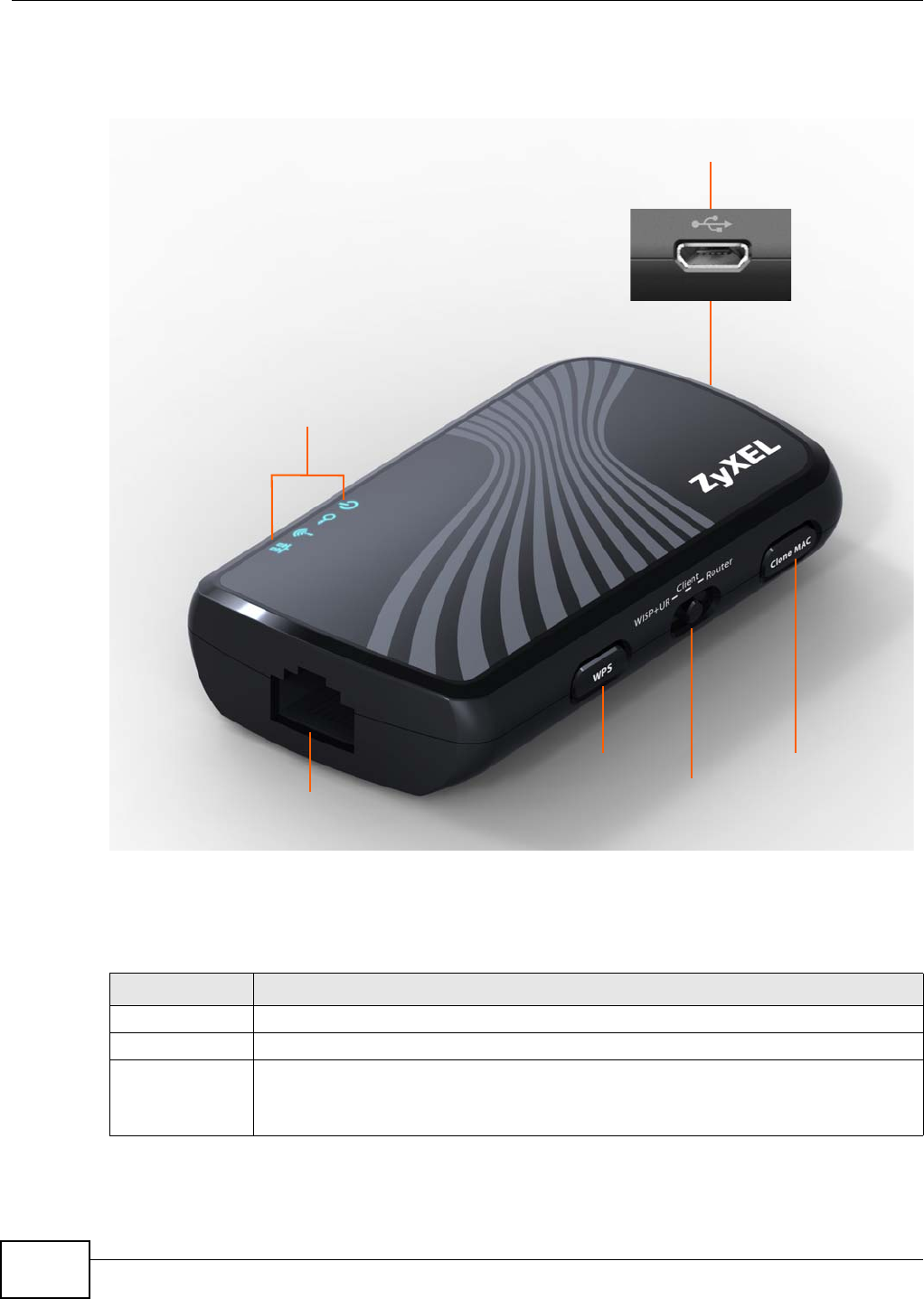
Chapter 1 Introduction
NBG2105 User’s Guide
16
1.8 General Hardware Features
Figure 1 General Hardware Features
The following table describes the LEDs.
Note: WPS is only available with WPA2-PSK security protocol.
Table 1 General Hardware Features
FEATURE DESCRIPTION
Ethernet Connect this to your Ethernet network.
LEDs These show the status of your NBG2105.
WPS In Router/AP or WISP+UR mode, push this for less than 2 seconds to connect to a wireless
client via WPS.
In Client mode, push this for less than 2 seconds to connect to an upstream AP via WPS.
LEDs
Ethernet
WPS
Operation
Mode Switch
Clone
MAC
Micro USB
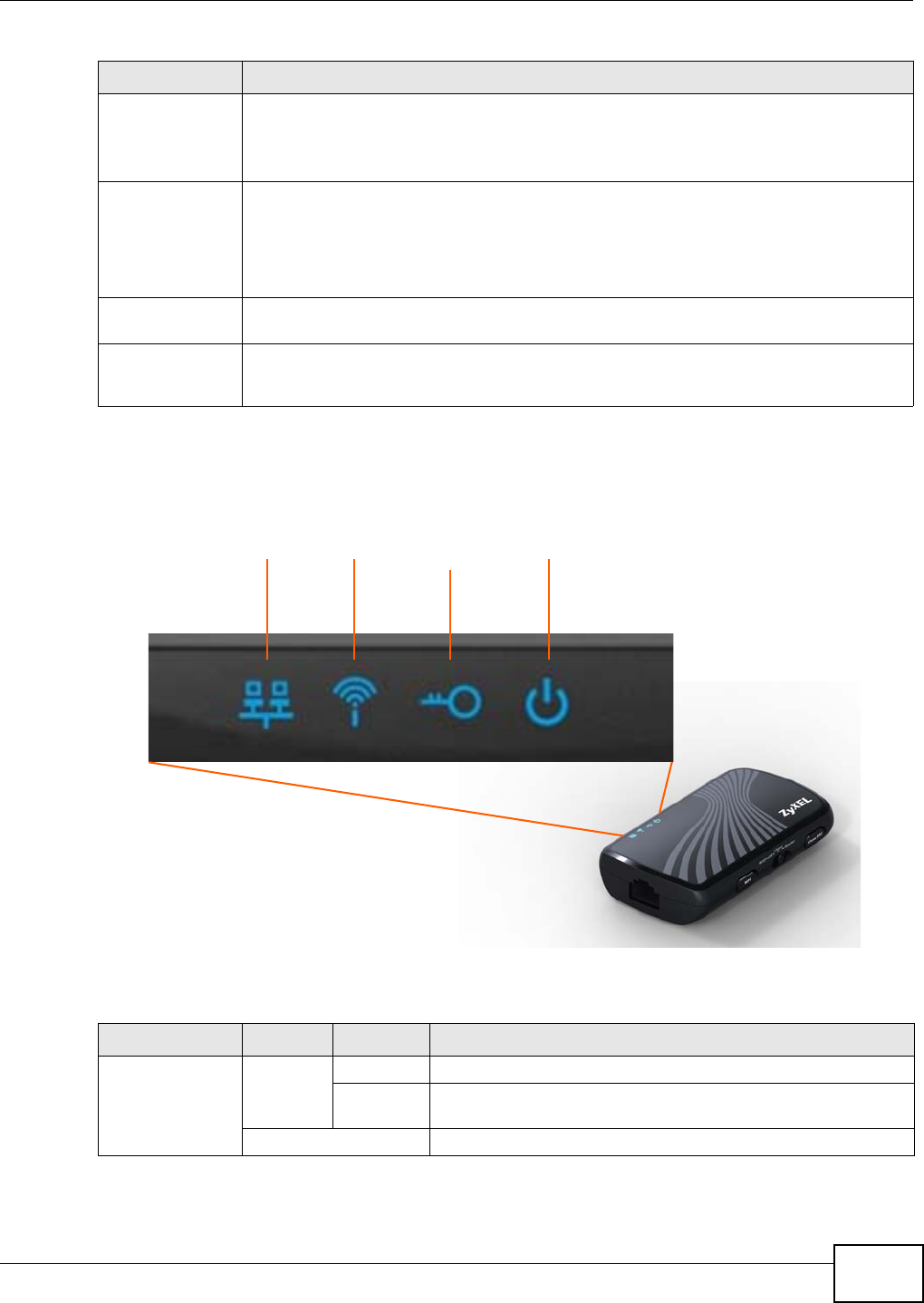
Chapter 1 Introduction
NBG2105 User’s Guide 17
1.8.1 LEDs
Figure 2 Top Panel LEDs
The following table describes the LEDs.
Operation Mode
Switch
Slide this to Router to put the NBG2105 into router or AP mode.
Slide this to Client to put the NBG2105 into WLAN client mode.
Slide this to WISP+UR to put the NBG2105 into WISP+UR mode.
Clone MAC Push this for 2 to 5 seconds to clone the first client's MAC address.
Push this for more than 5 seconds to reset the NBG2105’s MAC address to the factory
default.
Note: This only works in Router mode.
Micro USB Connect this to a power supply or computer. Connect to a computer to use as an Ethernet
interface.
Reset
(on the underside
of the NBG2105)
Push this for more than 5 seconds to reset all NBG2105 settings to factory defaults.
Table 1 General Hardware Features (continued)
FEATURE DESCRIPTION
Table 2 Top Panel LEDs
LED COLOR STATUS DESCRIPTION
Ethernet Blue On The NBG2105’s Ethernet connection is ready.
Blinking The NBG2105 is sending/receiving data through the Ethernet
port.
Off The Ethernet connection is not ready, or has failed.
PowerWLAN WPS/
Ethernet MAC Clone

Chapter 1 Introduction
NBG2105 User’s Guide
18
WLAN Blue On The NBG2105 is ready, but is not sending/receiving data
through the wireless LAN.
Blinking The NBG2105 is sending/receiving data through the wireless
LAN.
Off The wireless LAN is not ready, has failed, or is disabled.
WPS/MAC Clone Blue On WPS/MAC clone is ready.
Blinking The NBG2105 is negotiating a WPS connection with a wireless
client or cloning a MAC address.
Off WPS is disabled or has failed.
This LED is off for ten seconds and then the NBG2105
automatically restarts when MAC cloning has failed.
Power Blue On The NBG2105 is receiving power and functioning properly.
Blinking Boot up process.
The NBG2105 is resetting to factory default settings.
Off The NBG2105 is not receiving power.
Table 2 Top Panel LEDs (continued)
LED COLOR STATUS DESCRIPTION

NBG2105 User’s Guide 19
CHAPTER 2
Introducing the Web Configurator
2.1 Overview
This chapter describes how to access the NBG2105 Web Configurator and provides an overview of
its screens.
The Web Configurator is an HTML-based management interface that allows easy setup and
management of the NBG2105 via Internet browser. Use Internet Explorer 6.0 and later versions,
Mozilla Firefox 3 and later versions, or Safari 2.0 and later versions. The recommended screen
resolution is 1024 by 768 pixels.
In order to use the Web Configurator you need to allow:
• Web browser pop-up windows from your device. Web pop-up blocking is enabled by default in
Windows XP SP (Service Pack) 2.
• JavaScript (enabled by default).
• Java permissions (enabled by default).
Refer to the Troubleshooting chapter (Chapter 17 on page 121) to see how to make sure these
functions are allowed in Internet Explorer.
2.2 Accessing the Web Configurator
The Ethernet port is a WAN port when the NBG2105 is set to Router or AP mode. It is a LAN port
when the NBG2105 is set to WISP+UR or Client mode.
In either mode, users can connect the NBG2105's micro USB port to a computer and install the USB
driver in the computer to access the Web Configurator through a USB-to-Ethernet connection (refer
to the Quick Start Guide).
1Make sure your NBG2105 hardware is properly connected and prepare your computer or computer
network to connect to the NBG2105 (refer to the Quick Start Guide).
Table 3 Accessing the NBG2105
OPERATION MODE THROUGH THE
ETHERNET LAN PORT VIA WIRELESS LAN
CONNECTIONS THROUGH THE
MICRO USB PORT
Router Mode V V
AP Mode V V
Client Mode V V
WISP + UR Mode V V V
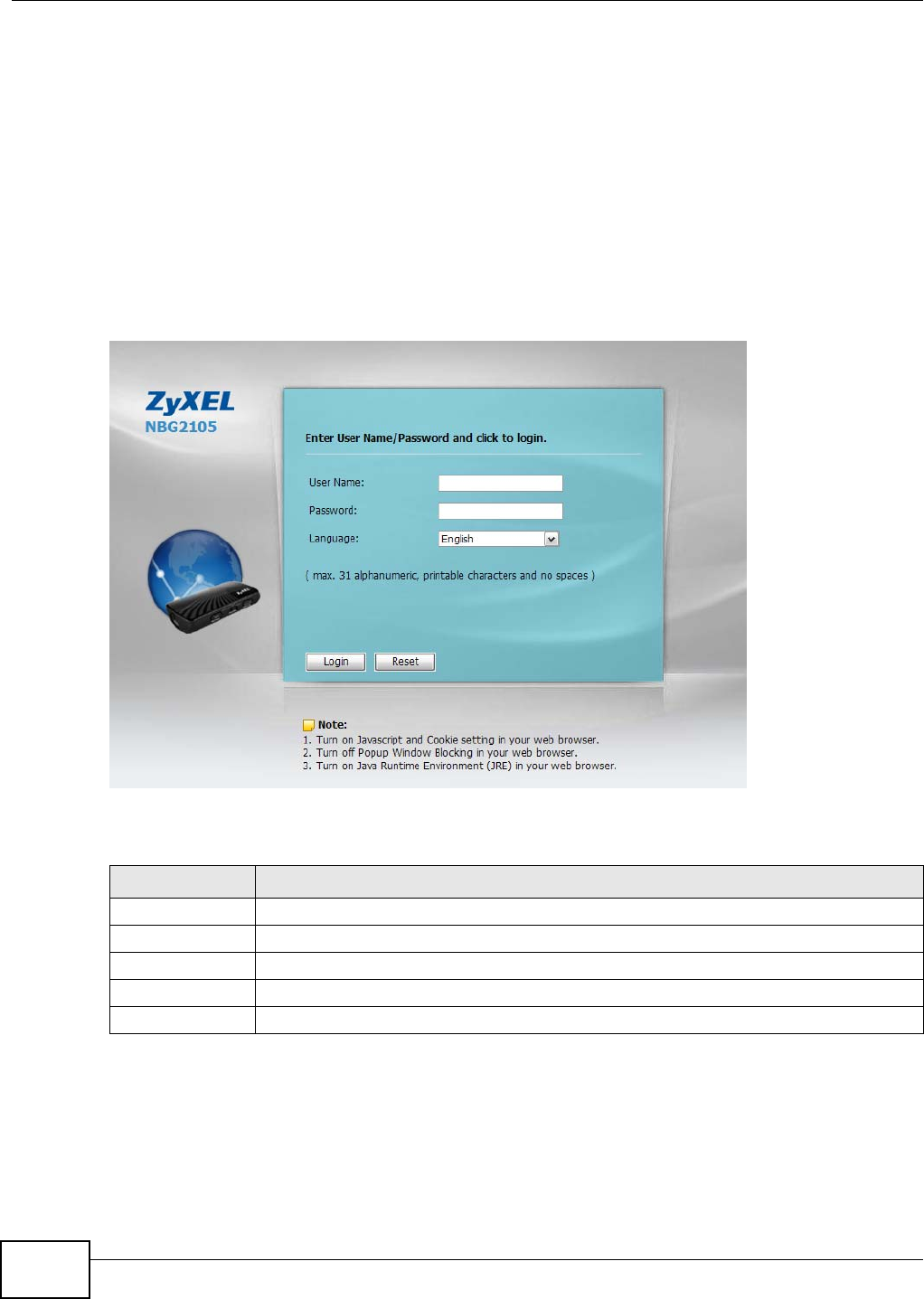
Chapter 2 Introducing the Web Configurator
NBG2105 User’s Guide
20
2Launch your web browser.
3The NBG2105 is in Router mode by default. Type "http://192.168.1.1" as the website address.
If the NBG2105 isn’t in Router mode, the IP address is 192.168.1.2. See Chapter 3 on page 21 for
more information about the modes of the NBG2105.
Your computer must be in the same subnet in order to access this website address.
2.2.1 Login Screen
The Web Configurator initially displays the following login screen.
Figure 3 Login screen
The following table describes the labels in this screen.
Table 4 Login screen
LABEL DESCRIPTION
User Name Type “admin” (default) as the user name.
Password Type "1234" (default) as the password.
Language Select the language you want to use to configure the Web Configurator. Click Login.
Login Click this to login.
Reset Click this to begin configuring this screen afresh.

NBG2105 User’s Guide 21
CHAPTER 3
Operation Modes
3.1 Overview
This chapter introduces the operation modes available on your NBG2105 and how to configure
them. The operation mode is a pre-defined combination of routing, access point (AP) and wireless
client functions to match your network topology and requirements. Use the Operation Mode switch
on the right-side panel (see Section 1.8 on page 16) of the NBG2105 to select the operation mode.
Use the Router Operation Mode screen to configure the selected mode.
3.2 What You Can Do
•Router mode connects the local network to another network, like the Internet. See Section 3.3
on page 21 for details of this mode.
•Access Point mode extends your network by allowing network devices to connect to the
NBG2105 wirelessly. See Section 3.4 on page 24 for details of this mode.
•Client mode enables the NBG2105 to be a wireless client to an upstream AP.
See Section 3.5 on page 27 for details of this mode.
•WISP + UR mode enables the NBG2105 to connect your local network to the Internet through
an ISP’s access point. UR provides Wi-Fi functionality to clients on the LAN side. See Section 3.6
on page 29 for details of this mode.
Note: Choose your operation mode carefully to avoid having to change it later. If you
select the incorrect operation mode you may not be able to connect to the Internet.
When changing to another mode, the IP address of the NBG2105 changes. The
running applications and services of the network devices connected to the
NBG2105 can be interrupted.
Note: In WISP + UR and Client modes, you should know the SSID and wireless security
details of the access point to which you want to connect.
3.3 Router Mode
A router connects your local network with another network, such as the Internet. The router has
two IP addresses, the LAN IP address and the WAN IP address. This mode offers services such as a
firewall, QoS or DDNS.
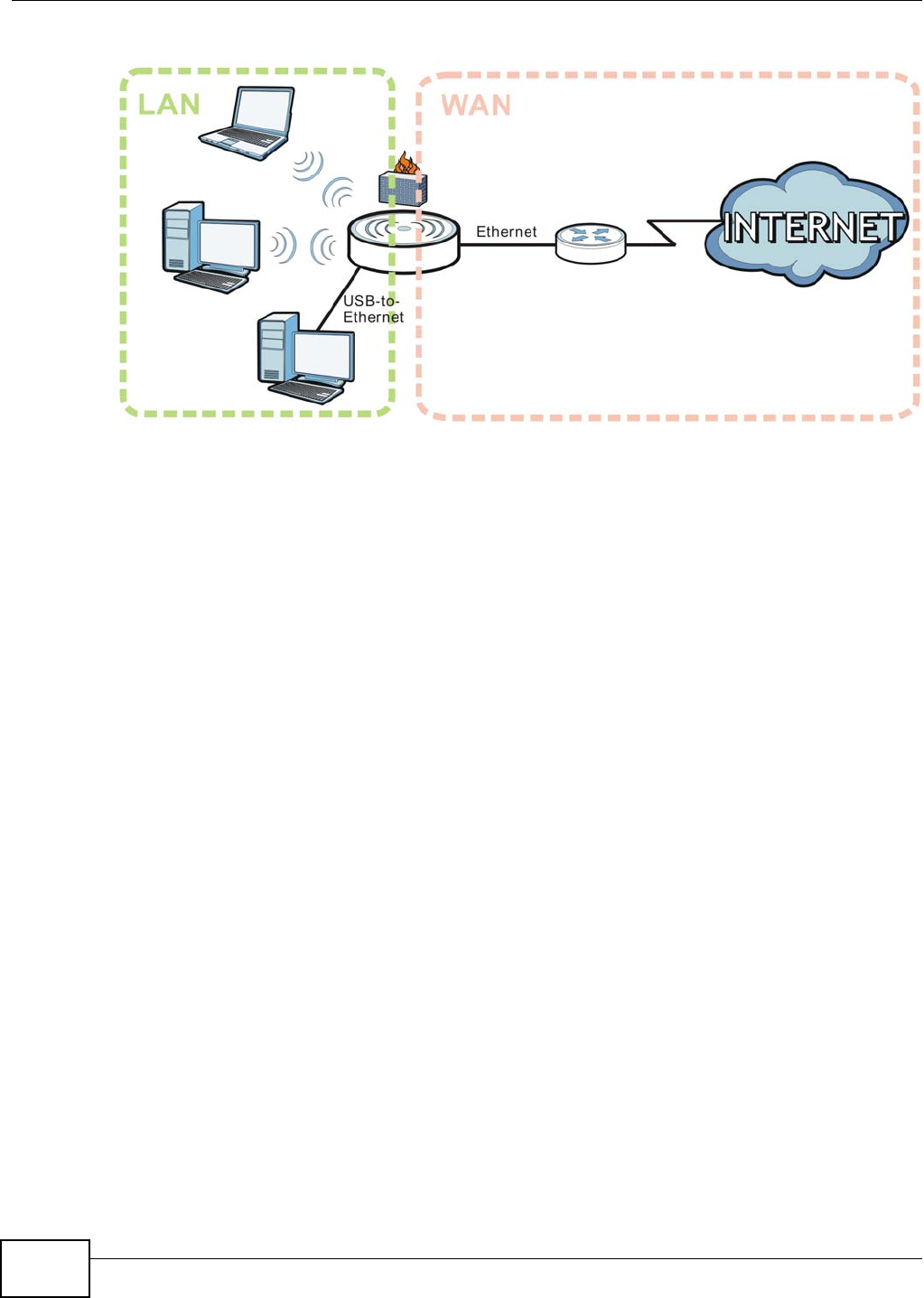
Chapter 3 Operation Modes
NBG2105 User’s Guide
22
Figure 4 Router Mode Application
3.3.1 Setting Router Mode
Select Router mode if your device routes traffic between a local network and another network such
as the Internet. To set Router mode:
1Make sure the power LED is on (not blinking).
2Slide the Operation Mode Switch to Router. See Section 1.8 on page 16.
3The NBG2105 restarts after you slide the Operation Mode Switch.
3.3.2 Navigation Panel
Use the sub-menus on the navigation panel to configure NBG2105 features.
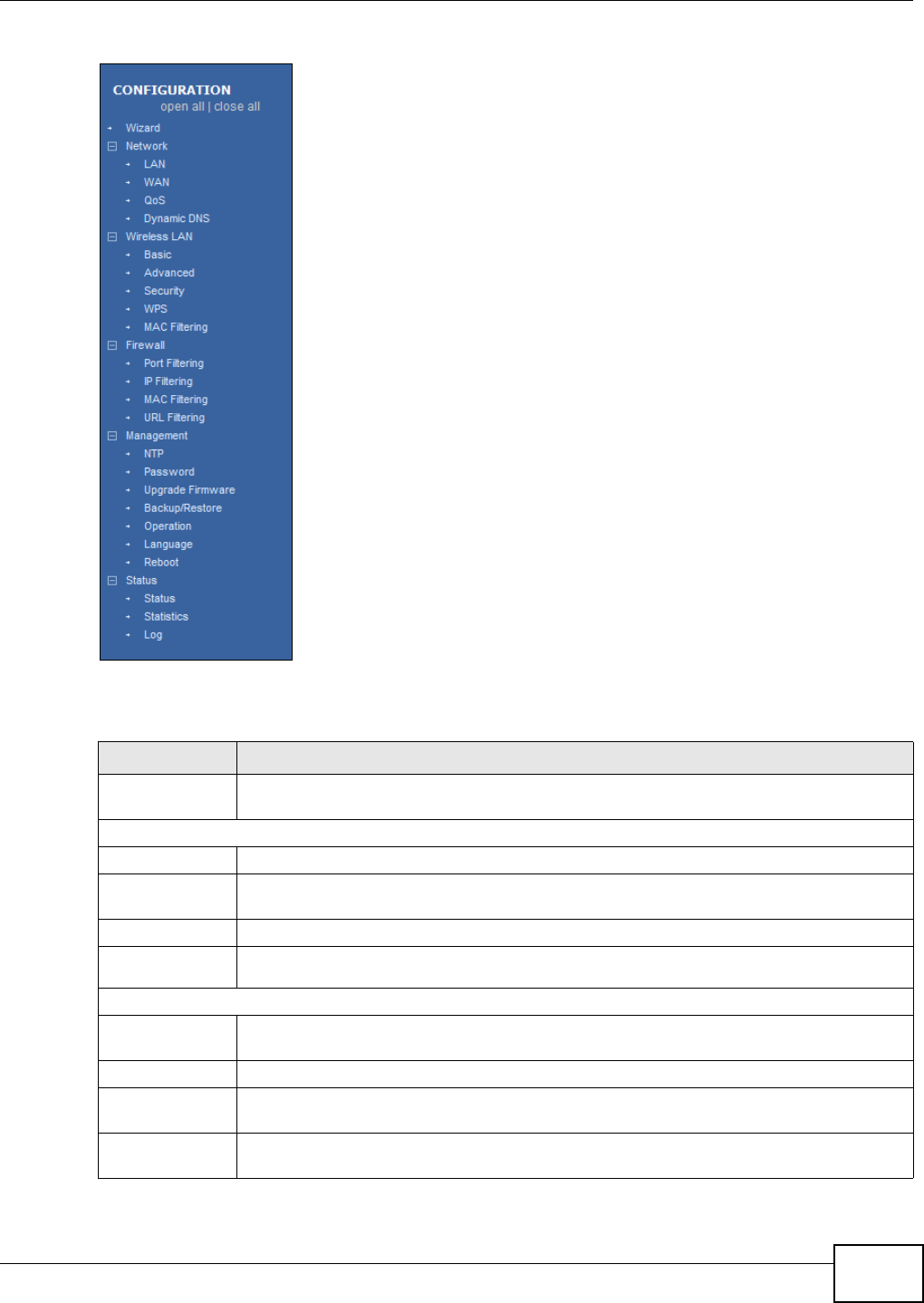
Chapter 3 Operation Modes
NBG2105 User’s Guide 23
Figure 5 Navigation Panel: Router Mode
The following table describes the sub-menus.
Table 5 Navigation Panel: Router Mode
MENU FUNCTION
Wizard The Web Configurator’s wizard setup helps you configure your device in router mode for
the first time.
Network
LAN Use this to configure LAN IP address and subnet mask and DHCP server settings.
WAN Use this allows you to configure ISP parameters, WAN IP address assignment, DNS servers
and the WAN MAC address.
QoS Use this to reserve bandwidth for certain traffic based on the IP address or MAC address.
Dynamic
DNS Use this to configure a domain name with a dynamic IP address.
Wireless LAN
Basic Use this to turn the wireless connection on or off and make other basic configuration
changes.
Advanced Use this to configure the output power and set the RTS/CTS Threshold.
Security Use this to configure no, WEP, WPA-PSK, WPA2-PSK or WPA2-PSK Mixed wireless
encryption.
WPS Use this to quickly set up a wireless network with strong security, without having to
configure security settings manually.

Chapter 3 Operation Modes
NBG2105 User’s Guide
24
3.4 Access Point Mode
An access point enabled all ethernet ports to be bridged together and be in the same subnet. To
connect to the Internet, another device, such as a router, is required. In Access Point Mode:
• All clients belong to the same subnet.
• All clients of the device are LAN clients. There is no WAN connection.
• The DHCP server is disabled.
• The IP address of the device on the local network is set to 192.168.1.2.
MAC Filtering Use this to allow or deny wireless stations based on their MAC addresses from connecting
to the NBG2105.
Firewall
Port Filtering Use this to apply filtering based on UDP or TCP port numbers.
IP Filtering Use this to apply filtering based on IP addresses.
MAC Filtering Use this to apply filtering based on MAC addresses.
URL Filtering Use this to apply filtering based on URLs.
Management
NTP Use this to change your NBG2105’s time and date.
Password Use this to change your NBG2105’s system password.
Upgrade
Firmware Use this to upload firmware to your NBG2105.
Backup/
Restore Use this to view information related to factory defaults, backup configuration, and
restoring configuration.
Operation Use this to change between access point mode and router mode.
Language Use this to select the language you prefer.
Reboot Use this to restart the NBG2105 without turning the power off.
Status
Status Use this to view system, wireless, local and WAN network information, as well as general
information about the NBG2105.
Statistics Use this to show the number of packets sent and received on the Wireless LAN and
Ethernet WAN interfaces.
Log Use this to look at all of the NBG2105’s logs in one location.
Table 5 Navigation Panel: Router Mode (continued)
MENU FUNCTION
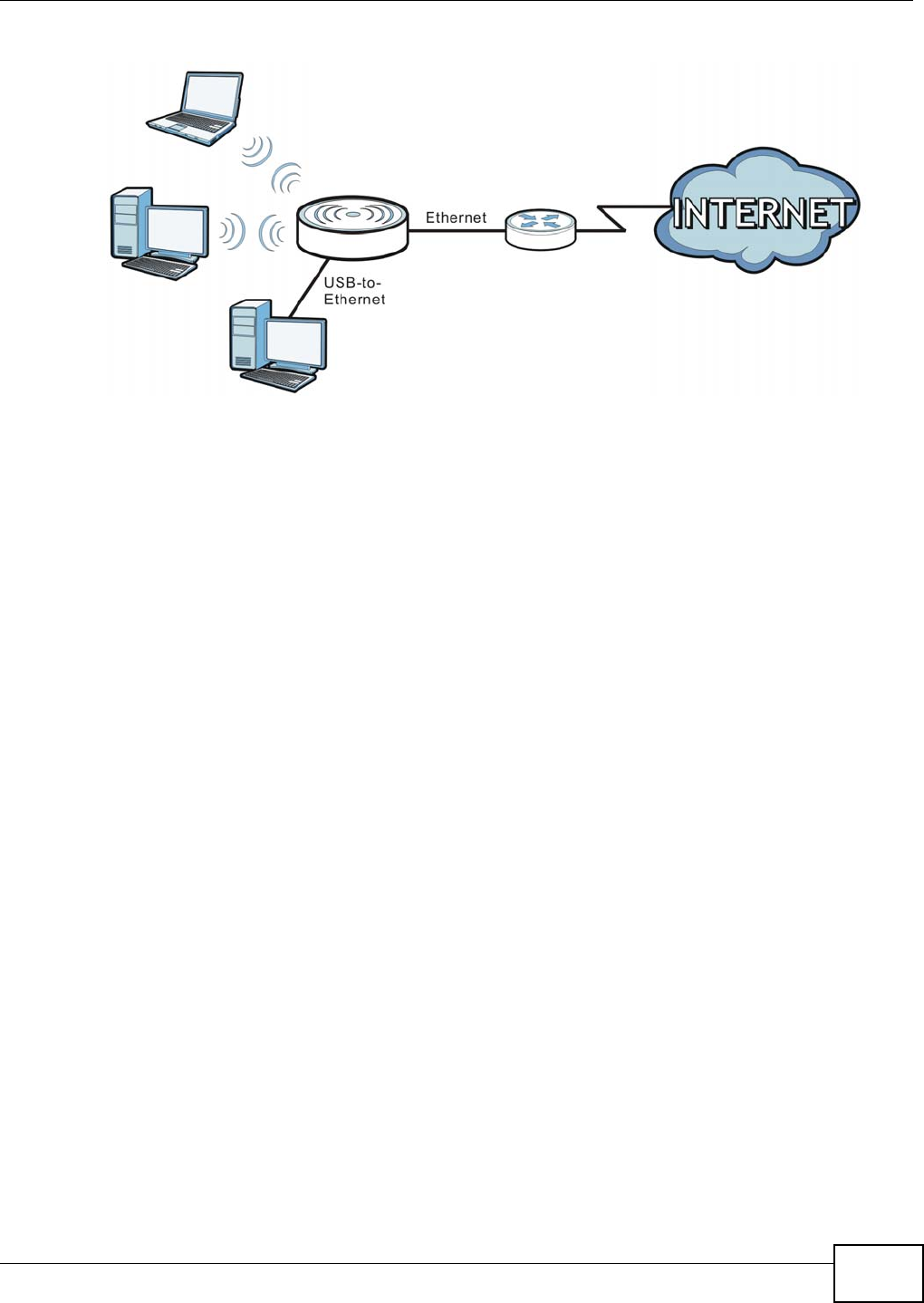
Chapter 3 Operation Modes
NBG2105 User’s Guide 25
Figure 6 Access Point Mode Application
3.4.1 Setting Access Point Mode
Select Access Point Mode if your device bridges traffic between clients on the same network. To set
Access Point mode:
1Make sure the power LED is on (not blinking).
2Slide the Operation Mode Switch to Router. See Section 1.8 on page 16.
3The NBG2105 restarts after you slide the Operation Mode Switch.
4In the Web Configuator, click Management > Operation, select AP and then click Apply
Changes.
3.4.2 Navigation Panel
Use the sub-menus on the navigation panel to configure NBG2105 features.
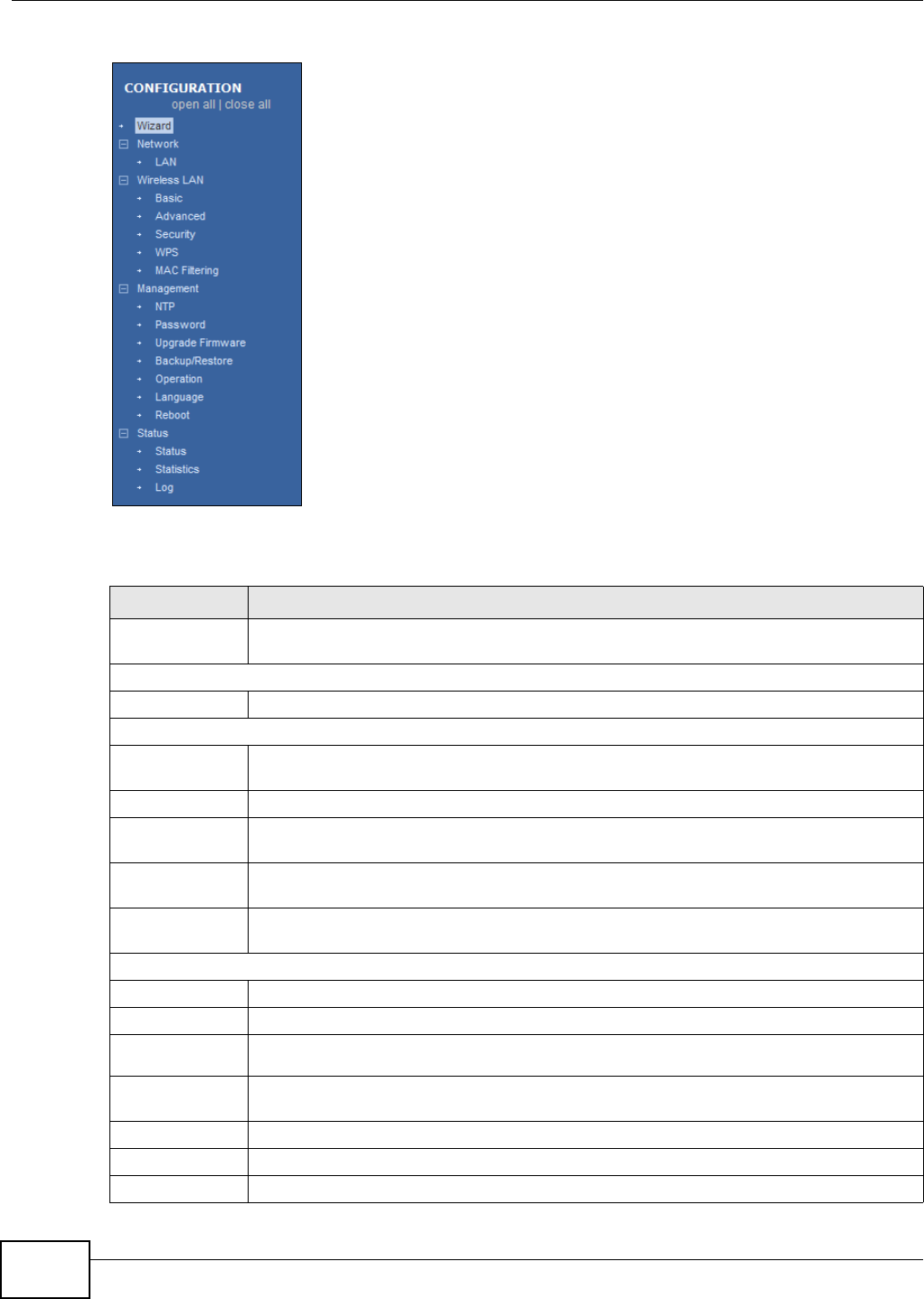
Chapter 3 Operation Modes
NBG2105 User’s Guide
26
Figure 7 Navigation Panel: Access Point Mode
The following table describes the sub-menus.
Table 6 Navigation Panel: Access Point Mode
MENU FUNCTION
Wizard The Web Configurator’s wizard setup helps you configure your device in AP mode for the
first time.
Network
LAN Use this to configure LAN IP address and subnet mask and DHCP server settings.
Wireless LAN
Basic Use this to turn the wireless connection on or off and make other basic configuration
changes.
Advanced Use this to configure the output power and set the RTS/CTS Threshold.
Security Use this to configure no, WEP, WPA-PSK, WPA2-PSK or WPA2-PSK Mixed wireless
encryption.
WPS Use this to quickly set up a wireless network with strong security, without having to
configure security settings manually.
MAC Filtering Use this to allow or deny wireless stations based on their MAC addresses from connecting
to the NBG2105.
Management
NTP Use this to change your NBG2105’s time and date.
Password Use this to change your NBG2105’s system password.
Upgrade
Firmware Use this to upload firmware to your NBG2105.
Backup/
Restore Use this to view information related to factory defaults, backup configuration, and
restoring configuration.
Operation Use this to change between access point mode and router mode.
Language Use this to select the language you prefer.
Reboot Use this to restart the NBG2105 without turning the power off.
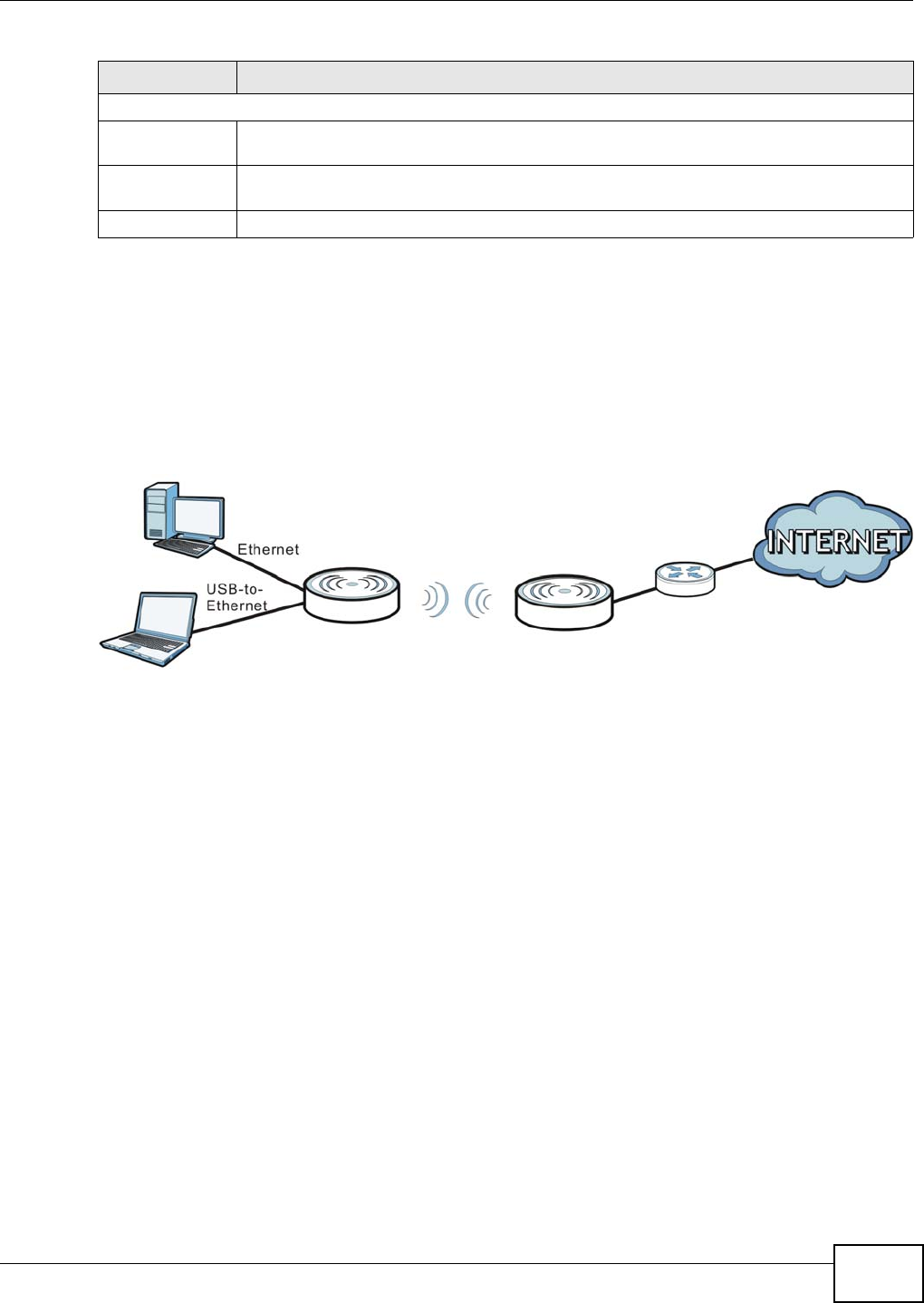
Chapter 3 Operation Modes
NBG2105 User’s Guide 27
3.5 Client Mode
In Client mode, the NBG2105 acts as a wireless client to connect to an existing access point
wirelessly. It acts just like a wireless client in notebooks/computers. In Client mode:
• The IP address of the device on the local network is set to 192.168.1.2.
Figure 8 Client Mode Application
3.5.1 Setting Client Mode
Select Client Mode if your device needs a wireless client to connect to an existing access point. To
set Client mode:
1Make sure the power LED is on (not blinking).
2Slide the Operation Mode Switch to Client. See Section 1.8 on page 16.
3The NBG2105 restarts after you slide the Operation Mode Switch.
To allow NBG2105 clients access to the Internet, the NBG2105 must be routed to the access point.
3.5.2 Navigation Panel
Use the sub-menus on the navigation panel to configure NBG2105 features.
Status
Status Use this to view system, wireless, local and WAN network information, as well as general
information about the NBG2105.
Statistics Use this to show the number of packets sent and received on the Wireless LAN and
Ethernet WAN interfaces.
Log Use this to look at all of the NBG2105’s logs in one location.
Table 6 Navigation Panel: Access Point Mode (continued)
MENU FUNCTION
Access Point
Client
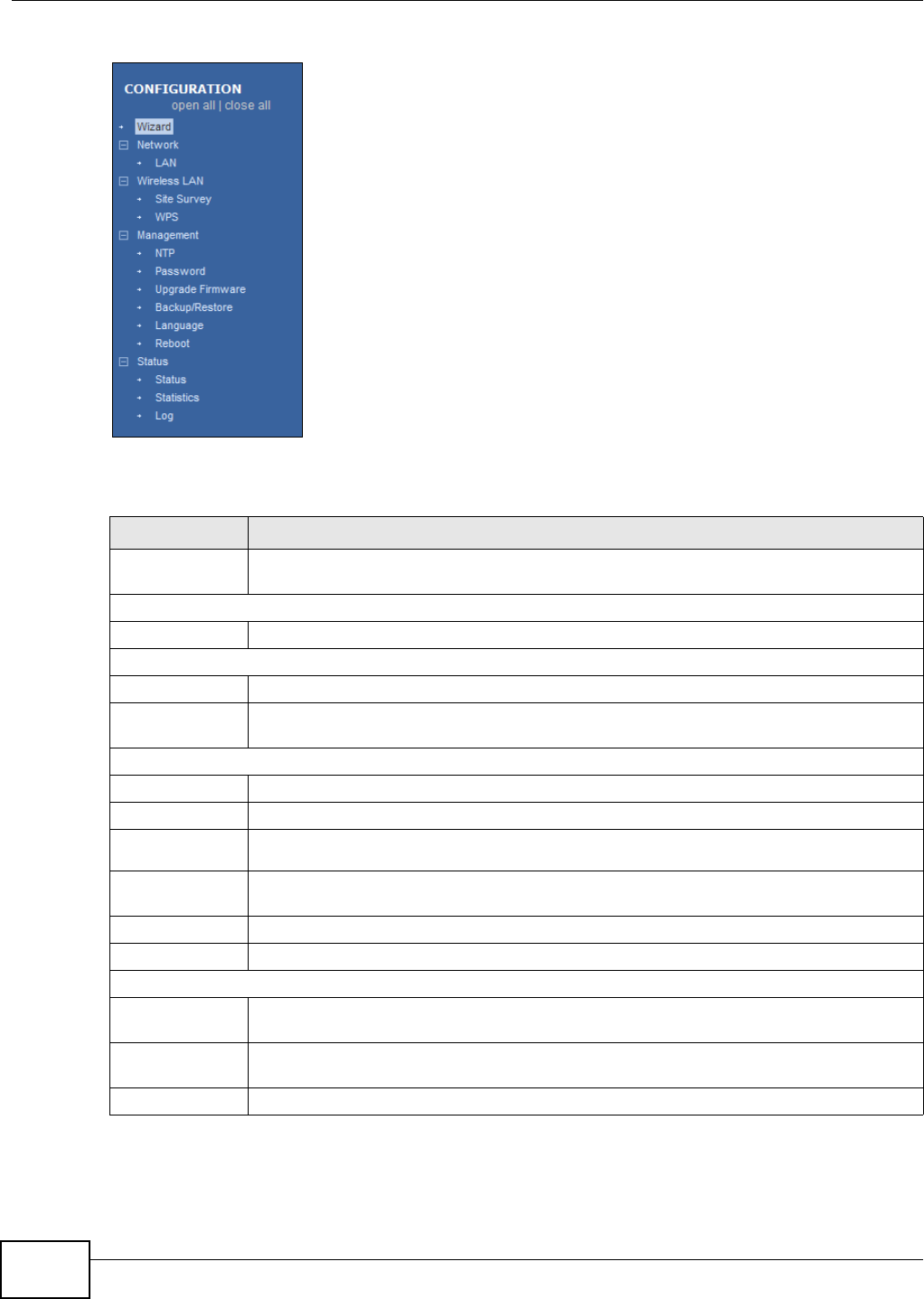
Chapter 3 Operation Modes
NBG2105 User’s Guide
28
Figure 9 Navigation Panel: Client Mode
The following table describes the sub-menus.
Table 7 Navigation Panel: Client Mode
MENU FUNCTION
Wizard The Web Configurator’s wizard setup helps you configure your device in client mode for the
first time.
Network
LAN Use this to configure LAN IP address and subnet mask.
Wireless LAN
Site Survey Use this to scan for and connect to a wireless network automatically.
WPS Use this to quickly set up a wireless network with strong security, without having to
configure security settings manually.
Management
NTP Use this to change your NBG2105’s time and date.
Password Use this to change your NBG2105’s system password.
Upgrade
Firmware Use this to upload firmware to your NBG2105.
Backup/
Restore Use this to view information related to factory defaults, backup configuration, and
restoring configuration.
Language Use this to select the language you prefer.
Reboot Use this to restart the NBG2105 without turning the power off.
Status
Status Use this to view system, wireless, local and WAN network information, as well as general
information about the NBG2105.
Statistics Use this to show the number of packets sent and received on the Wireless LAN and
Ethernet WAN interfaces.
Log Use this to look at all of the NBG2105’s logs in one location.
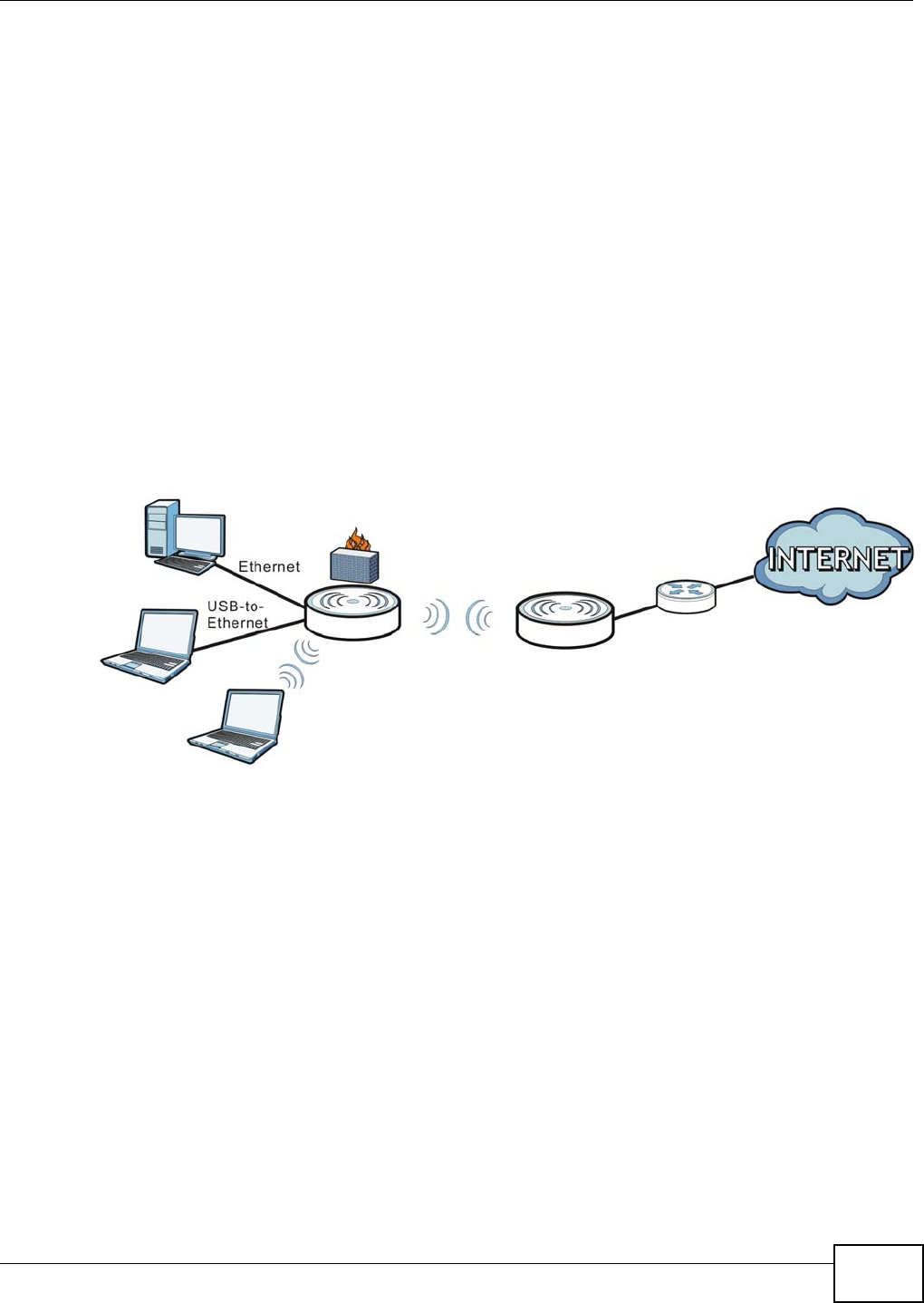
Chapter 3 Operation Modes
NBG2105 User’s Guide 29
3.6 WISP + UR Mode
In WISP (Wireless ISP) + UR (Universal Repeater) mode, your NBG2105 can act as a wireless client
to wirelessly connect to the Internet or an existing network via an access point. In addition, it can
provide Wi-Fi function to the clients on the LAN side. Use this mode if you want to wirelessly
connect to the Internet or have an access point or wireless router in your network. In WISP + UR
mode, the IP address of the device on the local network is 192.168.1.2.
Note: Make sure your network and the remote network are NOT in the same subnet. If
the access point or wireless router is using 192.168.1.x, the NBG2105 in WISP +
UR mode needs to use something else, say 192.168.2.x.
Note: When the NBG2105 is in WISP + UR mode, you still need to enter your ISP
information in the WAN screen in order to access the Internet.
In the example below, one NBG2105 is configured as WISP +UR mode (A) and another is used as
an access point (B). The NBG2105 (A) wirelessly connects to the available access point (B), and
can allow the clients (x and y) to access the network through it using a wireless connection.
Figure 10 WISP + UR Mode Application
3.6.1 Setting WISP + UR Mode
Select WISP + UR Mode if your NBG2105 needs a wireless client to connect to an existing access
point, still have router functions, and also allow wireless clients to associate with the NBG2105. To
set WISP + UR mode:
1Make sure the power LED is on (not blinking).
2Slide the Operation Mode Switch to WISP + UR. See Section 1.8 on page 16.
3The NBG2105 restarts after you slide the Operation Mode Switch.
3.6.2 Navigation Panel
Use the sub-menus on the navigation panel to configure NBG2105 features.
AB
x
y
WISP+UR Access Point
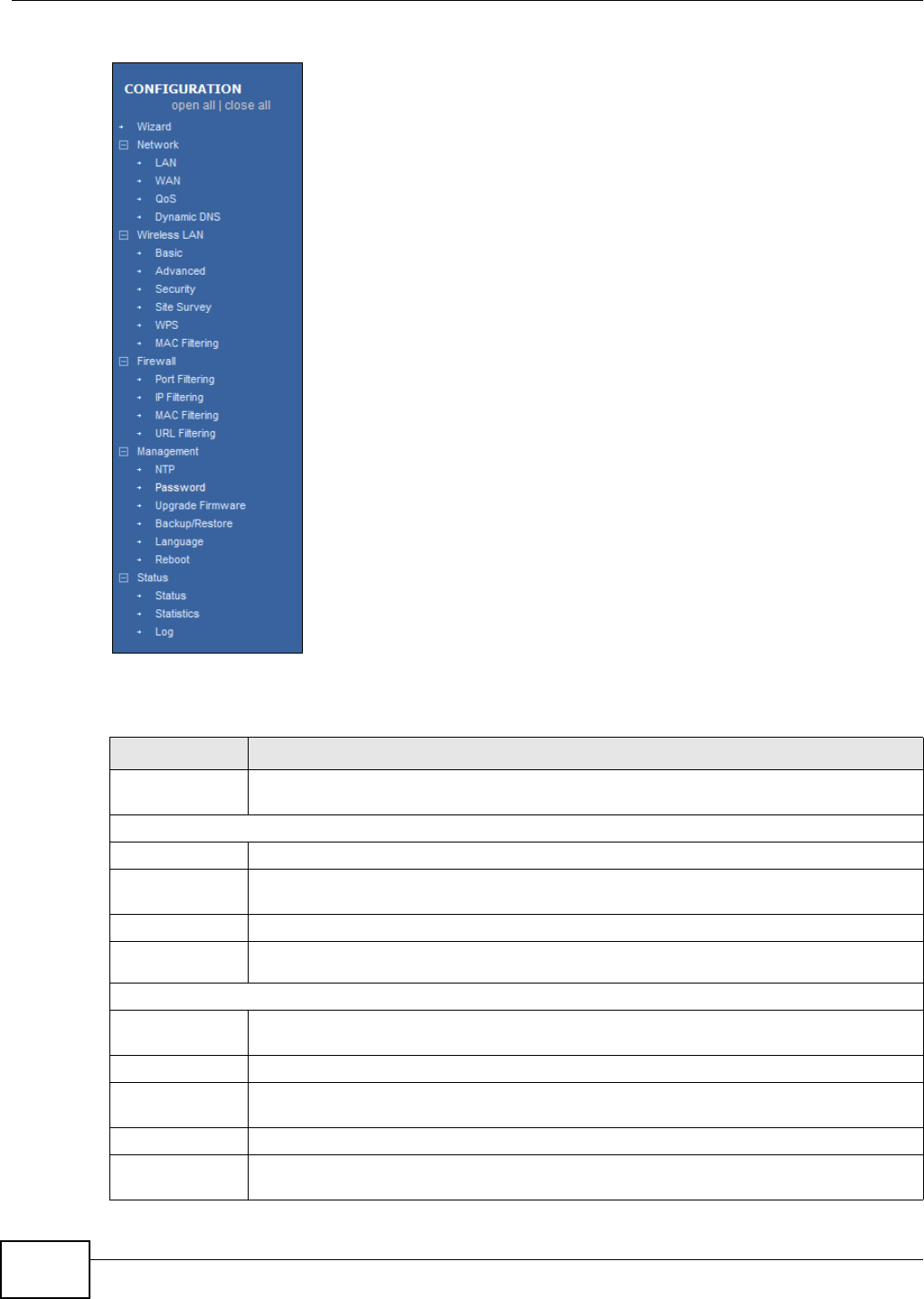
Chapter 3 Operation Modes
NBG2105 User’s Guide
30
Figure 11 Navigation Panel: WISP+UR Mode
The following table describes the sub-menus.
Table 8 Navigation Panel: WISP+UR Mode
MENU FUNCTION
Wizard The Web Configurator’s wizard setup helps you configure your device in WISP+UR mode
for the first time.
Network
LAN Use this to configure LAN IP address and subnet mask.
WAN Use this allows you to configure ISP parameters, WAN IP address assignment, DNS servers
and the WAN MAC address.
QoS Use this to reserve bandwidth for certain traffic based on the IP address or MAC address.
Dynamic
DNS Use this to configure a domain name with a dynamic IP address.
Wireless LAN
Basic Use this to turn the wireless connection on or off and make other basic configuration
changes.
Advanced Use this to configure the output power and set the RTS/CTS Threshold.
Security Use this to configure no, WEP, WPA-PSK, WPA2-PSK or WPA2-PSK Mixed wireless
encryption.
Site Survey Use this to scan for and connect to a wireless network automatically.
WPS Use this to quickly set up a wireless network with strong security, without having to
configure security settings manually.

Chapter 3 Operation Modes
NBG2105 User’s Guide 31
MAC Filtering Use this to allow or deny wireless stations based on their MAC addresses from connecting
to the NBG2105.
Firewall
Port Filtering Use this to apply filtering based on UDP or TCP port numbers.
IP Filtering Use this to apply filtering based on IP addresses.
MAC Filtering Use this to apply filtering based on MAC addresses.
URL Filtering Use this to apply filtering based on URLs.
Management
NTP Use this to change your NBG2105’s time and date.
Password Use this to change your NBG2105’s system password.
Upgrade
Firmware Use this to upload firmware to your NBG2105.
Backup/
Restore Use this to view information related to factory defaults, backup configuration, and
restoring configuration.
Language Use this to select the language you prefer.
Reboot Use this to restart the NBG2105 without turning the power off.
Status
Status Use this to view system, wireless, local and WAN network information, as well as general
information about the NBG2105.
Statistics Use this to show the number of packets sent and received on the Wireless LAN and
Ethernet WAN interfaces.
System Log Use this to look at all of the NBG2105’s logs in one location.
Table 8 Navigation Panel: WISP+UR Mode (continued)
MENU FUNCTION

Chapter 3 Operation Modes
NBG2105 User’s Guide
32
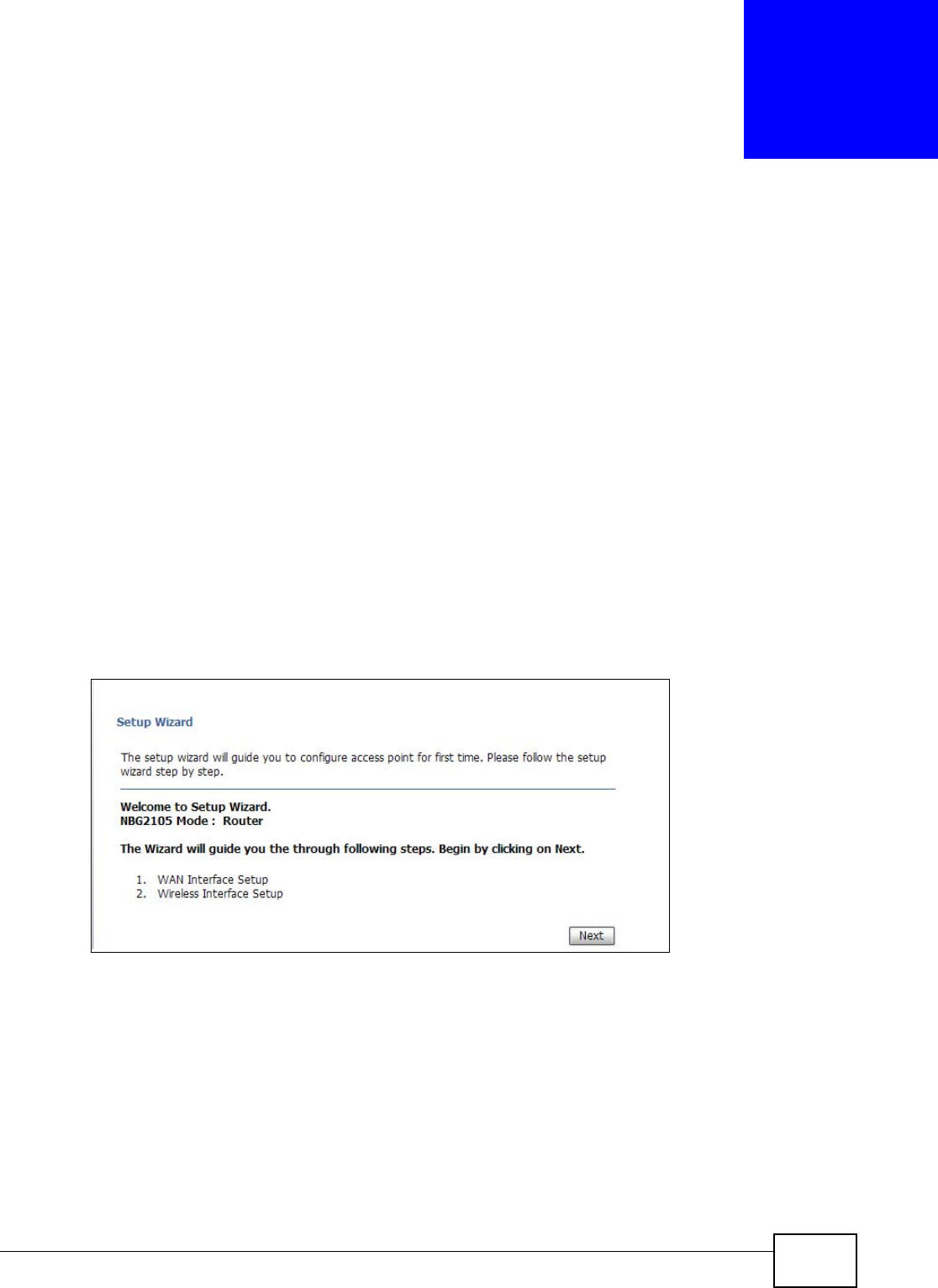
NBG2105 User’s Guide 33
CHAPTER 4
Router Setup Wizard
4.1 Overview
This chapter provides information on the wizard setup screens in the Web Configurator.
The Web Configurator’s wizard setup helps you configure your device in router mode for the first
time.
4.2 Welcome Screen
Launch your web browser and type "http://192.168.1.1" as the website address. Type "admin"
(default) as the user name and "1234" (default) as the password. Click Login.
Click Wizard in router mode to open the Welcome screen. Click Next after reading the instructions
on this screen.
Figure 12 Welcome
4.3 WAN Interface Setup
The NBG2105 offers three WAN access types. They are Static IP, DHCP Client or PPPoE.
The following screen depends on your WAN access type. Enter the details provided by your Internet
Service Provider (ISP) in the fields (if any).
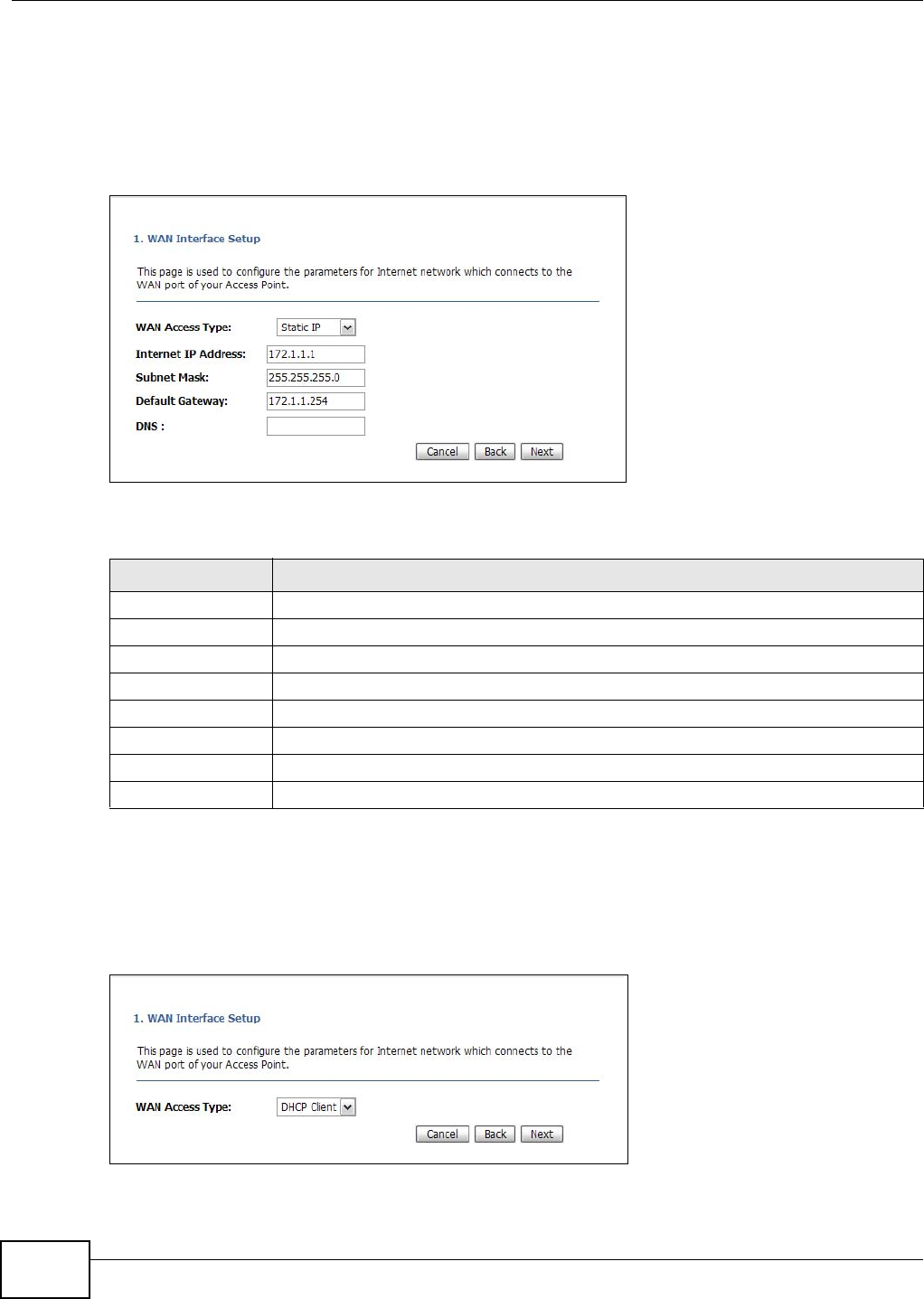
Chapter 4 Router Setup Wizard
NBG2105 User’s Guide
34
4.3.1 WAN Access Type: Static IP
Select Static IP as the WAN Access Type to setup a static IP Configuration on the WAN port.
Complete the fields described. Click Next to proceed with the Wireless Network Name (SSID)
screen.
Figure 13 WAN Access Type: Static IP
The following table describes the labels in this screen.
4.3.2 WAN Access Type: DHCP Client
Select DHCP Client as the WAN Access Type to make the WAN port setup its IP configuration via
DHCP. Click Next to proceed with the Wireless Network Name (SSID) screen.
Figure 14 WAN Access Type: DHCP Client
Table 9 WAN Access Type: Static IP
LABEL DESCRIPTION
WAN Access Type Select Static IP to enable manual configuration of all NBG2105 IP settings.
Internet IP Address Enter the Internet-facing IP address.
Subnet Mask Enter the subnet mask of the NBG2105 WAN interface.
Default Gateway Enter the IP address of a default gateway to the Internet.
DNS Enter the IP address of the DNS server.
Cancel Click this to cancel the wizard.
Back Click this to go back to the previous step in the wizard.
Next Click this to go to the next step in the wizard.
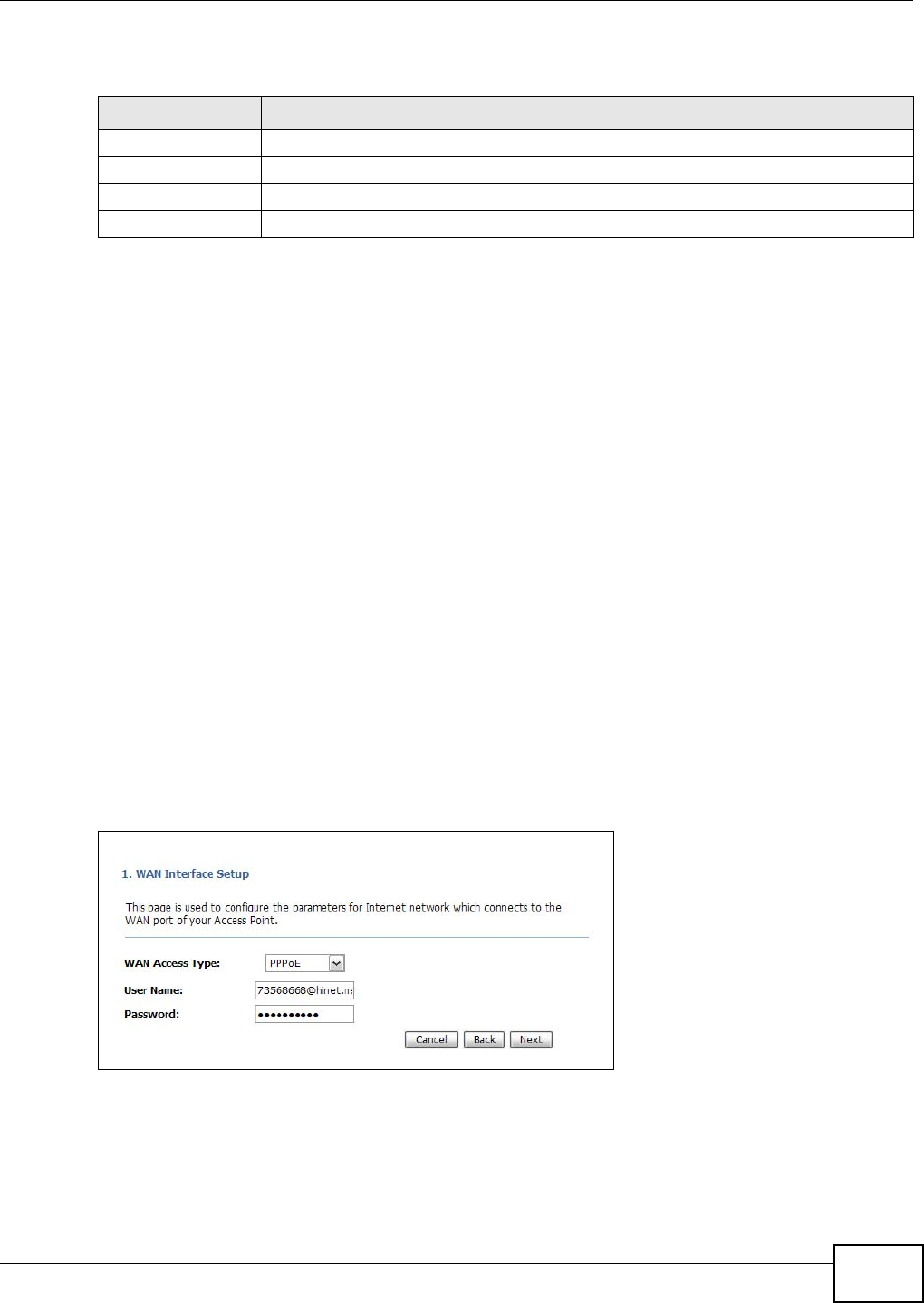
Chapter 4 Router Setup Wizard
NBG2105 User’s Guide 35
The following table describes the labels in this screen.
4.3.3 WAN Access Type: PPPoE
Point-to-Point Protocol over Ethernet (PPPoE) functions as a dial-up connection. PPPoE is an IETF
(Internet Engineering Task Force) standard specifying how a host personal computer interacts with
a broadband modem (for example DSL, cable, wireless, etc.) to achieve access to high-speed data
networks.
For the service provider, PPPoE offers an access and authentication method that works with existing
access control systems (for instance, RADIUS).
One of the benefits of PPPoE is the ability to let end users access one of multiple network services,
a function known as dynamic service selection. This enables the service provider to easily create
and offer new IP services for specific users.
Operationally, PPPoE saves significant effort for both the subscriber and the ISP/carrier, as it
requires no specific configuration of the broadband modem at the subscriber's site.
By implementing PPPoE directly on the NBG2105 (rather than individual computers), the computers
on the LAN do not need PPPoE software installed, since the NBG2105 does that part of the task.
Furthermore, with NAT, all of the LAN's computers will have Internet access.
Select PPPoE as the WAN Access Type to make the WAN port setup its IP configuration via
PPPoE. Complete the fields described. Click Next to proceed with the Wireless Network Name
(SSID) screen.
Figure 15 WAN Access Type: PPPoE
Table 10 WAN Access Type: DHCP Client
LABEL DESCRIPTION
WAN Access Type Select DHCP Client to make the NBG2105 get its IP configuration from a DHCP server.
Cancel Click this to cancel the wizard.
Back Click this to go back to the previous step in the wizard.
Next Click this to go to the next step in the wizard.
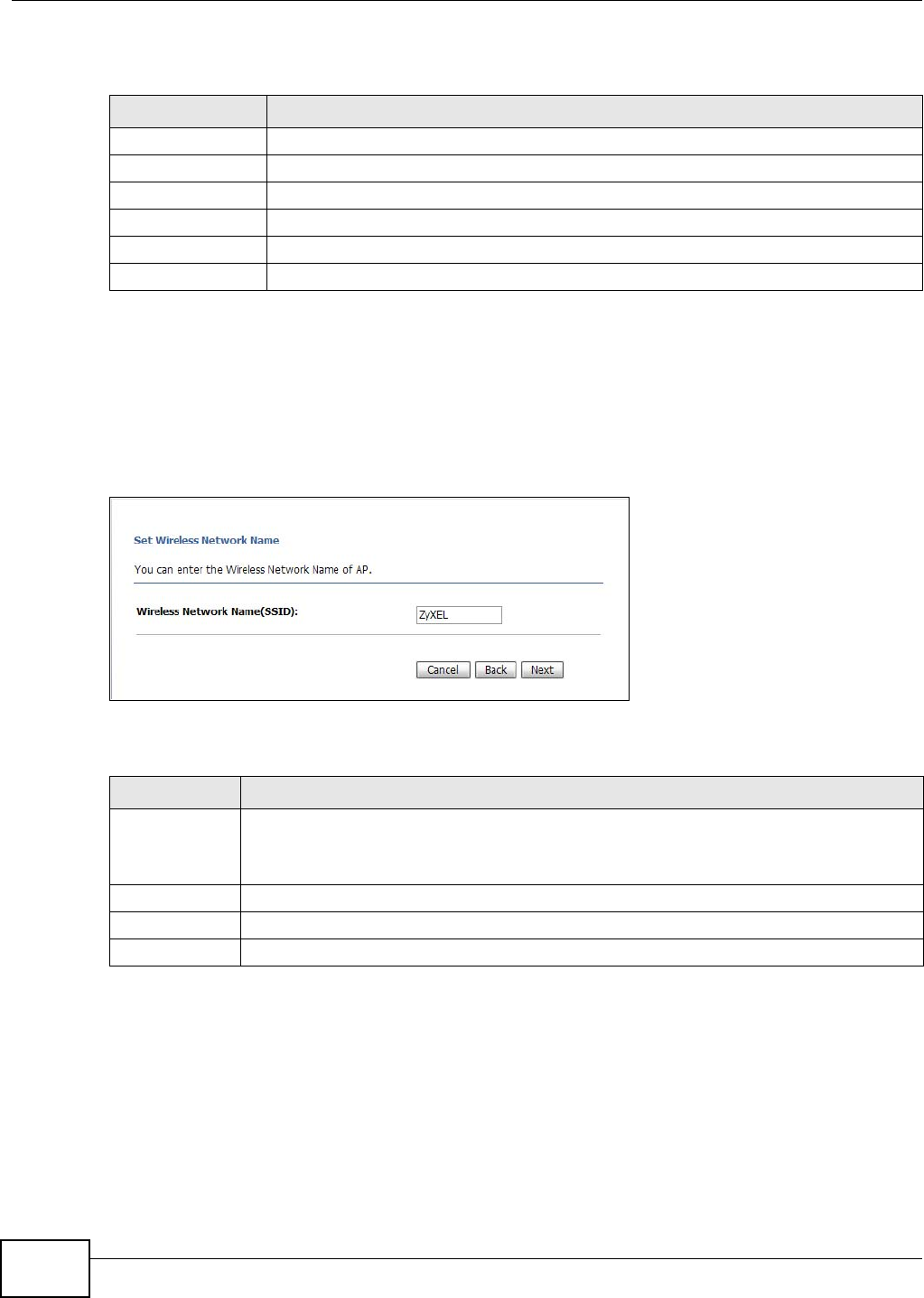
Chapter 4 Router Setup Wizard
NBG2105 User’s Guide
36
The following table describes the labels in this screen.
4.4 Wireless Network Name (SSID) Setup
Name your wireless network by entering an SSID. Click Next to proceed with the Wireless
Security Mode screen.
Figure 16 Wireless Network Name (SSID)
The following table describes the labels in this screen.
4.5 Wireless Security
Configure the wireless security settings on your NBG2105 in the following screen. The fields that
show up depend on the kind of security you select.
Table 11 WAN Access Type: PPPoE
LABEL DESCRIPTION
WAN Access Type Select PPPoE to make the NBG2105 get its IP configuration via PPPoE.
User Name Enter the user name provided by your ISP.
Password Enter the password provided by your ISP.
Cancel Click this to cancel the wizard.
Back Click this to go back to the previous step in the wizard.
Next Click this to go to the next step in the wizard.
Table 12 Wireless Network Name (SSID)
LABEL DESCRIPTION
Wireless
Network Name
(SSID)
Enter a descriptive name (up to 32 printable 7-bit ASCII characters) for the wireless LAN.
If you change this field on the NBG2105, make sure all wireless stations use the same SSID
in order to access the network.
Cancel Click this to cancel the wizard.
Back Click this to go back to the previous step in the wizard.
Next Click this to go to the next step in the wizard.
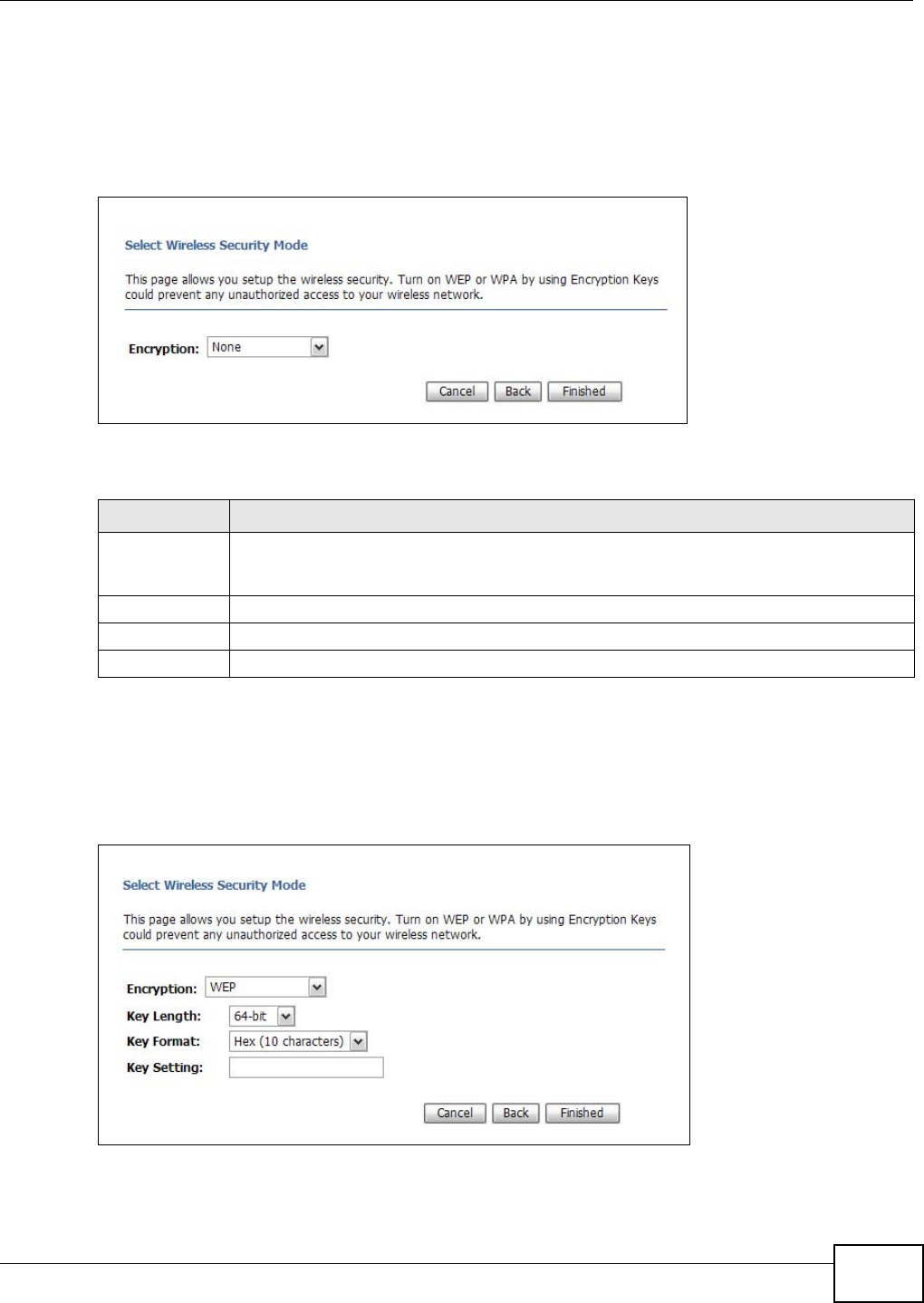
Chapter 4 Router Setup Wizard
NBG2105 User’s Guide 37
4.5.1 Encryption: None
Choose None in the Encryption field to let wireless devices within range access your wireless
network. Complete the fields described. Click Finished to save the configuration end exit the
wizard.
Figure 17 Encryption: None
The following table describes the labels in this screen.
4.5.2 Encryption: WEP
Choose WEP in the Encryption field to protect your wireless network with Wired Equivalent
Privacy. Complete the fields described. Click Finished to save the configuration end exit the wizard.
Figure 18 Encryption: WEP
Table 13 Encryption: None
LABEL DESCRIPTION
Encryption Select None to have no wireless LAN security configured. If you do not enable any wireless
security on your NBG2105, your network is accessible to any wireless networking device
that is within range.
Cancel Click this to cancel the wizard.
Back Click this to go back to the previous step in the wizard.
Finished Click this to finish the wizard.
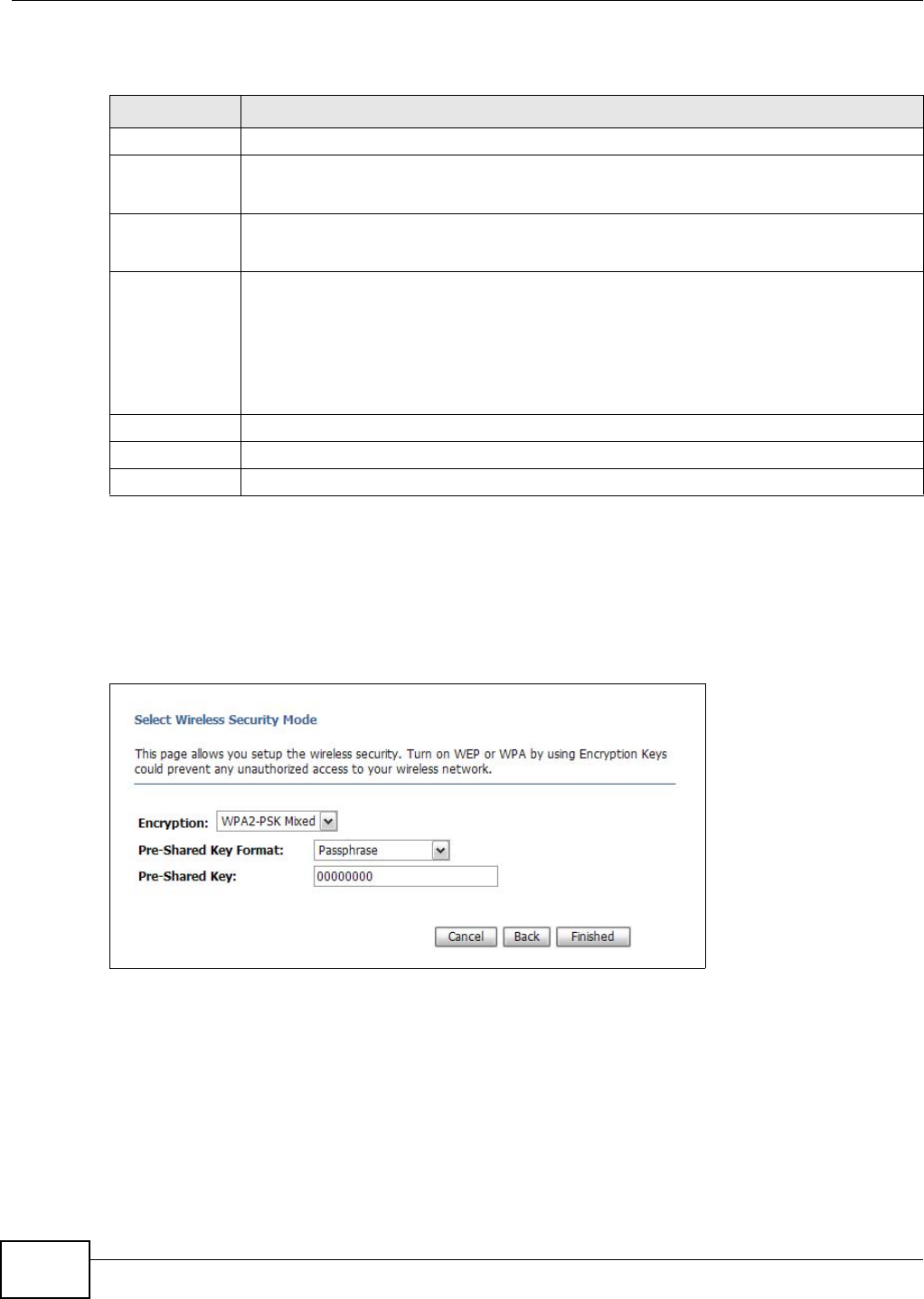
Chapter 4 Router Setup Wizard
NBG2105 User’s Guide
38
The following table describes the labels in this screen.
4.5.3 Encryption: WPA-PSK, WPA2-PSK or WPA2-PSK Mixed
Choose WPS-PSK, WPA2-PSK or WPA2-PSK Mixed in the Encryption field to protect your
wireless network with WPA-PSK, WPA2-PSK or both at the same time. Complete the fields
described. Click Finished to save the configuration end exit the wizard.
Figure 19 Encryption: WPA2-PSK Mixed
Note: Although only the WPA2-PSK Mixed screen is shown, all fields are the same for
WPA-PSK, WPA2-PSK or WPA2-PSK Mixed screens.
Table 14 Encryption: WEP
LABEL DESCRIPTION
Encryption Select WEP to allow clients to associate this network with WEP authentication.
Key Length Select 64-bit or 128-bit.
This dictates the length of the security key that the network is going to use.
Key Format Select Hex to enter hexadecimal characters as a WEP key.
Select ASCII to enter ASCII characters as WEP key.
Key Setting The WEP keys are used to encrypt data. Both the NBG2105 and the wireless stations must
use the same WEP key for data transmission.
If you chose 64-bit in the Key Format field, then enter any 5 ASCII characters or 10
hexadecimal characters ("0-9", "A-F").
If you chose 128-bit in the Key Format field, then enter 13 ASCII characters or 26
hexadecimal characters ("0-9", "A-F").
Cancel Click this to cancel the wizard.
Back Click this to go back to the previous step in the wizard.
Finished Click this to finish the wizard.

Chapter 4 Router Setup Wizard
NBG2105 User’s Guide 39
The following table describes the labels in this screen.
Table 15 Encryption: WPA-PSK, WPA2-PSK or WPA2-PSK Mixed
LABEL DESCRIPTION
Encryption Select WPA-PSK, WPA2-PSK or WPA2-PSK Mixed to allow clients to associate this
network with WPA-PSK, WPA2-PSK or either WPA-PSK or WPA2-PSK authentication.
Pre-Shared Key
Format
Select Passphrase to make the NBG2105 generate a key from a phrase typed into the
Pre-Shared Key field.
Select Hex to configure the NBG2105 to accept a key in hexadecimal format in the
Pre-Shared Key field.
Pre-Shared Key If Passphrase was selected in the Pre-Shared Key Format field, type a pre-shared
key from 8 to 63 case-sensitive keyboard characters.
If Hex was selected in the Pre-Shared Key Format field, type a pre-shared key using
hexadecimal characters ("0-9", "A-F").
Cancel Click this to cancel the wizard.
Back Click this to go back to the previous step in the wizard.
Finished Click this to finish the wizard.

Chapter 4 Router Setup Wizard
NBG2105 User’s Guide
40
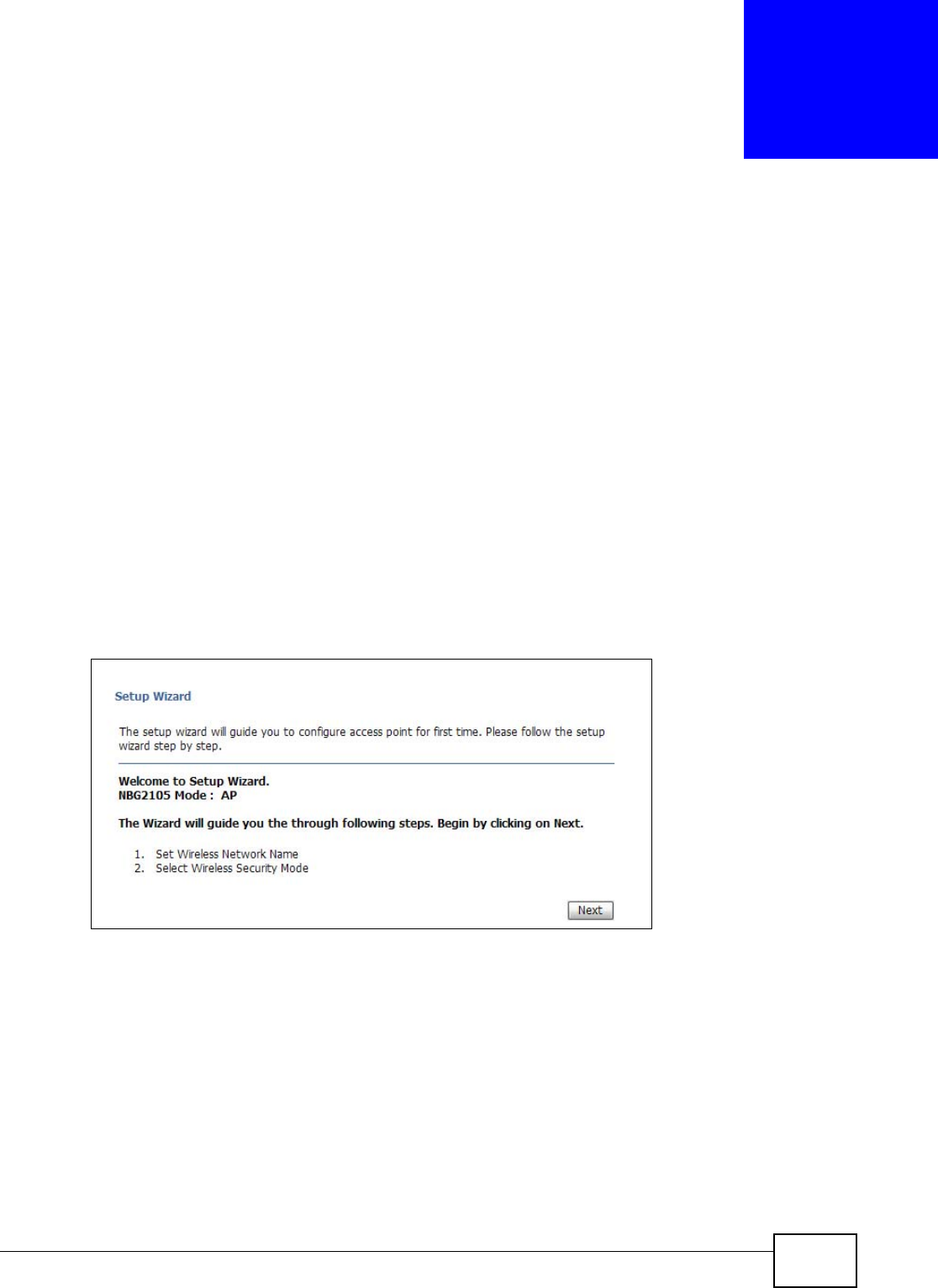
NBG2105 User’s Guide 41
CHAPTER 5
AP Setup Wizard
5.1 Overview
This chapter provides information on the wizard setup screens in the Web Configurator.
The Web Configurator’s wizard setup helps you configure your device in AP mode for the first time.
5.2 Welcome Screen
Launch your web browser and type "http://192.168.1.2" as the website address. Type "admin"
(default) as the user name and "1234" (default) as the password. Click Login.
Click Wizard in router mode to open the Welcome screen. Click Next after reading the instructions
on this screen.
Figure 20 Welcome
5.3 Wireless Network Name (SSID) Setup
Name your wireless network by entering an SSID. Click Next to proceed with the Wireless
Security Mode screen.
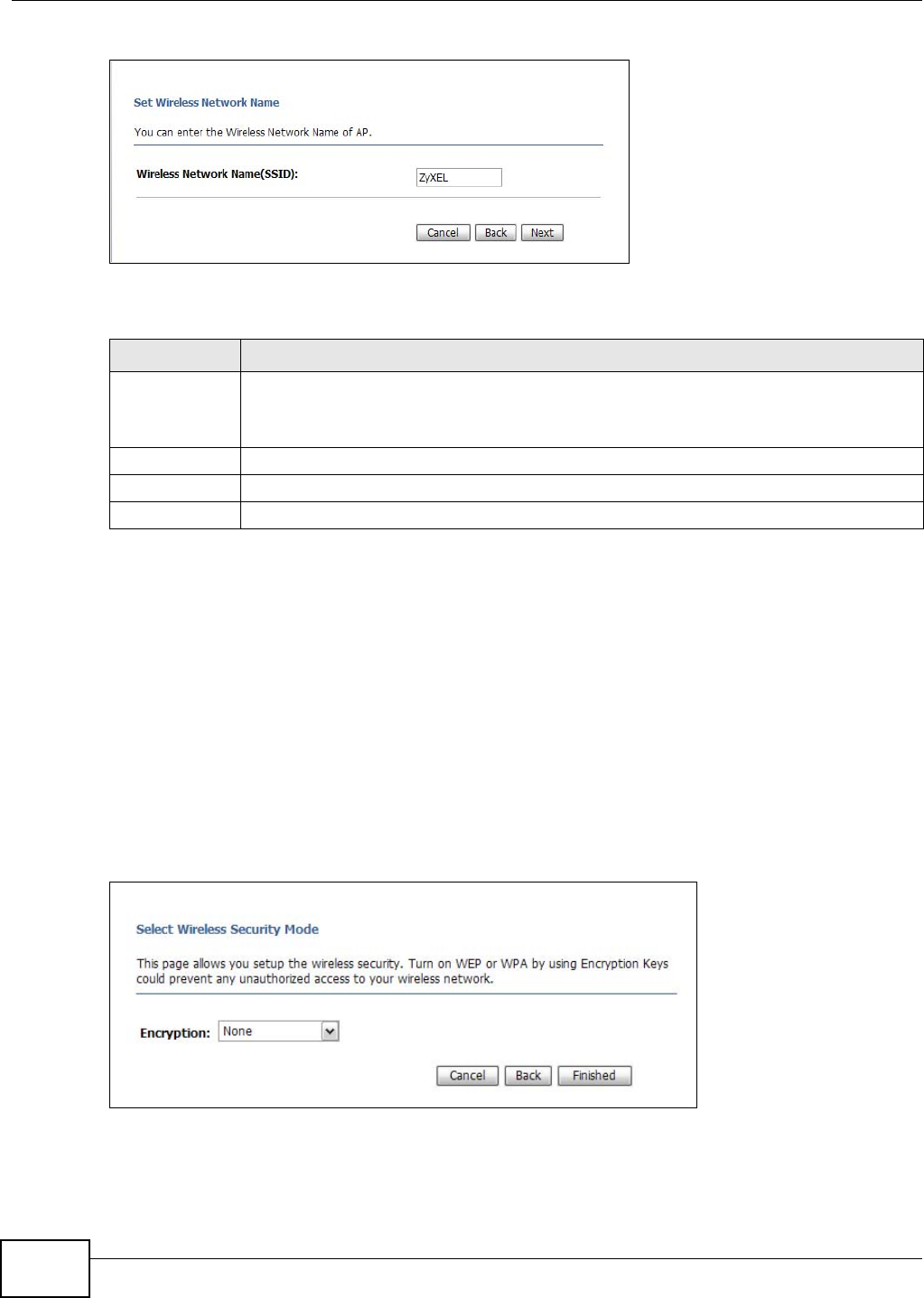
Chapter 5 AP Setup Wizard
NBG2105 User’s Guide
42
Figure 21 Wireless Network Name (SSID)
The following table describes the labels in this screen.
5.4 Wireless Security
Configure the wireless security settings on your NBG2105 in the following screen. The fields that
show up depend on the kind of security you select.
5.4.1 Encryption: None
Choose None in the Encryption field to let wireless devices within range access your wireless
network. Complete the fields described. Click Finished to save the configuration end exit the
wizard.
Figure 22 Encryption: None
Table 16 Wireless Network Name (SSID)
LABEL DESCRIPTION
Wireless
Network Name
(SSID)
Enter a descriptive name (up to 32 printable 7-bit ASCII characters) for the wireless LAN.
If you change this field on the NBG2105, make sure all wireless stations use the same SSID
in order to access the network.
Cancel Click this to cancel the wizard.
Back Click this to go back to the previous step in the wizard.
Next Click this to go to the next step in the wizard.
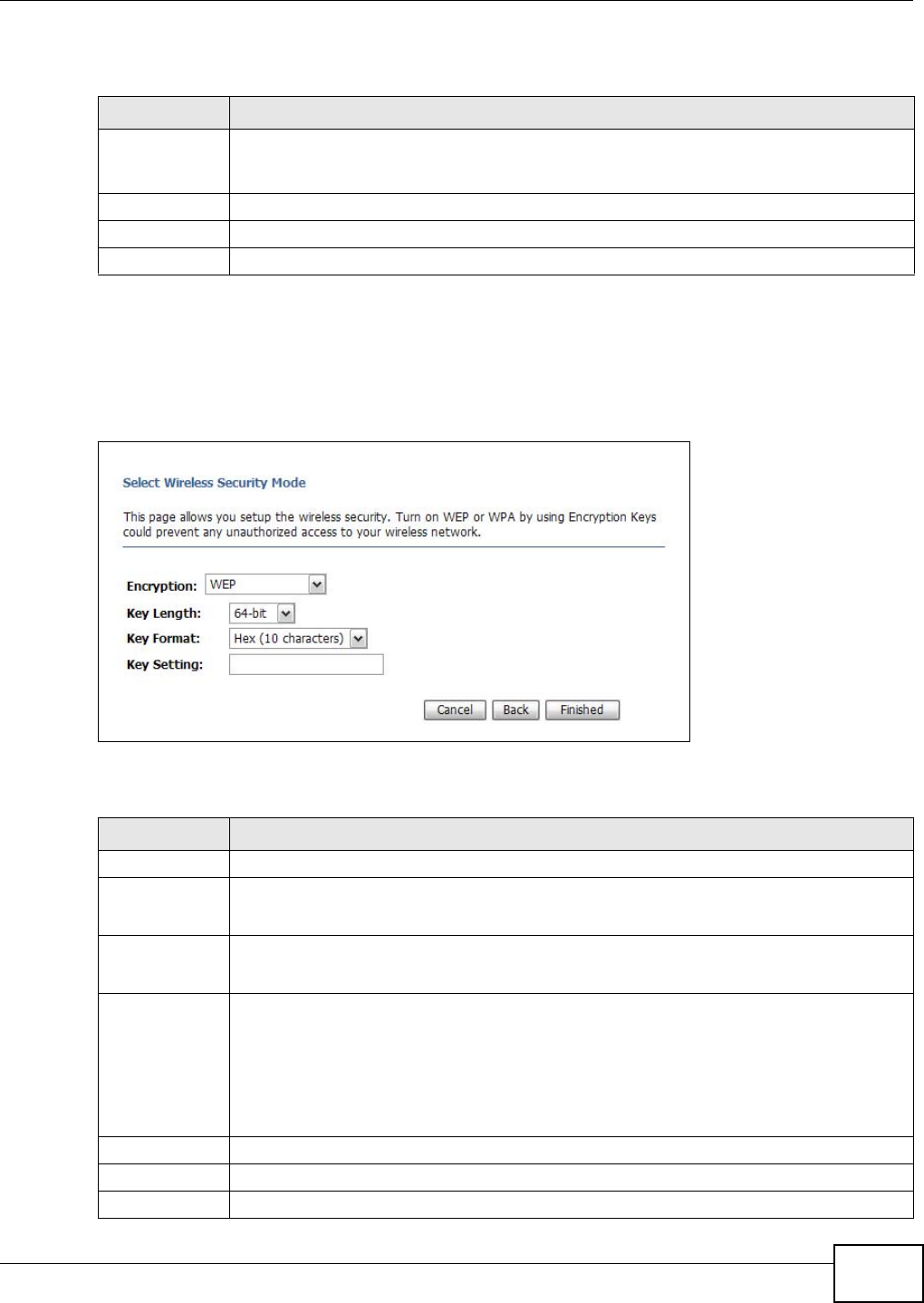
Chapter 5 AP Setup Wizard
NBG2105 User’s Guide 43
The following table describes the labels in this screen.
5.4.2 Encryption: WEP
Choose WEP in the Encryption field to protect your wireless network with Wired Equivalent
Privacy. Complete the fields described. Click Finished to save the configuration end exit the wizard.
Figure 23 Encryption: WEP
The following table describes the labels in this screen.
Table 17 Encryption: None
LABEL DESCRIPTION
Encryption Select None to have no wireless LAN security configured. If you do not enable any wireless
security on your NBG2105, your network is accessible to any wireless networking device
that is within range.
Cancel Click this to cancel the wizard.
Back Click this to go back to the previous step in the wizard.
Finished Click this to finish the wizard.
Table 18 Encryption: WEP
LABEL DESCRIPTION
Encryption Select WEP to allow clients to associate this network with WEP authentication.
Key Length Select 64-bit or 128-bit.
This dictates the length of the security key that the network is going to use.
Key Format Select Hex to enter hexadecimal characters as a WEP key.
Select ASCII to enter ASCII characters as WEP key.
Key Setting The WEP keys are used to encrypt data. Both the NBG2105 and the wireless stations must
use the same WEP key for data transmission.
If you chose 64-bit in the Key Format field, then enter any 5 ASCII characters or 10
hexadecimal characters ("0-9", "A-F").
If you chose 128-bit in the Key Format field, then enter 13 ASCII characters or 26
hexadecimal characters ("0-9", "A-F").
Cancel Click this to cancel the wizard.
Back Click this to go back to the previous step in the wizard.
Finished Click this to finish the wizard.
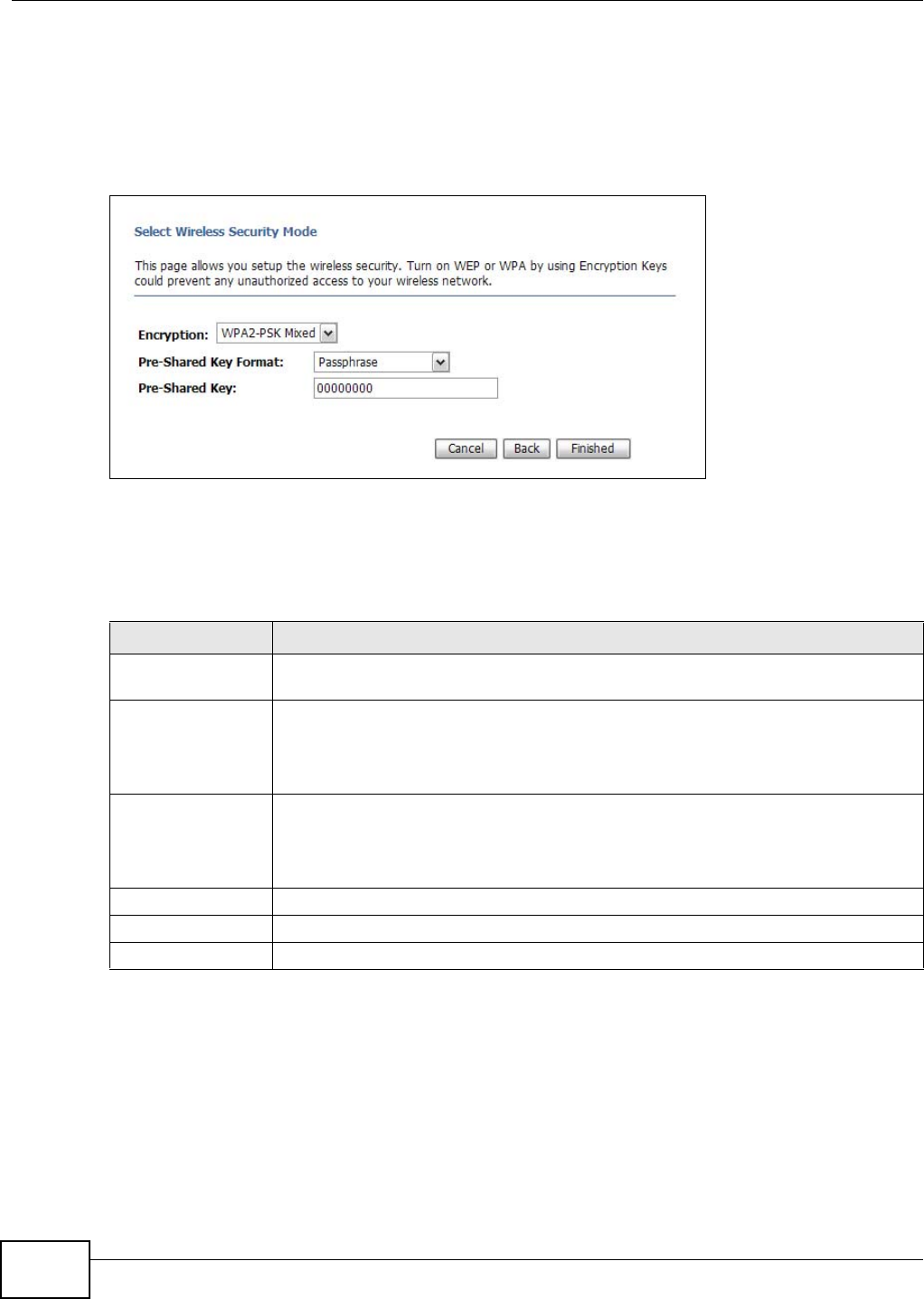
Chapter 5 AP Setup Wizard
NBG2105 User’s Guide
44
5.4.3 Encryption: WPA-PSK, WPA2-PSK or WPA2-PSK Mixed
Choose WPS-PSK, WPA2-PSK or WPA2-PSK Mixed in the Encryption field to protect your
wireless network with WPA-PSK, WPA2-PSK or both at the same time. Complete the fields
described. Click Finished to save the configuration end exit the wizard.
Figure 24 Encryption: WPA2-PSK Mixed
Note: Although only the WPA2-PSK Mixed screen is shown, all fields are the same for
WPA-PSK, WPA2-PSK or WPA2-PSK Mixed screens.
The following table describes the labels in this screen.
Table 19 Encryption: WPA-PSK, WPA2-PSK or WPA2-PSK Mixed
LABEL DESCRIPTION
Encryption Select WPA-PSK, WPA2-PSK or WPA2-PSK Mixed to allow clients to associate this
network with WPA-PSK, WPA2-PSK or either WPA-PSK or WPA2-PSK authentication.
Pre-Shared Key
Format
Select Passphrase to make the NBG2105 generate a key from a phrase typed into the
Pre-Shared Key field.
Select Hex to configure the NBG2105 to accept a key in hexadecimal format in the
Pre-Shared Key field.
Pre-Shared Key If Passphrase was selected in the Pre-Shared Key Format field, type a pre-shared
key from 8 to 63 case-sensitive keyboard characters.
If Hex was selected in the Pre-Shared Key Format field, type a pre-shared key using
hexadecimal characters ("0-9", "A-F").
Cancel Click this to cancel the wizard.
Back Click this to go back to the previous step in the wizard.
Finished Click this to finish the wizard.
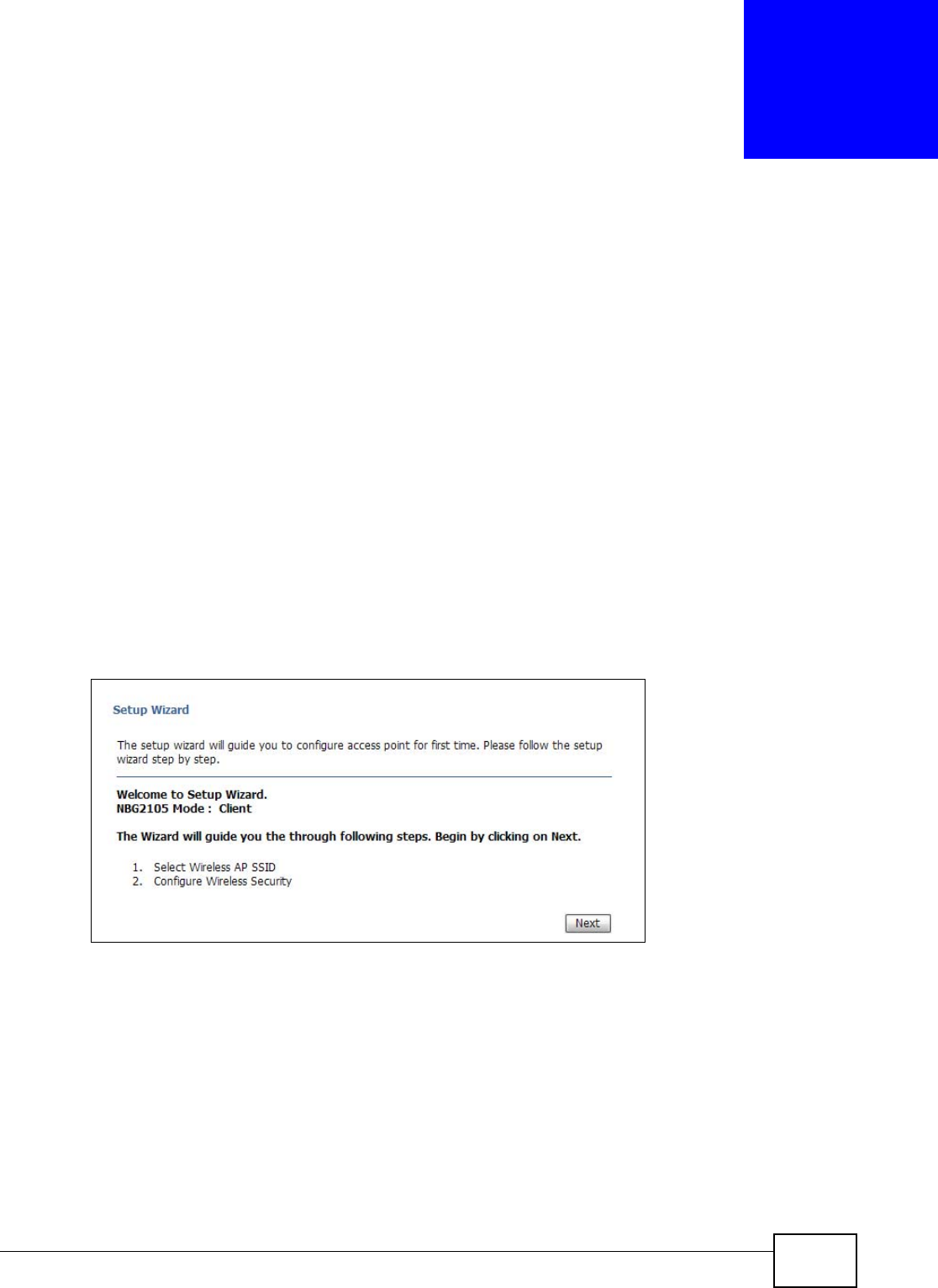
NBG2105 User’s Guide 45
CHAPTER 6
Client Setup Wizard
6.1 Overview
This chapter provides information on the wizard setup screens in the Web Configurator.
The Web Configurator’s wizard setup helps you configure your device in Client mode for the first
time.
6.2 Welcome Screen
Launch your web browser and type "http://192.168.1.2" as the website address. Type "admin"
(default) as the user name and "1234" (default) as the password. Click Login.
Click Wizard in client mode to open the Welcome screen. Click Next after reading the instructions
on this screen.
Figure 25 Welcome
6.3 Wireless Network Name Setup
Name your wireless network by entering an SSID or by clicking Site Survey and selecting one of
the detected devices. Click Next to proceed with the Wireless Security Mode screen.
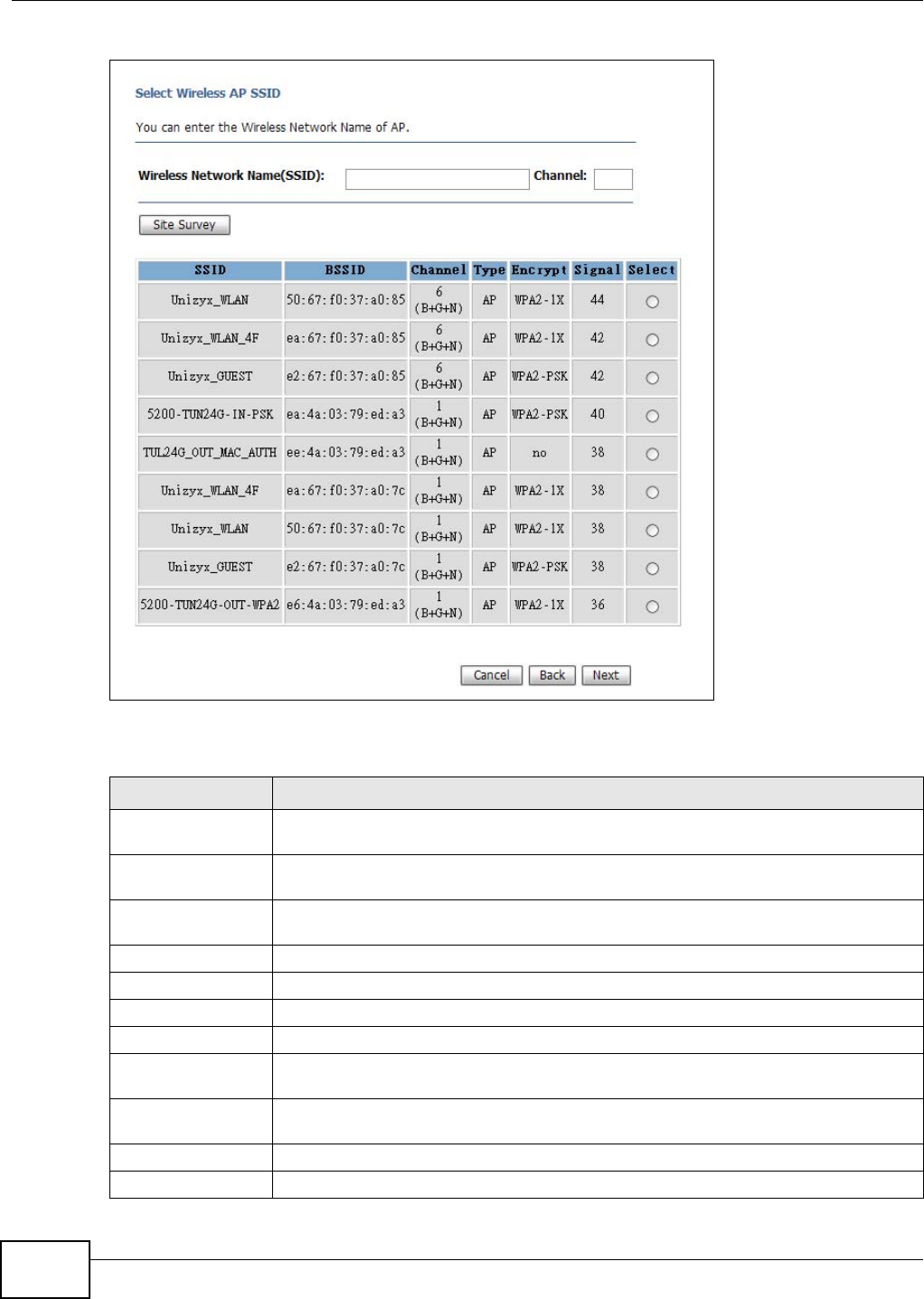
Chapter 6 Client Setup Wizard
NBG2105 User’s Guide
46
Figure 26 Wireless Network Name Setup
The following table describes the labels in this screen.
Table 20 Wireless Network Name Setup
LABEL DESCRIPTION
Wireless Network
Name (SSID)
Enter the SSID of the AP to which you want the NBG2105 in client mode to connect.
Channel Enter the channel number used by the wireless device to which the NBG2105 is
connecting. This is optional if the AP does not broadcast and hides the SSID.
Site Survey Click this to search for available wireless devices within transmission range and update
this table.
SSID This shows the SSID of the wireless device.
BSSID This shows the MAC address of the wireless device.
Channel This shows the channel number and wireless standard used by this wireless device.
Type This shows the type of device found in the survey.
Encrypt This displays the data encryption and authentication method used by this wireless
device.
Signal This displays the strength of the wireless signal. The signal strength mainly depends on
the antenna output power and the distance between your NBG2105 and this device.
Select Click this to select a device.
Cancel Click this to cancel the wizard.
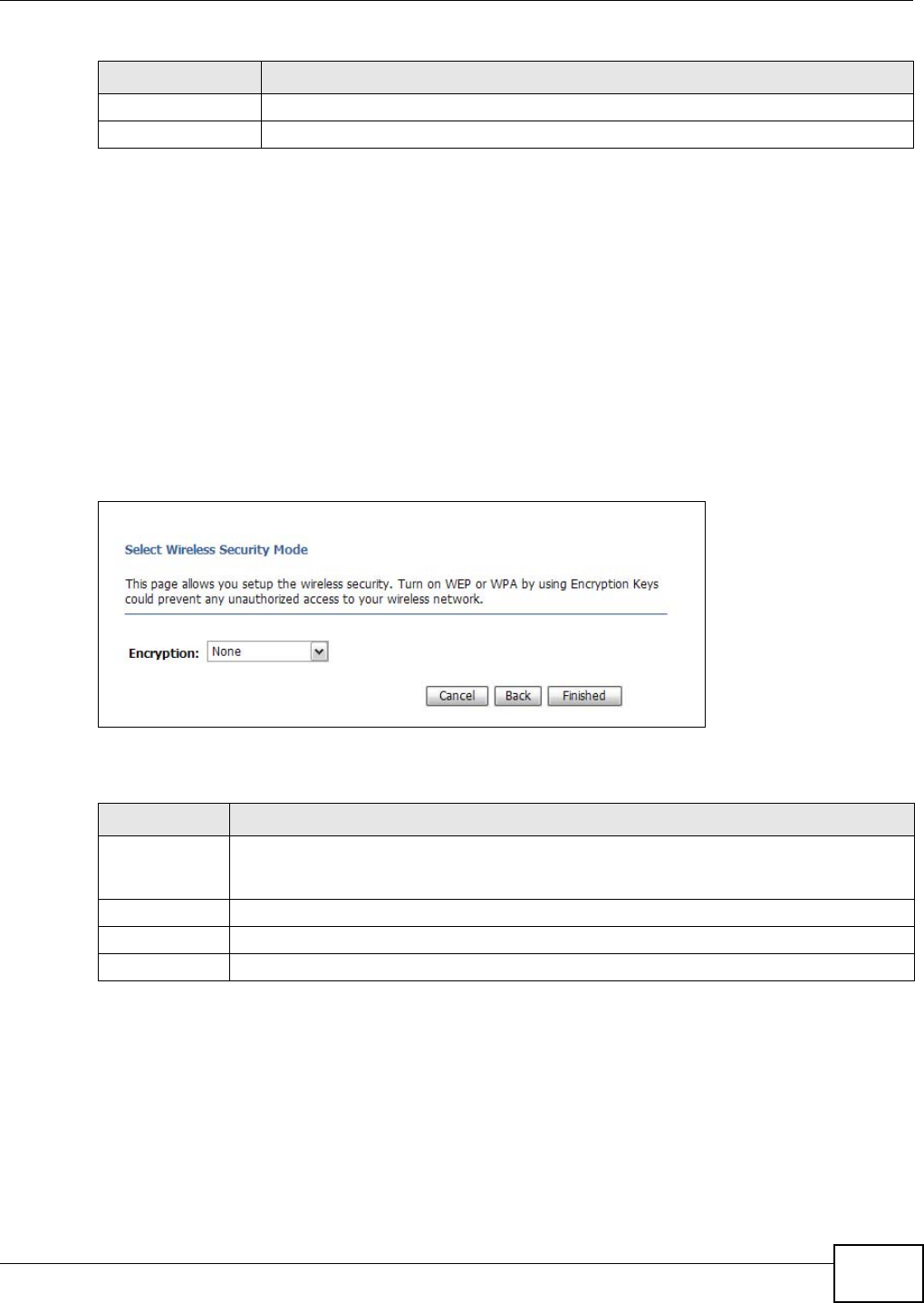
Chapter 6 Client Setup Wizard
NBG2105 User’s Guide 47
6.4 Wireless Security
Configure the wireless security settings on your NBG2105 in the following screen. The fields that
show up depend on the kind of security you select.
6.4.1 Encryption: None
Choose None in the Encryption field to let wireless devices within range access your wireless
network. Complete the fields described. Click Finished to save the configuration end exit the
wizard.
Figure 27 Encryption: None
The following table describes the labels in this screen.
6.4.2 Encryption: WEP
Choose WEP in the Encryption field to protect your wireless network with Wired Equivalent
Privacy. Complete the fields described. Click Finished to save the configuration end exit the wizard.
Back Click this to go back to the previous step in the wizard.
Next Click this to open a screen to configure wireless security options.
Table 20 Wireless Network Name Setup (continued)
LABEL DESCRIPTION
Table 21 Encryption: None
LABEL DESCRIPTION
Encryption Select None to have no wireless LAN security configured. If you do not enable any wireless
security on your NBG2105, your network is accessible to any wireless networking device
that is within range.
Cancel Click this to cancel the wizard.
Back Click this to go back to the previous step in the wizard.
Finished Click this to finish the wizard.
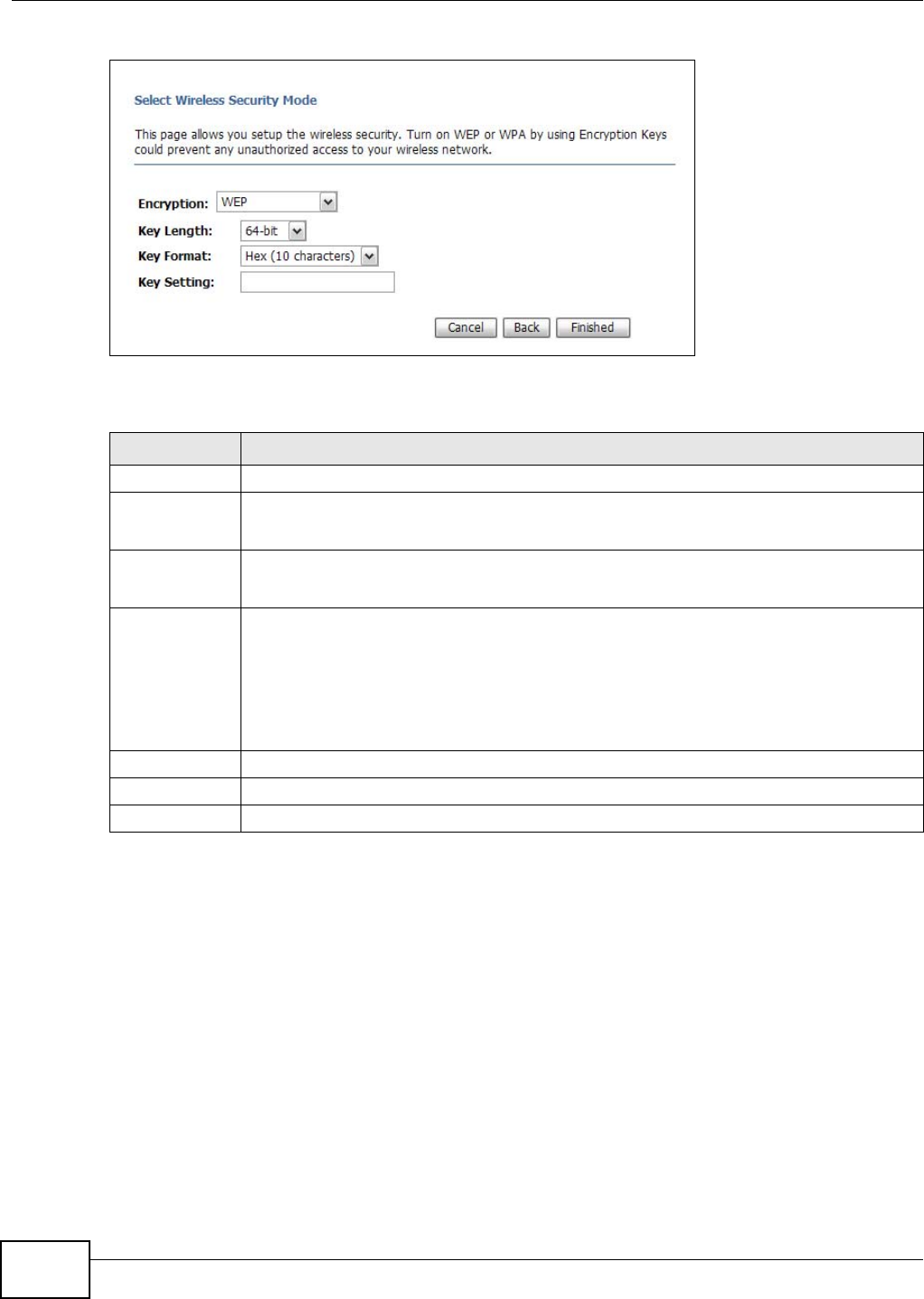
Chapter 6 Client Setup Wizard
NBG2105 User’s Guide
48
Figure 28 Encryption: WEP
The following table describes the labels in this screen.
6.4.3 Encryption: WPA-PSK or WPA2-PSK
Choose WPA-PSK or WPA2-PSK in the Encryption field to protect your wireless network with
WPA-PSK or WPA2-PSK encryption. Complete the fields described. Click Finished to save the
configuration end exit the wizard.
Table 22 Encryption: WEP
LABEL DESCRIPTION
Encryption Select WEP to allow clients to associate this network with WEP authentication.
Key Length Select 64-bit or 128-bit.
This dictates the length of the security key that the network is going to use.
Key Format Select Hex to enter hexadecimal characters as a WEP key.
Select ASCII to enter ASCII characters as WEP key.
Key Setting The WEP keys are used to encrypt data. Both the NBG2105 and the wireless stations must
use the same WEP key for data transmission.
If you chose 64-bit in the Key Format field, then enter any 5 ASCII characters or 10
hexadecimal characters ("0-9", "A-F").
If you chose 128-bit in the Key Format field, then enter 13 ASCII characters or 26
hexadecimal characters ("0-9", "A-F").
Cancel Click this to cancel the wizard.
Back Click this to go back to the previous step in the wizard.
Finished Click this to finish the wizard.
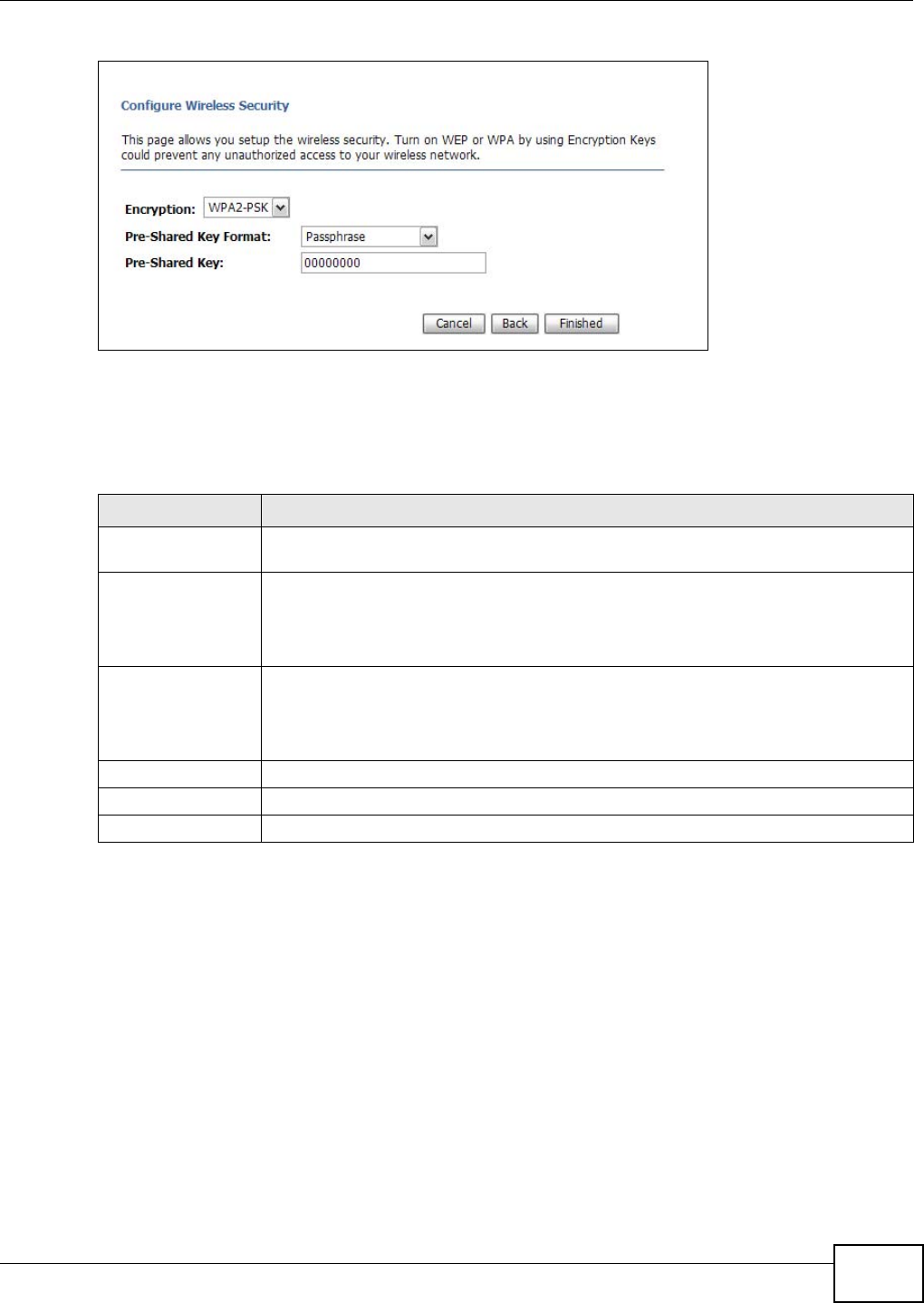
Chapter 6 Client Setup Wizard
NBG2105 User’s Guide 49
Figure 29 Encryption: WPA2-PSK
Note: Although only the WPA2-PSK screen is shown, all fields are the same for the
WPA-PSK screen.
The following table describes the labels in this screen.
Table 23 Encryption: WPA-PSK or WPA2-PSK
LABEL DESCRIPTION
Encryption Select WPA-PSK or WPA2-PSK to allow clients to associate this network with WPA or
WPA2 authentication.
Pre-Shared Key
Format
Select Passphrase to make the NBG2105 generate a key from a phrase typed into the
Pre-Shared Key field.
Select HEX to configure the NBG2105 to accept a key in hexadecimal format in the
Pre-Shared Key field.
Pre-Shared Key If Passphrase was selected in the Pre-Shared Key Format field, type a pre-shared
key from 8 to 63 case-sensitive keyboard characters.
If HEX was selected in the Pre-Shared Key Format field, type a pre-shared key using
hexadecimal characters ("0-9", "A-F").
Cancel Click this to cancel the wizard.
Back Click this to go back to the previous step in the wizard.
Finished Click this to finish the wizard.

Chapter 6 Client Setup Wizard
NBG2105 User’s Guide
50
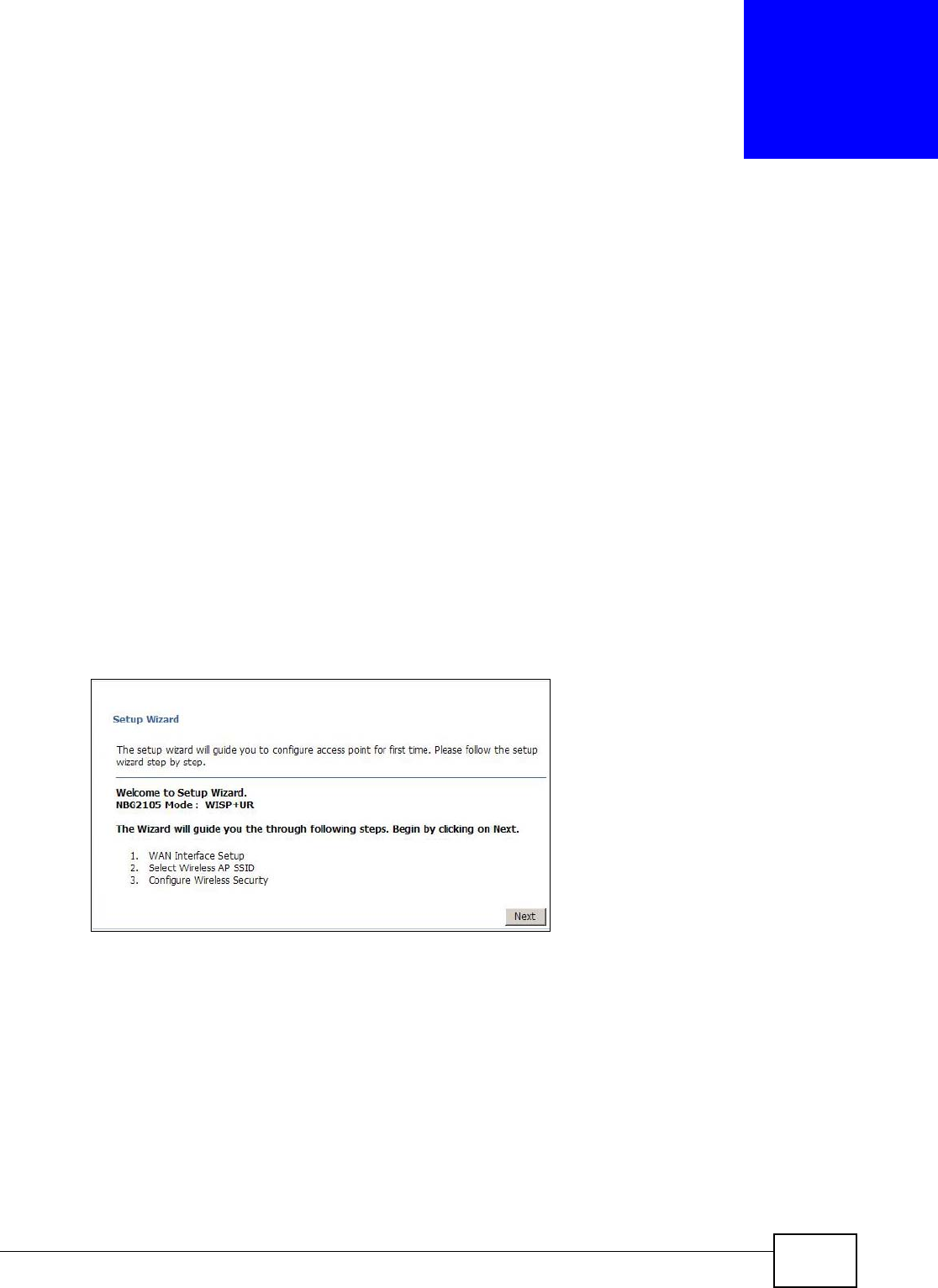
NBG2105 User’s Guide 51
CHAPTER 7
WISP+UR Setup Wizard
7.1 Overview
This chapter provides information on the wizard setup screens in the Web Configurator.
The Web Configurator’s wizard setup helps you configure the wireless network name and wireless
network security in WISP+UR mode for the first time.
7.2 Welcome Screen
Launch your web browser and type "http://192.168.1.2" as the website address. Type "admin"
(default) as the user name and "1234" (default) as the password. Click Login.
Click Wizard in WISP+UR mode to open the Welcome screen. Click Next after reading the
instructions on this screen.
Figure 30 Welcome
7.3 WAN Interface Setup
Click Network > WAN to change how your NBG2105’s WAN interface accesses your ISP. The
screen differs according to the WAN Access Type you choose.
7.3.1 Static IP
Select Static IP from WAN Access Type to configure all NBG2105 WAN IP configuration settings
manually.
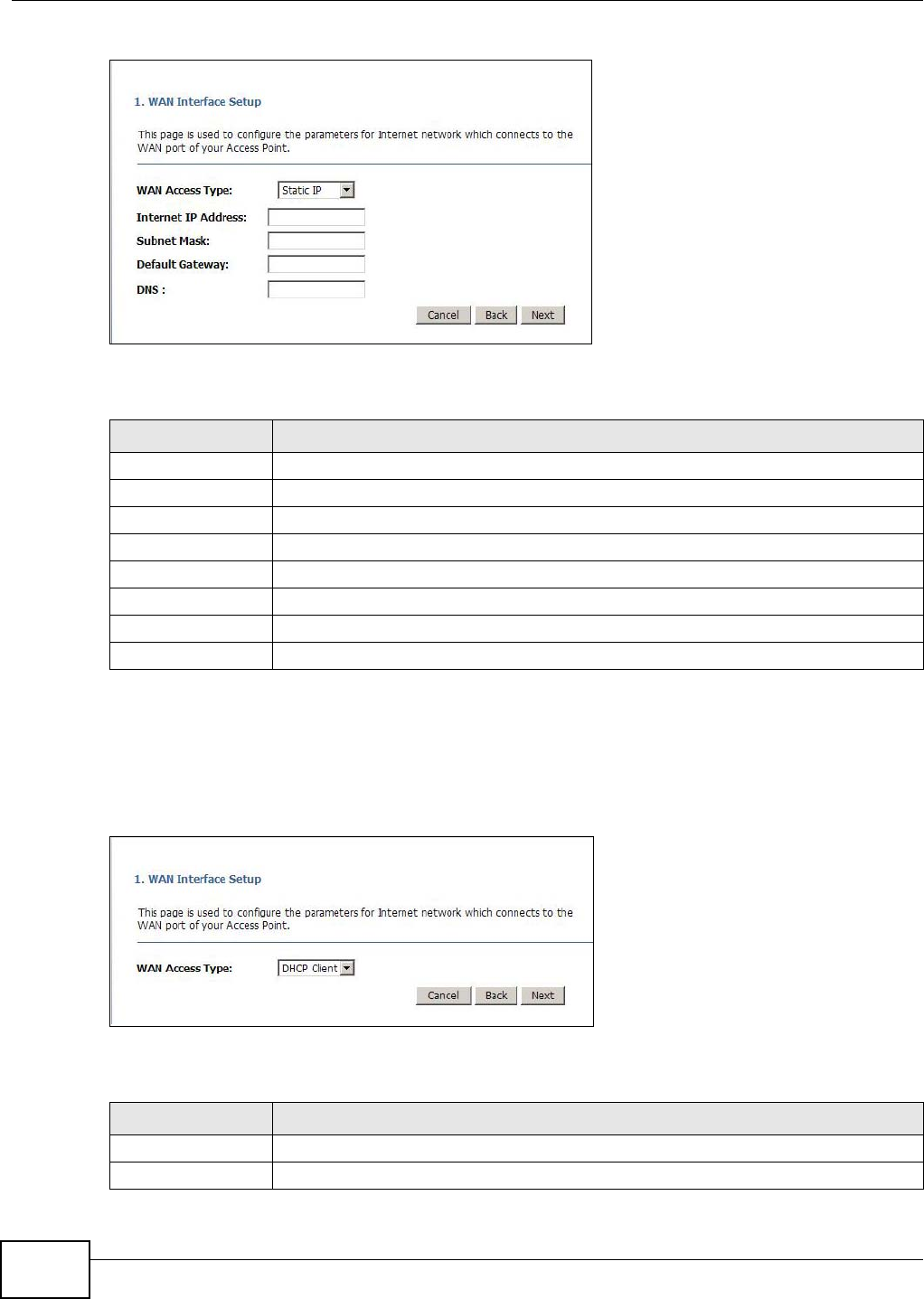
Chapter 7 WISP+UR Setup Wizard
NBG2105 User’s Guide
52
Figure 31 WAN: Static IP
The following table describes the labels in this screen.
7.3.2 DHCP Client
Select DHCP Client from WAN Access Type to make the NBG2105 get its IP configuration from a
DHCP server.
Figure 32 WAN: DHCP Client
The following table describes the labels in this screen.
Table 24 WAN: Static IP
LABEL DESCRIPTION
WAN Access Type Select Static IP to enable manual configuration of all NBG2105 IP settings.
Internet IP Address Enter the Internet-facing IP address.
Subnet Mask Enter the subnet mask of the NBG2105 WAN interface.
Default Gateway Enter the IP address of a default gateway to the Internet.
DNS Enter the IP address of the DNS server.
Cancel Click this to cancel the wizard.
Back Click this to go back to the previous step in the wizard.
Next Click this to open a screen to configure wireless security options.
Table 25 WAN: DHCP Client
LABEL DESCRIPTION
WAN Access Type Select DHCP Client to make the NBG2105 get its IP configuration from a DHCP server.
Cancel Click this to cancel the wizard.
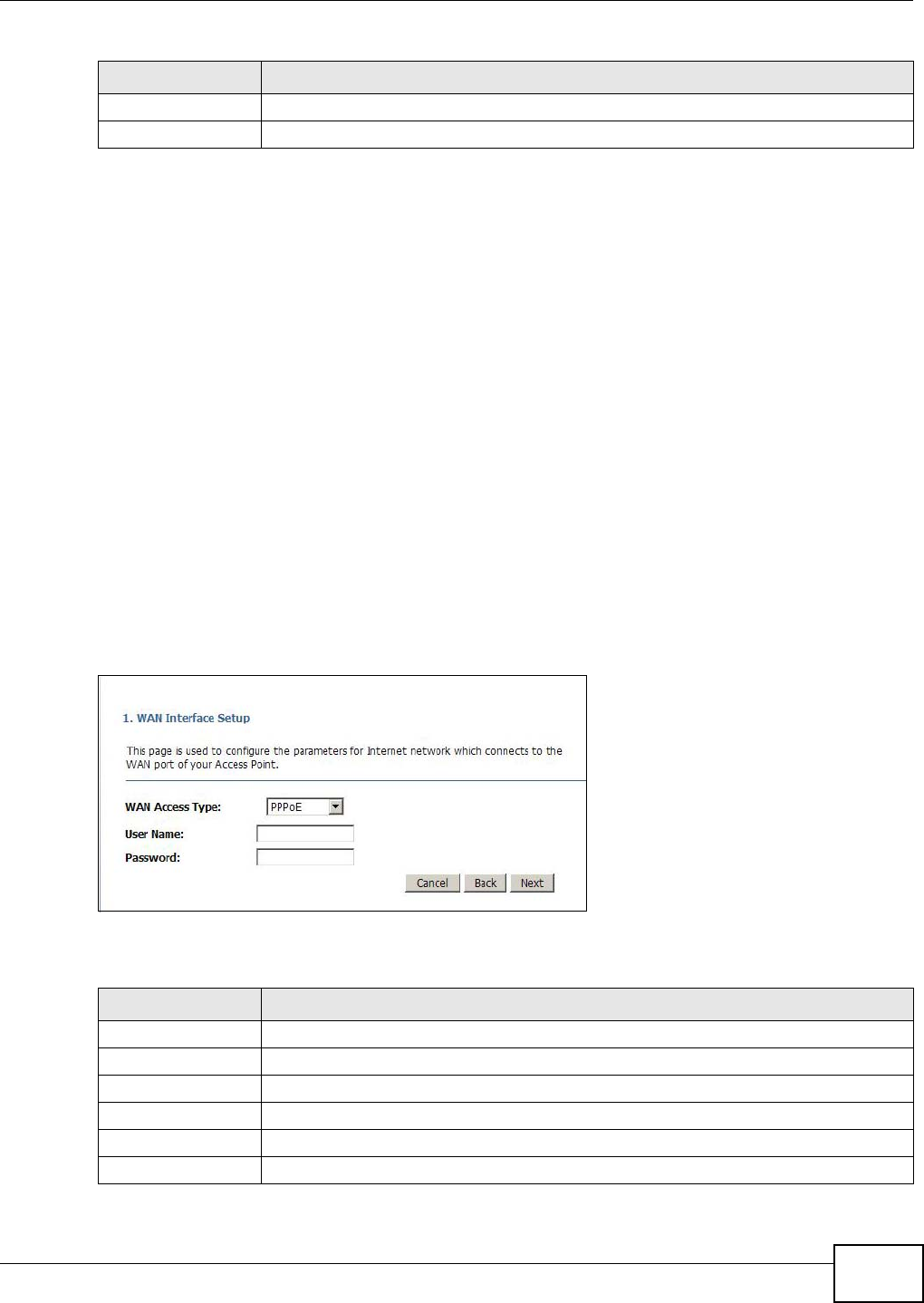
Chapter 7 WISP+UR Setup Wizard
NBG2105 User’s Guide 53
7.3.3 PPPoE
The NBG2105 supports PPPoE (Point-to-Point Protocol over Ethernet). PPPoE is an IETF standard
(RFC 2516) specifying how a personal computer (PC) interacts with a broadband modem (DSL,
cable, wireless, etc.) connection. The PPPoE option is for a dial-up connection using PPPoE.
For the service provider, PPPoE offers an access and authentication method that works with existing
access control systems (for example Radius).
One of the benefits of PPPoE is the ability to let you access one of multiple network services, a
function known as dynamic service selection. This enables the service provider to easily create and
offer new IP services for individuals.
Operationally, PPPoE saves significant effort for both you and the ISP or carrier, as it requires no
specific configuration of the broadband modem at the customer site.
By implementing PPPoE directly on the NBG2105 (rather than individual computers), the computers
on the LAN do not need PPPoE software installed, since the NBG2105 does that part of the task.
Furthermore, with NAT, all of the LANs’ computers will have access.
Select PPPoE from WAN Access Type to make the NBG2105 get its IP configuration via PPPoE.
Figure 33 WAN: PPPoE
The following table describes the labels in this screen.
Back Click this to go back to the previous step in the wizard.
Next Click this to open a screen to configure wireless security options.
Table 25 WAN: DHCP Client (continued)
LABEL DESCRIPTION
Table 26 WAN: PPPoE
LABEL DESCRIPTION
WAN Access Type Select PPPoE to make the NBG2105 get its IP configuration via PPPoE.
User Name Enter the user name provided by your ISP.
Password Enter the password provided by your ISP.
Cancel Click this to cancel the wizard.
Back Click this to go back to the previous step in the wizard.
Next Click this to open a screen to configure wireless security options.
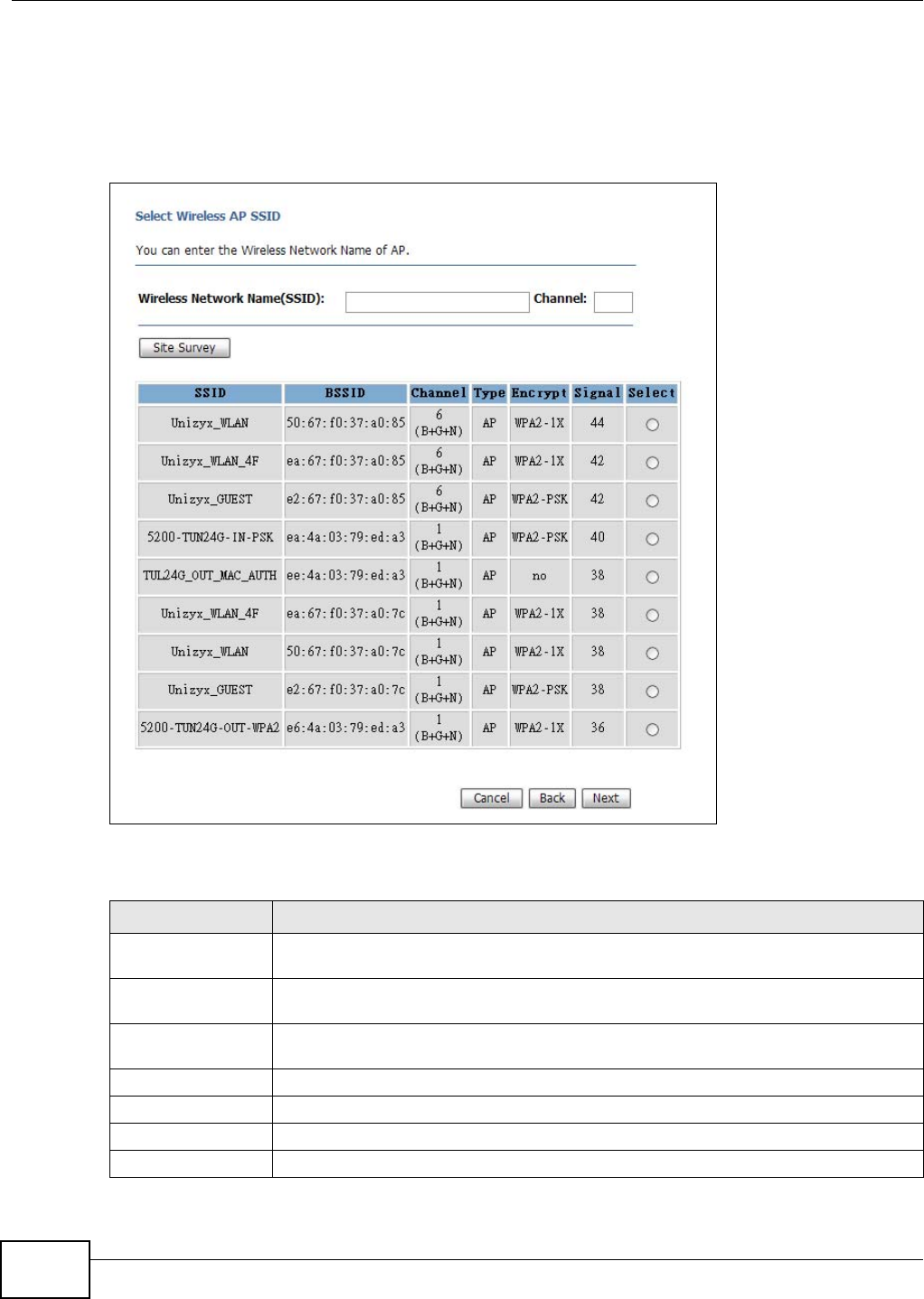
Chapter 7 WISP+UR Setup Wizard
NBG2105 User’s Guide
54
7.4 Wireless Network Name Setup
Name your wireless network by entering an SSID or by clicking Site Survey and selecting one of
the detected devices. Click Next to proceed with the Wireless Security Mode screen.
Figure 34 Wireless Network Name Setup
The following table describes the labels in this screen.
Table 27 Wireless Network Name Setup
LABEL DESCRIPTION
Wireless Network
Name (SSID)
Enter the SSID of the AP to which you want the NBG2105 in WISP+UR mode to
connect.
Channel Enter the channel number used by the wireless device to which the NBG2105 is
connecting. This is optional if the AP does not broadcast and hides the SSID.
Site Survey Click this to search for available wireless devices within transmission range and update
this table.
SSID This shows the SSID of the wireless device.
BSSID This shows the MAC address of the wireless device.
Channel This shows the channel number and wireless standard used by this wireless device.
Type This shows the type of device found in the survey.
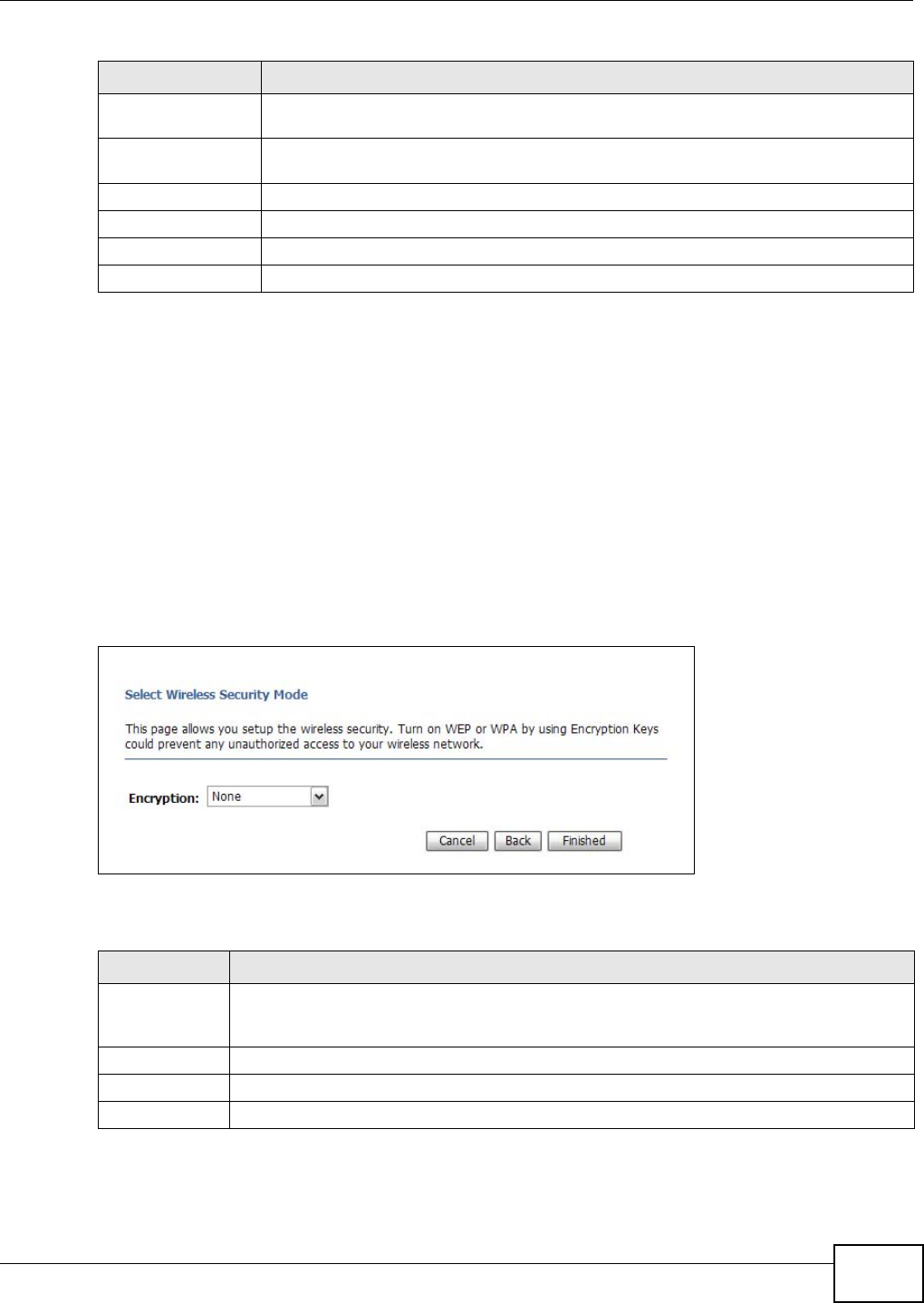
Chapter 7 WISP+UR Setup Wizard
NBG2105 User’s Guide 55
7.5 Wireless Security
Configure the wireless security settings on your NBG2105 in the following screen. The fields that
show up depend on the kind of security you select.
7.5.1 Encryption: None
Choose None in the Encryption field to let wireless devices within range access your wireless
network. Complete the fields described. Click Finished to save the configuration end exit the
wizard.
Figure 35 Encryption: None
The following table describes the labels in this screen.
Encrypt This displays the data encryption and authentication method used by this wireless
device.
Signal This displays the strength of the wireless signal. The signal strength mainly depends on
the antenna output power and the distance between your NBG2105 and this device.
Select Click this to select a device.
Cancel Click this to cancel the wizard.
Back Click this to go back to the previous step in the wizard.
Next Click this to open a screen to configure wireless security options.
Table 27 Wireless Network Name Setup (continued)
LABEL DESCRIPTION
Table 28 Encryption: None
LABEL DESCRIPTION
Encryption Select None to have no wireless LAN security configured. If you do not enable any wireless
security on your NBG2105, your network is accessible to any wireless networking device
that is within range.
Cancel Click this to cancel the wizard.
Back Click this to go back to the previous step in the wizard.
Finished Click this to finish the wizard.
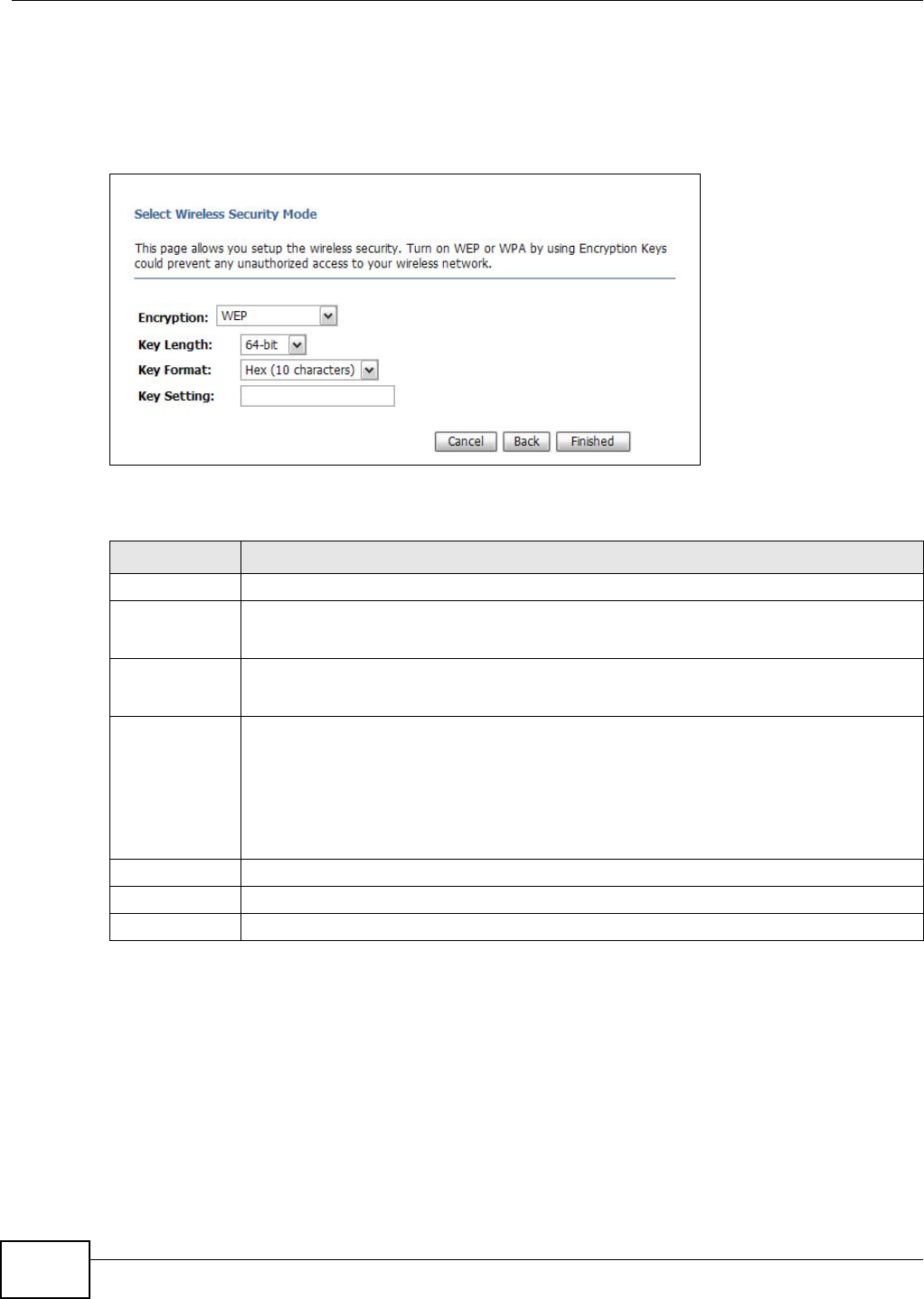
Chapter 7 WISP+UR Setup Wizard
NBG2105 User’s Guide
56
7.5.2 Encryption: WEP
Choose WEP in the Encryption field to protect your wireless network with Wired Equivalent
Privacy. Complete the fields described. Click Finished to save the configuration end exit the wizard.
Figure 36 Encryption: WEP
The following table describes the labels in this screen.
7.5.3 Encryption: WPA-PSK or WPA2-PSK
Choose WPA-PSK or WPA2-PSK in the Encryption field to protect your wireless network with
WPA-PSK or WPA2-PSK encryption. Complete the fields described. Click Finished to save the
configuration end exit the wizard.
Table 29 Encryption: WEP
LABEL DESCRIPTION
Encryption Select WEP to allow clients to associate this network with WEP authentication.
Key Length Select 64-bit or 128-bit.
This dictates the length of the security key that the network is going to use.
Key Format Select Hex to enter hexadecimal characters as a WEP key.
Select ASCII to enter ASCII characters as WEP key.
Key Setting The WEP keys are used to encrypt data. Both the NBG2105 and the wireless stations must
use the same WEP key for data transmission.
If you chose 64-bit in the Key Format field, then enter any 5 ASCII characters or 10
hexadecimal characters ("0-9", "A-F").
If you chose 128-bit in the Key Format field, then enter 13 ASCII characters or 26
hexadecimal characters ("0-9", "A-F").
Cancel Click this to cancel the wizard.
Back Click this to go back to the previous step in the wizard.
Finished Click this to finish the wizard.
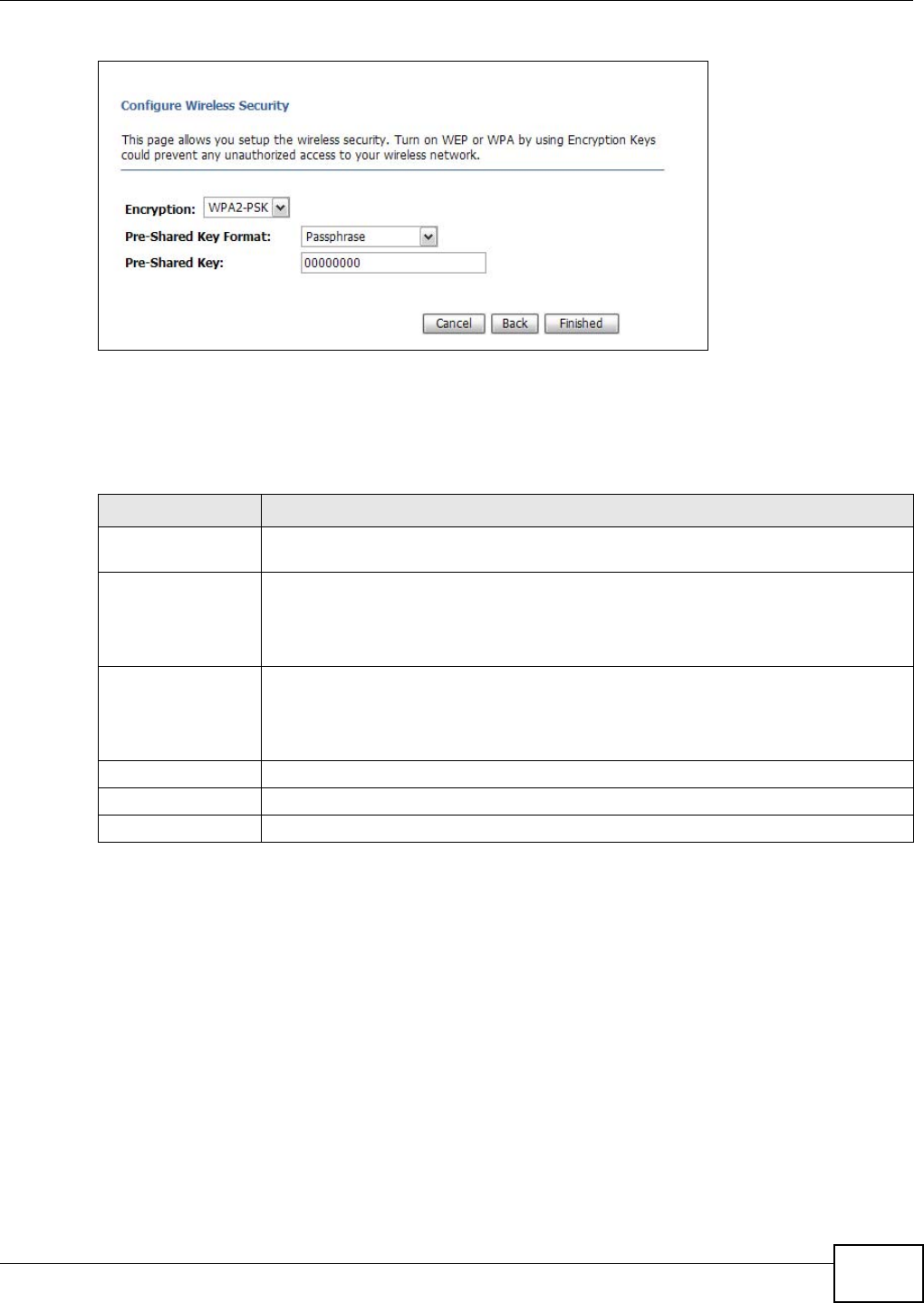
Chapter 7 WISP+UR Setup Wizard
NBG2105 User’s Guide 57
Figure 37 Encryption: WPA2-PSK
Note: Although only the WPA2-PSK screen is shown, all fields are the same for the
WPA-PSK screen.
The following table describes the labels in this screen.
Table 30 Encryption: WPA-PSK or WPA2-PSK
LABEL DESCRIPTION
Encryption Select WPA-PSK or WPA2-PSK to allow clients to associate this network with WPA or
WPA2 authentication.
Pre-Shared Key
Format
Select Passphrase to make the NBG2105 generate a key from a phrase typed into the
Pre-Shared Key field.
Select HEX to configure the NBG2105 to accept a key in hexadecimal format in the
Pre-Shared Key field.
Pre-Shared Key If Passphrase was selected in the Pre-Shared Key Format field, type a pre-shared
key from 8 to 63 case-sensitive keyboard characters.
If HEX was selected in the Pre-Shared Key Format field, type a pre-shared key using
hexadecimal characters ("0-9", "A-F").
Cancel Click this to cancel the wizard.
Back Click this to go back to the previous step in the wizard.
Finished Click this to finish the wizard.

Chapter 7 WISP+UR Setup Wizard
NBG2105 User’s Guide
58

NBG2105 User’s Guide 59
CHAPTER 8
Tutorials
8.1 Overview
This chapter provides tutorials for setting up your NBG2105.
•Set Up a Wireless Network with WPS
•Configure Wireless Security without WPS
8.2 Set Up a Wireless Network with WPS
This section gives you an example of how to set up wireless network using WPS. This example uses
the NBG2105 as the AP and NWD210N as the wireless client which connects to a notebook.
Note: The wireless client must be a WPS-aware device (for example, a WPS USB adapter
or PCI card).
There are two WPS methods for creating a secure connection. This tutorial shows you how to do
both.
•Push Button Configuration (PBC) - create a secure wireless network simply by pressing a
button. See Section 8.2.1 on page 59.This is the easier method.
•PIN Configuration - create a secure wireless network simply by entering a wireless client's PIN
(Personal Identification Number) in the NBG2105’s interface. See Section 8.2.2 on page 60. This
is the more secure method, since one device can authenticate the other.
8.2.1 Push Button Configuration (PBC)
1Make sure that your NBG2105 is turned on and working as an AP or wireless router. Make sure that
the device is placed within range of your notebook.
2Make sure that you have installed the wireless client (this example uses the NWD210N) driver and
utility in your notebook.
3In the wireless client utility, find the WPS settings. Enable WPS and press the WPS button (Start or
WPS button)
4Log into NBG2105’s Web Configurator and press the Start PBC button in the Wireless LAN >
WPS screen.
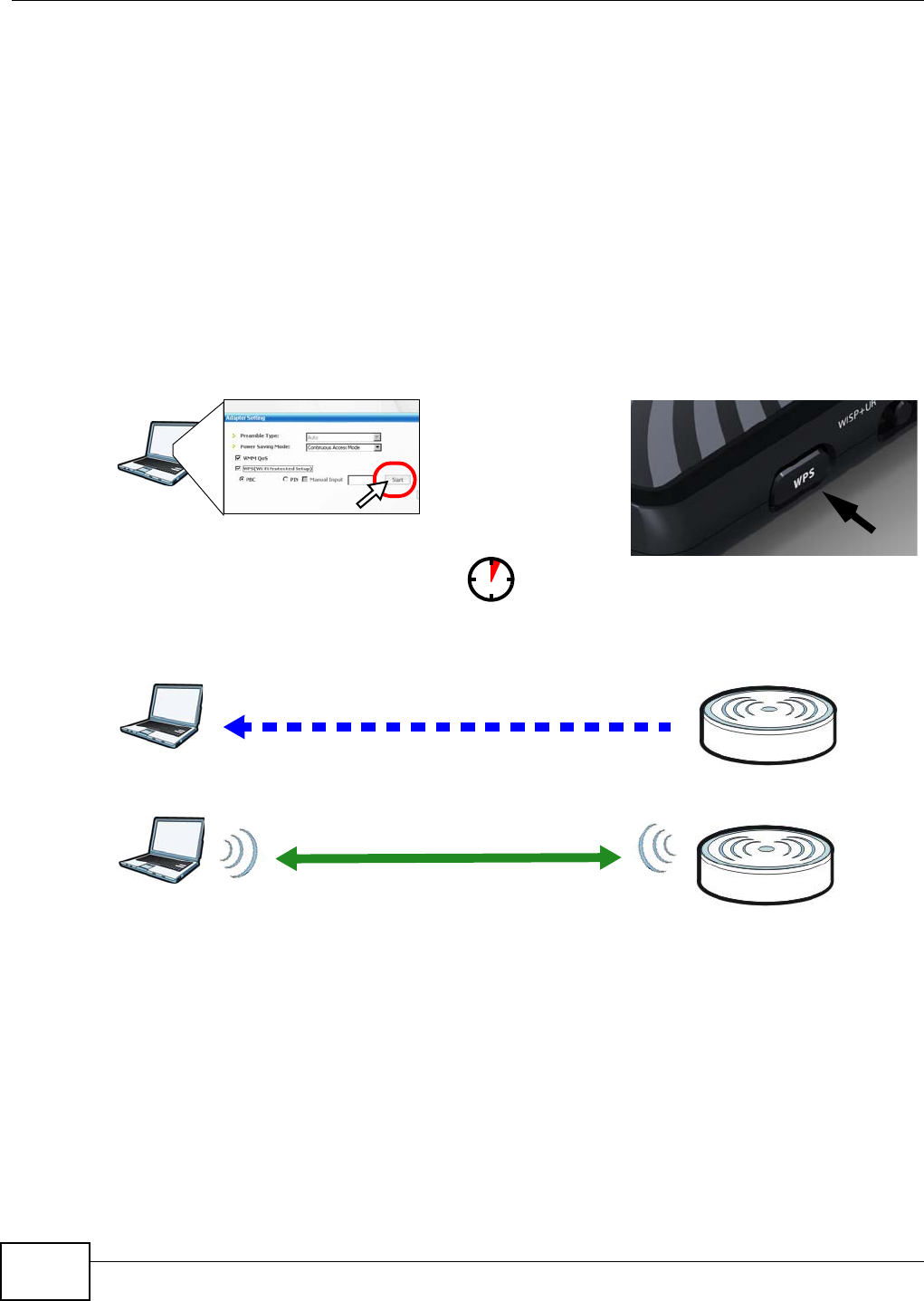
Chapter 8 Tutorials
NBG2105 User’s Guide
60
Note: Your NBG2105 has a WPS button located on its panel, as well as a WPS button in its
configuration utility. Both buttons have exactly the same function; you can use one
or the other.
Note: It doesn’t matter which button is pressed first. You must press the second button
within two minutes of pressing the first one.
The NBG2105 sends the proper configuration settings to the wireless client. This may take up to
two minutes. Then the wireless client is able to communicate with the NBG2105 securely.
The following figure shows you an example to set up wireless network and security by pressing a
button on both NBG2105 and wireless client (the NWD210N in this example).
Figure 38 Example WPS Process: PBC Method
8.2.2 PIN Configuration
When you use the PIN configuration method, you need to use both NBG2105’s configuration
interface and the client’s utilities.
1Launch your wireless client’s configuration utility. Go to the WPS settings and select the PIN method
to get a PIN number.
2Enter the PIN number into the Station PIN Number field in the Wireless LAN > WPS screen on
the NBG2105.
Wireless Client Access Point
SECURITY INFO
COMMUNICATION
WITHIN 2 MINUTES
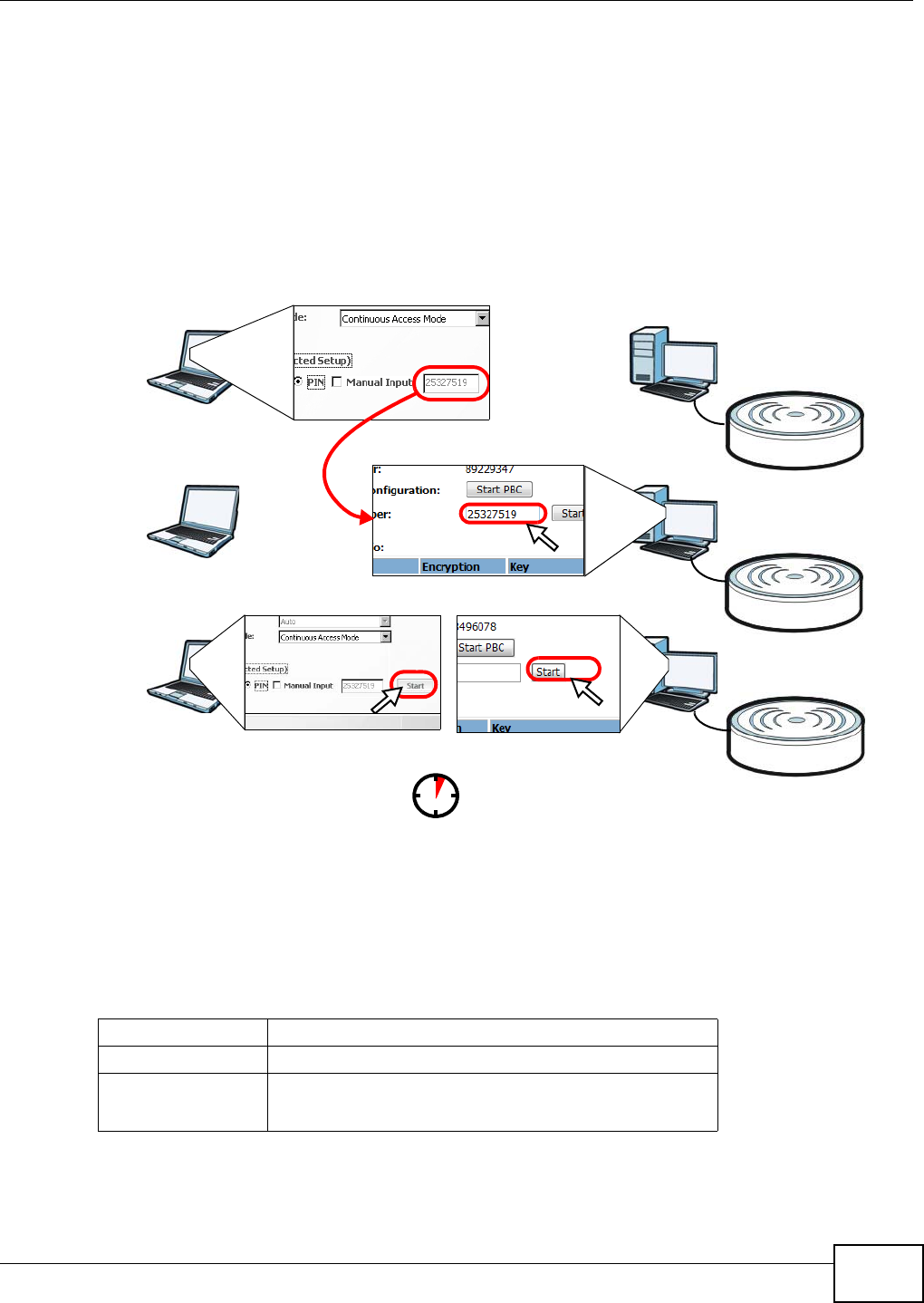
Chapter 8 Tutorials
NBG2105 User’s Guide 61
3Click Start buttons (or button next to the PIN field) on both the wireless client utility screen and the
NBG2105’s Wireless LAN > WPS screen within two minutes.
The NBG2105 authenticates the wireless client and sends the proper configuration settings to the
wireless client. This may take up to two minutes. Then the wireless client is able to communicate
with the NBG2105 securely.
The following figure shows you the example to set up wireless network and security on NBG2105
and wireless client (ex. NWD210N in this example) by using PIN method.
Figure 39 Example WPS Process: PIN Method
8.3 Configure Wireless Security without WPS
This example shows you how to configure wireless security settings with the following parameters
on your NBG2105. This section does not apply to Client mode.
Follow the steps below to configure the wireless settings on your NBG2105.
WITHIN 2 MINUTES
Wireless Client
Access Point
SSID SSID_Example3
Channel 6
Security WPA2-PSK
(Pre-Shared Key: ThisismyWPA-PSKpre-sharedkey)
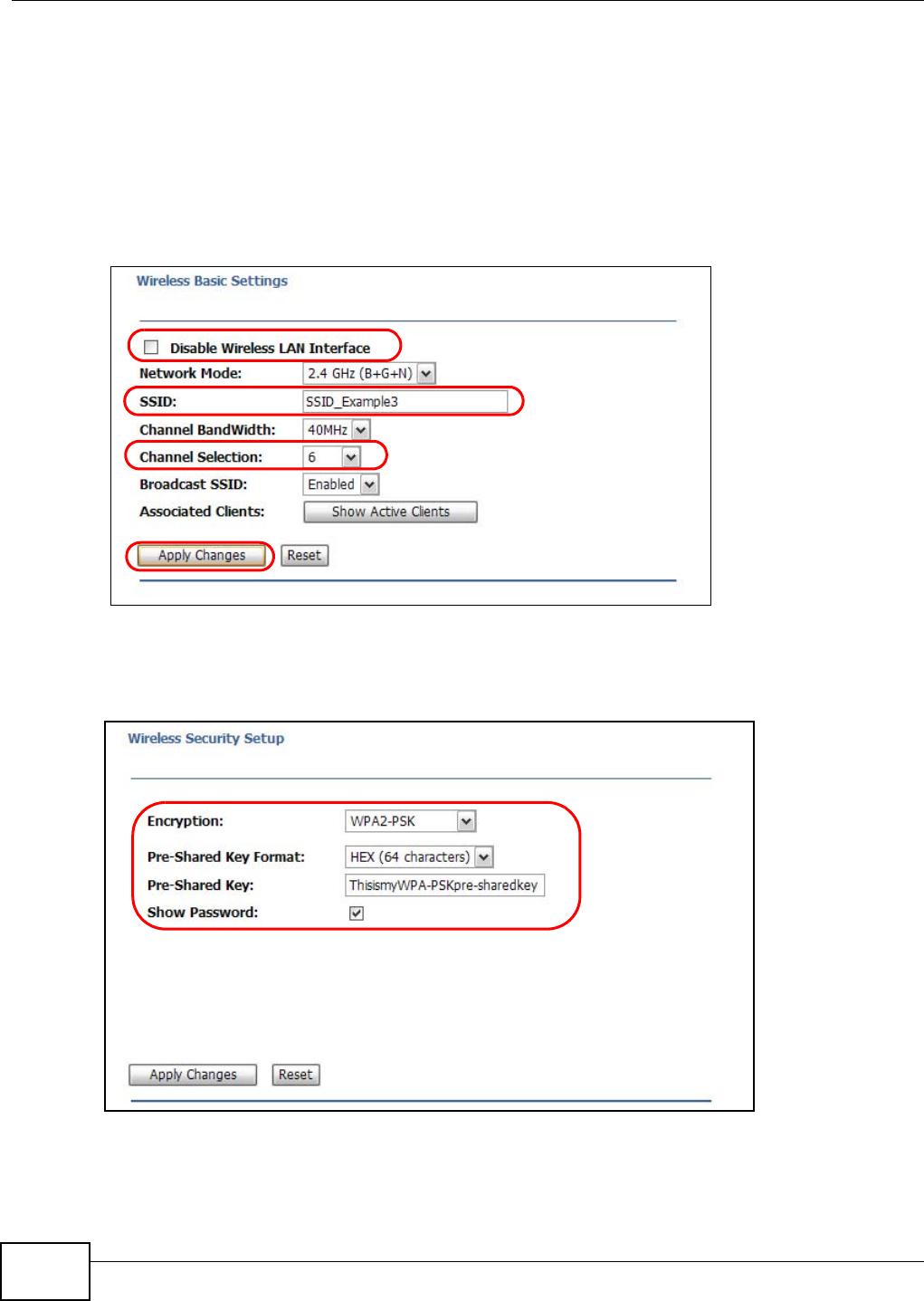
Chapter 8 Tutorials
NBG2105 User’s Guide
62
The instructions require that your hardware is connected (see the Quick Start Guide) and you are
logged into the Web Configurator through your LAN connection (see Section 2.2 on page 19).
1Make sure your NBG2105 is turned on and working as an AP or wireless router.
2Open the Wireless LAN > Basic screen in the NBG2105’s Web Configurator.
3Confirm that Disable Wireless LAN Interface is not selected.
4Enter SSID_Example3 as the SSID and select 6 as the channel. Click Apply Changes.
5Open the Wireless LAN > Security screen in the NBG2105’s Web Configurator.
6Set Encryption to WPA2-PSK, set Pre-Shared Key Format to HEX and enter ThisismyWPA-
PSKpre-sharedkey in the Pre-Shared Key field.
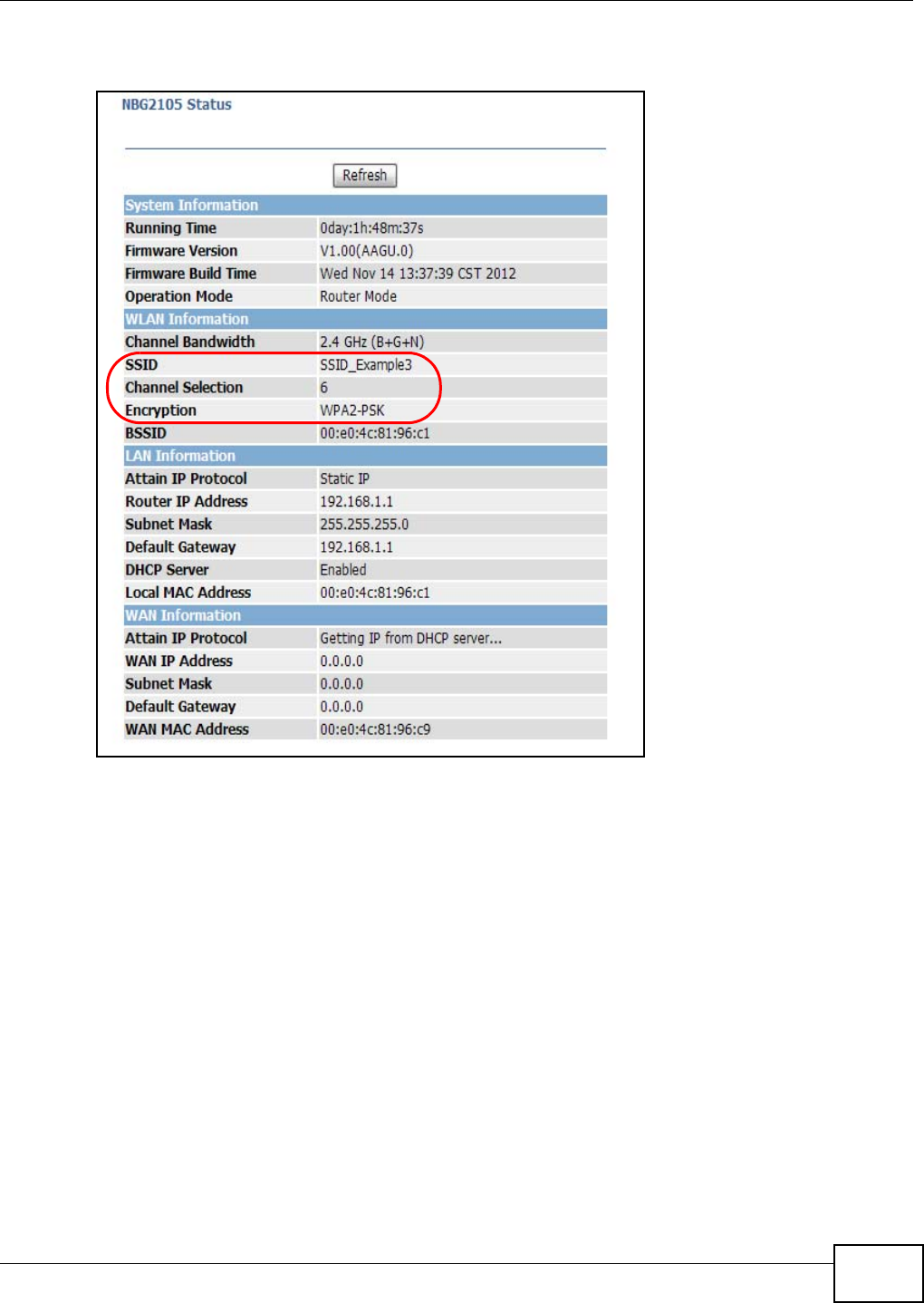
Chapter 8 Tutorials
NBG2105 User’s Guide 63
7Open the Status screen. Verify your wireless and wireless security settings under Wireless
Network.
8.3.1 Configure Your Notebook
Note: We use the ZyXEL NWD2205 wireless adapter utility screens as an example for the
wireless client. The screens may vary for different models.
1The NBG2105 supports IEEE 802.11b, IEEE 802.11g and IEEE 802.11n wireless clients. Make sure
that your notebook or computer’s wireless adapter supports one of these standards.
2Wireless adapters come with software sometimes called a “utility” that you install on your
computer. See your wireless adapter’s User’s Guide for information on how to do that.
3After you’ve installed the utility, open it. If you cannot see your utility’s icon on your screen, go to
Start > Programs and click on your utility in the list of programs that appears. The utility displays
a list of APs within range, as shown in the example screen below.
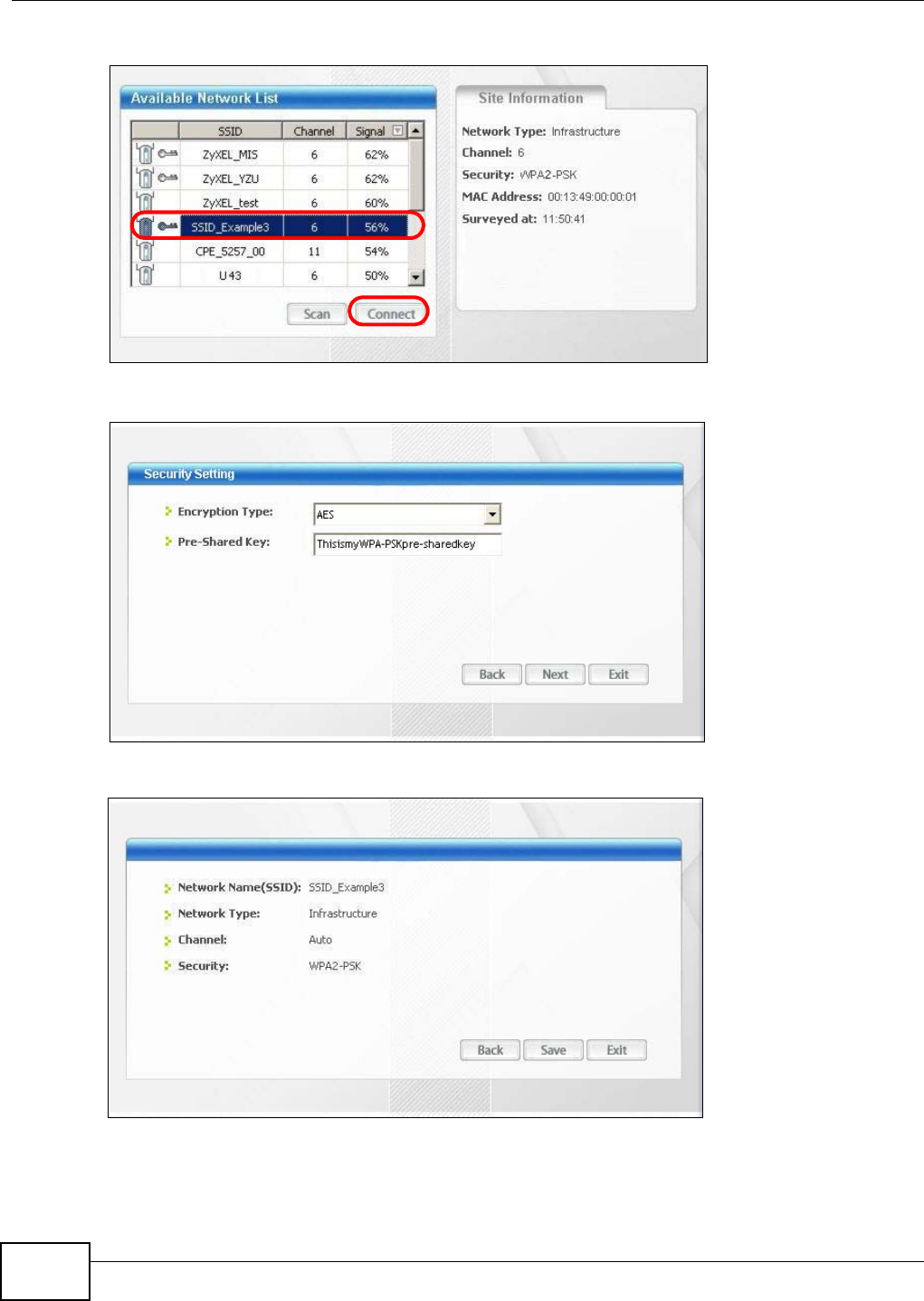
Chapter 8 Tutorials
NBG2105 User’s Guide
64
4Select SSID_Example3 and click Connect.
5Select AES and type the security key in the following screen. Click Next.
6The Confirm Save window appears. Check your settings and click Save to continue.
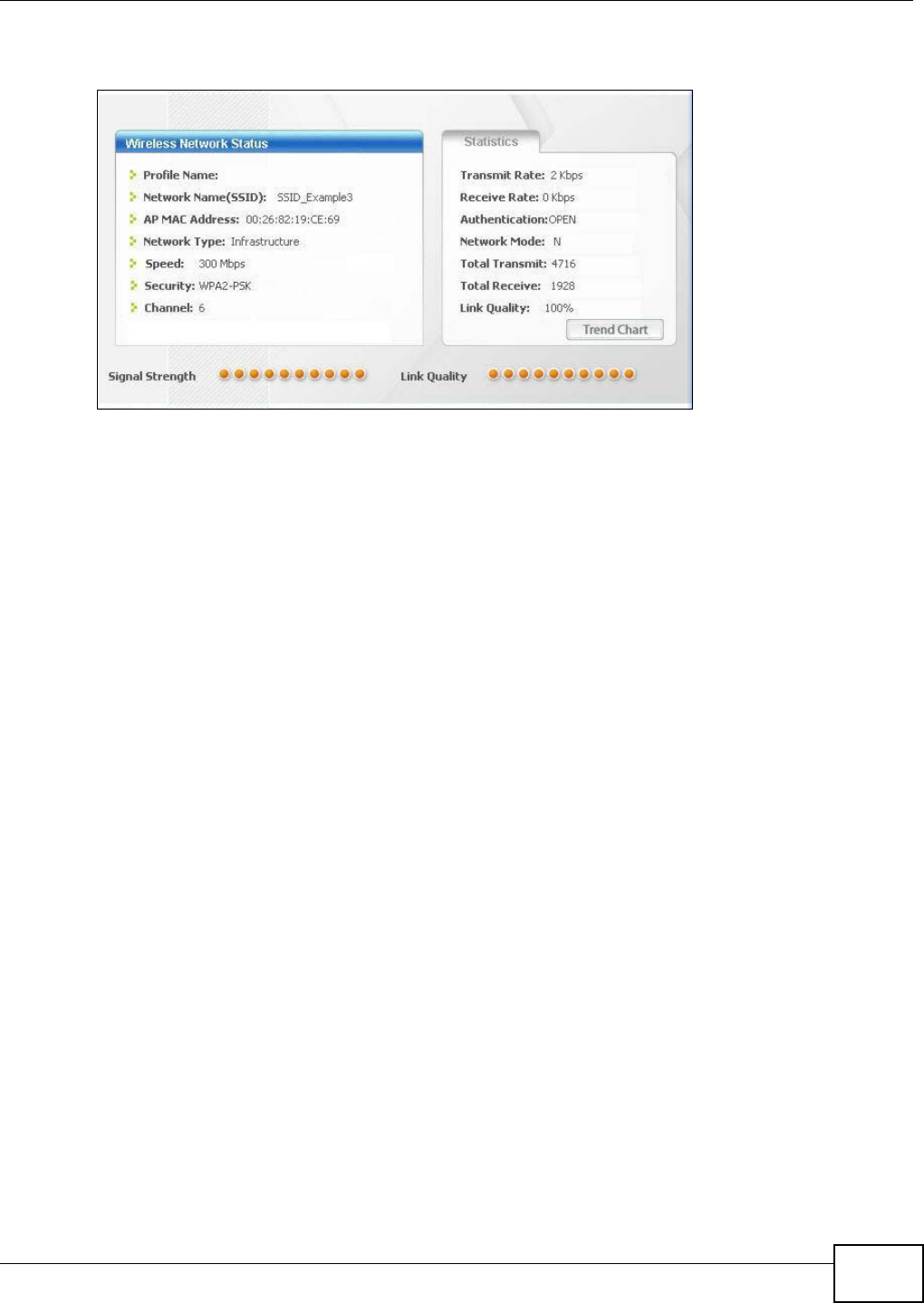
Chapter 8 Tutorials
NBG2105 User’s Guide 65
7Check the status of your wireless connection in the screen below. If your wireless connection is
weak or you have no connection, see the Troubleshooting section of this User’s Guide.
If your connection is successful, open your Internet browser and enter http://www.zyxel.com or the
URL of any other web site in the address bar. If you are able to access the web site, your wireless
connection is successfully configured.

Chapter 8 Tutorials
NBG2105 User’s Guide
66

67
PART II
Technical Reference

68
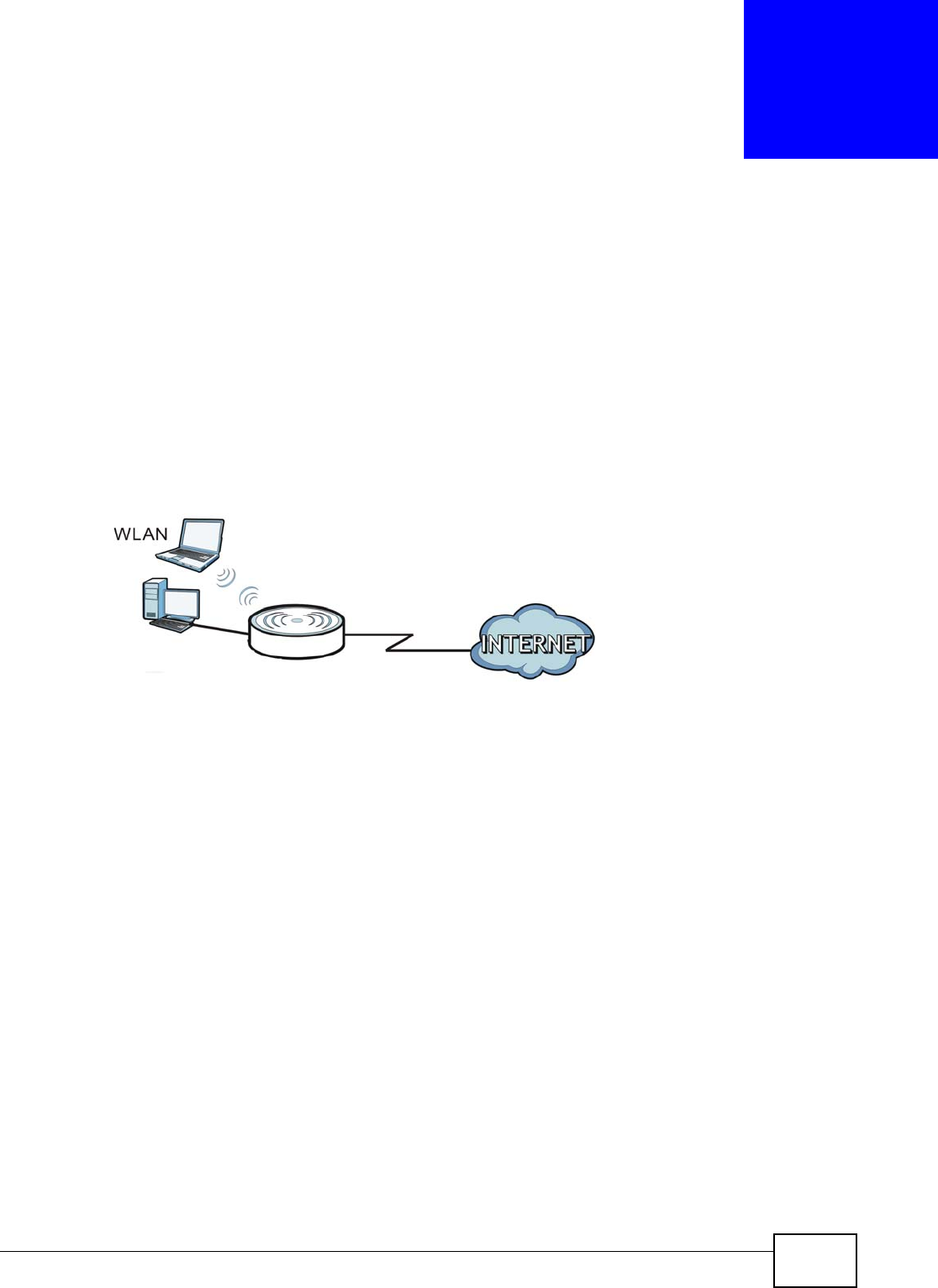
NBG2105 User’s Guide 69
CHAPTER 9
LAN
9.1 Overview
This chapter describes how to configure LAN settings.
A Local Area Network (LAN) is a shared communication system to which many computers are
attached. A LAN is a computer network limited to the immediate area, usually the same building or
floor of a building. The LAN screens can help you configure a LAN DHCP server and manage IP
addresses.
Figure 40 LAN Example
9.2 What You Can Do
•Use the LAN Interface Setup screen to change the IP address for your NBG2105 (Section 9.4
on page 70).
•Use the Active DHCP Client screen to see which DHCP clients have accepted their IP
configuration from the NBG2105 (Section 9.4.1 on page 71).
9.3 What You Need To Know
The LAN parameters of the NBG2105 are preset in the factory with the following values:
• IP address of 192.168.1.1 (Router mode) or 192.168.1.2 (non-router modes) with subnet mask
of 255.255.255.0 (24 bits)
• DHCP server enabled (Router mode or WISP+UR mode) with client IP addresses starting from
192.168.1.100 and ending with 192.168.1.200.
These parameters should work for the majority of installations. If your ISP gives you explicit DNS
server address(es), read the embedded Web Configurator help regarding what fields need to be
configured.
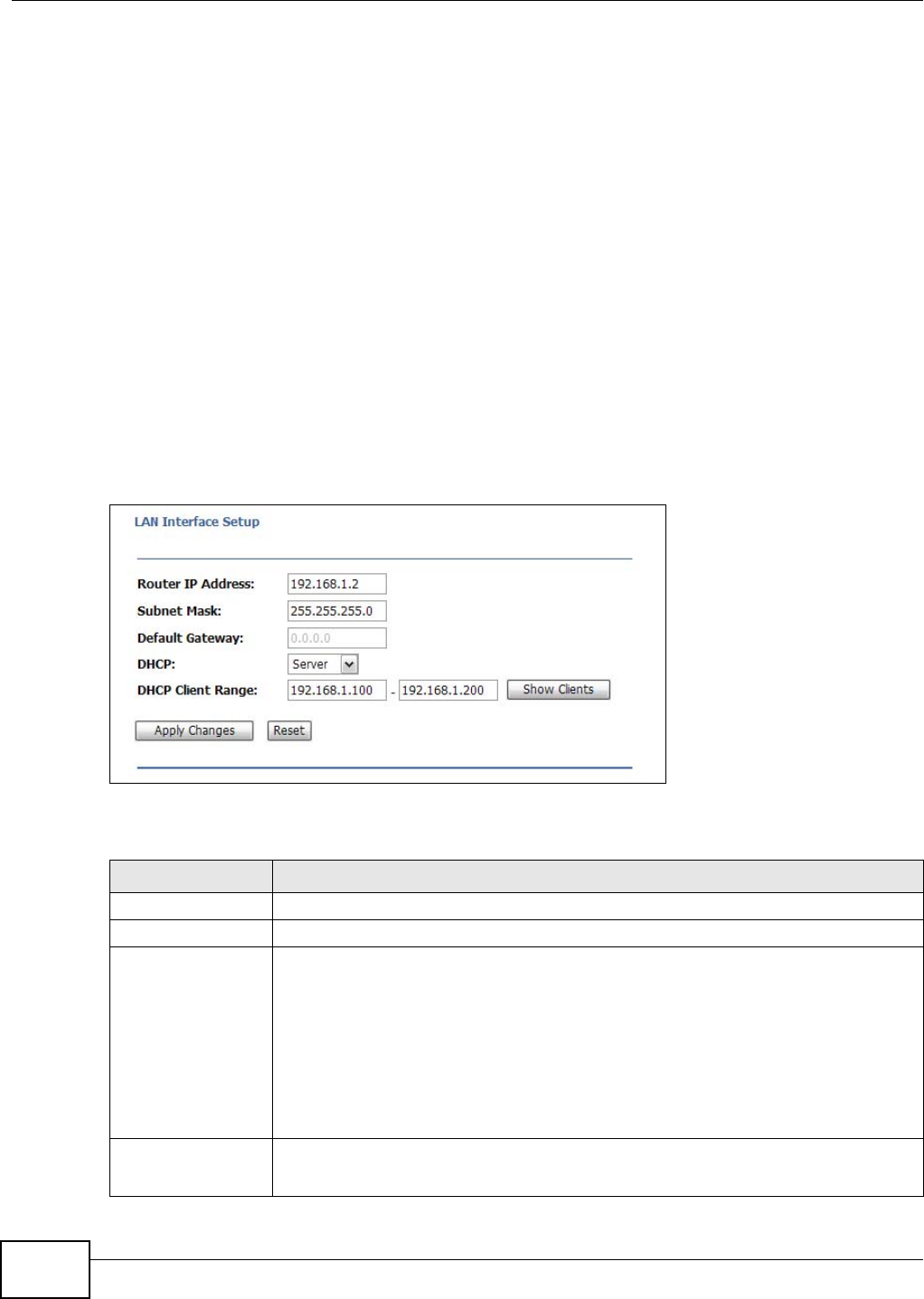
Chapter 9 LAN
NBG2105 User’s Guide
70
9.3.1 IP Pool Setup
The NBG2105 is pre-configured with a pool of IP addresses starting from 192.168.1.100 to
192.168.1.200. This configuration leaves 98 IP addresses (excluding the NBG2105 itself) under
192.168.1.99 for other server computers, for instance, servers for mail, FTP, TFTP, web, etc., that
you may have.
9.3.2 LAN TCP/IP
The NBG2105 has built-in DHCP server capability that assigns IP addresses and DNS servers to
systems that support DHCP client capability.
9.4 LAN Interface Setup Screen
Use this screen to change the IP address for your NBG2105 and configure the DHCP server. Click
Network > LAN.
Figure 41 Network > LAN: Server
The following table describes the labels in this screen.
Table 31 Network > LAN
LABEL DESCRIPTION
Router IP Address Enter the IP address of the NBG2105 management interface.
Subnet Mask Enter the subnet mask of the NBG2105 management interface.
DHCP DHCP (Dynamic Host Configuration Protocol, RFC 2131 and RFC 2132) allows individual
clients (computers) to obtain TCP/IP configuration at startup from a server.
DHCP server is disabled by default when the NBG2105 is in AP or Client mode.
Select Server to enable the DHCP server of the NBG2105. When configured as a
server, the NBG2105 provides TCP/IP configuration for the clients.
Select Disable to stop the NBG2105 acting as a DHCP server. If disabled, you must
have another DHCP server on your LAN, or else the computers must be manually
configured.
DHCP Client Range Enter the range of IP addresses that can be issued by the DHCP server.
This field is not configurable when DHCP server is disabled.
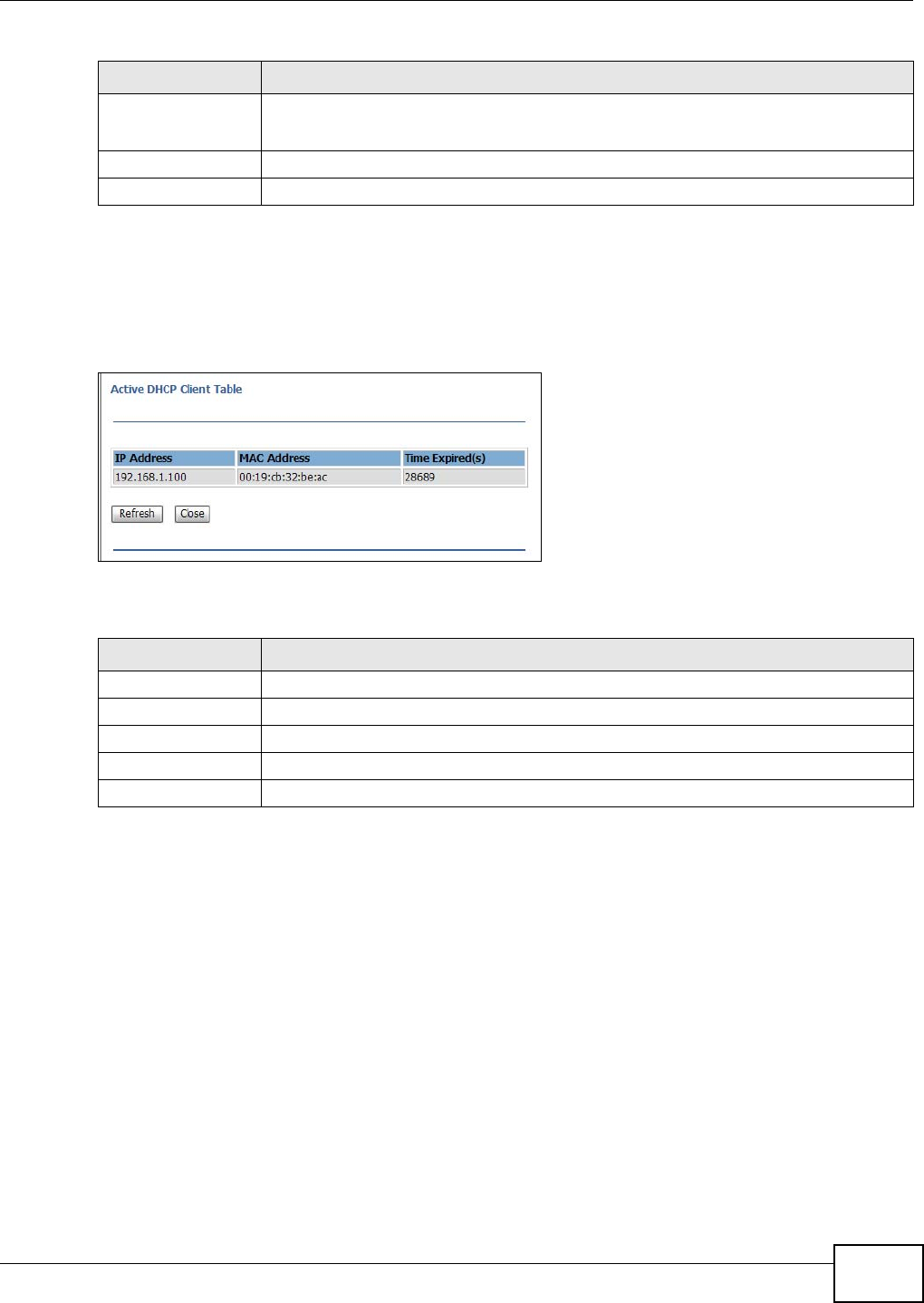
Chapter 9 LAN
NBG2105 User’s Guide 71
9.4.1 Active DHCP Client Screen
Use this screen to view which DHCP clients have accepted their IP configuration from the NBG2105.
Click Network > LAN, and then Show Clients.
Figure 42 Network > LAN: Show Clients
The following table describes the labels in this screen.
Show Clients Click this to show the IP addresses that have been issued by the DHCP server.
This field is not configurable when DHCP server is disabled.
Apply Changes Click this to save changes back to the NBG2105.
Reset Click this to begin configuring this screen afresh.
Table 31 Network > LAN (continued)
LABEL DESCRIPTION
Table 32 Network > LAN: Show Clients
LABEL DESCRIPTION
IP Address This shows the IP address leased to a DHCP client.
MAC Address This shows the MAC address of the client that leased the IP address.
Time Expired (s) This shows how many seconds remain on the DHCP lease.
Refresh Click this to update the screen.
Close Click this to close this screen.

Chapter 9 LAN
NBG2105 User’s Guide
72

NBG2105 User’s Guide 73
CHAPTER 10
WAN
10.1 Overview
This chapter discusses the NBG2105’s WAN screens. Use these screens to configure your NBG2105
for Internet access.
A WAN (Wide Area Network) connection is an outside connection to another network or the
Internet. It connects your private networks such as a LAN (Local Area Network) and other
networks, so that a computer in one location can communicate with computers in other locations.
10.2 What You Can Do
You can configure your WAN interface to access your ISP in the following ways.
•Static IP allows you to configure all NBG2105 WAN IP configuration settings manually (Section
10.4.1 on page 74).
•DHCP Client allows the NBG2105 to get its IP configuration from a DHCP server (Section 10.4.2
on page 75).
•PPPoE allows the NBG2105 to connect via the Point-to-Point Protocol over Ethernet (Section
10.4.3 on page 76).
10.3 What You Need To Know
The information in this section can help you configure the screens for your WAN connection.
10.3.1 Configuring Your Internet Connection
Encapsulation Method
Encapsulation is used to include data from an upper layer protocol into a lower layer protocol. To set
up a WAN connection to the Internet, you need to use the same encapsulation method used by your
ISP (Internet Service Provider). If your ISP offers a dial-up Internet connection using PPPoE (PPP
over Ethernet), they should also provide a username and password (and service name) for user
authentication.

Chapter 10 WAN
NBG2105 User’s Guide
74
WAN IP Address
The WAN IP address is an IP address for the NBG2105, which makes it accessible from an outside
network. It is used by the NBG2105 to communicate with other devices in other networks. It can be
static (fixed) or dynamically assigned by the ISP each time the NBG2105 tries to access the
Internet.
If your ISP assigns you a static WAN IP address, they should also assign you the subnet mask and
DNS server IP address(es) (and a gateway IP address if you use the Ethernet or ENET ENCAP
encapsulation method).
DNS Server Address Assignment
Use Domain Name System (DNS) to map a domain name to its corresponding IP address and vice
versa, for instance, the IP address of www.zyxel.com is 204.217.0.2. The DNS server is extremely
important because without it, you must know the IP address of a computer before you can access
it.
The NBG2105 can get the DNS server addresses in the following ways.
1The ISP tells you the DNS server addresses, usually in the form of an information sheet, when you
sign up. If your ISP gives you DNS server addresses, manually enter them in the DNS server fields.
2If your ISP dynamically assigns the DNS server IP addresses (along with the NBG2105’s WAN IP
address), set the DNS server fields to get the DNS server address from the ISP.
WAN MAC Address
The WAN port's MAC address can be configured by either using the factory default or cloning the
MAC address from a computer on your LAN. Choose Clear Mac Clone to select the factory assigned
default MAC Address.
Otherwise, press the Clone MAC address button on the side of the NBG2105 to clone the MAC
address of the computer connected to the NBG2105. Once it is successfully configured, the address
will be copied to configuration file. It is recommended that you clone the MAC address prior to
hooking up the WAN Port.
10.4 WAN Interface Setup
Click Network > WAN to change how your NBG2105’s WAN interface accesses your ISP. The
screen differs according to the WAN Access Type you choose.
10.4.1 Static IP
Select Static IP from WAN Access Type to configure all NBG2105 WAN IP configuration settings
manually.
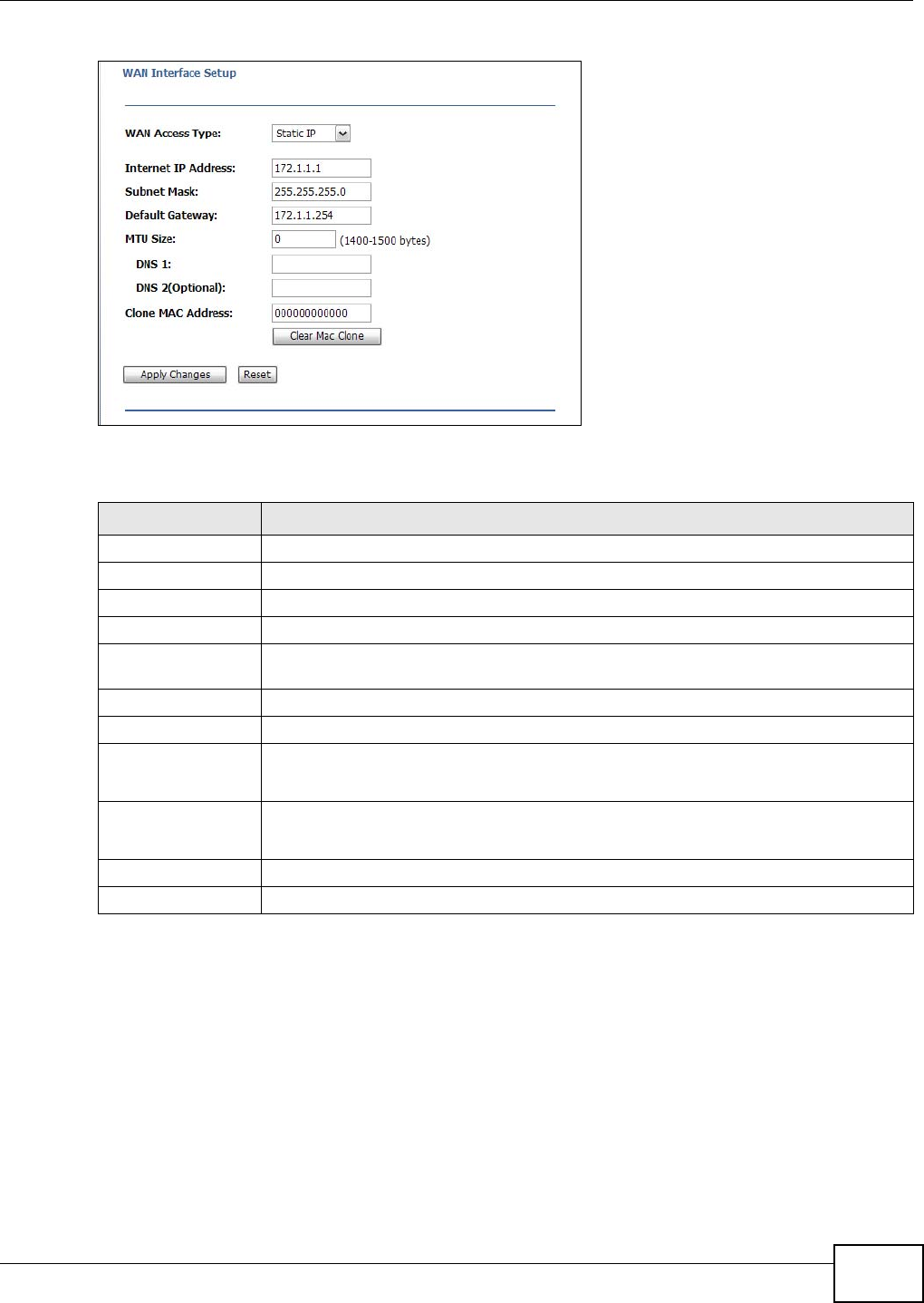
Chapter 10 WAN
NBG2105 User’s Guide 75
Figure 43 Network > WAN: Static IP
The following table describes the labels in this screen.
10.4.2 DHCP Client
Select DHCP Client from WAN Access Type to make the NBG2105 get its IP configuration from a
DHCP server.
Table 33 Network > WAN: Static IP
LABEL DESCRIPTION
WAN Access Type Select Static IP to enable manual configuration of all NBG2105 IP settings.
Internet IP Address Enter the Internet-facing IP address.
Subnet Mask Enter the subnet mask of the NBG2105 WAN interface.
Default Gateway Enter the IP address of a default gateway to the Internet.
MTU Size Enter the MTU (Maximum Transmission Unit) size for each packet. If a larger packet
arrives, the NBG2105 divides it into smaller fragments.
DNS 1 Enter the IP address of the primary DNS server.
DNS 2 (Optional) Enter the IP address of the secondary DNS server.
Clone MAC Address Enter the MAC address of the WAN interface.
This field is available only when the NBG2105 is in router mode.
Clear Mac Clone Click this to reset the MAC address of the WAN interface to factory defaults.
This field is available only when the NBG2105 is in router mode.
Apply Changes Click this to save changes back to the NBG2105.
Reset Click this to begin configuring this screen afresh.
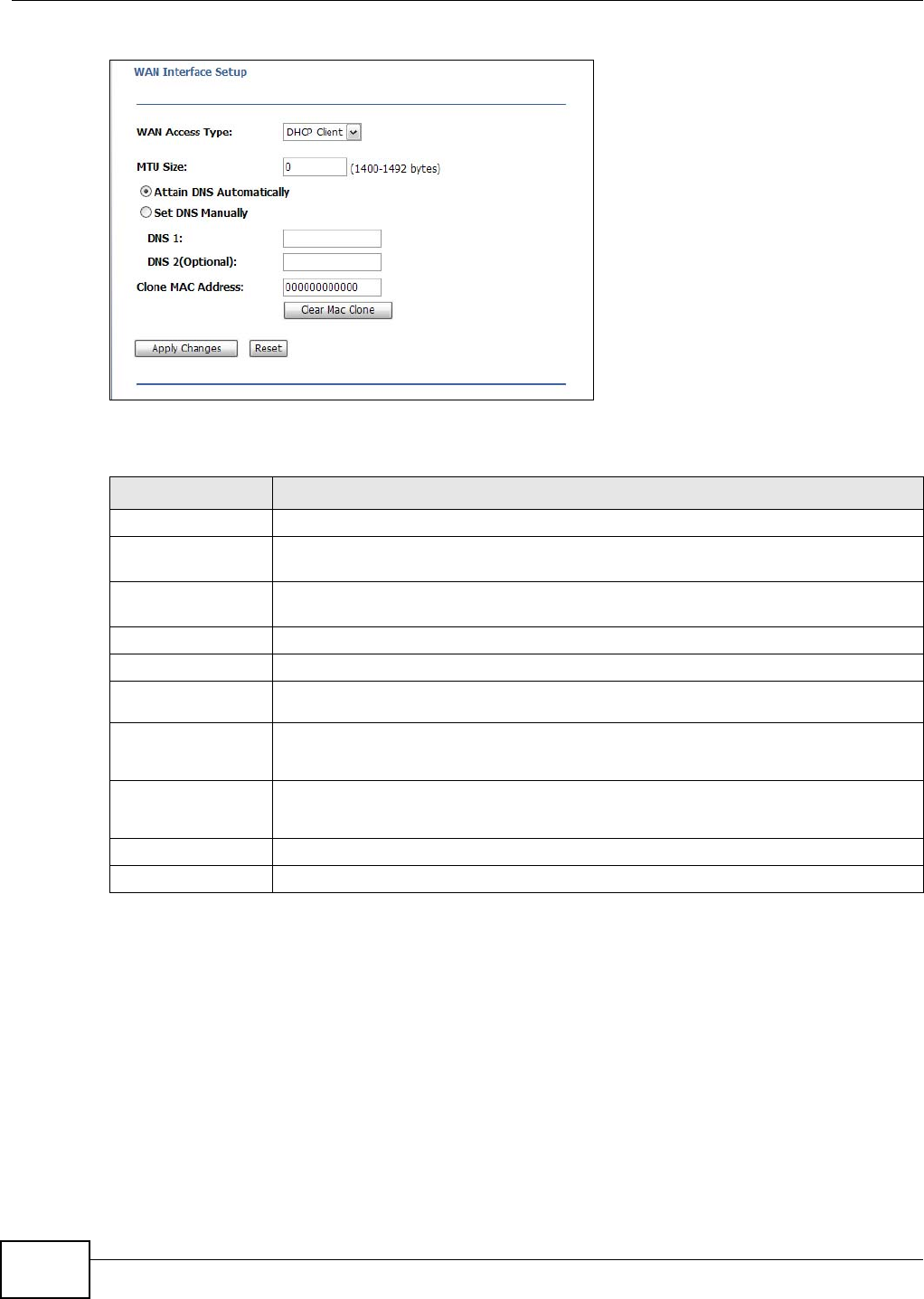
Chapter 10 WAN
NBG2105 User’s Guide
76
Figure 44 Network > WAN: DHCP Client
The following table describes the labels in this screen.
10.4.3 PPPoE
The NBG2105 supports PPPoE (Point-to-Point Protocol over Ethernet). PPPoE is an IETF standard
(RFC 2516) specifying how a personal computer (PC) interacts with a broadband modem (DSL,
cable, wireless, etc.) connection. The PPPoE option is for a dial-up connection using PPPoE.
For the service provider, PPPoE offers an access and authentication method that works with existing
access control systems (for example Radius).
One of the benefits of PPPoE is the ability to let you access one of multiple network services, a
function known as dynamic service selection. This enables the service provider to easily create and
offer new IP services for individuals.
Table 34 Network > WAN: DHCP Client
LABEL DESCRIPTION
WAN Access Type Select DHCP Client to make the NBG2105 get its IP configuration from a DHCP server.
MTU Size Enter the MTU (Maximum Transmission Unit) size for each packet. If a larger packet
arrives, the NBG2105 divides it into smaller fragments.
Attain DNS
Automatically
Select this to configure the NBG2105 to get addresses of DNS servers via DHCP.
Set DNS Manually Select this to configure the NBG2105 to use DNS server addresses manually.
DNS 1 Enter the IP address of the primary DNS server.
DNS 2
(Optional) Enter the IP address of the secondary DNS server.
Clone MAC Address Enter the MAC address of the WAN interface.
This field is available only when the NBG2105 is in router mode.
Clear Mac Clone Click this to reset the MAC address of the WAN interface to factory defaults.
This field is available only when the NBG2105 is in router mode.
Apply Changes Click this to save changes back to the NBG2105.
Reset Click this to begin configuring this screen afresh.
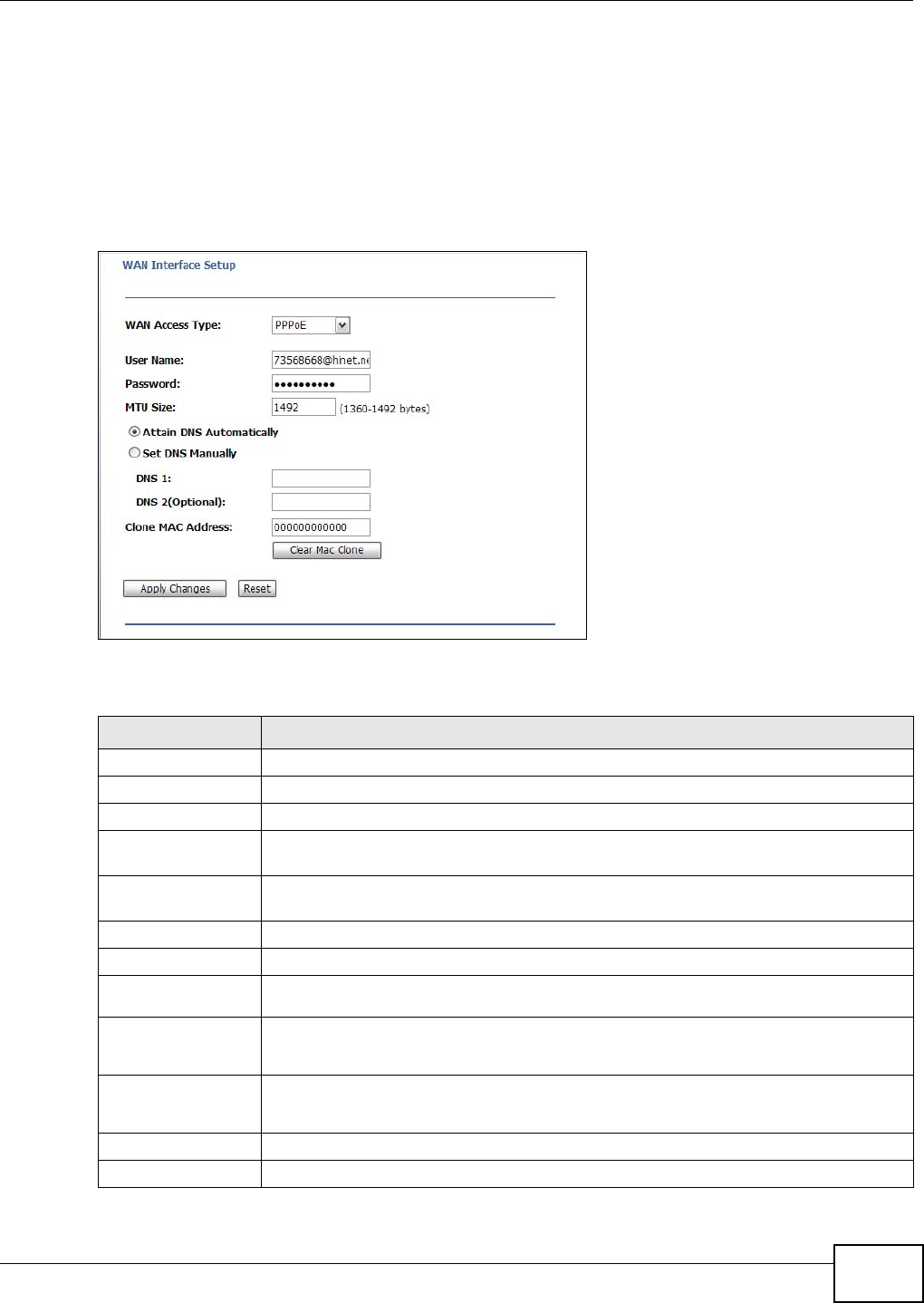
Chapter 10 WAN
NBG2105 User’s Guide 77
Operationally, PPPoE saves significant effort for both you and the ISP or carrier, as it requires no
specific configuration of the broadband modem at the customer site.
By implementing PPPoE directly on the NBG2105 (rather than individual computers), the computers
on the LAN do not need PPPoE software installed, since the NBG2105 does that part of the task.
Furthermore, with NAT, all of the LANs’ computers will have access.
Select PPPoE from WAN Access Type to make the NBG2105 get its IP configuration via PPPoE.
Figure 45 Network > WAN: PPPoE
The following table describes the labels in this screen.
Table 35 Network > WAN: PPPoE
LABEL DESCRIPTION
WAN Access Type Select PPPoE to make the NBG2105 get its IP configuration via PPPoE.
User Name Enter the user name provided by your ISP.
Password Enter the password provided by your ISP.
MTU Size Enter the MTU (Maximum Transmission Unit) size for each packet. If a larger packet
arrives, the NBG2105 divides it into smaller fragments.
Attain DNS
Automatically
Select this to configure the NBG2105 to get addresses of DNS servers via DHCP.
Set DNS Manually Select this to configure the NBG2105 to use DNS server addresses manually.
DNS 1 Enter the IP address of the primary DNS server.
DNS 2
(Optional) Enter the IP address of the secondary DNS server.
Clone MAC Address Enter the MAC address of the WAN interface.
This field is available only when the NBG2105 is in router mode.
Clear Mac Clone Click this to reset the MAC address of the WAN interface to factory defaults.
This field is available only when the NBG2105 is in router mode.
Apply Changes Click this to save changes back to the NBG2105.
Reset Click this to begin configuring this screen afresh.

Chapter 10 WAN
NBG2105 User’s Guide
78
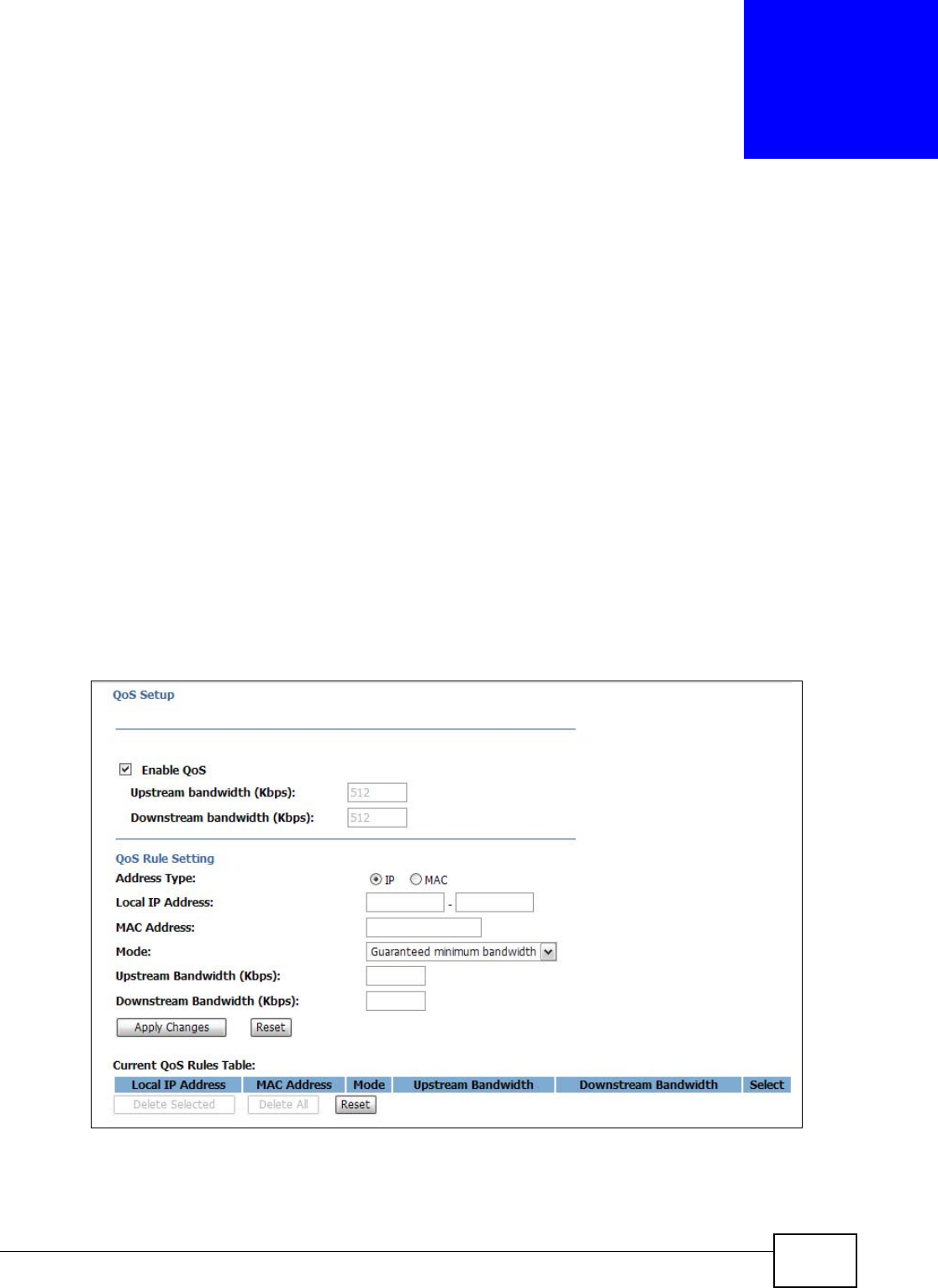
NBG2105 User’s Guide 79
CHAPTER 11
Quality of Service (QoS)
11.1 Overview
Quality of Service (QoS) refers to both a network’s ability to deliver data with minimum delay, and
the networking methods used to control the use of bandwidth. Without QoS, all traffic data is
equally likely to be dropped when the network is congested. This can cause a reduction in network
performance and make the network inadequate for time-critical application such as video-on-
demand.
Configure QoS on the NBG2105 to reserve bandwidth for certain traffic based on the IP address or
MAC address.
11.2 QoS Setup Screen
Click Network > QoS to show the QoS Setup screen.
Figure 46 Network > QoS

Chapter 11 Quality of Service (QoS)
NBG2105 User’s Guide
80
The following table describes the labels in this screen.
Table 36 Network > QoS
LABEL DESCRIPTION
QoS Setup
Enable QoS Select this to enable QoS.
Upstream
bandwidth (Kbps)
This shows the amount of upstream bandwidth for the WAN interface that you can
allocate using QoS.
The NBG2105 automatically sets this number to the WAN interface’s actual upstream
transmission speed.
Downstream
bandwidth (Kbps)
This shows the amount of downstream bandwidth for the WAN interface that you can
allocate using QoS.
The NBG2105 automatically sets this number to the WAN interface’s actual downstream
transmission speed.
QoS Rule Setting
Address Type Select IP to configure a QoS rule to match the source IP address of outgoing packets or
the destination IP address of incoming packets.
Select MAC to configure a QoS rule to match the source MAC address of outgoing
frames or the destination MAC address of incoming frames.
Local IP Address Enter the source IP address of outgoing packets or the destination IP address of
incoming packets that this QoS rule matches.
MAC Address Enter the source MAC address of outgoing packets or the destination MAC address of
incoming packets that this QoS rule matches.
Mode Select the mode for this rule: Guaranteed minimum bandwidth or restricted
maximum bandwith.
Upstream
Bandwidth (Kbps)
Enter the maximum/guaranteed minimum bandwidth (according to the mode you
select) allowed for outgoing traffic that matches the IP address or MAC address you
specified.
Downstream
Bandwidth (Kbps)
Enter the maximum/guaranteed minimum bandwidth (according to the mode you
select) allowed for incoming traffic that matches the IP address or MAC address you
specified.
Apply Changes Click this to save changes back to the NBG2105.
Reset Click this to begin configuring this screen afresh.
Current QoS Rules Table
Local IP Address This shows the source IP address of outgoing packets or the destination IP address of
incoming packets that this QoS rule matches.
MAC Address This shows the source MAC address of outgoing packets or the destination MAC address
of incoming packets that this QoS rule matches.
Mode This shows the mode of this rule.
Upstream
Bandwidth
This shows the uplink bandwidth that this rule enforces according to the Mode.
Downstream
Bandwidth
This shows the downlink bandwidth that this rule enforces according to the Mode.
Select Click this to select this rule.
Delete Selected Click this to delete the selected rules.
Delete All Click this to delete all rules.
Reset Click this to reset all selections.
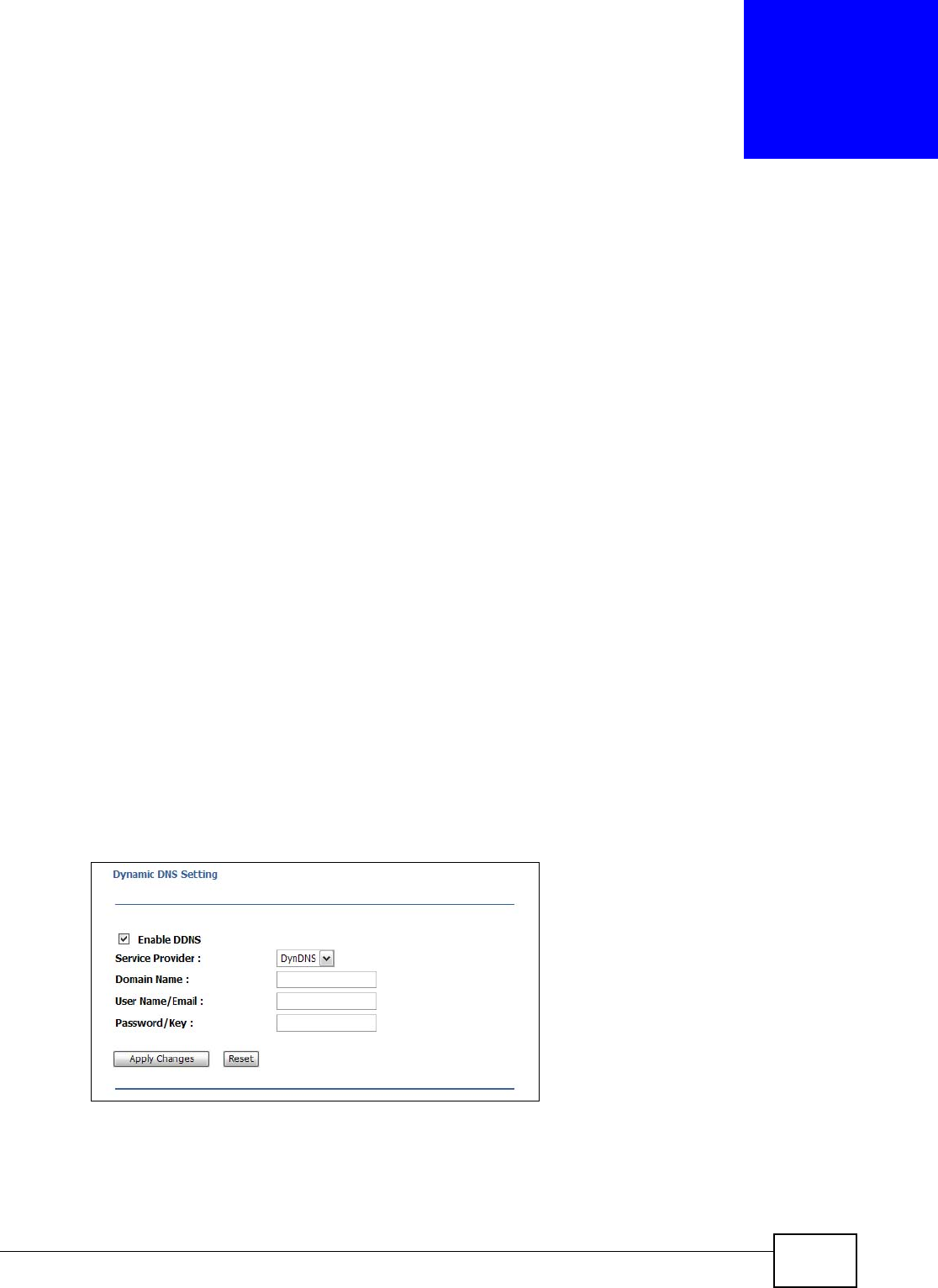
NBG2105 User’s Guide 81
CHAPTER 12
Dynamic DNS (DDNS)
12.1 Overview
DDNS services let you use a domain name with a dynamic IP address.
12.2 What You Need To Know
The following terms and concepts may help as you read through this chapter.
What is DDNS?
Dynamic Domain Name Service (DDNS) services let you use a fixed domain name with a dynamic
IP address. Users can always use the same domain name instead of a different dynamic IP address
that changes each time to connect to the NBG2105 or a server in your network.
Note: The NBG2105 must have a public global IP address and you should have your
registered DDNS account information on hand.
12.3 Dynamic DNS
To change your NBG2105’s DDNS, click Network > Dynamic DNS.
Figure 47 Network > Dynamic DNS

Chapter 12 Dynamic DNS (DDNS)
NBG2105 User’s Guide
82
The following table describes the labels in this screen.
Table 37 Network > Dynamic DNS
LABEL DESCRIPTION
Enable DDNS Click this to enable dynamic DNS.
Service Provider Select the name of your Dynamic DNS service provider.
Domain Name Enter the domain name assigned by your service provider to your NBG2105.
Username/Email Enter the user name assigned by your service provider to your NBG2105. If you’ve
selected TZO in the Service Provider field, enter the user name you registered with
the service provider.
Password/Key Enter the password assigned by your service provider to your NBG2105. If you’ve
selected TZO in the Service Provider field, enter the key you registered with the
service provider.
Apply Changes Click this to save changes back to the NBG2105.
Reset Click this to begin configuring this screen afresh.
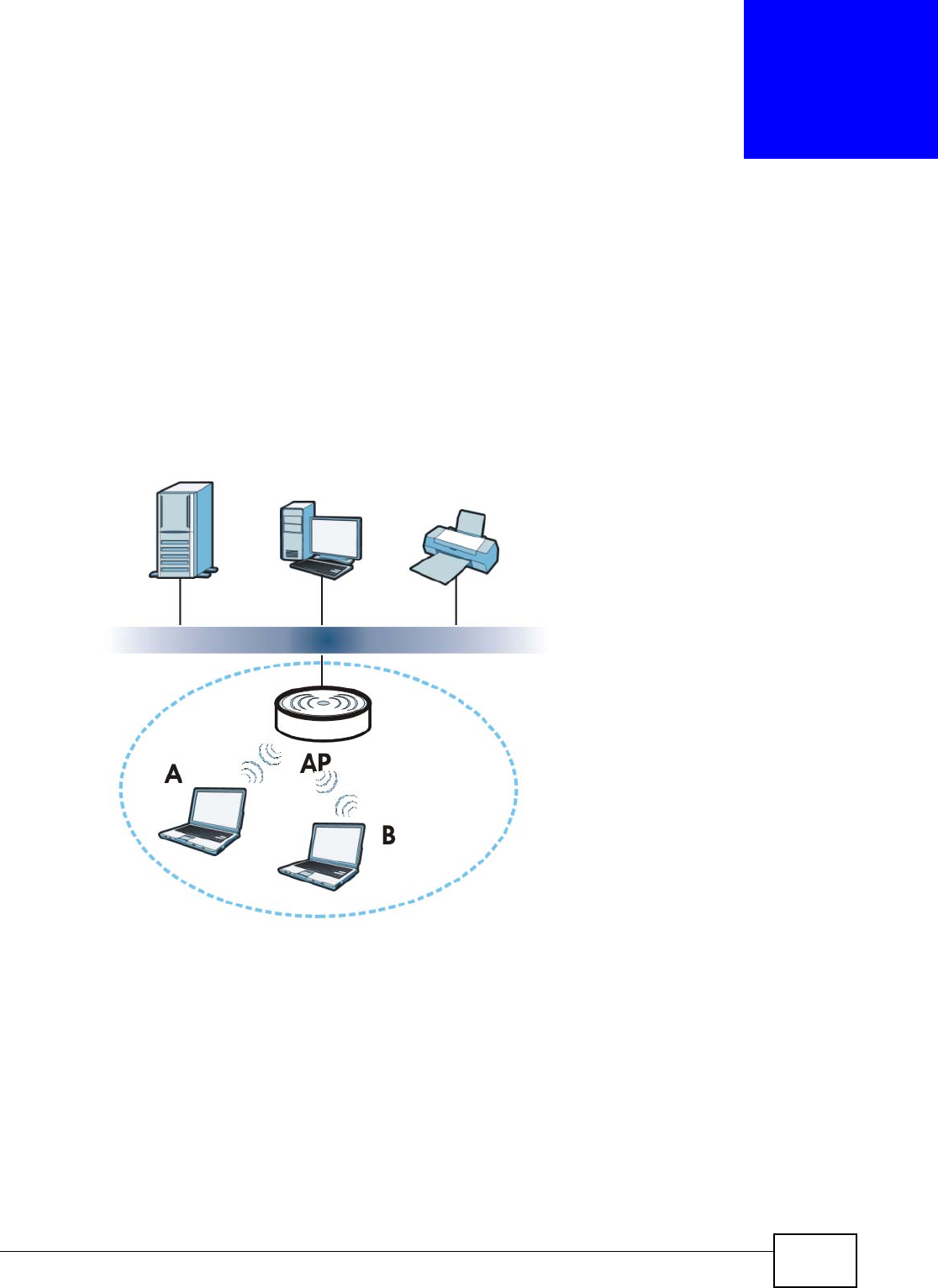
NBG2105 User’s Guide 83
CHAPTER 13
Wireless LAN
13.1 Overview
This chapter discusses how to configure the wireless network settings in your NBG2105. See the
appendices for more detailed information about wireless networks.
The following figure provides an example of a wireless network.
Figure 48 Example of a Wireless Network
The wireless network is the part in the blue circle. In this wireless network, devices A and B are
called wireless clients. The wireless clients use the access point (AP) to interact with other devices
(such as the printer) or with the Internet. Your NBG2105 is the AP.
13.1.1 What You Can Do
•Use the Basic screen to turn the wireless connection on or off and make other basic
configuration changes (Section 13.2 on page 86).
•Use the Advanced screen to configure wireless advanced features, such as the output power
and set the RTS/CTS Threshold (Section 13.4 on page 88).
•Use the Security screen to set up wireless security between the NBG2105 and the wireless
clients (Section 13.5 on page 89).

Chapter 13 Wireless LAN
NBG2105 User’s Guide
84
•Use the Site Survey screen to scan for and connect to a wireless network automatically. (Section
13.6 on page 92)
•Use the WPS screen to quickly set up a wireless network with strong security, without having to
configure security settings manually (Section 13.8 on page 95).
•Use the MAC Filtering screen to allow or deny wireless stations based on their MAC addresses
from connecting to the NBG2105 (Section 13.9 on page 97).
13.1.2 What You Should Know
Every wireless network must follow these basic guidelines.
• Every wireless client in the same wireless network must use the same SSID.
The SSID is the name of the wireless network. It stands for Service Set IDentity.
• If two wireless networks overlap, they should use different channels.
Like radio stations or television channels, each wireless network uses a specific channel, or
frequency, to send and receive information.
• Every wireless client in the same wireless network must use security compatible with the AP.
Security stops unauthorized devices from using the wireless network. It can also protect the
information that is sent in the wireless network.
Wireless Security Overview
The following sections introduce different types of wireless security you can set up in the wireless
network.
SSID
Normally, the AP acts like a beacon and regularly broadcasts the SSID in the area. You can hide the
SSID instead, in which case the AP does not broadcast the SSID. In addition, you should change
the default SSID to something that is difficult to guess.
This type of security is fairly weak, however, because there are ways for unauthorized devices to
get the SSID. In addition, unauthorized devices can still see the information that is sent in the
wireless network.
Authentication
Authentication is the process of confirming a client’s user name and password when they connect to
a network. Turning off authentication means allowing anyone to connect to the network.
Encryption
Wireless networks can use encryption to protect the information that is sent in the wireless
network. It is the process of taking data and encoding it, usually using a secret code, so that it
becomes unreadable unless decrypted with the proper code or pass phrase. If you do not know the
secret code, you cannot understand the message.

Chapter 13 Wireless LAN
NBG2105 User’s Guide 85
WEP
Data Encryption
WEP (Wired Equivalent Privacy) encryption scrambles all data packets transmitted between the
NBG2105 and the AP or other wireless stations to keep network communications private. Both the
wireless stations and the access points must use the same WEP key for data encryption and
decryption.
Authentication Type
The IEEE 802.11b/g/n standard describes a simple authentication method between the wireless
stations and AP. Three authentication types are defined: Both, Open and Shared.
• Open mode is implemented for ease-of-use and when security is not an issue. The wireless
station and the AP or peer computer do not share a secret key. Thus the wireless stations can
associate with any AP or peer computer and listen to any transmitted data that is not encrypted.
• Shared mode involves a shared secret key to authenticate the wireless station to the AP or peer
computer. This requires you to enable the wireless LAN security and use same settings on both
the wireless station and the AP or peer computer.
• Both authentication mode allows the NBG2105 to switch between the open system and shared
key modes automatically. Use this mode if you do not know the authentication mode of the other
wireless stations.
WPA-PSK and WPA2-PSK
Wi-Fi Protected Access (WPA) is a subset of the IEEE 802.11i standard. WPA2 (IEEE 802.11i) is a
wireless security standard that defines stronger encryption, authentication and key management
than WPA.
Key differences between WPA(2) and WEP are improved data encryption and user authentication.
Both WPA and WPA2 improve data encryption by using Temporal Key Integrity Protocol (TKIP),
Message Integrity Check (MIC) and IEEE 802.1x. WPA and WPA2 use Advanced Encryption
Standard (AES) in the Counter mode with Cipher block chaining Message authentication code
Protocol (CCMP) to offer stronger encryption than TKIP.
The encryption mechanisms used for WPA(2) and WPA(2)-PSK are the same. The only difference
between the two is that WPA(2)-PSK uses a simple common password, instead of user-specific
credentials. The common-password approach makes WPA(2)-PSK susceptible to brute-force
password-guessing attacks but it’s still an improvement over WEP as it employs a consistent,
single, alphanumeric password to derive a PMK which is used to generate unique temporal
encryption keys. This prevent all wireless devices sharing the same encryption keys. (a weakness of
WEP)
If both an AP and the wireless clients support WPA2-PSK, use WPA2-PSK for stronger data
encryption. If the AP or the wireless clients do not support WPA2-PSK, just use WPA-PSK. Select
WEP only when the AP and/or wireless clients do not support WPA-PSK or WPA2-PSK. WEP is less
secure than WPA-PSK or WPA2-PSK.
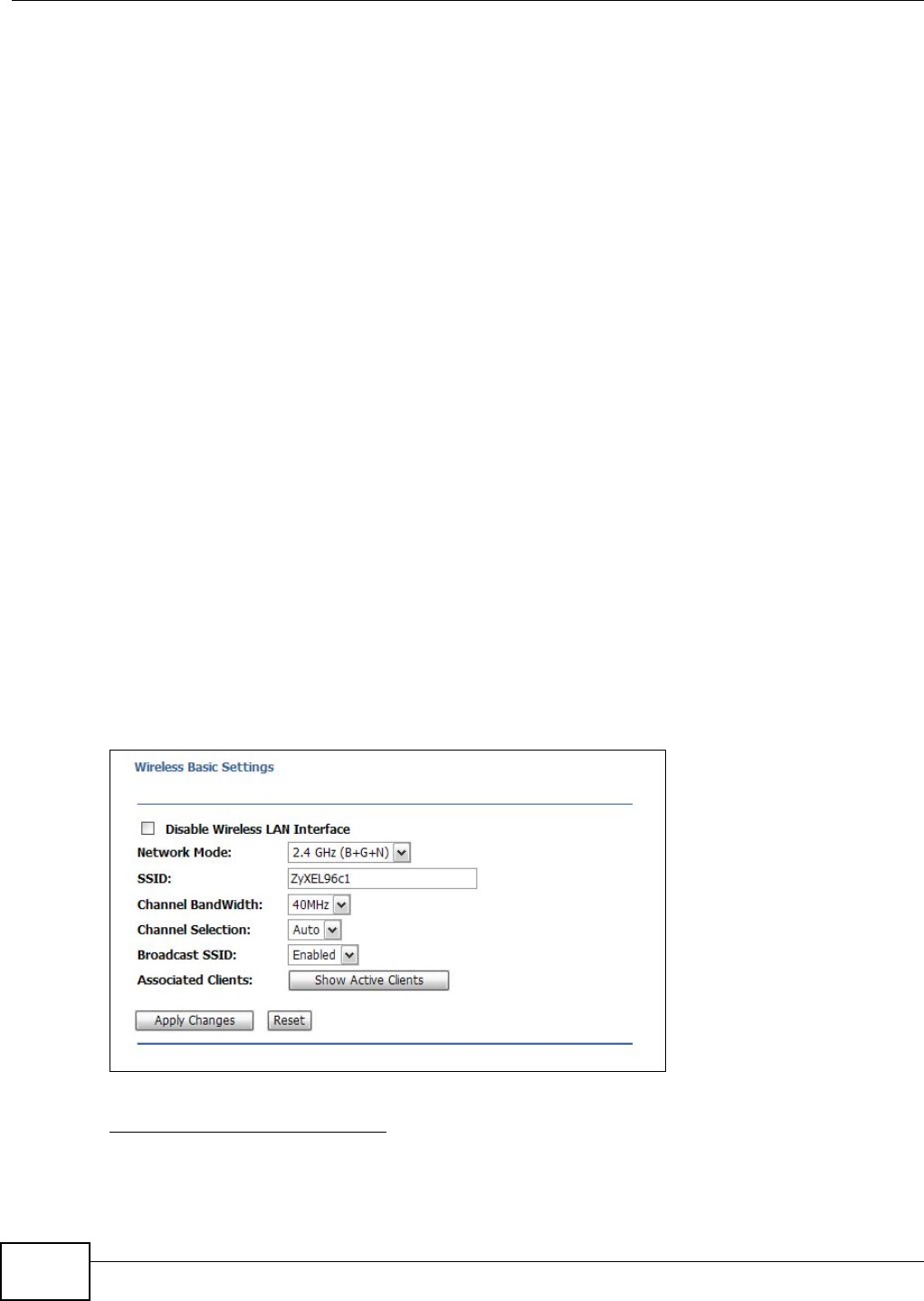
Chapter 13 Wireless LAN
NBG2105 User’s Guide
86
MAC Address Filter
Every wireless client has a unique identification number, called a MAC address.1 A MAC address is
usually written using twelve hexadecimal characters2; for example, 00A0C5000002 or
00:A0:C5:00:00:02. To get the MAC address for each wireless client, see the appropriate User’s
Guide or other documentation.
You can use the MAC address filter to tell the AP which wireless clients are allowed or not allowed to
use the wireless network. If a wireless client is allowed to use the wireless network, it still has to
have the correct settings (SSID, channel, and security). If a wireless client is not allowed to use the
wireless network, it does not matter if it has the correct settings.
This type of security does not protect the information that is sent in the wireless network.
Furthermore, there are ways for unauthorized devices to get the MAC address of an authorized
wireless client. Then, they can use that MAC address to use the wireless network.
WPS
WiFi Protected Setup (WPS) is an industry standard specification, defined by the WiFi Alliance. WPS
allows you to quickly set up a wireless network with strong security, without having to configure
security settings manually. Depending on the devices in your network, you can either press a
button (on the device itself, or in its configuration utility) or enter a PIN (Personal Identification
Number) in the devices. Then, they connect and set up a secure network by themselves. See how
to set up a secure wireless network using WPS in the Section 8.2 on page 59.
13.2 Wireless Basic Screen
Click Wireless LAN > Basic to make basic wireless configuration changes.
Figure 49 Wireless LAN > Basic
1. Some wireless devices, such as scanners, can detect wireless networks but cannot use wireless networks. These kinds
of wireless devices might not have MAC addresses.
2. Hexadecimal characters are 0, 1, 2, 3, 4, 5, 6, 7, 8, 9, A, B, C, D, E, and F.
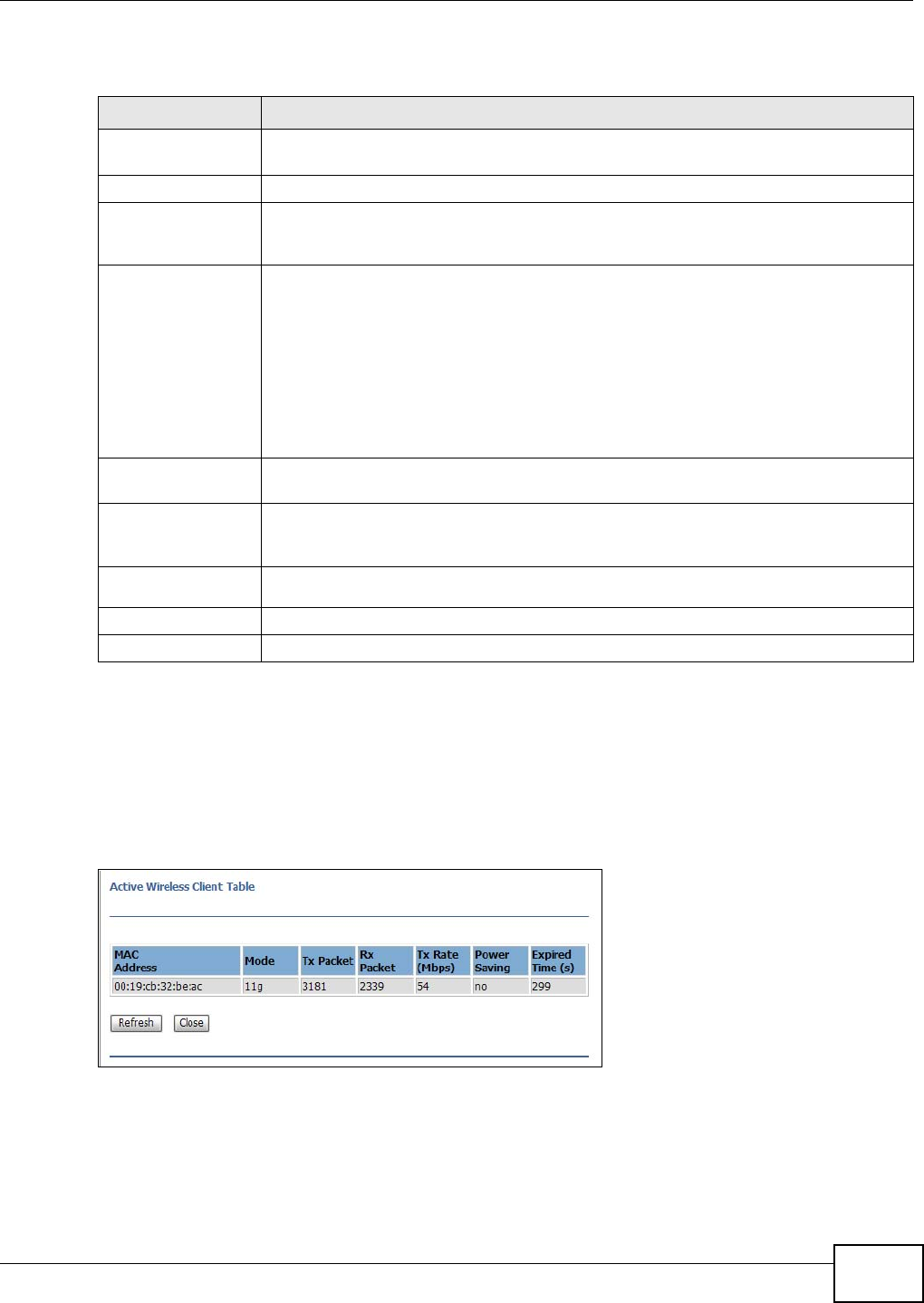
Chapter 13 Wireless LAN
NBG2105 User’s Guide 87
The following table describes the labels in this screen.
13.3 Active Wireless Clients Screen
Click Show Active Clients in Wireless LAN > Basic to show the clients connected to the
NBG2105.
Figure 50 Wireless LAN > Basic: Show Active Clients
Table 38 Wireless LAN > Basic
LABEL DESCRIPTION
Disable Wireless
LAN Interface
Select this to disable the wireless LAN interface.
Network Mode Select the frequency band and wireless network mode for your network.
SSID Enter the SSID (Service Set IDentity) to identify the service set with which wireless
clients are associated. Enter a descriptive name (up to 32 printable characters found on
a typical English language keyboard) for the wireless LAN.
Channel
Bandwidth Select the wireless channel width used by NBG2105.
A standard 20 MHz channel offers transfer speeds of up to 150 Mbps whereas a 40 MHz
channel uses two standard channels and offers speeds of up to 300 Mbps.
40 MHz (channel bonding or dual channel) bonds two adjacent radio channels to
increase throughput. The wireless clients must also support 40 MHz. It is often better to
use the 20 MHz setting in a location where the environment hinders the wireless signal.
Select 20MHz if you want to lessen radio interference with other wireless devices in
your neighborhood or the wireless clients do not support channel bonding.
Channel
Selection Select a channel number. The channels you can select depend on the frequency band
and the country you are in.
Broadcast SSID Select Enabled to broadcast the SSID or Disabled to hide the SSID in the outgoing
beacon frame so a station cannot obtain the SSID through scanning using a site survey
tool.
Show Active
Clients Click this to show the clients connected to the NBG2105.
Apply Changes Click this to save changes back to the NBG2105.
Reset Click this to begin configuring this screen afresh.
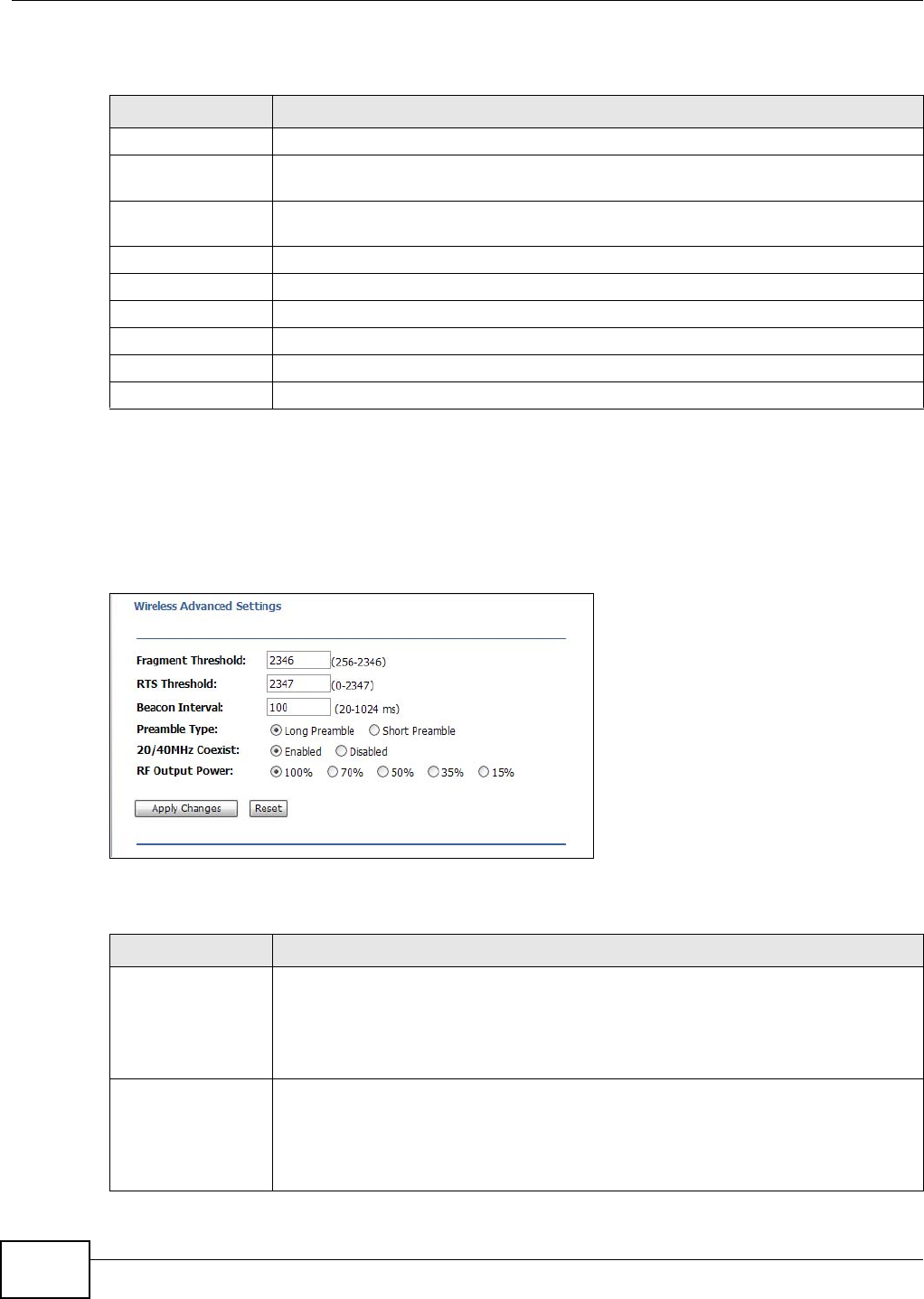
Chapter 13 Wireless LAN
NBG2105 User’s Guide
88
The following table describes the labels in this screen.
13.4 Advanced Wireless Settings Screen
Click Wireless LAN > Advanced to make advanced wireless configuration changes.
Figure 51 Wireless LAN > Advanced
The following table describes the labels in this screen.
Table 39 Wireless LAN > Basic: Show Active Clients
LABEL DESCRIPTION
MAC Address This shows the MAC addresses of wireless clients associated with the NBG2105.
Mode This shows which wireless standard a wireless client is using to connect to the
NBG2105.
Tx Packet This shows how many packets have been transmitted by the NBG2105 since
association.
Rx Packet This shows how many packets have been received by the NBG2105 since association.
Tx Rate (Mbps) This shows the rate at which packets are being sent by the NBG2105 to this client.
Power Saving This shows whether power saving is turned on for this wireless client.
Expired Time (s) This shows when the association with this client6 will expire.
Refresh Click this to update the screen.
Close Click this to close this screen.
Table 40 Wireless LAN > Advanced
LABEL DESCRIPTION
Fragment Threshold The threshold (number of bytes) for the fragmentation boundary for directed
messages. It is the maximum data fragment size that can be sent.
This field is not configurable and the NBG2105 automatically changes to use the
maximum value if you select 2.4 GHz (N), 2.4 GHz (G + N) or 2.4 GHz (B + G + N)
in the Wireless LAN > Basic screen.
RTS Threshold Data with its frame size larger than this value will perform the RTS (Request To Send)/
CTS (Clear To Send) handshake.
This field is not configurable and the NBG2105 automatically changes to use the
maximum value if you select 2.4 GHz (N), 2.4 GHz (G + N) or 2.4 GHz (B + G + N)
in the Wireless LAN > Basic screen.
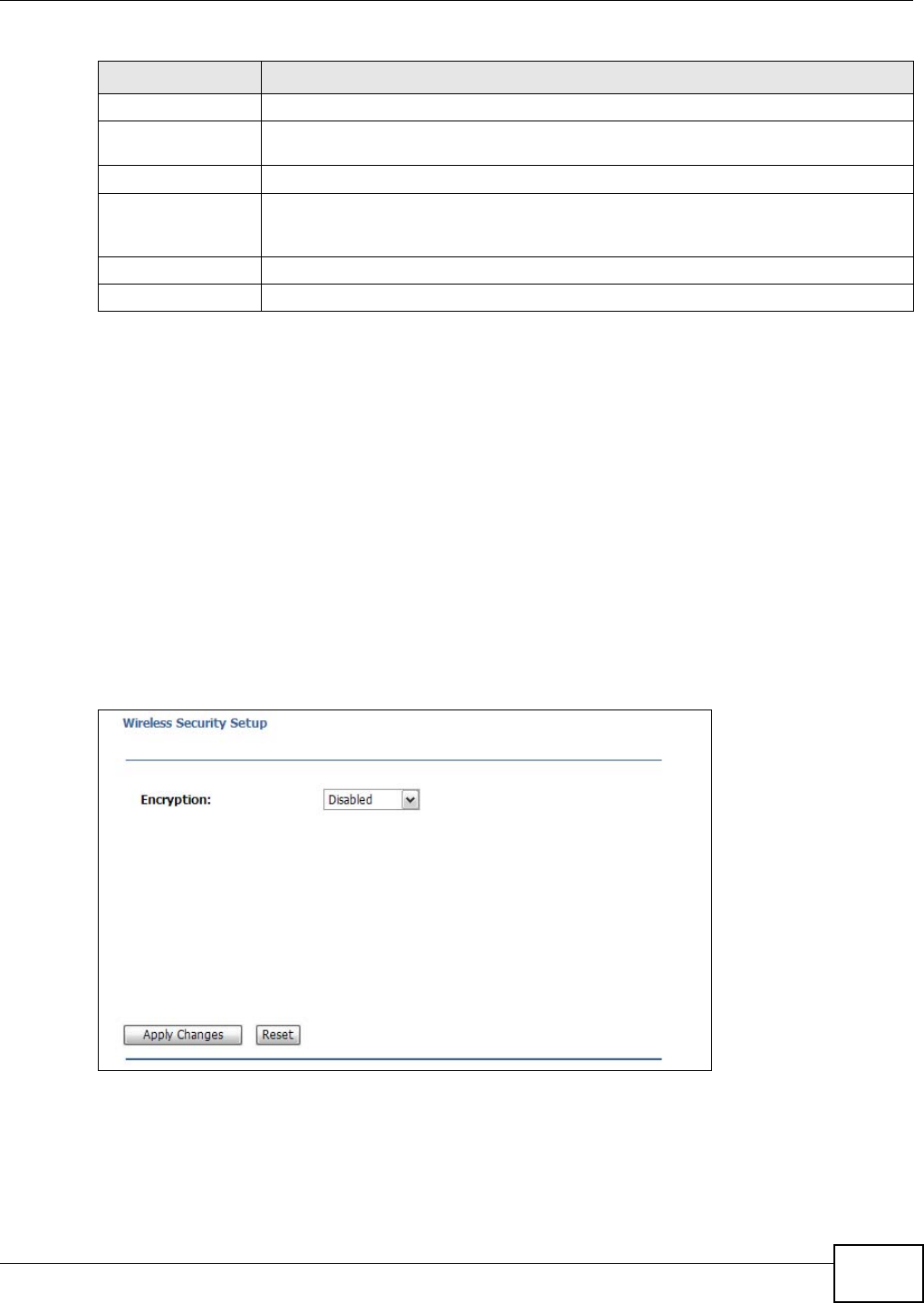
Chapter 13 Wireless LAN
NBG2105 User’s Guide 89
13.5 Wireless Security
The screen varies depending on what you select in the Encryption field. Click Wireless LAN >
Security. This screen is not available when the NBG2105 is in Client mode.
13.5.1 Disabled
Select Disabled to allow wireless clients to communicate with the access points without any data
encryption.
Note: If you do not enable any wireless security on your NBG2105, your network is
accessible to any wireless networking device that is within range.
Figure 52 Wireless LAN > Security: Disabled
Beacon Interval Enter a value to configure how often beacon frames are broadcast.
Preamble Type Select Short Preamble for better performance or Long Preamble for better
compatibility.
20/40MHz Coexist Select Enabled to allow the NBG2105 to adjust the channel bandwidth automatically.
RF Output Power Set the output power of the NBG2105 in this field. If there is a high density of APs in an
area, decrease the output power of the NBG2105 to reduce interference with other APs.
Select one of the following 100%, 70%, 50%, 35% or 15%.
Apply Changes Click this to save changes back to the NBG2105.
Reset Click this to begin configuring this screen afresh.
Table 40 Wireless LAN > Advanced (continued)
LABEL DESCRIPTION
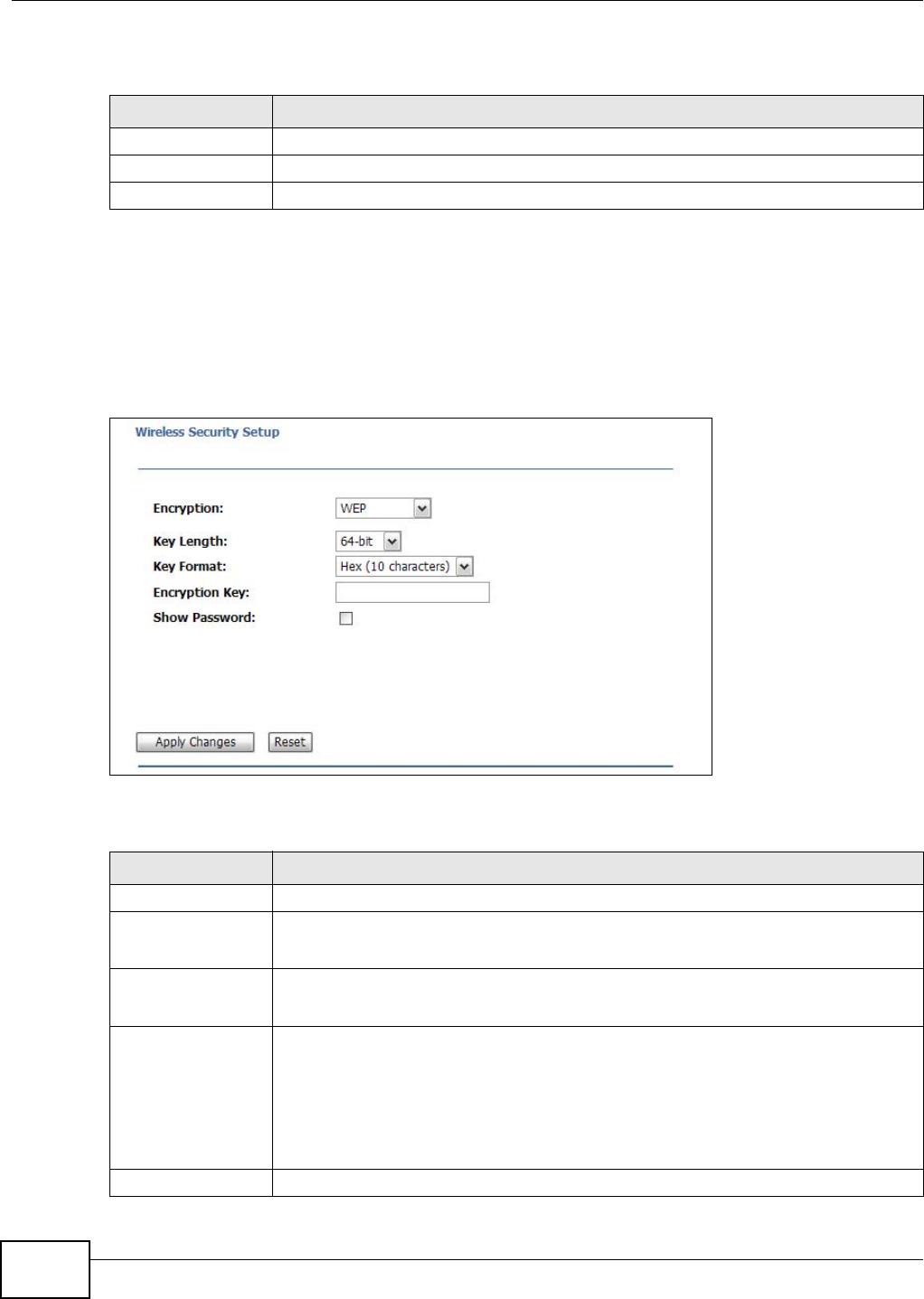
Chapter 13 Wireless LAN
NBG2105 User’s Guide
90
The following table describes the labels in this screen.
13.5.2 WEP Encryption
Your NBG2105 allows you to configure up to four 64-bit or 128-bit WEP keys but only one key can
be enabled at any one time.
Select WEP from the Encryption list.
Figure 53 Wireless LAN > Security: WEP
The following table describes the labels in this screen.
Table 41 Wireless LAN > Security: Disabled
LABEL DESCRIPTION
Encryption Select Disabled to allow any client to associate this network without authentication.
Apply Changes Click this to save changes back to the NBG2105.
Reset Click this to begin configuring this screen afresh.
Table 42 Wireless LAN > Security: WEP
LABEL DESCRIPTION
Encryption Select WEP to allow clients to associate this network with WEP authentication.
Key Length Select 64-bit or 128-bit.
This dictates the length of the security key that the network is going to use.
Key Format Select Hex to enter hexadecimal characters as a WEP key.
Select ASCII to enter ASCII characters as WEP key.
Encryption Key The WEP keys are used to encrypt data. Both the NBG2105 and the wireless stations
must use the same WEP key for data transmission.
If you chose 64-bit in the Key Format field, then enter any 5 ASCII characters or 10
hexadecimal characters ("0-9", "A-F").
If you chose 128-bit in the Key Format field, then enter 13 ASCII characters or 26
hexadecimal characters ("0-9", "A-F").
Show Password Select this to show the encryption key on the screen.
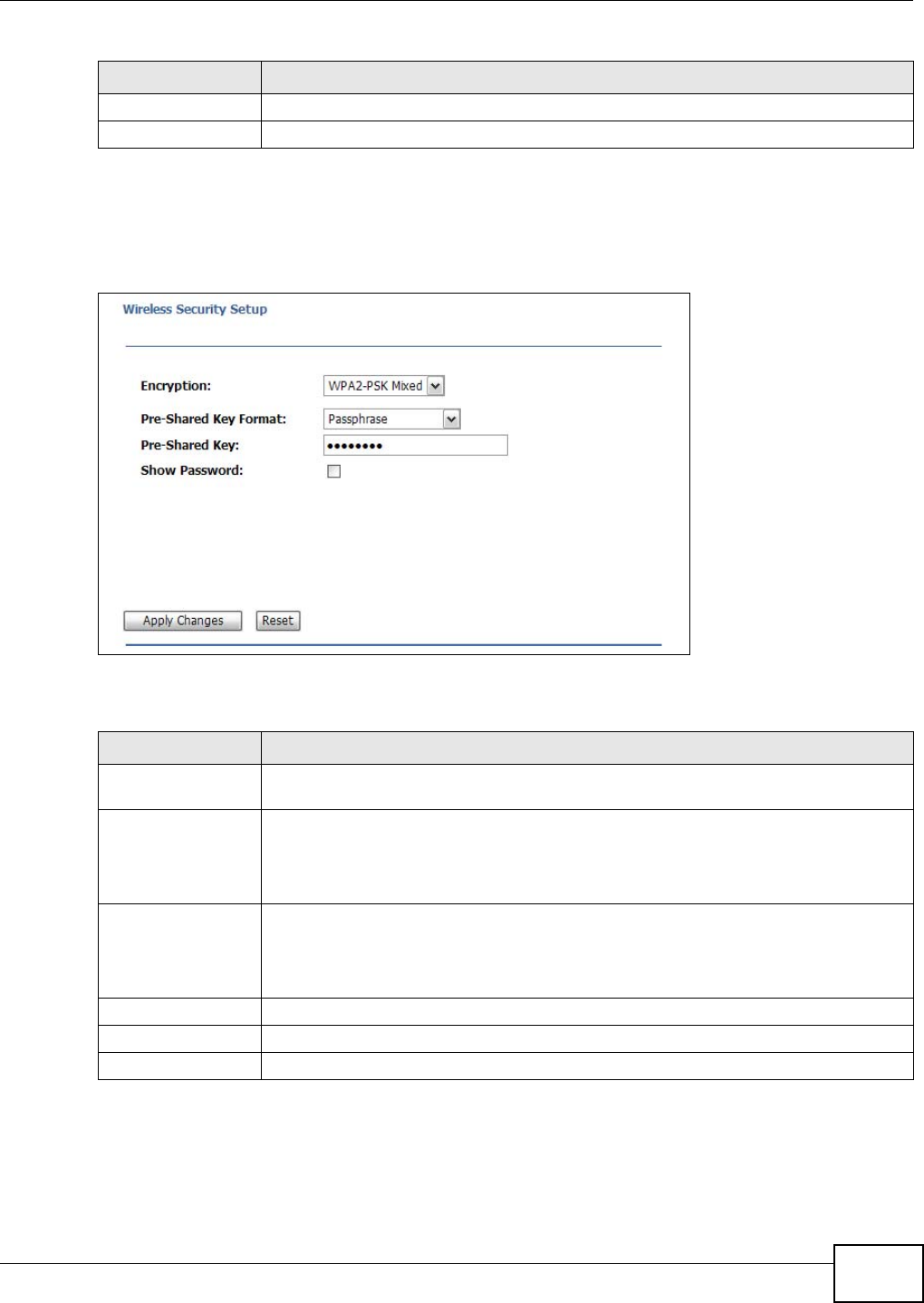
Chapter 13 Wireless LAN
NBG2105 User’s Guide 91
13.5.3 WPA-PSK/WPA2-PSK/WPA2-PSK Mixed
Select WPA-PSK, WPA2-PSK or WPA2-PSK Mixed from the Encryption list.
Figure 54 Wireless LAN > Security: WPA2-PSK Mixed
The following table describes the labels in this screen.
Apply Changes Click this to save changes back to the NBG2105.
Reset Click this to begin configuring this screen afresh.
Table 42 Wireless LAN > Security: WEP (continued)
LABEL DESCRIPTION
Table 43 Wireless LAN > Security: WPA-PSK, WPA2-PSK or WPA2-PSK Mixed
LABEL DESCRIPTION
Encryption Select WPA-PSK, WPA2-PSK or WPA2-Mixed to allow clients to associate this
network with WPA-PSK, WPA2-PSK or either WPA-PSK or WPA2-PSK authentication.
Pre-Shared Key
Format
Select Passphrase to make the NBG2105 generate a key from a phrase typed into the
Pre-Shared Key field.
Select HEX to configure the NBG2105 to accept a key in hexadecimal format in the
Pre-Shared Key field.
Pre-Shared Key If Passphrase was selected in the Pre-Shared Key Format field, type a pre-shared
key from 8 to 63 case-sensitive keyboard characters.
If HEX was selected in the Pre-Shared Key Format field, type a pre-shared key using
hexadecimal characters ("0-9", "A-F").
Show Password Select this to show the pre-shared key on the screen.
Apply Changes Click this to save changes back to the NBG2105.
Reset Click this to begin configuring this screen afresh.
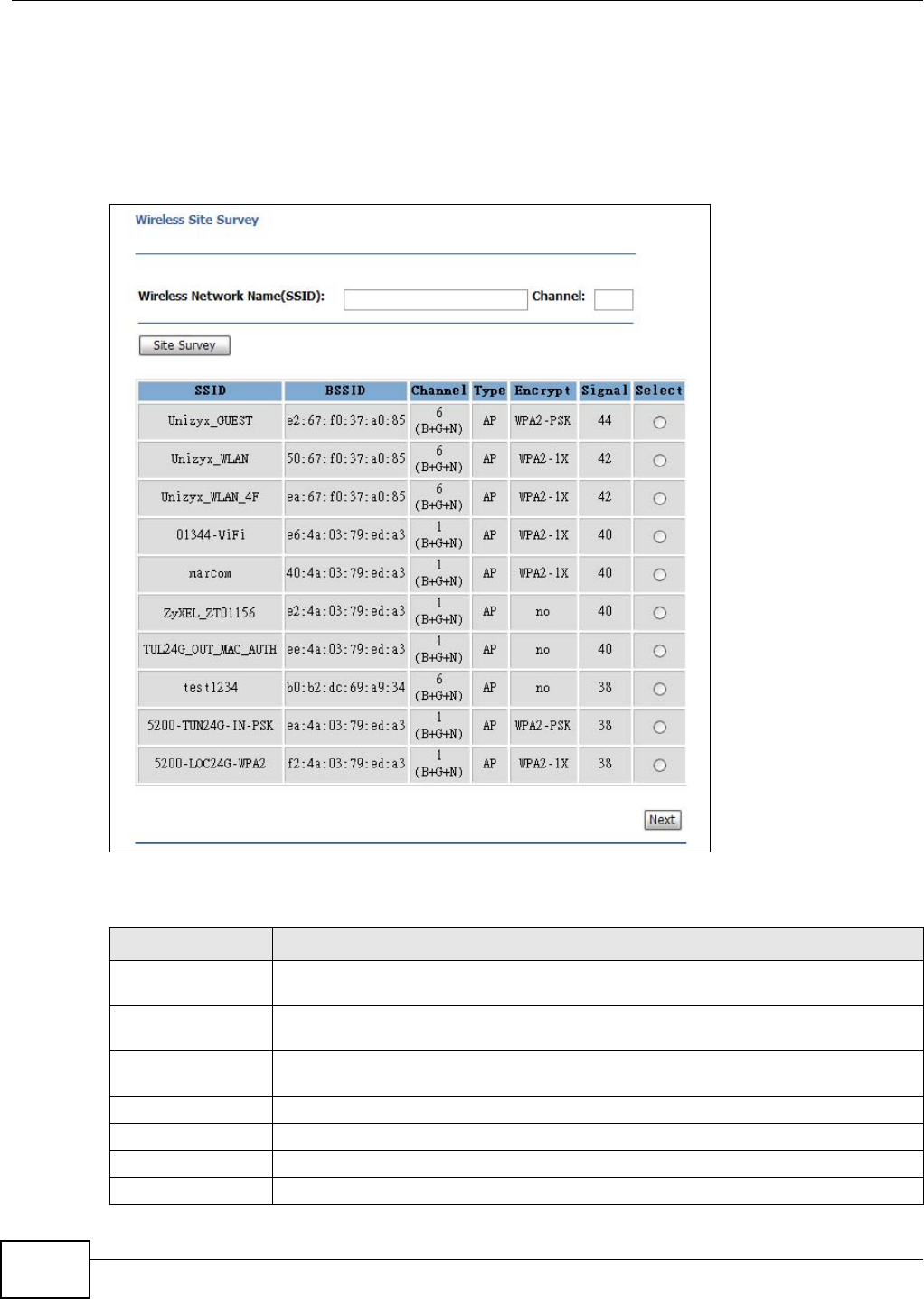
Chapter 13 Wireless LAN
NBG2105 User’s Guide
92
13.6 Site Survey Screen
Use this screen to scan for and connect to a wireless network automatically. Go to Wireless LAN >
Site Survey to open the following screen. This screen is available only when the NBG2105 is in
WISP+UR or Client mode.
Figure 55 Wireless LAN > Site Survey
The following table describes the labels in this screen.
Table 44 Wireless LAN > Site Survey
LABEL DESCRIPTION
Wireless Network
Name (SSID)
Enter the SSID of the AP to which you want the NBG2105 in WISP+UR mode or client
mode to connect.
Channel Enter the channel number used by the wireless device to which the NBG2105 is
connecting.
Site Survey Click this to search for available wireless devices within transmission range and update
this table.
SSID This shows the SSID of the wireless device.
BSSID This shows the MAC address of the wireless device.
Channel This shows the channel number and wireless standard used by this wireless device.
Type This shows the type of device found in the survey.
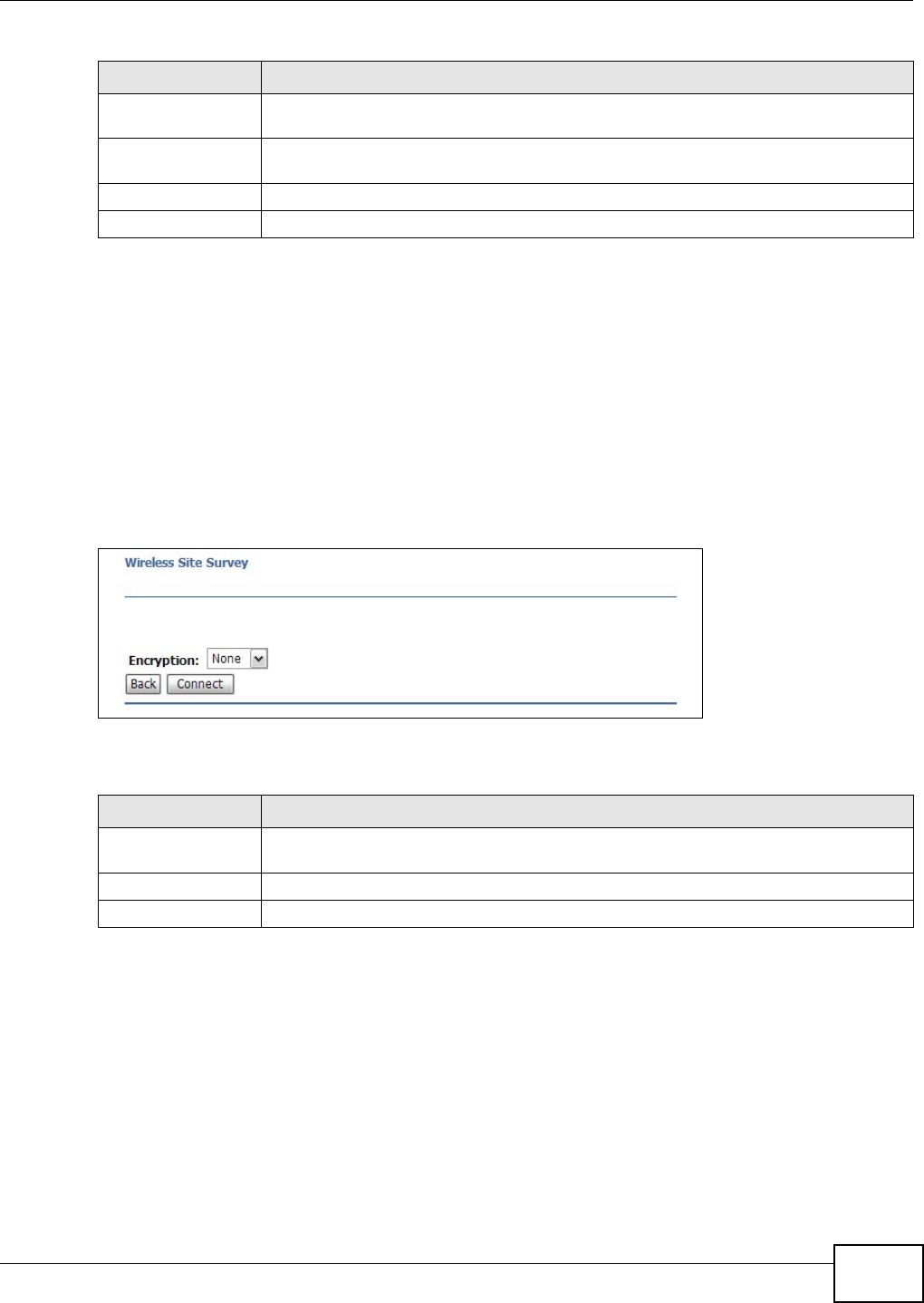
Chapter 13 Wireless LAN
NBG2105 User’s Guide 93
13.7 Site Survey: Wireless Security
The screen varies depending on what you select in the Encryption field.
13.7.1 None
Select None if the NBG2105 can communicate with the selected access point without any data
encryption.
Figure 56 Wireless LAN > Site Survey: None
The following table describes the labels in this screen.
13.7.2 WEP Encryption
Your NBG2105 can associate with APs that use 64-bit or 128-bit WEP keys but only one key can be
enabled at any one time.
Select WEP from the Encryption list.
Encrypt This displays the data encryption and authentication method used by this wireless
device.
Signal This displays the strength of the wireless signal. The signal strength mainly depends on
the antenna output power and the distance between your NBG2105 and this device.
Select Click this to select a device.
Next Click this to open a screen to configure wireless security options.
Table 44 Wireless LAN > Site Survey (continued)
LABEL DESCRIPTION
Table 45 Wireless LAN > Site Survey: None
LABEL DESCRIPTION
Encryption Select None if the NBG2105 can communicate with the selected access point without
any data encryption.
Back Click this to go back to the initial site survey screen.
Connect Click this to associate the NBG2105 with the selected access point.
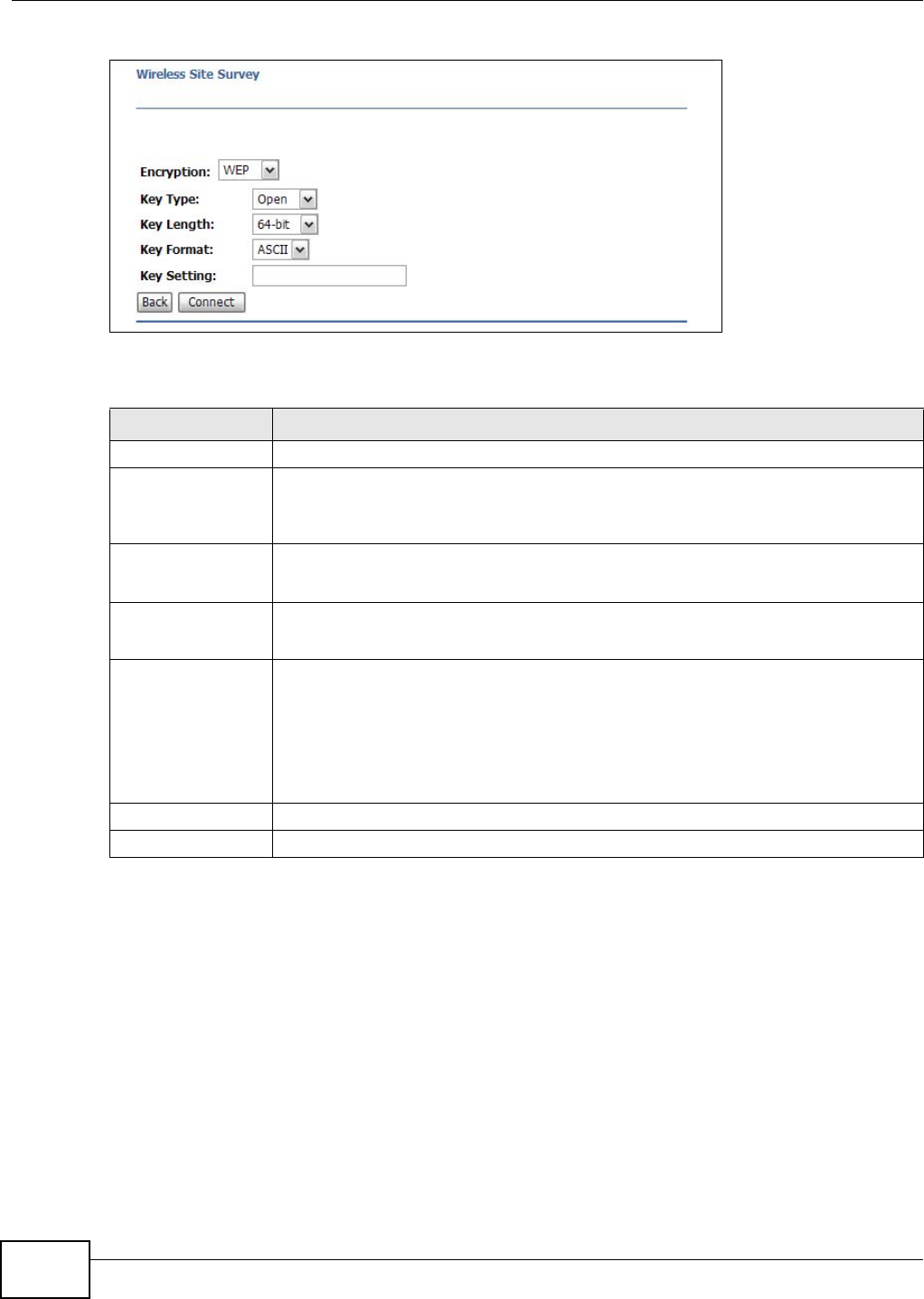
Chapter 13 Wireless LAN
NBG2105 User’s Guide
94
Figure 57 Wireless LAN > Site Survey: WEP
The following table describes the labels in this screen.
13.7.3 WPA-PSK/WPA2-PSK Encryption
Select WPA-PSK or WPA2-PSK from the Encryption list.
Table 46 Wireless LAN > Site Survey: WEP
LABEL DESCRIPTION
Encryption Select WEP to associate with the selected AP using WEP authentication.
Key Type Select Open, Shared or Both.
This field specifies whether the NBG2105 must provide a WEP key to login to the
selected access point.
Key Length Select 64-bit or 128-bit.
This dictates the length of the security key that selected access point is using.
Key Format Select ASCII to enter ASCII characters as a WEP key.
Select Hex to enter hexadecimal characters as a WEP key.
Key Setting The WEP keys are used to encrypt data. Both the NBG2105 and the access point must
use the same WEP key for data transmission.
If you chose 64-bit in the Key Format field, then enter any 5 ASCII characters or 10
hexadecimal characters ("0-9", "A-F").
If you chose 128-bit in the Key Format field, then enter 13 ASCII characters or 26
hexadecimal characters ("0-9", "A-F").
Back Click this to go back to the initial site survey screen.
Connect Click this to associate the NBG2105 with the selected access point.
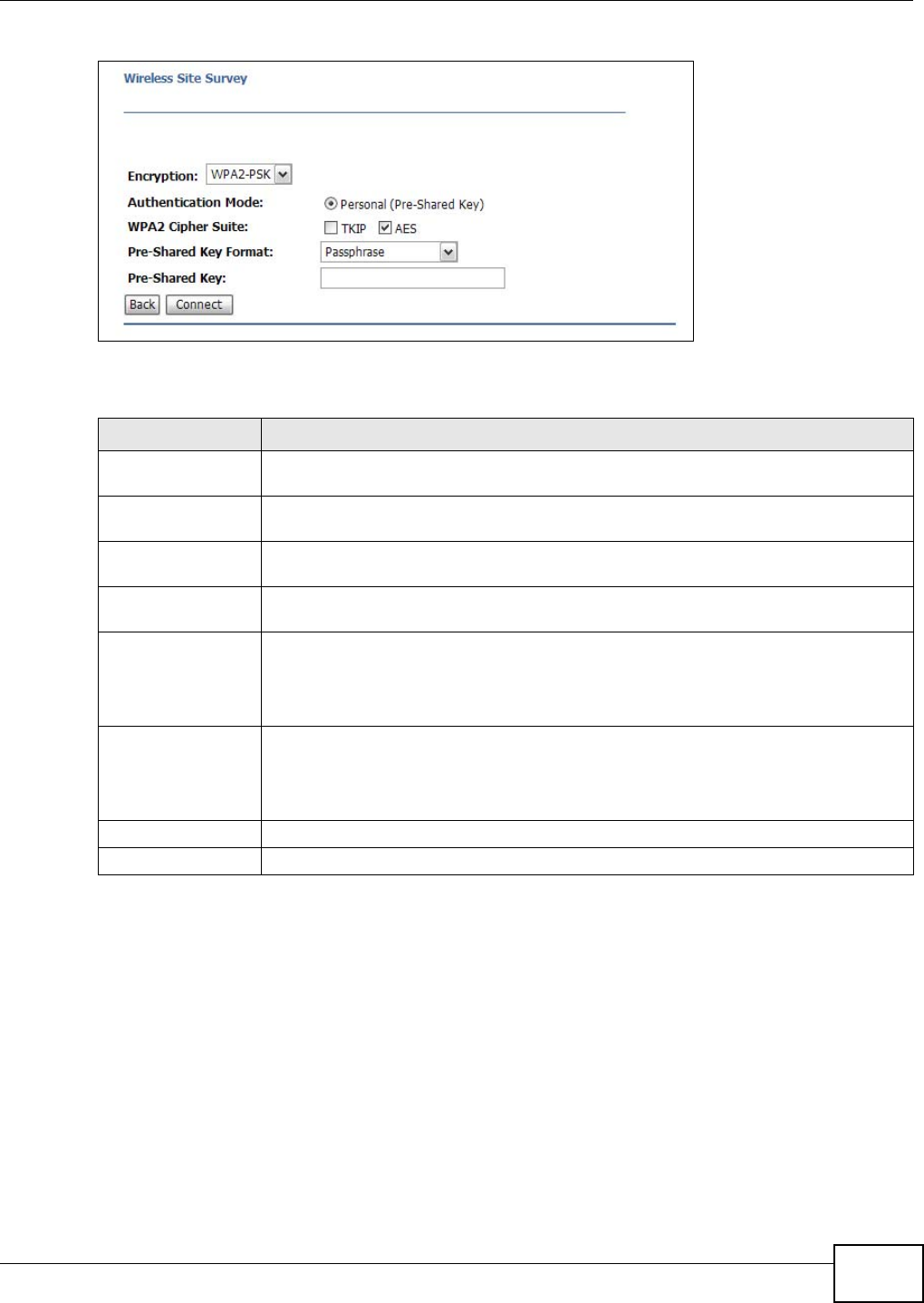
Chapter 13 Wireless LAN
NBG2105 User’s Guide 95
Figure 58 Wireless LAN > Site Survey: WPA2-PSK
The following table describes the labels in this screen.
13.8 WPS Screen
Use this screen to enable/disable WPS, view or generate a new PIN number and check current WPS
status. To open this screen, click Wireless LAN > WPS. The screen varies depending on the
operation mode in which the NBG2105 is working.
Table 47 Wireless LAN > Site Survey: WPA-PSK or WPA2-PSK
LABEL DESCRIPTION
Encryption Select WPA-PSK or WPA2-PSK to associate with the selected AP using WPA-PSK or
WPA2-PSK.
Authentication Mode Personal (Pre-Shared Key) is selected to use a simple common password for
authentication.
WPA Cipher Suite Select TKIP and/or AES to configure which encryption options the NBG2105 uses to
connect to the selected access point. This appears when WPA encryption is selected.
WPA2 Cipher Suite Select TKIP and/or AES to configure which encryption options the NBG2105 uses to
connect to the selected access point. This appears when WPA2 encryption is selected.
Pre-Shared Key
Format
Select Passphrase to make the NBG2105 generate a key from a phrase typed into the
Pre-Shared Key field.
Select HEX to configure the NBG2105 to accept a key in hexadecimal format in the
Pre-Shared Key field.
Pre-Shared Key If Passphrase was selected in the Pre-Shared Key Format field, type a pre-shared
key from 8 to 63 case-sensitive keyboard characters.
If HEX was selected in the Pre-Shared Key Format field, type a pre-shared key using
hexadecimal characters ("0-9", "A-F").
Back Click this to go back to the initial site survey screen.
Connect Click this to associate the NBG2105 with the selected access point.
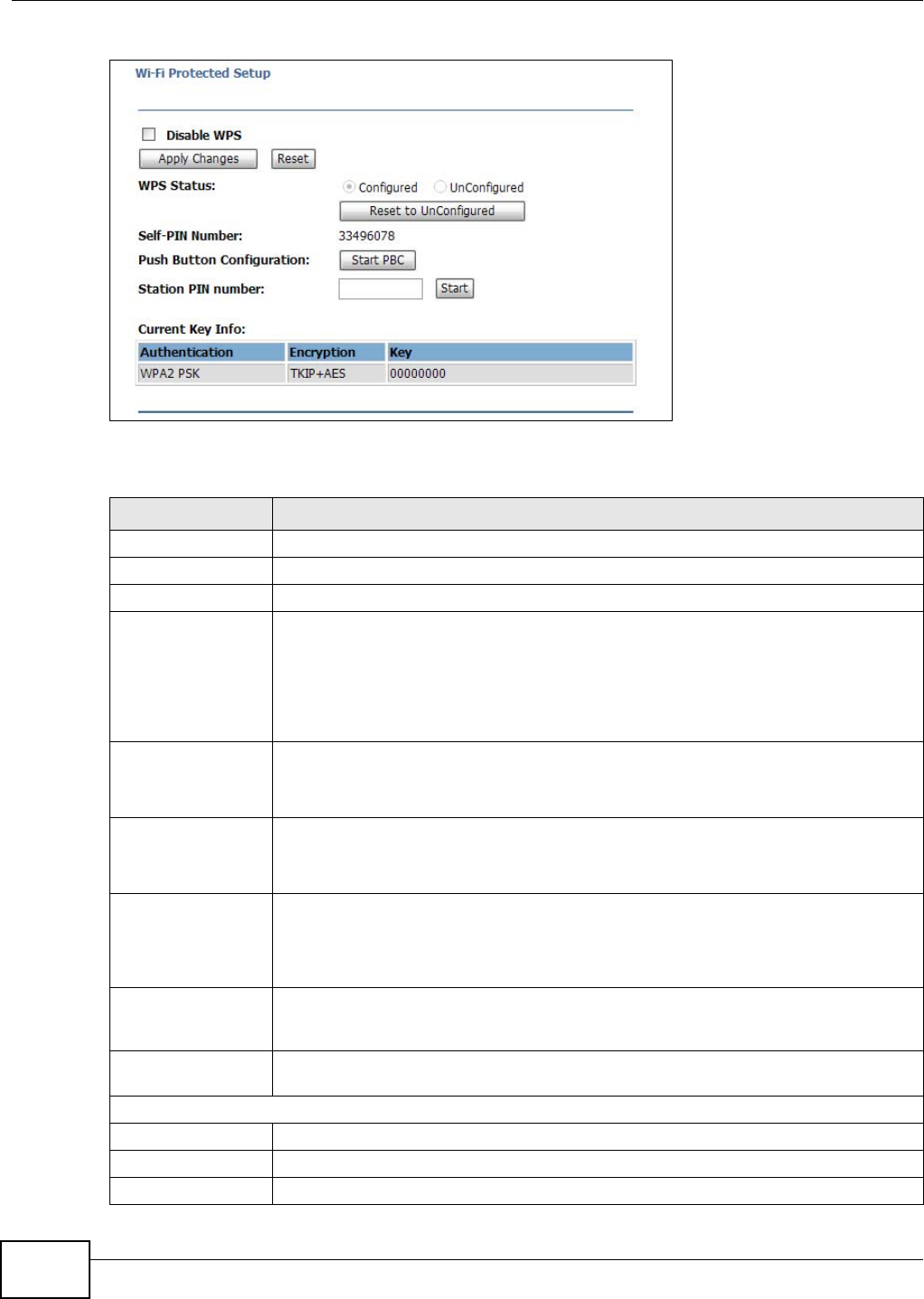
Chapter 13 Wireless LAN
NBG2105 User’s Guide
96
Figure 59 Wireless LAN > WPS (Router, AP, or WISP+UR mode)
The following table describes the labels in this screen.
Table 48 Wireless LAN > WPS (Router, AP, or WISP+UR mode)
LABEL DESCRIPTION
Disable WPS Select this to turn off the WPS feature.
Apply Changes Click this to save changes back to the NBG2105.
Reset Click this to begin configuring this screen afresh.
WPS Status This displays Configured when the NBG2105 has connected to a wireless network
using WPS or when WPS is enabled and wireless or wireless security settings have been
changed. The current wireless and wireless security settings also appear in the screen.
This displays Unconfigured if WPS is disabled and there are no wireless or wireless
security changes on the NBG2105 or you click Release Configuration to remove the
configured wireless and wireless security settings.
Reset to
UnConfigured
This button is only available when the WPS status displays Configured.
Click this button to remove all configured wireless and wireless security settings for
WPS connections on the NBG2105.
Self PIN Number This is the WPS PIN (Personal Identification Number) of the NBG2105. Enter this PIN in
the configuration utility of the device you want to connect to the NBG2105 using WPS.
The PIN is not necessary when you use WPS push-button method.
Start PBC Use this button when you use the PBC (Push Button Configuration) method to configure
wireless stations’s wireless settings.
Click this to start WPS-aware wireless station scanning and the wireless security
information synchronization.
Station PIN number Type the same PIN number generated in the wireless station’s utility. Then click Start
to associate to each other and perform the wireless security information
synchronization.
Start Use this button when you use the PIN Configuration method to configure wireless
station’s wireless settings.
Current Key Info.
Authentication This shows the current authentication method being used by WPS.
Encryption This shows the current encryption method being used by WPS.
Key This shows the current encryption key being used by WPS.
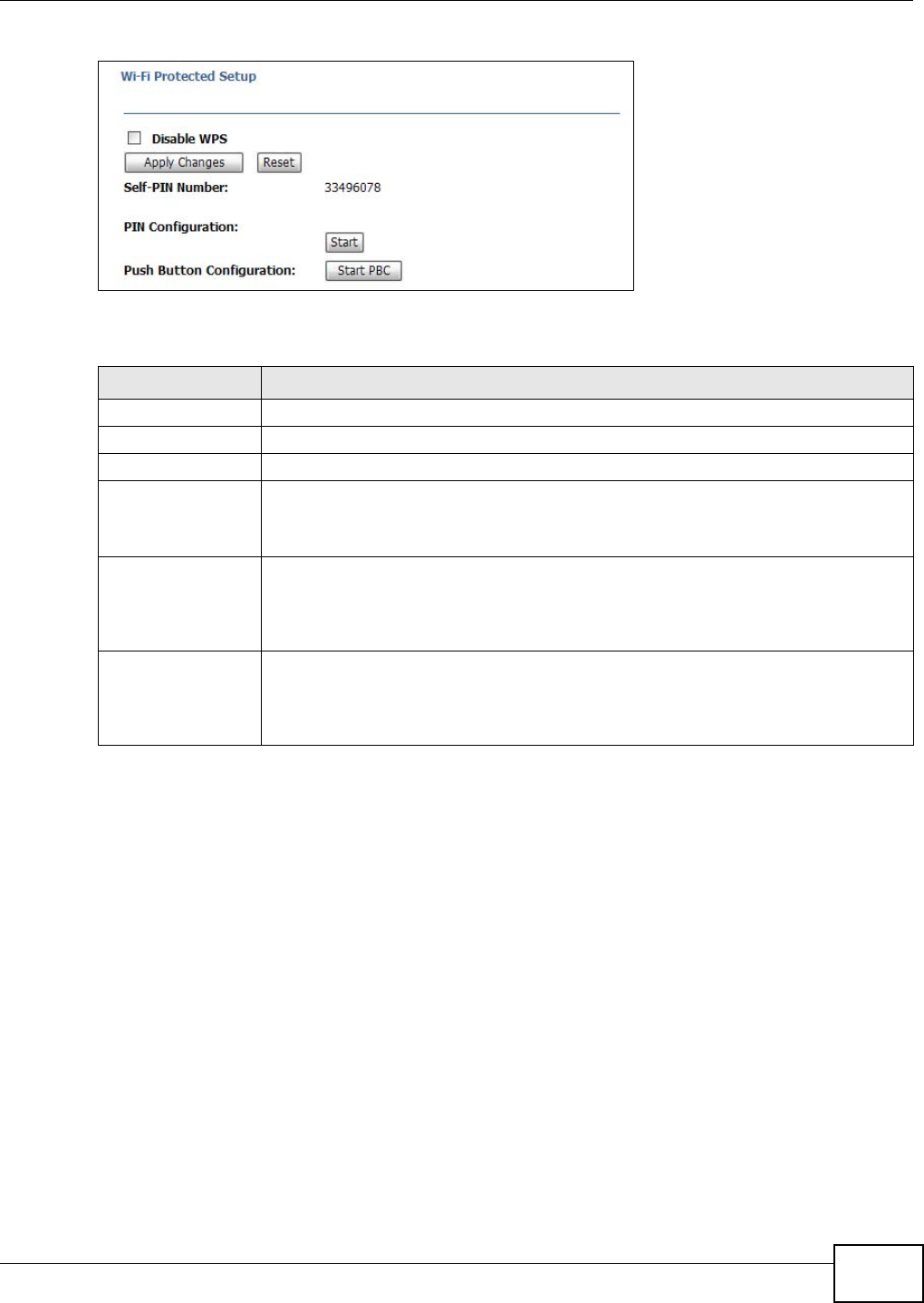
Chapter 13 Wireless LAN
NBG2105 User’s Guide 97
Figure 60 Wireless LAN > WPS (Client mode)
The following table describes the labels in this screen.
13.9 MAC Filtering Screen
The MAC filter screen allows you to configure the NBG2105 to give exclusive access to devices
(Allow Listed) or exclude devices from accessing the NBG2105 (Deny Listed). Every Ethernet
device has a unique MAC (Media Access Control) address. The MAC address is assigned at the
factory and consists of six pairs of hexadecimal characters, for example, 00:A0:C5:00:00:02. You
need to know the MAC address of the devices to configure this screen.
To change your NBG2105’s MAC filter settings, click Wireless LAN > MAC Filtering.
Table 49 Wireless LAN > WPS (Client mode)
LABEL DESCRIPTION
Disable WPS Select this to turn off the WPS feature.
Apply Changes Click this to save changes back to the NBG2105.
Reset Click this to begin configuring this screen afresh.
Self PIN Number This is the WPS PIN (Personal Identification Number) of the NBG2105. Enter this PIN in
the configuration utility of the device you want to connect to the NBG2105 using WPS.
The PIN is not necessary when you use WPS push-button method.
Start Use this button when the AP to which the NBG2105 is connecting uses the PIN
Configuration method to configure wireless station’s wireless settings.
Click Start to associate to each other and perform the wireless security information
synchronization.
Start PBC Use this button when the AP to which the NBG2105 is connecting uses the PBC (Push
Button Configuration) method to configure wireless stations’s wireless settings.
Click Start PBC to start WPS-aware wireless station scanning and the wireless security
information synchronization.
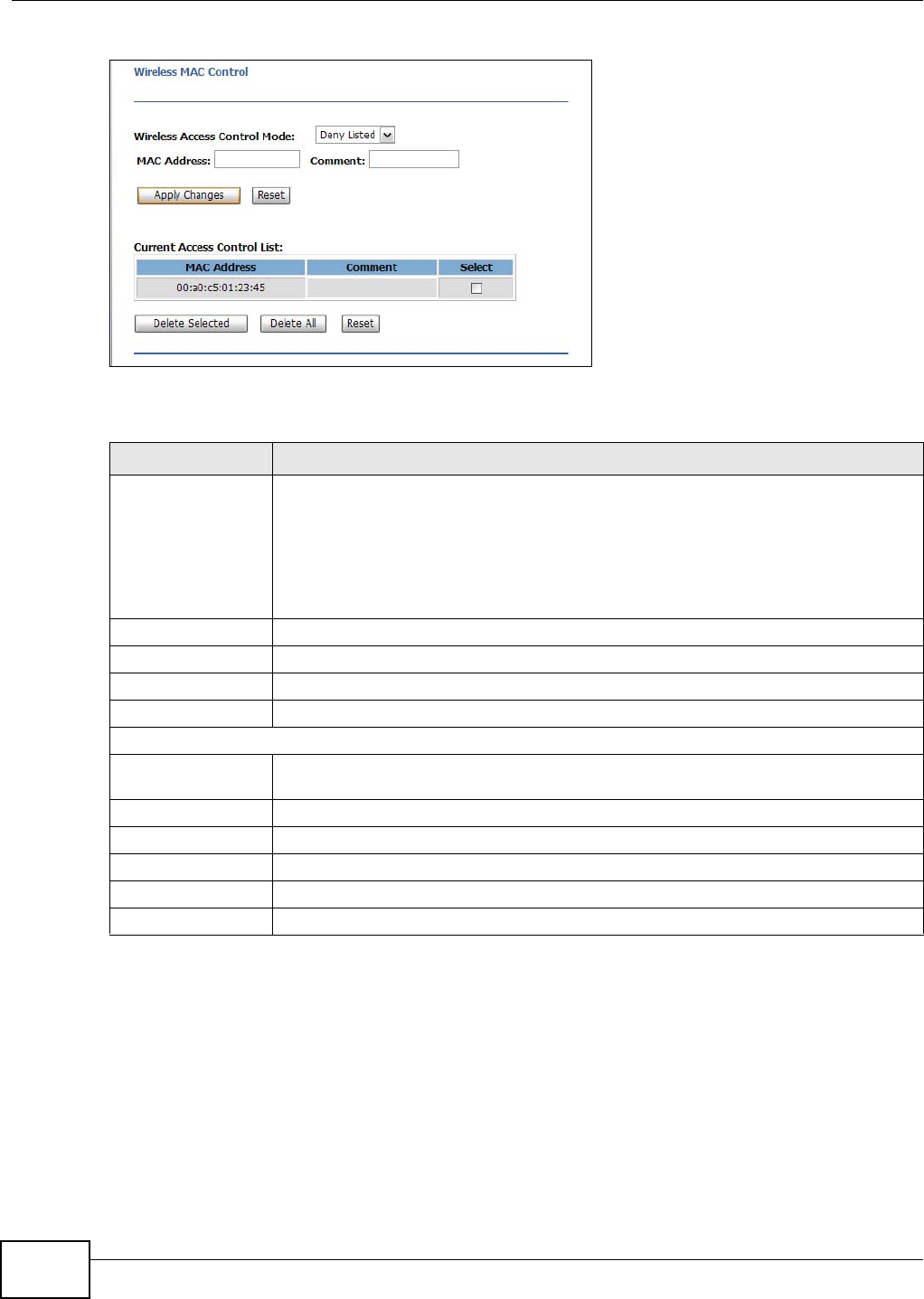
Chapter 13 Wireless LAN
NBG2105 User’s Guide
98
Figure 61 Wireless LAN > MAC Filtering
The following table describes the labels in this screen.
Table 50 Wireless LAN > MAC Filtering
LABEL DESCRIPTION
Wireless Access
Control Mode
Select Disable to turn off MAC address filtering, or define the filter action for the list of
MAC addresses in the Current Access Control List.
Select Allow Listed to permit access to the NBG2105, MAC addresses not listed will be
denied access to the NBG2105.
Select Deny Listed to block access to the NBG2105, MAC addresses not listed will be
allowed to access the NBG2105.
MAC Address Enter the MAC address for this access control entry.
Comment Enter a description of this access control entry.
Apply Changes Click this to save changes back to the NBG2105.
Reset Click this to begin configuring this screen afresh.
Current Access Control List
MAC Address This shows the MAC address of the wireless station that is allowed or denied access to
the NBG2105.
Comment This shows a description of this access control entry.
Select Click this to select this rule.
Delete Selected Click this to delete the selected rules.
Delete All Click this to delete all rules.
Reset Click this to reset all selections.

NBG2105 User’s Guide 99
CHAPTER 14
Firewall
14.1 Overview
This chapter shows you how to enable and configure the NBG2105 firewall settings.
The NBG2105 firewall is a packet filtering firewall and restricts access based on the source/
destination computer network address of a packet and the type of application.
14.2 What You Can Do
•Use the Port Filtering screen to apply filtering based on UDP or TCP port numbers (Section 14.4
on page 100).
•Use the IP Filtering screen to apply filtering based on IP addresses (Section 14.5 on page 101).
•Use the MAC Filtering to apply filtering based on MAC addresses (Section 14.6 on page 101).
•Use the URL Filtering to apply filtering based on URLs (Section 14.7 on page 102).
14.3 What You Need To Know
The following terms and concepts may help as you read through this chapter.
What is a Firewall?
A "firewall" is a system or group of systems that enforces an access-control policy between two
networks. Of course, firewalls cannot solve every security problem.
Guidelines For Enhancing Security
1Change the default password via Web Configurator.
2Think about access control before you connect to the network in any way, including attaching a
modem to the port.
3Limit who can access your router.
4Don't enable any local service (such as NTP) that you don't use. Any enabled service could present
a potential security risk. A determined hacker might be able to find creative ways to misuse the
enabled services to access the firewall or the network.
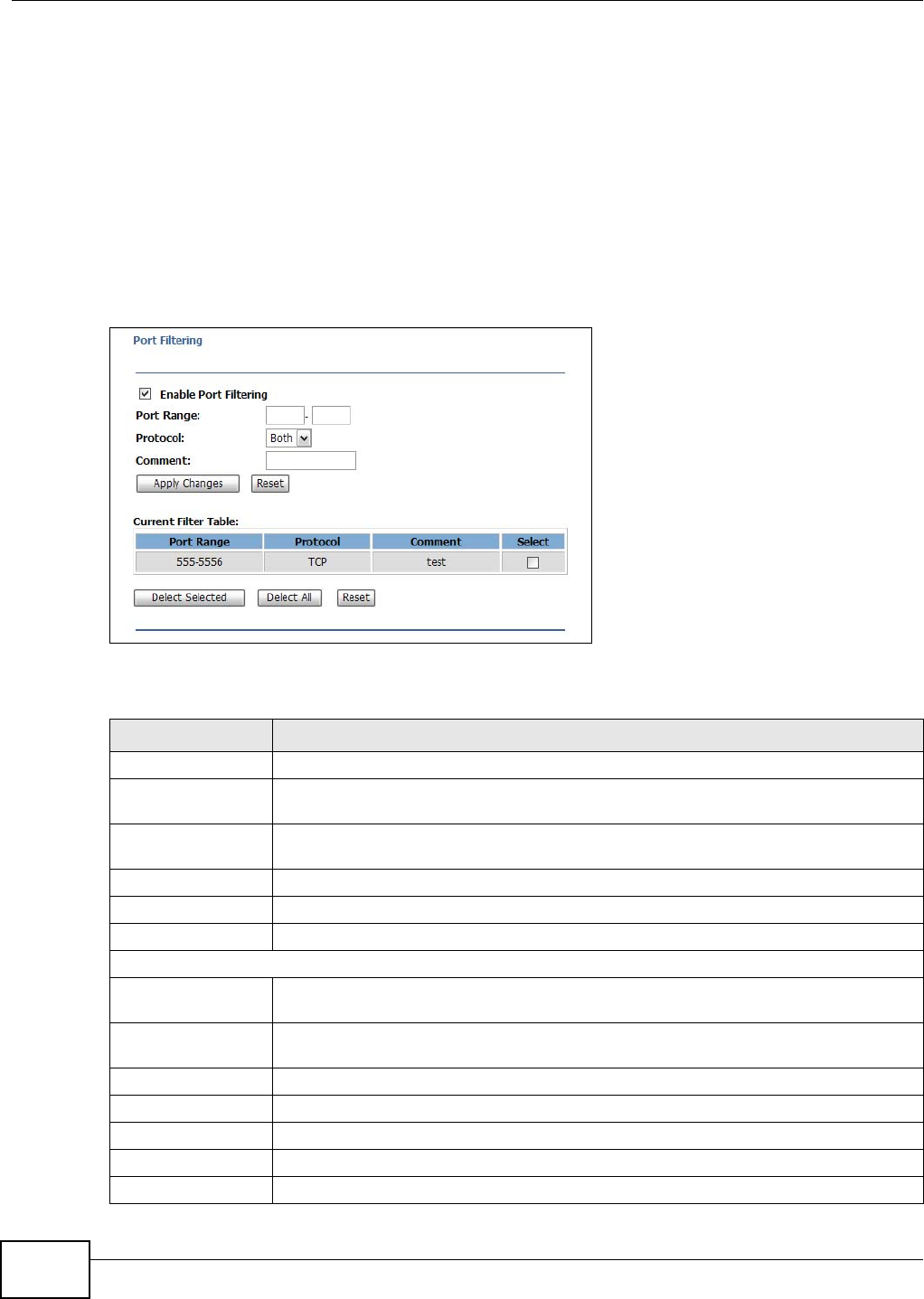
Chapter 14 Firewall
NBG2105 User’s Guide
100
5For local services that are enabled, protect against misuse. Protect by configuring the services to
communicate only with specific peers, and protect by configuring rules to block packets for the
services at specific interfaces.
6Keep the NBG2105 in a secured (locked) room.
14.4 Port Filtering Screen
Click Firewall > Port Filtering to apply filtering based on UDP or TCP port numbers.
Figure 62 Firewall > Port Filtering
The following table describes the labels in this screen.
Table 51 Firewall > Port Filtering
LABEL DESCRIPTION
Enable Port Filtering Click this to apply filtering based on UDP or TCP port numbers.
Port Range Enter the port number or range of ports that define the traffic type. For example TCP
port 80 defines web traffic.
Protocol Select TCP to filter on TCP ports, UDP to filter on UDP ports or Both to filter on both
TCP and UDP ports.
Comment Enter a description of this rule.
Apply Changes Click this to save changes back to the NBG2105.
Reset Click this to begin configuring this screen afresh.
Current Filter Table
Port Range This shows the port number or range of ports that define the traffic type. For example
TCP port 80 defines web traffic.
Protocol This shows TCP for TCP port filtering, UDP for UDP port filtering or Both for TCP and
UDP port filtering.
Comment Enter a description of this rule.
Select Click this to select this rule.
Delete Selected Click this to delete the selected rules.
Delete All Click this to delete all rules.
Reset Click this to reset all selections.
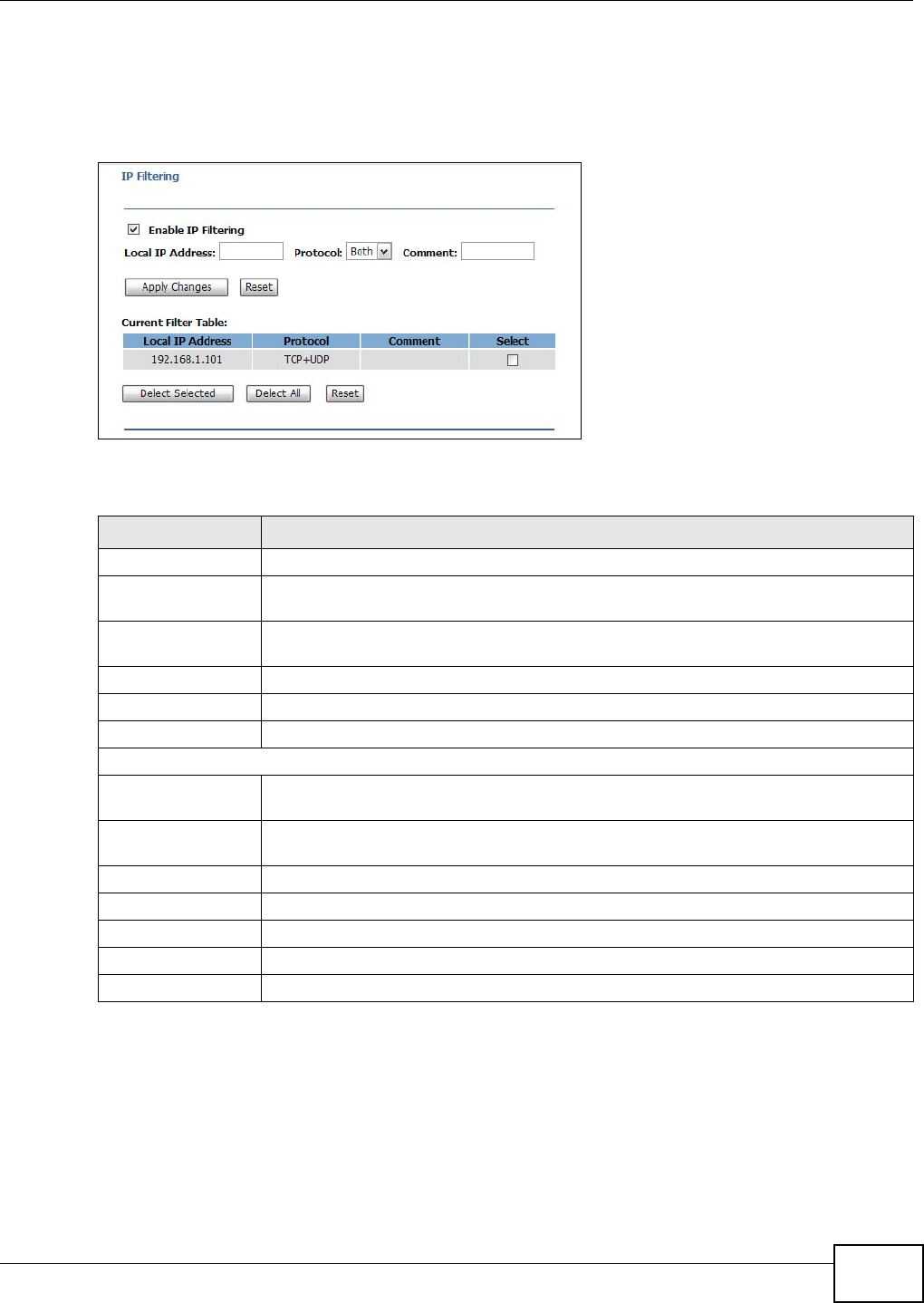
Chapter 14 Firewall
NBG2105 User’s Guide 101
14.5 IP Filtering Screen
Click Firewall > IP Filtering to apply filtering based on IP addresses.
Figure 63 Firewall > IP Filtering
The following table describes the labels in this screen.
14.6 MAC Filtering Screen
Click Firewall > MAC Filtering to apply filtering based on MAC addresses.
Table 52 Firewall > IP Filtering
LABEL DESCRIPTION
Enable IP Filtering Click this to apply filtering based on IP addresses.
Local IP Address Enter the source IP address of outgoing packets or the destination IP address of
incoming packets that this rule matches.
Protocol Select TCP to filter on TCP packets, UDP to filter on UDP packets or Both to filter on
both TCP and UDP packets.
Comment Enter a description of this rule.
Apply Changes Click this to save changes back to the NBG2105.
Reset Click this to begin configuring this screen afresh.
Current Filter Table
Local IP Address This shows the source IP address of outgoing packets or the destination IP address of
incoming packets that this rule matches.
Protocol This shows TCP for TCP port filtering, UDP for UDP port filtering or Both for TCP and
UDP port filtering.
Comment Enter a description of this rule.
Select Click this to select this rule.
Delete Selected Click this to delete the selected rules.
Delete All Click this to delete all rules.
Reset Click this to reset all selections.
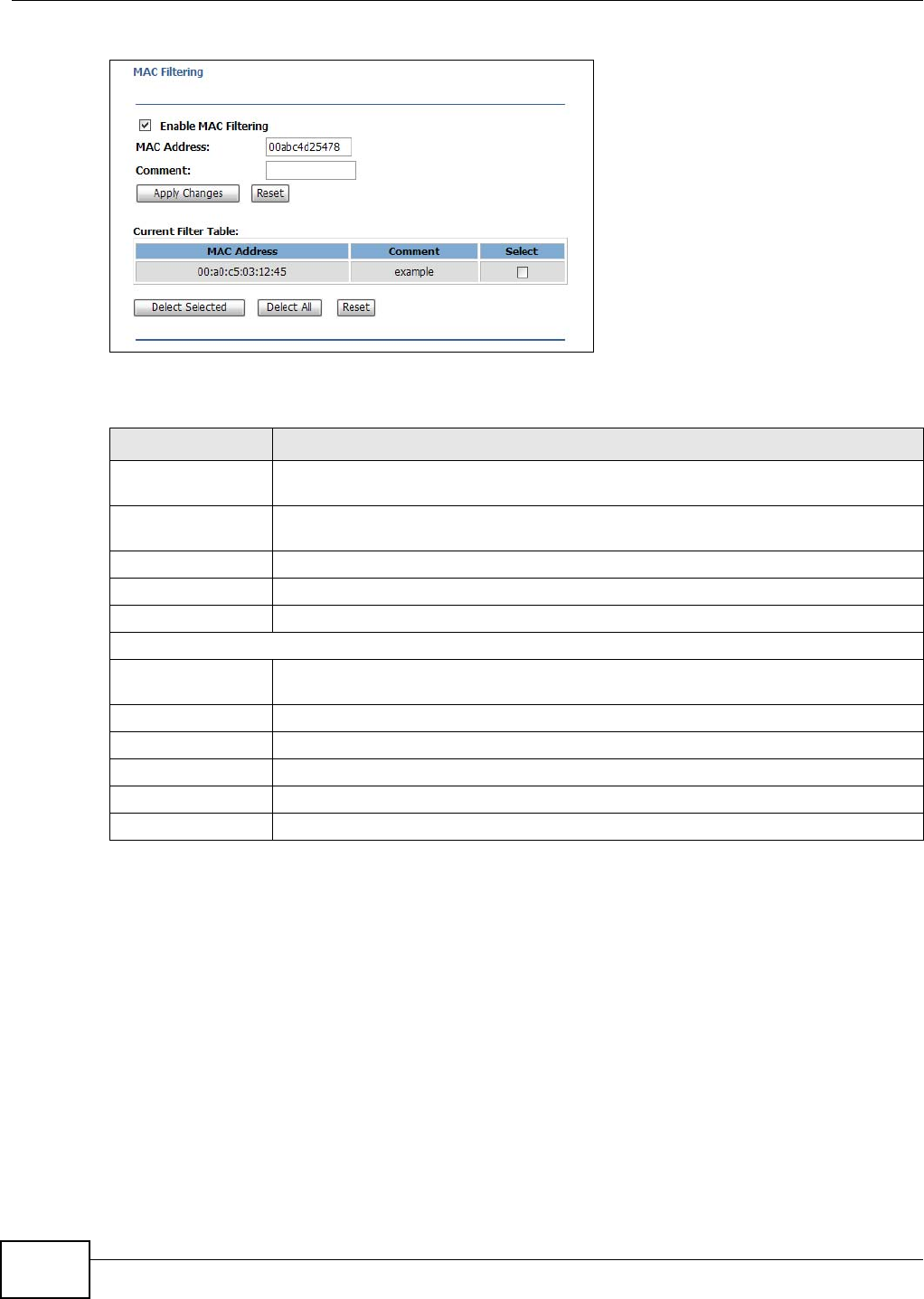
Chapter 14 Firewall
NBG2105 User’s Guide
102
Figure 64 Firewall > MAC Filtering
The following table describes the labels in this screen.
14.7 URL Filtering Screen
Click Firewall > URL Filtering to apply filtering based on URLs.
Table 53 Firewall > MAC Filtering
LABEL DESCRIPTION
Enable MAC
Filtering
Click this to apply filtering based on MAC addresses.
MAC Address Enter the source MAC address of outgoing packets or the destination MAC address of
incoming packets that this rule matches.
Comment Enter a description of this rule.
Apply Changes Click this to save changes back to the NBG2105.
Reset Click this to begin configuring this screen afresh.
Current Filter Table
MAC Address This shows the source MAC address of outgoing packets or the destination MAC address
of incoming packets that this rule matches.
Comment Enter a description of this rule.
Select Click this to select this rule.
Delete Selected Click this to delete the selected rules.
Delete All Click this to delete all rules.
Reset Click this to reset all selections.
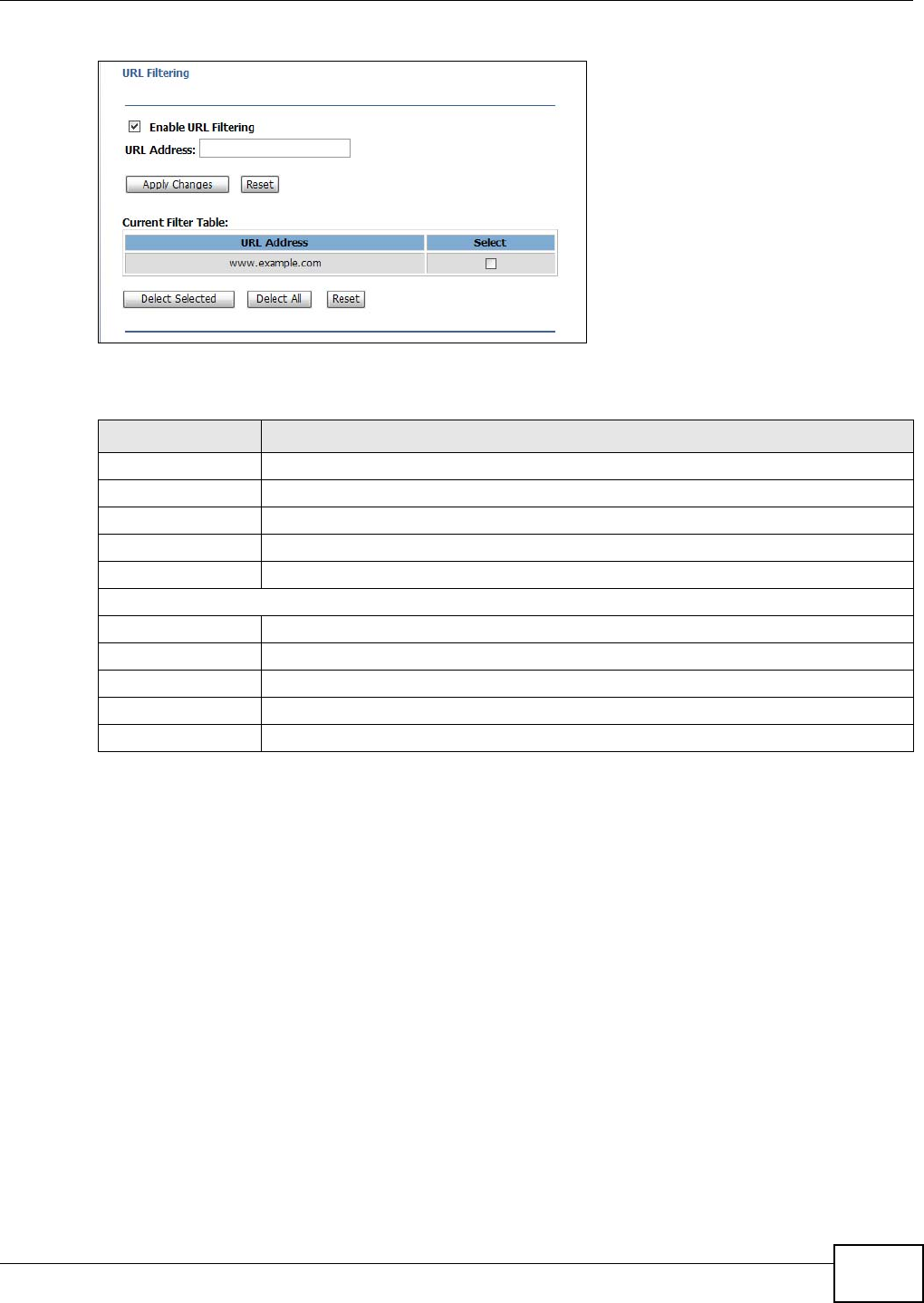
Chapter 14 Firewall
NBG2105 User’s Guide 103
Figure 65 Firewall > URL Filtering
The following table describes the labels in this screen.
Table 54 Firewall > URL Filtering
LABEL DESCRIPTION
Enable URL Filtering Click this to apply filtering based on URLs.
URL Address Enter the URL that this rule matches.
Comment Enter a description of this rule.
Apply Changes Click this to save changes back to the NBG2105.
Reset Click this to begin configuring this screen afresh.
Current Filter Table
URL Address This shows the source URL that this rule matches.
Select Click this to select this rule.
Delete Selected Click this to delete the selected rules.
Delete All Click this to delete all rules.
Reset Click this to reset all selections.

Chapter 14 Firewall
NBG2105 User’s Guide
104

NBG2105 User’s Guide 105
CHAPTER 15
Management
15.1 Overview
This chapter describes the Management screens.
15.2 What You Can Do
•Use the NTP screen to change your NBG2105’s time and date (Section 15.3 on page 105).
•Use the Password screen to change your NBG2105’s system password (Section 15.4 on page
106).
•Use the Upgrade Firmware screen to upload firmware to your NBG2105 (Section 15.5 on page
107).
•Use the Backup/Restore screen to view information related to factory defaults, backup
configuration, and restoring configuration (Section 15.6 on page 108).
•Use the Operation screen to select how you want to use your NBG2105 (Section 15.7 on page
109).
•Use the Language screen to change the language for the Web Configurator (Section 15.8 on
page 109).
•Use the Reboot screen to reboot the NBG2105 without turning the power off (Section 15.9 on
page 110).
15.3 NTP Screen
Use this screen to configure the NBG2105’s time based on your local time zone. To change your
NBG2105’s time and date, click Management > NTP.
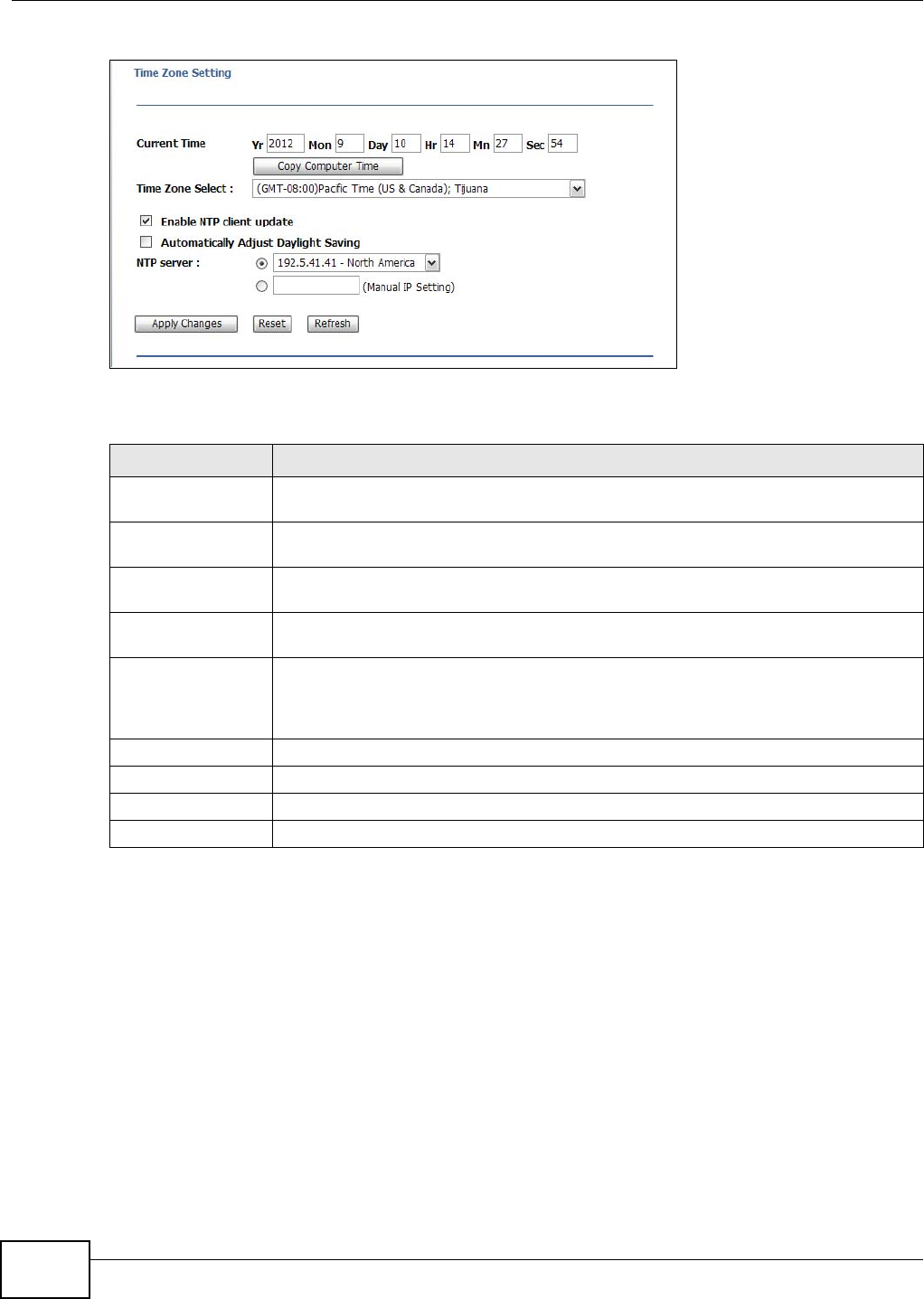
Chapter 15 Management
NBG2105 User’s Guide
106
Figure 66 Management > NTP
The following table describes the labels in this screen.
15.4 Password Screen
It is strongly recommended that you change your NBG2105's password.
Note: If you forget your NBG2105's password (or IP address), you will need to reset the
device. See Section 1.5.1 on page 14 for details.
Click Management > Password.
Table 55 Management > NTP
LABEL DESCRIPTION
Current Time Enter the current time, or click Copy Computer Time to use your computer to set the
time.
Copy Computer
Time
Click this to use your computer to set the time.
Time Zone Select Choose the time zone of your location. This will set the time difference between your
time zone and Greenwich Mean Time (GMT).
Enable NTP client
update
Select this to configure the NBG2105 to update its time from an NTP server
automatically.
Automatically
Adjust Daylight
Saving
Select this to configure the NBG2105 to automatically change the time according to
daylight saving conventions in your time zone. Daylight saving is a period from late
spring to early fall when many countries set their clocks ahead of normal local time by
one hour to give more daytime light in the evening.
NTP Server Select an NTP server, closest to you, or manually enter the IP address of an NTP server.
Apply Changes Click this to save changes back to the NBG2105.
Reset Click this to begin configuring this screen afresh.
Refresh Click this to update the screen.
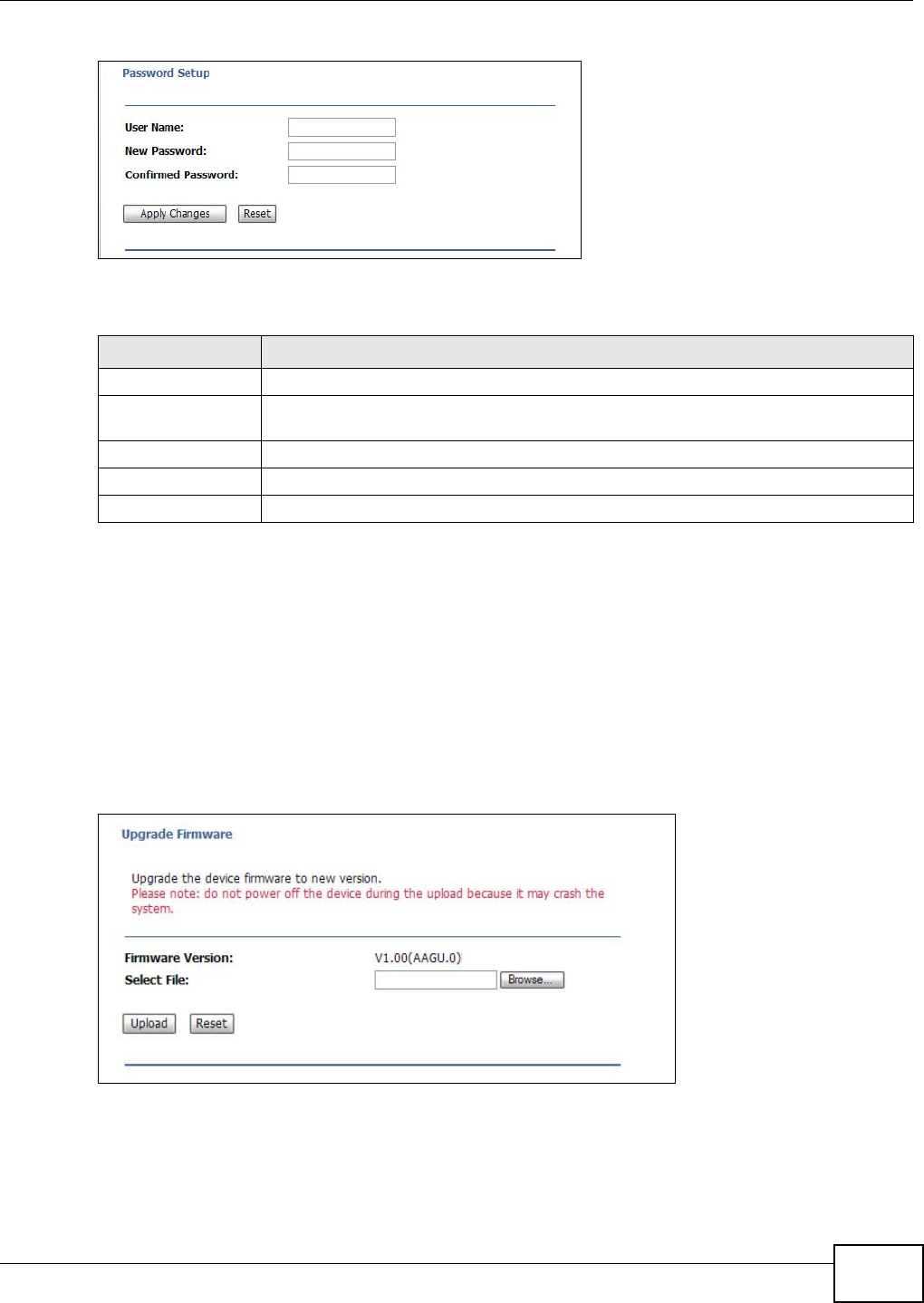
Chapter 15 Management
NBG2105 User’s Guide 107
Figure 67 Management > Password
The following table describes the labels in this screen.
15.5 Upgrade Firmware Screen
Find firmware at www.zyxel.com in a file that uses the version number and project code with a
“*.bin” extension, e.g., “V1.00(AAAGU.0).bin”. The upload process uses HTTP (Hypertext Transfer
Protocol) and may take up to two minutes. After a successful upload, the system will reboot.
Click Management > Upgrade Firmware. Follow the instructions in this screen to upload
firmware to your NBG2105.
Figure 68 Management > Upgrade Firmware
Table 56 Management > Password
LABEL DESCRIPTION
User Name Enter your new user name.
New Password Enter your new system password. Note that as you type a password, the screen
displays an asterisk (*) for each character you type.
Confirmed Password Enter the new password again in this field.
Apply Changes Click this to save changes back to the NBG2105.
Reset Click this to begin configuring this screen afresh.
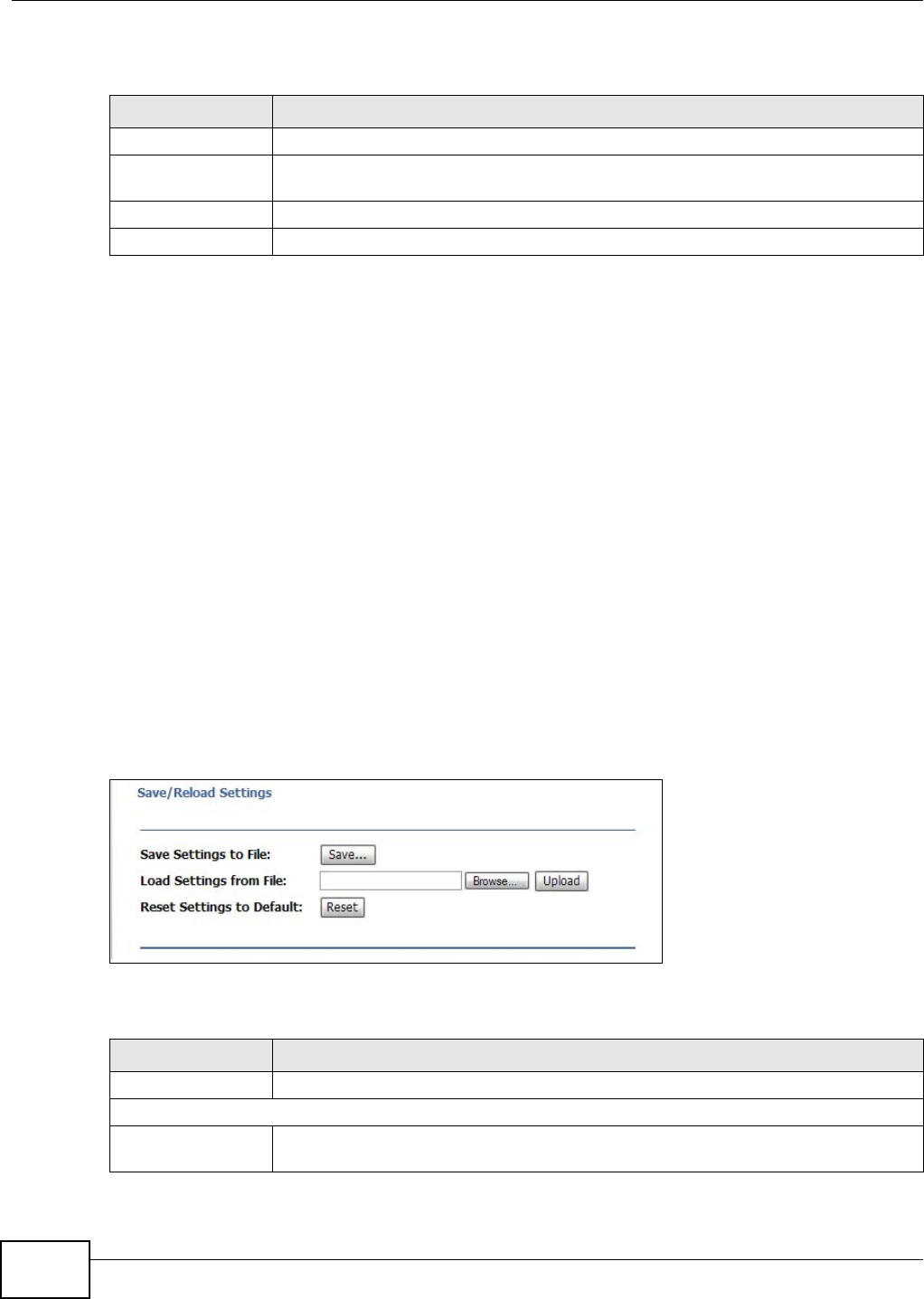
Chapter 15 Management
NBG2105 User’s Guide
108
The following table describes the labels in this screen.
Note: Do not turn off the NBG2105 while firmware upload is in progress!
The NBG2105 automatically restarts in this time causing a temporary network disconnect.
After the login screen display, log in again and check your new firmware version in the Status
screen.
15.6 Backup/Restore Screen
Backup configuration allows you to back up (save) the NBG2105’s current configuration to a file on
your computer. Once your NBG2105 is configured and functioning properly, it is highly
recommended that you back up your configuration file before making configuration changes. The
backup configuration file will be useful in case you need to return to your previous settings.
Restore configuration allows you to upload a new or previously saved configuration file from your
computer to your NBG2105.
Click Management > Backup/Restore. Information related to factory defaults, backup
configuration, and restoring configuration appears as shown next.
Figure 69 Management > Backup/Restore
The following table describes the labels in this screen.
Table 57 Management > Upgrade Firmware
LABEL DESCRIPTION
Firmware Version This shows the current firmware version installed on the NBG2105.
Browse... Click Browse... to find the .bin file you want to upload. Remember that you must
decompress compressed (.zip) files before you can upload them.
Upload Click Upload to begin the upload process. This process may take up to two minutes.
Reset Click this to begin configuring this screen afresh.
Table 58 Management > Backup/Restore
LABEL DESCRIPTION
Save Settings to File Click Save... to save the NBG2105’s current configuration to your computer.
Load Settings from File
Browse... Click Browse... to find the file you want to upload. Remember that you must
decompress compressed (.ZIP) files before you can upload them.
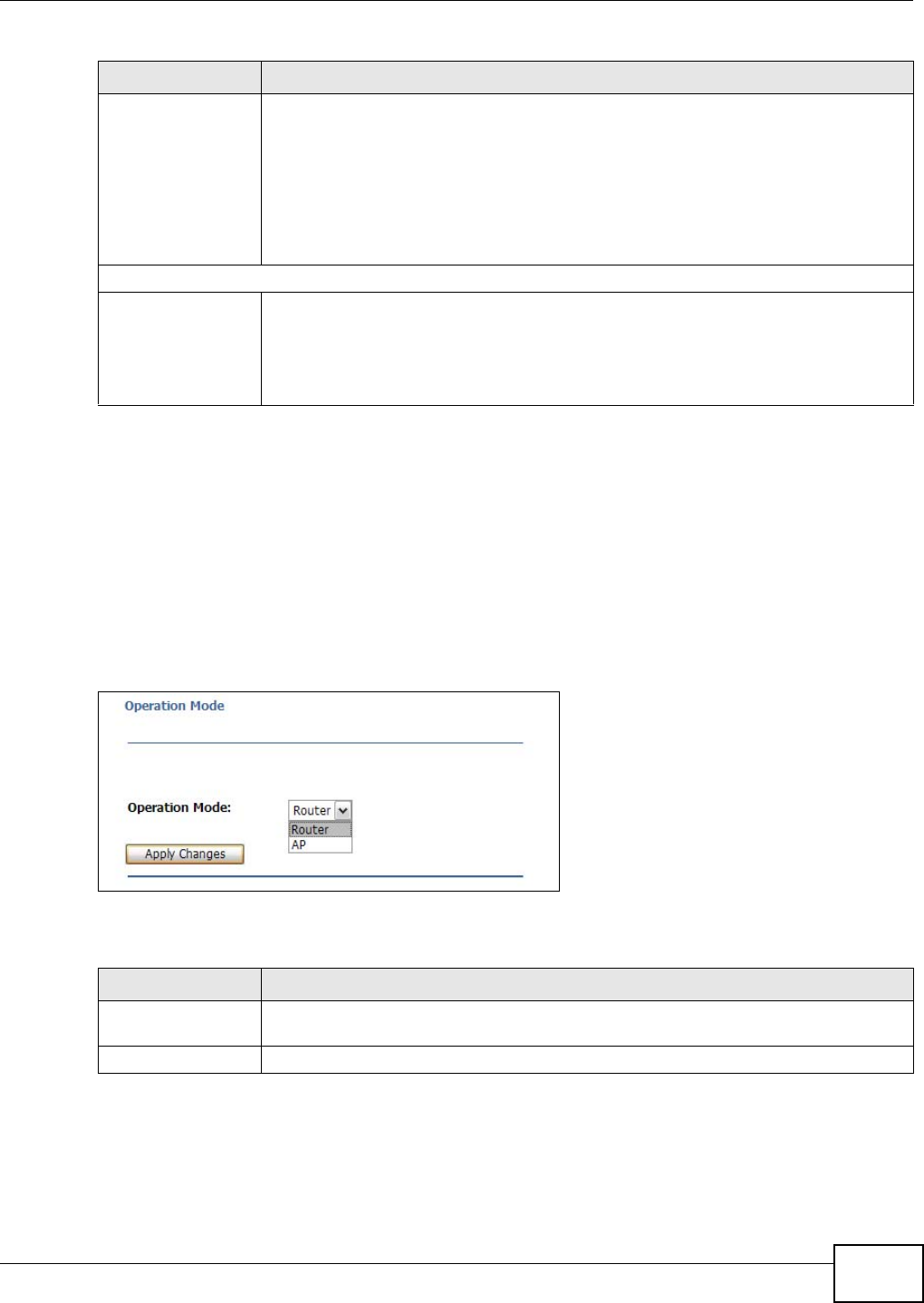
Chapter 15 Management
NBG2105 User’s Guide 109
Note: If you uploaded the default configuration file you may need to change the IP
address of your computer to be in the same subnet as that of the default NBG2105
IP address.
15.7 Router Operation Mode Screen
The NBG2105 can be configured as a wireless router or just an AP when in router mode. Click
Management > Operation.
Figure 70 Management > Operation (Router)
The following table describes the labels in this screen.
15.8 Language Screen
Use this screen to change the language for the Web Configurator.
Upload Click this to begin the upload process.
Note: Do not turn off the NBG2105 while configuration file upload is in progress.
After you see a “configuration upload successful” screen, you must then wait one
minute before logging into the NBG2105 again. The NBG2105 automatically restarts in
this time causing a temporary network disconnect.
If you see an error screen, click Back to return to the Backup/Restore screen.
Reset Settings to Default
Reset Click this to clear all user-entered configuration information and return the NBG2105 to
its factory defaults.
You can also press the RESET button on the rear panel to reset the factory defaults of
your NBG2105. Refer to the chapter about introducing the Web Configurator for more
information on the RESET button.
Table 58 Management > Backup/Restore (continued)
LABEL DESCRIPTION
Table 59 Management > Operation (Router)
LABEL DESCRIPTION
Operation Mode Select Router to configure the NBG2105 as a wireless router or AP to configure the
NBG2105 as an AP only.
Apply Changes Click this to save changes back to the NBG2105.
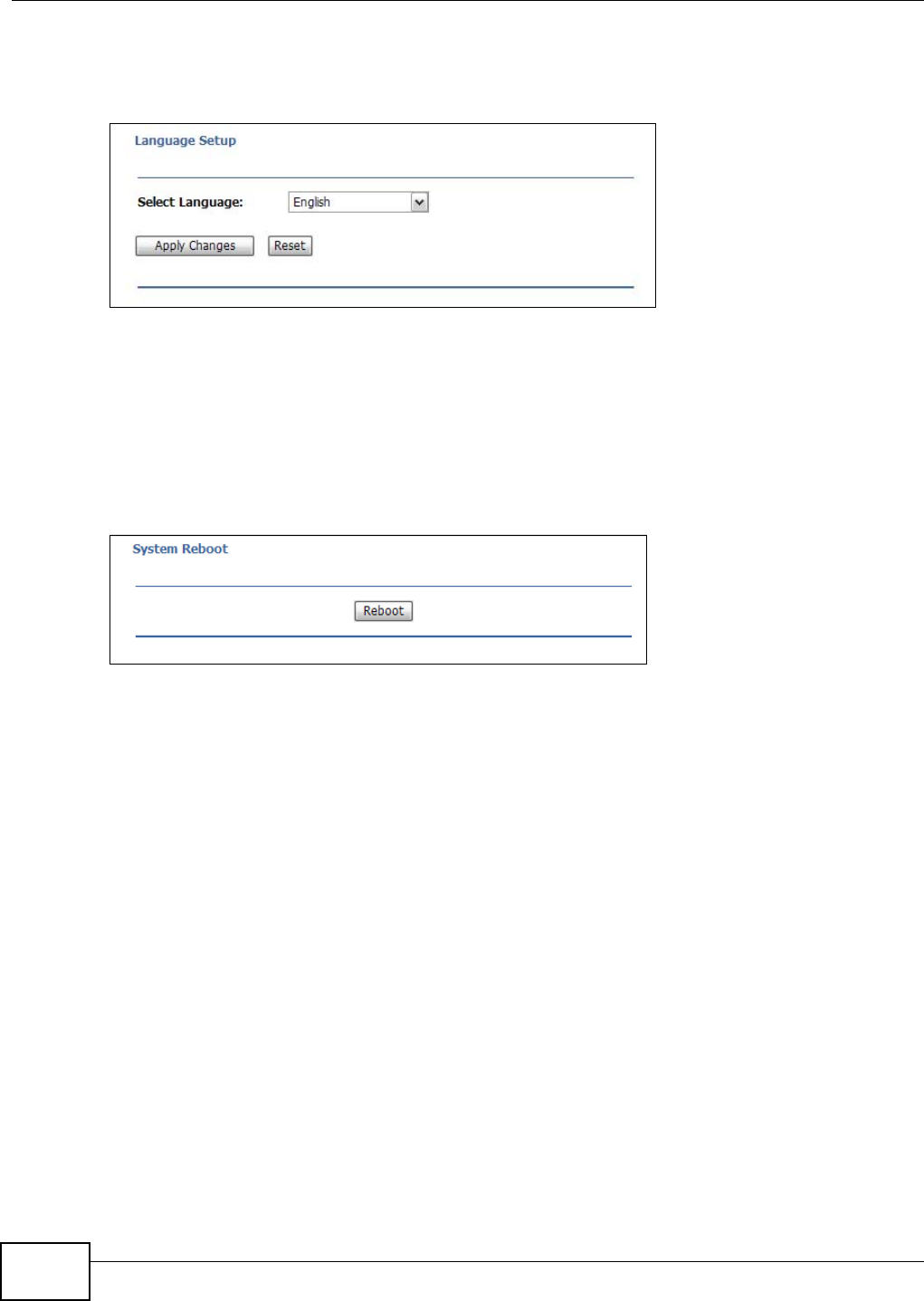
Chapter 15 Management
NBG2105 User’s Guide
110
Select the language you prefer and click Apply Changes. The Web Configurator language changes
after a while without restarting the NBG2105.
Figure 71 Management > Language
15.9 Restart Screen
System restart allows you to reboot the NBG2105 without turning the power off.
Click Maintenance > Reboot to open the following screen.
Figure 72 Maintenance > Reboot
Click Reboot to have the NBG2105 restart. This does not affect the NBG2105's configuration.

NBG2105 User’s Guide 111
CHAPTER 16
Status
16.1 Overview
This chapter describes how to show the general status of the NBG2105 as well as statistics and logs
collected by the NBG2105.
16.2 What You Can Do
•Use the Status screen to view system, wireless, local and WAN network information, as well as
general information about the NBG2105.
•Use the Statistics screen to show the number of packets sent and received on the Wireless LAN
and Ethernet WAN interfaces.
•Use the Log screen to look at all of the NBG2105’s logs in one location.
16.3 Status Screen
Click Status > Status. The screen that appears depends on which mode the NBG2105 is in.
16.3.1 Router Mode
The combination of fields on the following screen appear only in router mode.
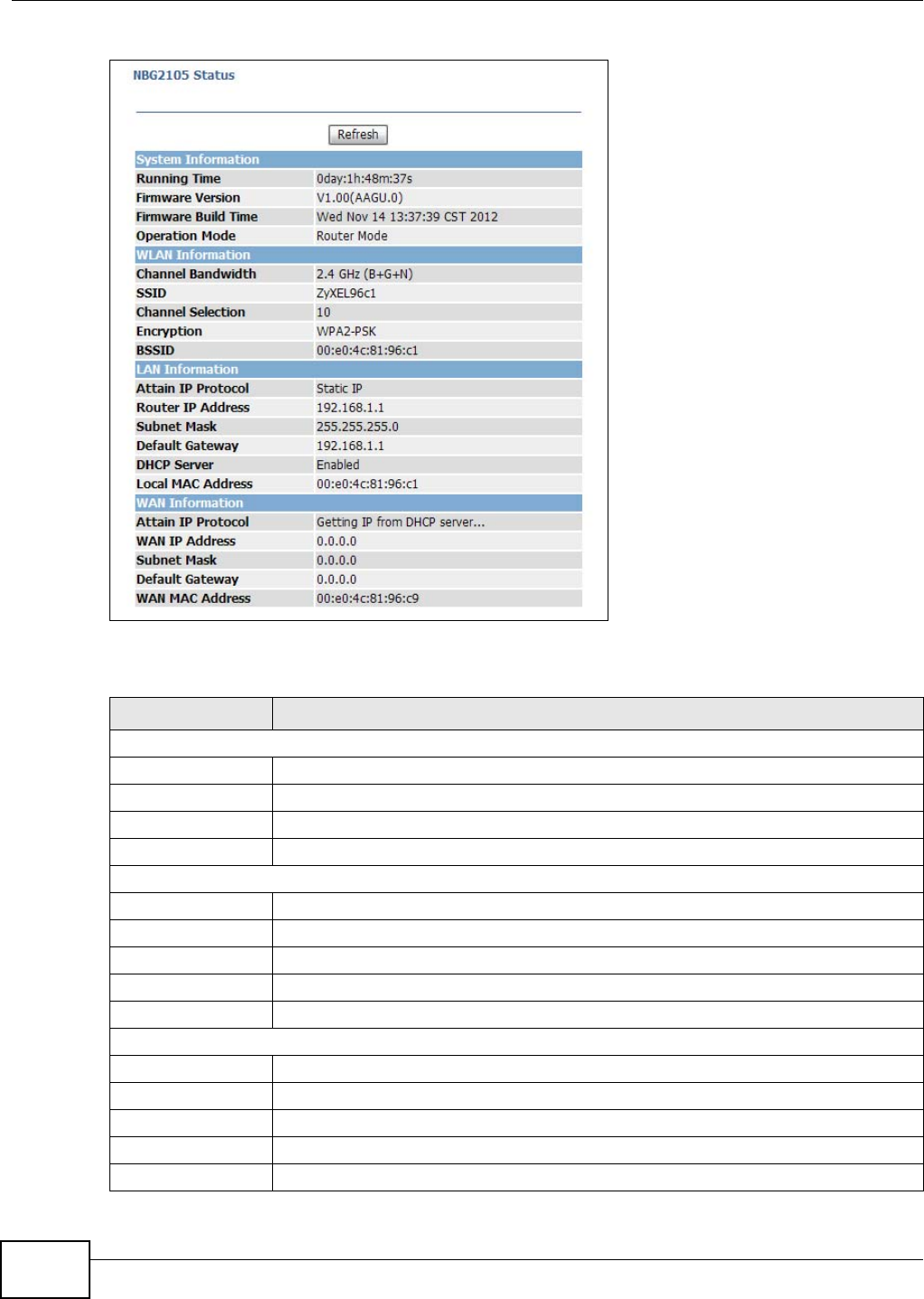
Chapter 16 Status
NBG2105 User’s Guide
112
Figure 73 Status > Status (Router)
The following table describes the labels in this screen.
Table 60 Status > Status (Router)
LABEL DESCRIPTION
System Information
Running Time This shows how long the NBG2105 has been running.
Firmware Version This shows the currently running firmware version.
Firmware Build Time This shows when the currently running firmware was compiled.
Operation Mode This shows which mode the NBG2105 is in.
WLAN Information
Channel Bandwidth This shows which frequency band and wireless mode your network uses.
SSID This shows a descriptive name used to identify the NBG2105 in the wireless LAN.
Channel Selection This shows the channel number.
Encryption This shows the type of wireless encryption the NBG2105 is using.
BSSID This shows the wireless adapter MAC Address of your device.
LAN Information
Attain IP Protocol This shows how the LAN interface gets its IP configuration.
Router IP Address This shows the LAN interface’s IP address.
Subnet Mask This shows the LAN interface’s subnet mask.
Default Gateway This shows the IP address of the LAN interface’s default gateway.
DHCP Server This shows whether the DHCP server is enabled or not.
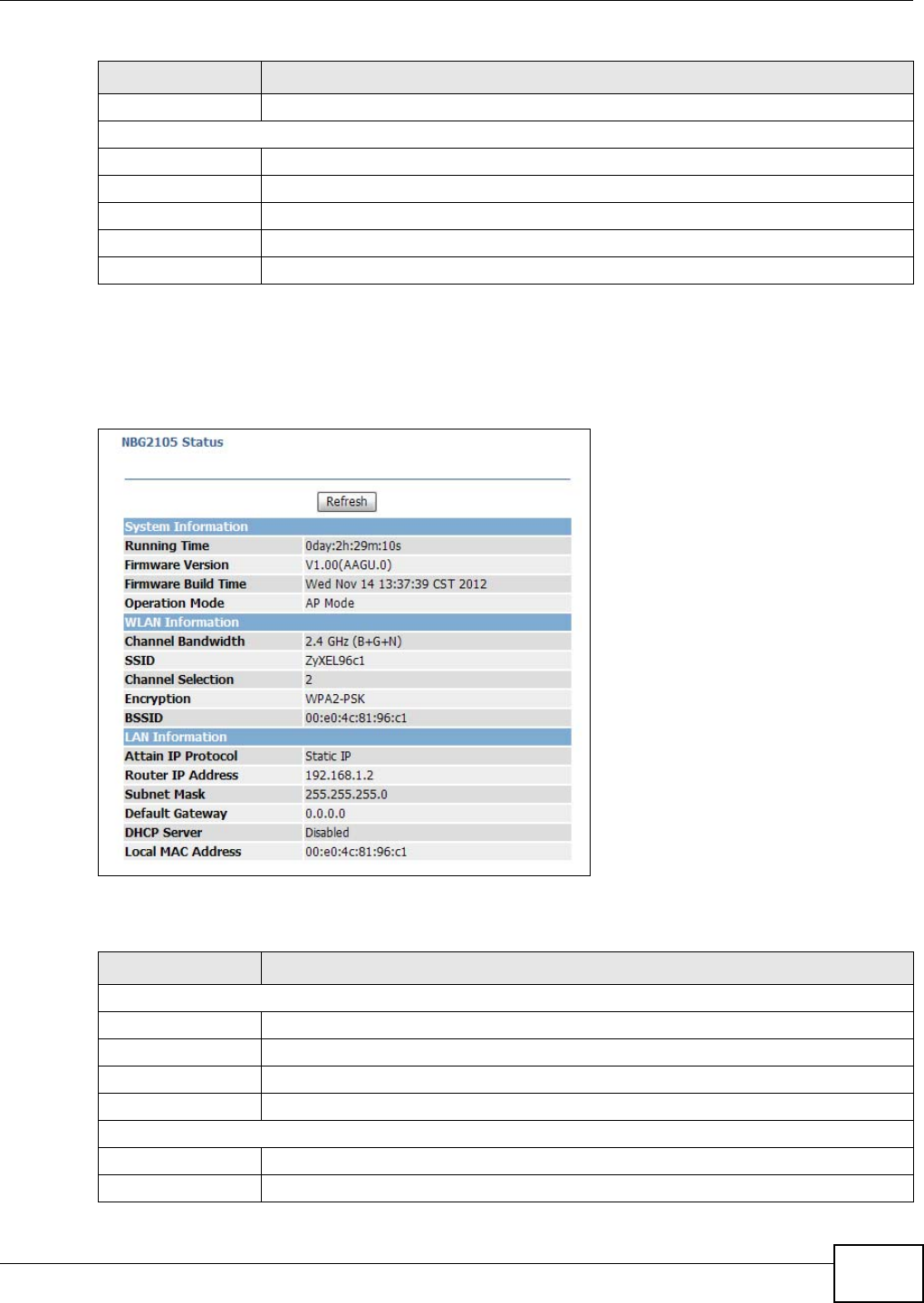
Chapter 16 Status
NBG2105 User’s Guide 113
16.3.2 AP Mode
The combination of fields on the following screen appear only in AP mode.
Figure 74 Status > Status (AP)
The following table describes the labels in this screen.
Local MAC Address This shows the LAN Ethernet adapter MAC Address of your device.
WAN Information
Attain IP Protocol This shows how the WAN interface gets its IP configuration.
WAN IP Address This shows the WAN interface’s IP address.
Subnet Mask This shows the WAN interface’s subnet mask.
Default Gateway This shows the WAN interface’s gateway IP address.
WAN MAC Address This shows the WAN Ethernet adapter MAC Address of your device.
Table 60 Status > Status (Router) (continued)
LABEL DESCRIPTION
Table 61 Status > Status (AP)
LABEL DESCRIPTION
System Information
Running Time This shows how long the NBG2105 has been running.
Firmware Version This shows the currently running firmware version.
Firmware Build Time This shows when the currently running firmware was compiled.
Operation Mode This shows which mode the NBG2105 is in.
WLAN Information
Channel Bandwidth This shows which frequency band and wireless mode your network uses.
SSID This shows a descriptive name used to identify the NBG2105 in the wireless LAN.
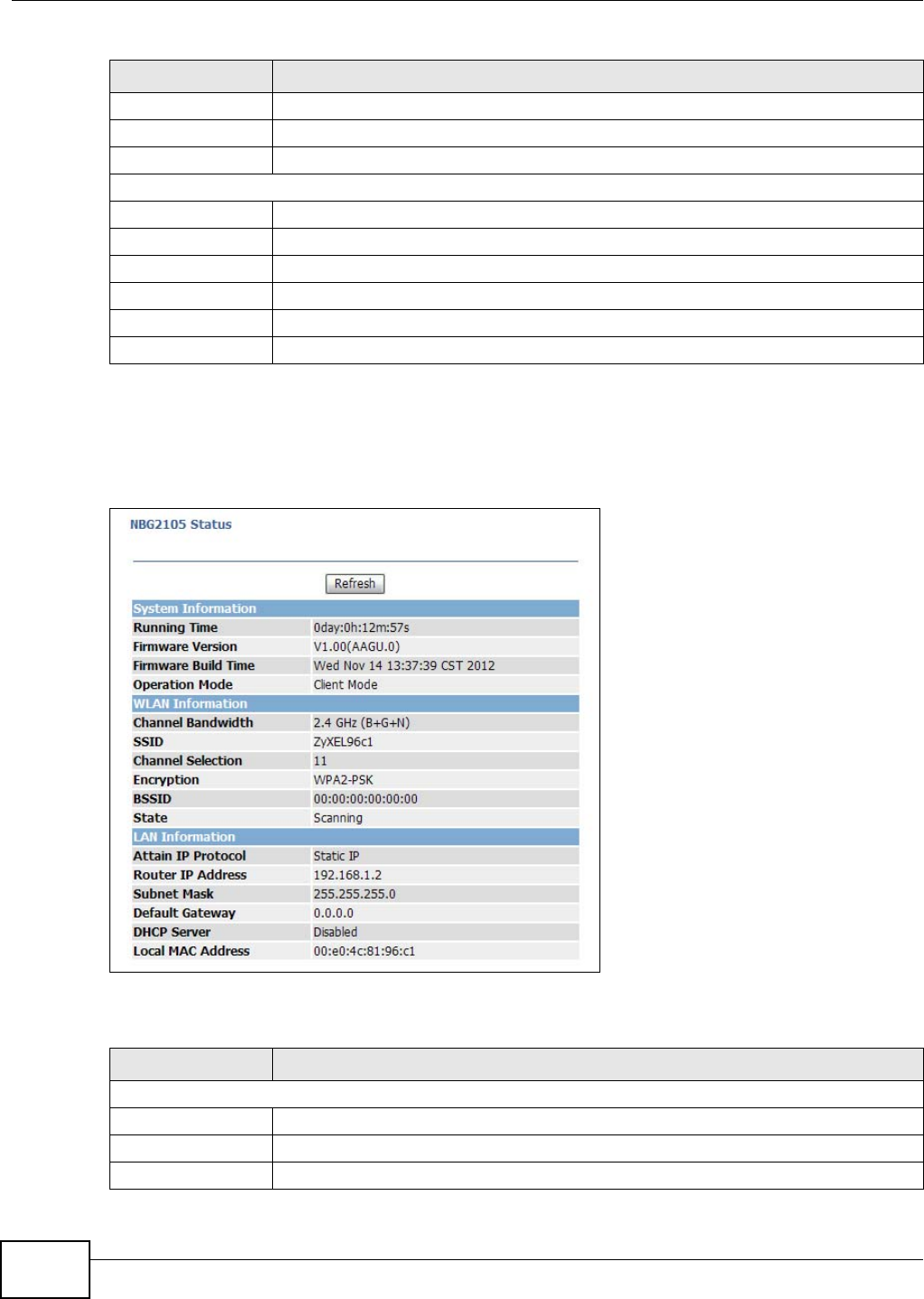
Chapter 16 Status
NBG2105 User’s Guide
114
16.3.3 Client Mode
The combination of fields on the following screen appear only in Client mode.
Figure 75 Status > Status (Client)
The following table describes the labels in this screen.
Channel Selection This shows the channel number.
Encryption This shows the type of wireless encryption the NBG2105 is using.
BSSID This shows the wireless adapter MAC Address of your device.
LAN Information
Attain IP Protocol This shows how the LAN interface gets its IP configuration.
Router IP Address This shows the LAN interface’s IP address.
Subnet Mask This shows the LAN interface’s subnet mask.
Default Gateway This shows the IP address of the LAN interface’s default gateway.
DHCP Server This shows whether the DHCP server is enabled or not.
Local MAC Address This shows the LAN Ethernet adapter MAC Address of your device.
Table 61 Status > Status (AP) (continued)
LABEL DESCRIPTION
Table 62 Status > Status (Client)
LABEL DESCRIPTION
System Information
Running Time This shows how long the NBG2105 has been running.
Firmware Version This shows the currently running firmware version.
Firmware Build Time This shows when the currently running firmware was compiled.

Chapter 16 Status
NBG2105 User’s Guide 115
16.3.4 WISP+UR Mode
The combination of fields on the following screen appear only in WISP+UR mode.
Operation Mode This shows which mode the NBG2105 is in.
WLAN Information
Channel Bandwidth This shows which frequency band and wireless mode your network uses.
SSID This shows the wireless network name of the AP to which the NBG2105 is connecting.
Channel Selection This shows the channel number.
Encryption This shows the type of wireless encryption the NBG2105 is using.
BSSID This shows the wireless adapter MAC Address of your device.
State This shows the whether the NBG2105 is scanning the network or not.
LAN Information
Attain IP Protocol This shows how the LAN interface gets its IP configuration.
Router IP Address This shows the LAN interface’s IP address.
Subnet Mask This shows the LAN interface’s subnet mask.
Default Gateway This shows the IP address of the LAN interface’s default gateway.
DHCP Server This shows whether the DHCP server is enabled or not.
Local MAC Address This shows the LAN Ethernet adapter MAC Address of your device.
Table 62 Status > Status (Client) (continued)
LABEL DESCRIPTION
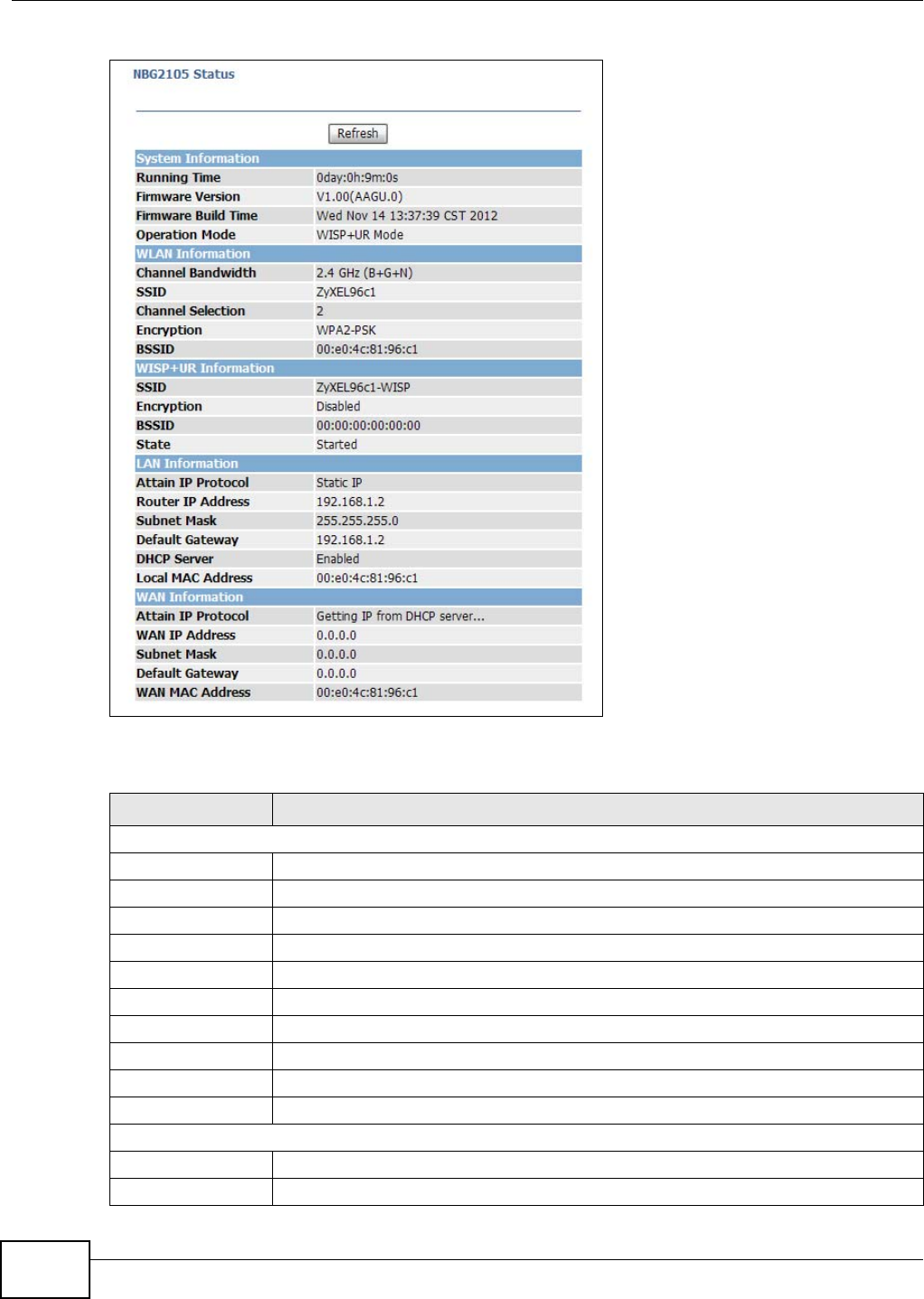
Chapter 16 Status
NBG2105 User’s Guide
116
Figure 76 Status > Status (WISP+UR)
The following table describes the labels in this screen.
Table 63 Status > Status (WISP+UR)
LABEL DESCRIPTION
System Information
Running Time This shows how long the NBG2105 has been running.
Firmware Version This shows the currently running firmware version.
Firmware Build Time This shows when the currently running firmware was compiled.
Operation Mode This shows which mode the NBG2105 is in.
WLAN Information
Channel Bandwidth This shows which frequency your network uses.
SSID This shows the wireless network name of the AP to which the NBG2105 is connecting.
Channel Selection This shows the channel number.
Encryption This shows the type of wireless encryption the NBG2105 is using.
BSSID This shows the wireless adapter MAC Address of your device.
WISP+UR Information
SSID This shows the wireless network name of the AP to which the NBG2105 is connecting.
Encryption This shows the type of wireless encryption the NBG2105 is using.
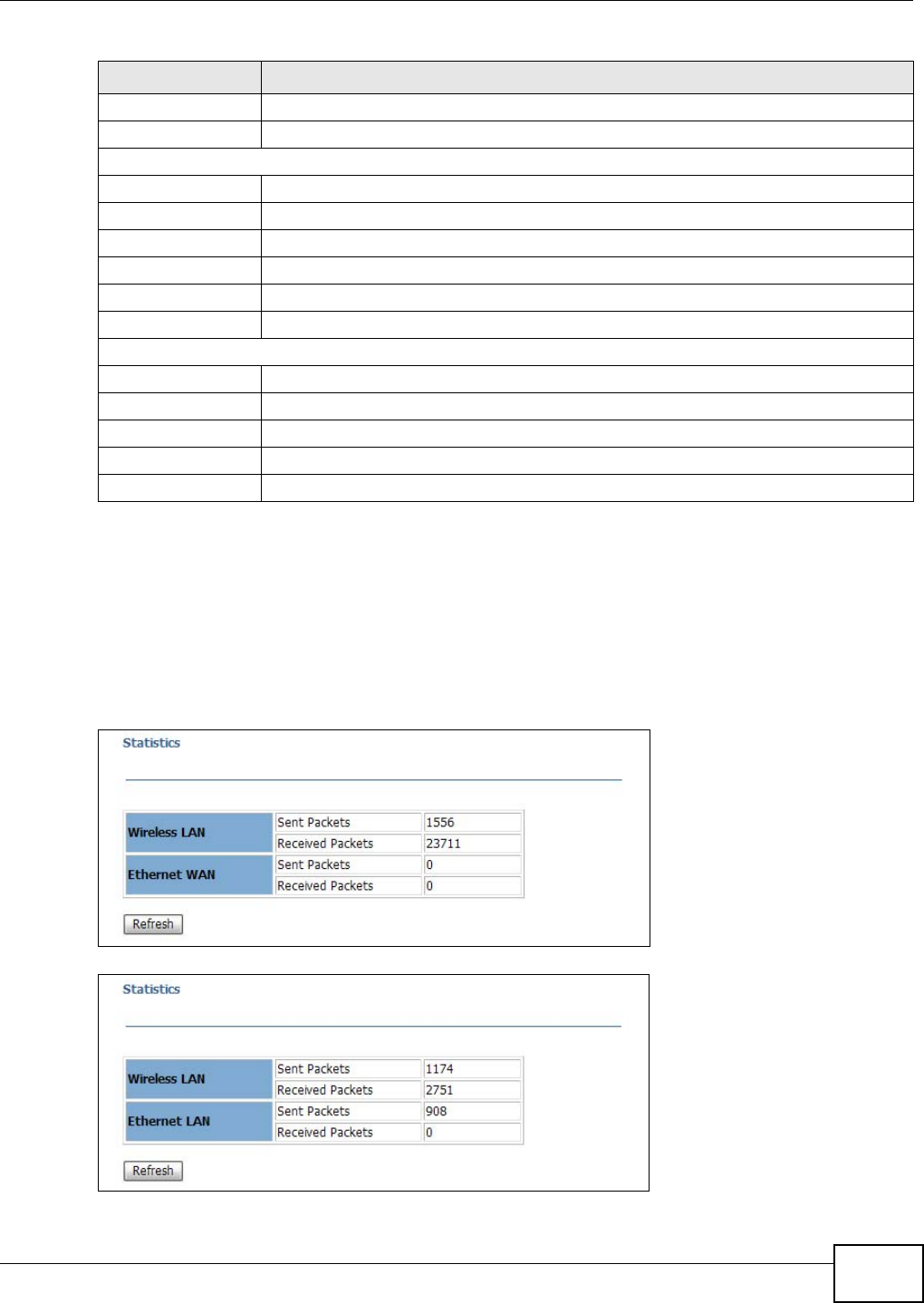
Chapter 16 Status
NBG2105 User’s Guide 117
16.4 Statistics Screen
This screen shows the number of packets sent and received on the Wireless LAN and Ethernet WAN
interfaces. Click Status > Statistics. The screen that appears depends on which mode the
NBG2105 is in.
Figure 77 Status > Statistics (Router)
Figure 78 Status > Statistics (AP or Client)
BSSID This shows the wireless adapter MAC Address of your device.
State This shows what stage the NBG2105 is at with respect to connecting to access points.
LAN Information
Attain IP Protocol This shows how the LAN interface gets its IP configuration.
Router IP Address This shows the LAN interface’s IP address.
Subnet Mask This shows the LAN interface’s subnet mask.
Default Gateway This shows the IP address of the LAN interface’s default gateway.
DHCP Server This shows whether the DHCP server is enabled or not.
Local MAC Address This shows the LAN Ethernet adapter MAC Address of your device.
WAN Information
Attain IP Protocol This shows how the WAN interface gets its IP configuration.
WAN IP Address This shows the WAN interface’s IP address.
Subnet Mask This shows the WAN interface’s subnet mask.
Default Gateway This shows the WAN interface’s gateway IP address.
WAN MAC Address This shows the WAN Ethernet adapter MAC Address of your device.
Table 63 Status > Status (WISP+UR) (continued)
LABEL DESCRIPTION
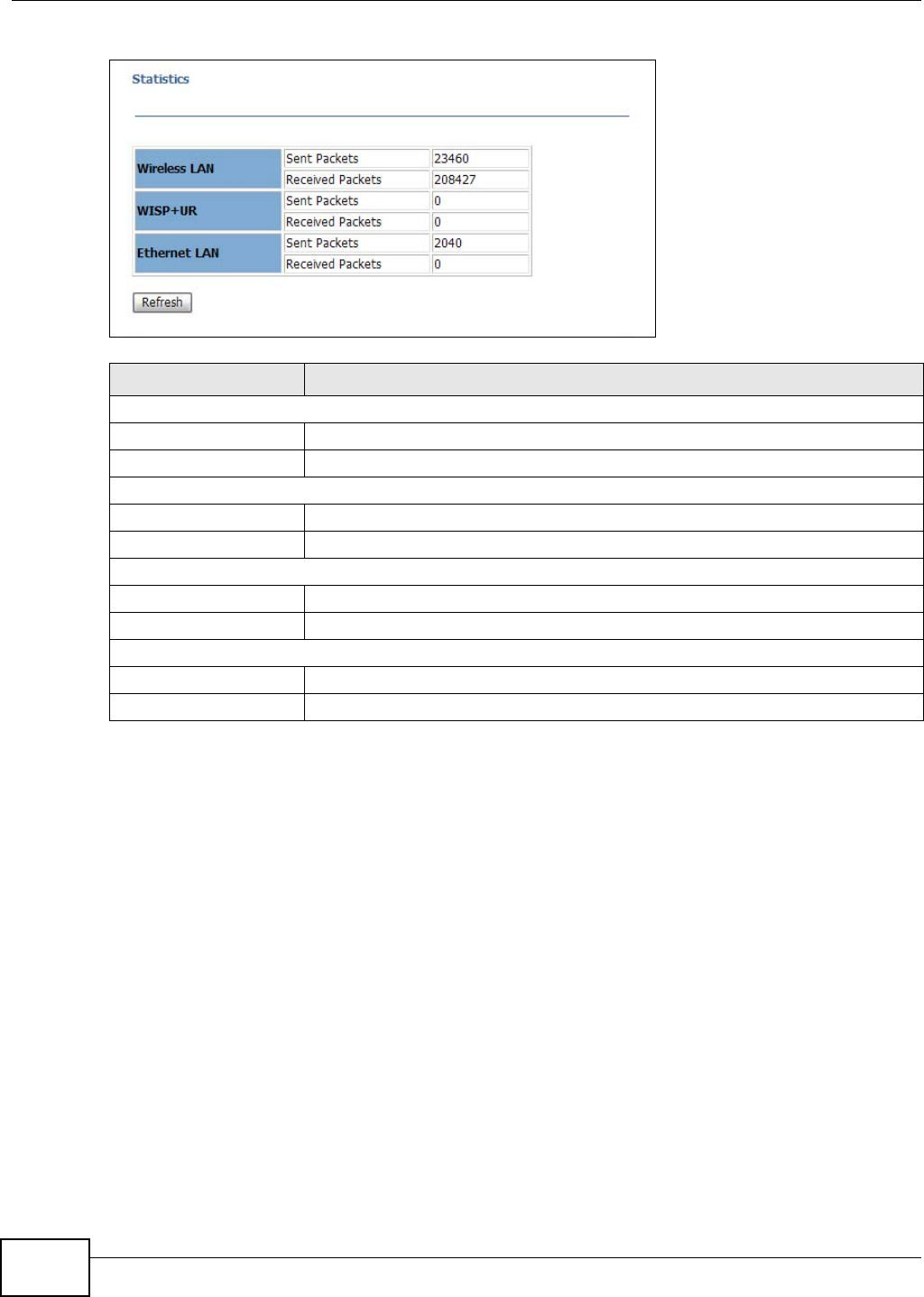
Chapter 16 Status
NBG2105 User’s Guide
118
Figure 79 Status > Statistics (WISP+UR)
16.5 System Log Screen
The Web Configurator allows you to look at all of the NBG2105’s logs in one location. Click Status >
Log.
Table 64 Status > Statistics
LABEL DESCRIPTION
Wireless LAN
Sent Packets This shows the number of packets sent through the wireless LAN interface.
Received Packets This shows the number of packets received on the wireless LAN interface.
Ethernet WAN
Sent Packets This shows the number of packets sent through the Ethernet WAN interface.
Received Packets This shows the number of packets received on the Ethernet WAN interface.
WISP+UR
Sent Packets This shows the number of packets sent through the wireless WAN interface.
Received Packets This shows the number of packets received on the wireless WAN interface.
Ethernet LAN
Sent Packets This shows the number of packets sent through the Ethernet LAN interface.
Received Packets This shows the number of packets received on the Ethernet LAN interface.
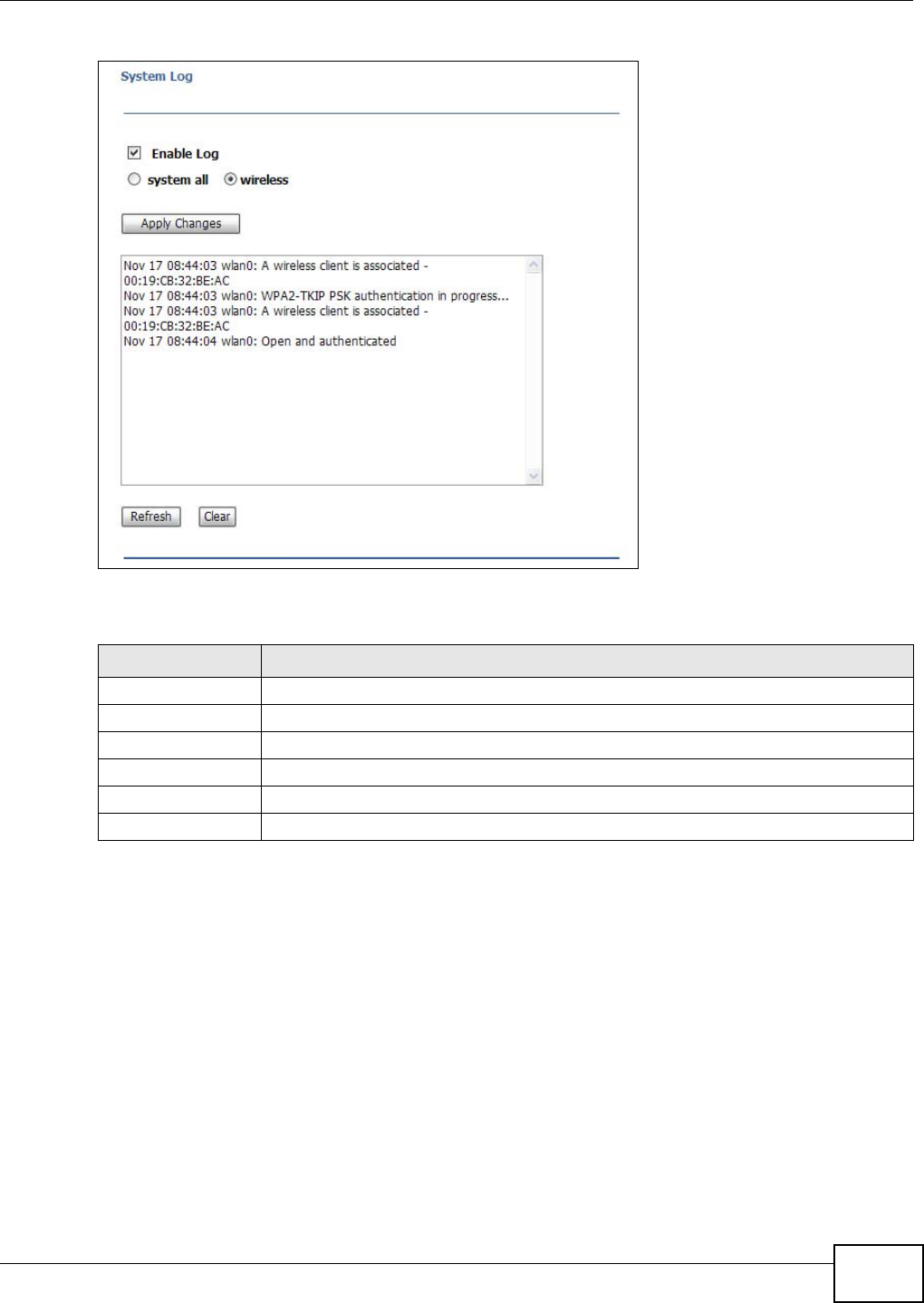
Chapter 16 Status
NBG2105 User’s Guide 119
Figure 80 Status > Log
The following table describes the labels in this screen.
Table 65 Status > Log
LABEL DESCRIPTION
Enable Log Select this to enable logging.
system all Select this to log all events, including wireless events.
wireless Select this to log only wireless events.
Apply Changes Click this to save changes back to the NBG2105.
Refresh Click this to update the screen.
Clear Click this to delete the log.

Chapter 16 Status
NBG2105 User’s Guide
120

NBG2105 User’s Guide 121
CHAPTER 17
Troubleshooting
17.1 Overview
This chapter offers some suggestions to solve problems you might encounter. The potential
problems are divided into the following categories.
•Power, Hardware Connections, and LEDs
•NBG2105 Access and Login
•Internet Access
•Resetting the NBG2105 to Its Factory Defaults
•Wireless LAN Connections
17.2 Power, Hardware Connections, and LEDs
The NBG2105 does not turn on. None of the LEDs turn on.
1Make sure you are using the power adaptor included with the NBG2105 or have connected the
NBG2105 to a computer using a USB cable.
2Make sure the power adaptor is connected to the NBG2105 and plugged in to an appropriate power
source. Make sure the power source is turned on.
3Disconnect and re-connect the power adaptor to the NBG2105.
4If the problem continues, contact the vendor.
One of the LEDs does not behave as expected.
1Make sure you understand the normal behavior of the LED. See Section 1.8.1 on page 17.
2Check the hardware connections. See the Quick Start Guide.
3Inspect your cables for damage. Contact the vendor to replace any damaged cables.
4Disconnect and re-connect the power adaptor to the NBG2105.
5If the problem continues, contact the vendor.

Chapter 17 Troubleshooting
NBG2105 User’s Guide
122
17.3 NBG2105 Access and Login
I don’t know the IP address of my NBG2105.
1The default IP address of the NBG2105 in Router mode is 192.168.1.1. The default IP address of
the NBG2105 in other modes is 192.168.1.2.
2If you changed the IP address and have forgotten it, you might get the IP address of the NBG2105
(in Router or WISP+UR mode) by looking up the IP address of the default gateway for your
computer. To do this in most Windows computers, click Start > Run, enter cmd, and then enter
ipconfig. The IP address of the Default Gateway might be the IP address of the NBG2105 (it
depends on the network), so enter this IP address in your Internet browser.
3If your NBG2105 (in Router, AP or WISP+UR mode) is a DHCP client and obtains a dynamic IP
address from a DHCP server, use the domain name "zyxelsetup.com" to access the NBG2105.
4Reset your NBG2105 to change all settings back to their default. This means your current settings
are lost. See Section 17.5 on page 124 in the Troubleshooting for information on resetting your
NBG2105.
I forgot the password.
1The default password is 1234.
2If this does not work, you have to reset the device to its factory defaults. See Section 17.5 on page
124.
I cannot see or access the Login screen in the Web Configurator.
1Make sure you are using the correct IP address.
• The default IP address of the NBG2105 in Router mode is 192.168.1.1. The default IP
address of the NBG2105 in other modes is 192.168.1.2.
• If you changed the IP address, use the new IP address.
• If you changed the IP address and have forgotten it, see the troubleshooting suggestions for I
don’t know the IP address of my NBG2105.
2Check the hardware connections, and make sure the LEDs are behaving as expected. See the Quick
Start Guide.
3Make sure your Internet browser does not block pop-up windows and has JavaScript and Java
enabled. See Appendix A on page 127.
4Make sure your computer is in the same subnet as the NBG2105.

Chapter 17 Troubleshooting
NBG2105 User’s Guide 123
• If there is a DHCP server on your network, make sure your computer is using a dynamic IP
address. See Section 9.4 on page 70.
• If there is no DHCP server on your network, make sure your computer’s IP address is in the
same subnet as the NBG2105. See Section 9.4 on page 70.
5Reset the device to its factory defaults, and try to access the NBG2105 with the default IP address.
See Section 1.5 on page 14.
6If the problem continues, contact the network administrator or vendor, or try one of the advanced
suggestions.
I can see the Login screen, but I cannot log in to the NBG2105.
1Make sure you have entered the password correctly. The default password is 1234. This field is
case-sensitive, so make sure [Caps Lock] is not on.
2This can happen when you fail to log out properly from your last session. Try logging in again after
5 minutes.
3Disconnect and re-connect the USB cable to restart the NBG2105.
4If this does not work, you have to reset the device to its factory defaults. See Section 1.5.1 on page
14.
17.4 Internet Access
I cannot access the Internet.
1Check the hardware connections, and make sure the LEDs are behaving as expected. See the Quick
Start Guide.
2Check your Operation Mode setting.
• If the NBG2105 is in Router mode make sure the WAN port is connected to a broadband
modem or router with Internet access. Your computer and the NBG2105 should be in the same
subnet.
• If the NBG2105 is in Access Point mode, make sure the Ethernet port is connected to a
broadband modem or router with Internet access and your computer is set to obtain an
dynamic IP address.
• If the NBG2105 is in Client mode, make sure the NBG2105 is wirelessly connected to an
access point or wireless router with Internet access. Your computer should be set to obtain an
dynamic IP address.
• If the NBG2105 is in WISP + UR mode, make sure the NBG2105 is wirelessly connected to an
access point or wireless router with Internet access.

Chapter 17 Troubleshooting
NBG2105 User’s Guide
124
3If the NBG2105 is in Router or WISP+UR mode make sure you entered your ISP account
information correctly in the wizard or the WAN screen. These fields are case-sensitive, so make
sure [Caps Lock] is not on.
4If you are trying to access the Internet wirelessly, make sure the wireless settings in the wireless
client are the same as the settings in the AP.
5Disconnect all the cables from your device, and follow the directions in the Quick Start Guide again.
6If the problem continues, contact your ISP.
I cannot access the Internet anymore. I had access to the Internet (with the NBG2105), but
my Internet connection is not available anymore.
1Check the hardware connections, and make sure the LEDs are behaving as expected. See the Quick
Start Guide and Section 1.8.1 on page 17.
2Reboot the NBG2105.
3If the problem continues, contact your ISP.
The Internet connection is slow or intermittent.
1There might be a lot of traffic on the network. Look at the LEDs, and check Section 1.8.1 on page
17. If the NBG2105 is sending or receiving a lot of information, try closing some programs that use
the Internet, especially peer-to-peer applications.
2Check the signal strength. If the signal strength is low, try moving the NBG2105 closer to the AP if
possible, and look around to see if there are any devices that might be interfering with the wireless
network (for example, microwaves, other wireless networks, and so on).
3Reboot the NBG2105.
4If the problem continues, contact the network administrator or vendor, or try one of the advanced
suggestions.
Advanced Suggestion
• Check the settings for QoS. If it is disabled, you might consider activating it.
17.5 Resetting the NBG2105 to Its Factory Defaults
If you reset the NBG2105, you lose all of the changes you have made. The NBG2105 re-loads its
default settings, and the password resets to 1234. You have to make all of your changes again.

Chapter 17 Troubleshooting
NBG2105 User’s Guide 125
You will lose all of your changes when you push the RESET button.
To reset the NBG2105:
1Make sure the power LED is on.
2Press the RESET button for longer than five seconds to set the NBG2105 back to its factory-default
configurations.
If the NBG2105 restarts automatically, wait for the NBG2105 to finish restarting, and log in to the
Web Configurator. The password is “1234”.
If the NBG2105 does not restart automatically, disconnect and reconnect the NBG2105’s power.
Then, follow the directions above again.
17.6 Wireless LAN Connections
I cannot access the NBG2105 or ping any computer from the WLAN.
1Make sure the wireless LAN is enabled on the NBG2105 and the NBG2105 is working in Router, AP
or WISP+UR mode.
2Make sure the wireless adapter on your computer is working properly.
3Make sure the wireless adapter installed on your computer is IEEE 802.11 compatible and supports
the same wireless standard as the NBG2105.
4Make sure your computer (with a wireless adapter installed) is within the transmission range of the
NBG2105.
5Check that both the NBG2105 and the wireless adapter on your computer are using the same
wireless and wireless security settings.
I cannot access the Web Configurator after I switched from router mode to another mode.
When you change from router mode to another mode, your computer must have an IP address in
the range between “192.168.1.3” and “192.168.1.254”.
The management IP address of the NBG2105 in other modes is 192.168.1.2.

Chapter 17 Troubleshooting
NBG2105 User’s Guide
126
What factors may cause intermittent or unstabled wireless connection? How can I solve this
problem?
The following factors may cause interference:
• Obstacles: walls, ceilings, furniture, and so on.
• Building Materials: metal doors, aluminum studs.
• Electrical devices: microwaves, monitors, electric motors, cordless phones, and other wireless
devices.
To optimize the speed and quality of your wireless connection, you can:
• Move your wireless device closer to the AP if the signal strength is low.
• Reduce wireless interference that may be caused by other wireless networks or surrounding
wireless electronics such as cordless phones.
• Place the AP where there are minimum obstacles (such as walls and ceilings) between the AP and
the wireless client.
• Reduce the number of wireless clients connecting to the same AP simultaneously, or add
additional APs if necessary.
• Try closing some programs that use the Internet, especially peer-to-peer applications. If the
wireless client is sending or receiving a lot of information, it may have too many programs open
that use the Internet.
• Position the antennas for best reception. If the AP is placed on a table or floor, point the antennas
upwards. If the AP is placed at a high position, point the antennas downwards. Try pointing the
antennas in different directions and check which provides the strongest signal to the wireless
clients.
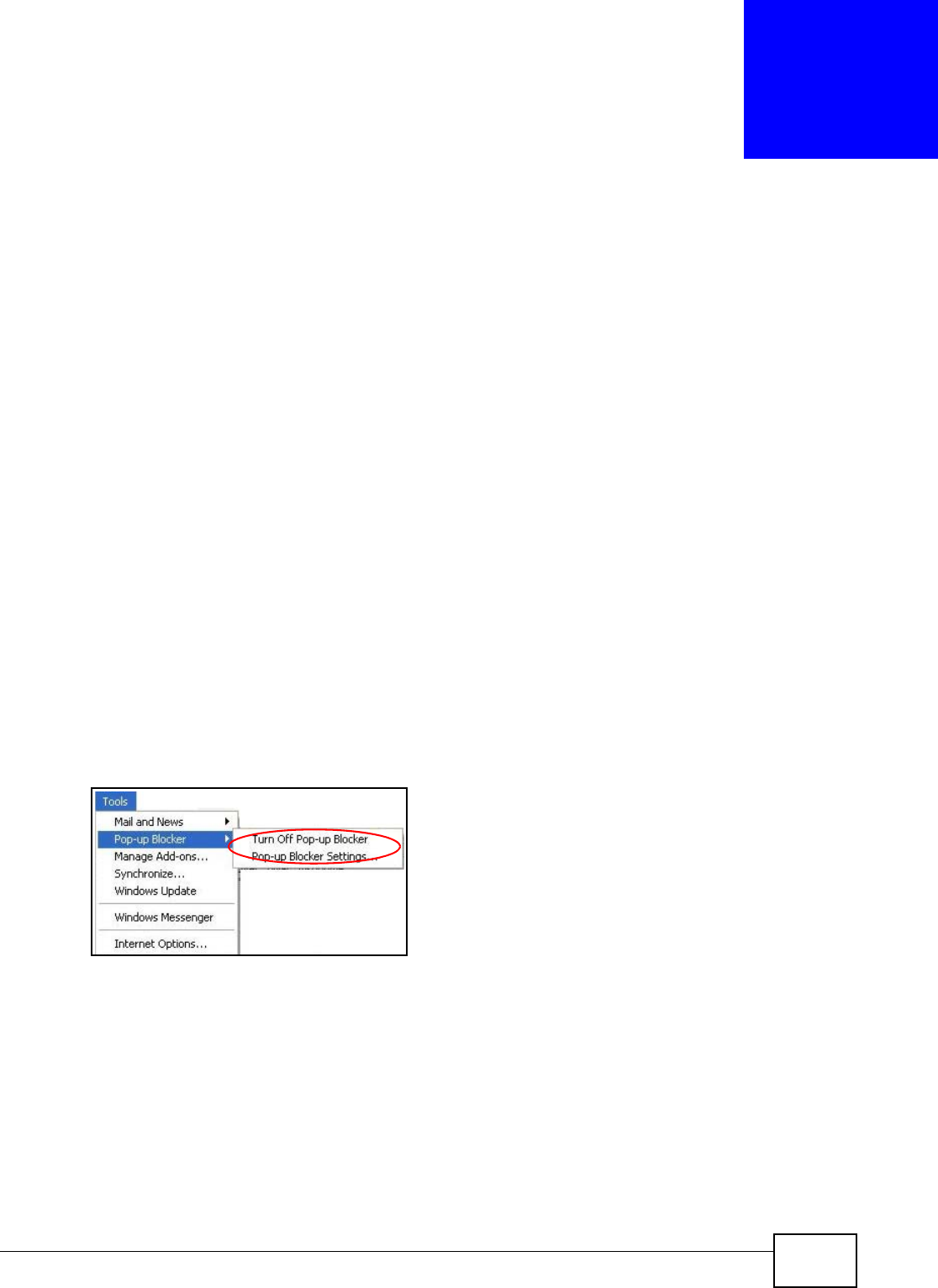
NBG2105 User’s Guide 127
APPENDIX A
Pop-up Windows, JavaScript and Java
Permissions
In order to use the web configurator you need to allow:
• Web browser pop-up windows from your device.
• JavaScript (enabled by default).
• Java permissions (enabled by default).
Note: The screens used below belong to Internet Explorer version 6, 7 and 8. Screens for
other Internet Explorer versions may vary.
Internet Explorer Pop-up Blockers
You may have to disable pop-up blocking to log into your device.
Either disable pop-up blocking (enabled by default in Windows XP SP (Service Pack) 2) or allow
pop-up blocking and create an exception for your device’s IP address.
Disable Pop-up Blockers
1In Internet Explorer, select Tools, Pop-up Blocker and then select Turn Off Pop-up Blocker.
Figure 81 Pop-up Blocker
You can also check if pop-up blocking is disabled in the Pop-up Blocker section in the Privacy tab.
1In Internet Explorer, select Tools, Internet Options, Privacy.
2Clear the Block pop-ups check box in the Pop-up Blocker section of the screen. This disables any
web pop-up blockers you may have enabled.
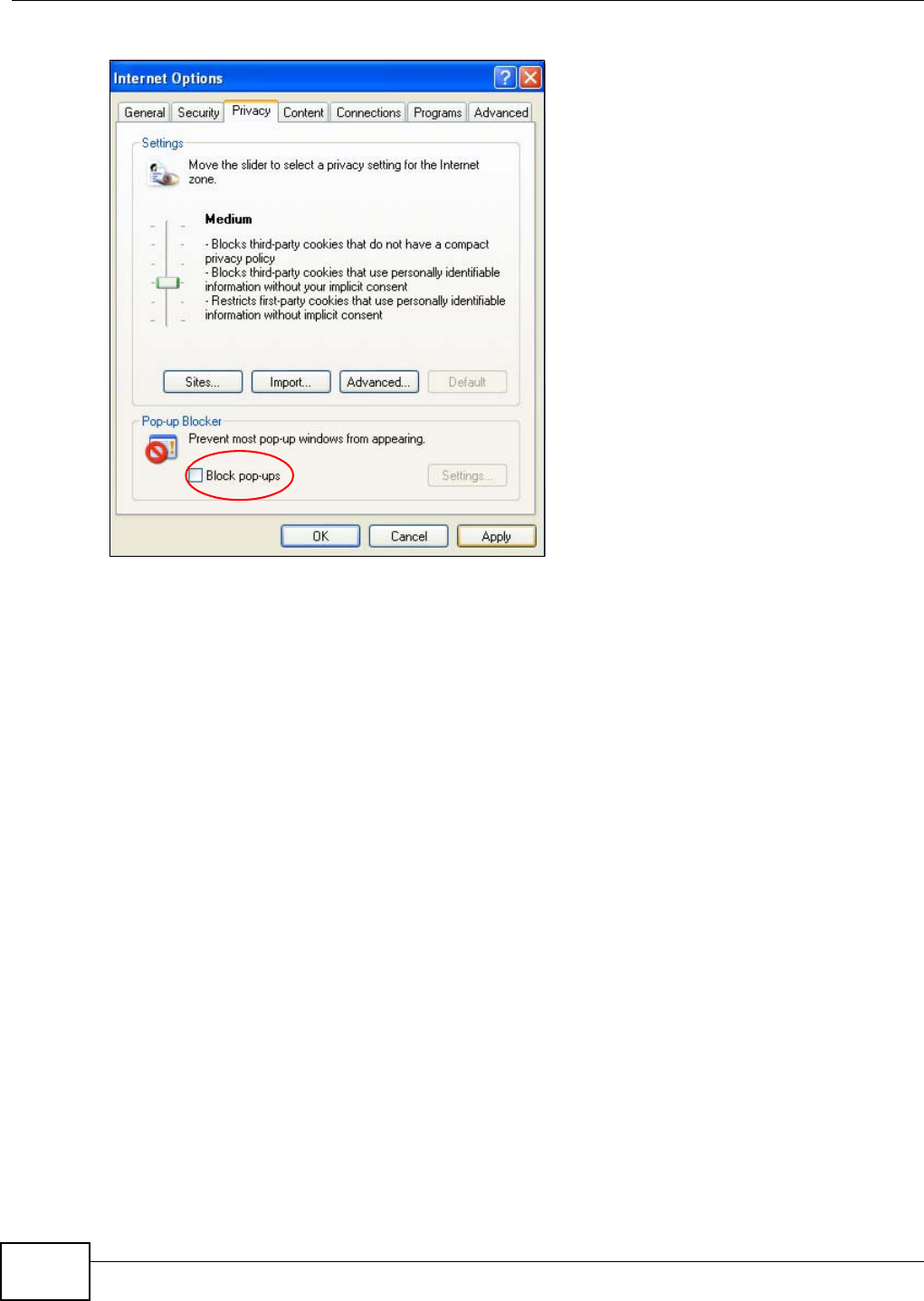
Appendix A Pop-up Windows, JavaScript and Java Permissions
NBG2105 User’s Guide
128
Figure 82 Internet Options: Privacy
3Click Apply to save this setting.
Enable Pop-up Blockers with Exceptions
Alternatively, if you only want to allow pop-up windows from your device, see the following steps.
1In Internet Explorer, select Tools, Internet Options and then the Privacy tab.
2Select Settings…to open the Pop-up Blocker Settings screen.
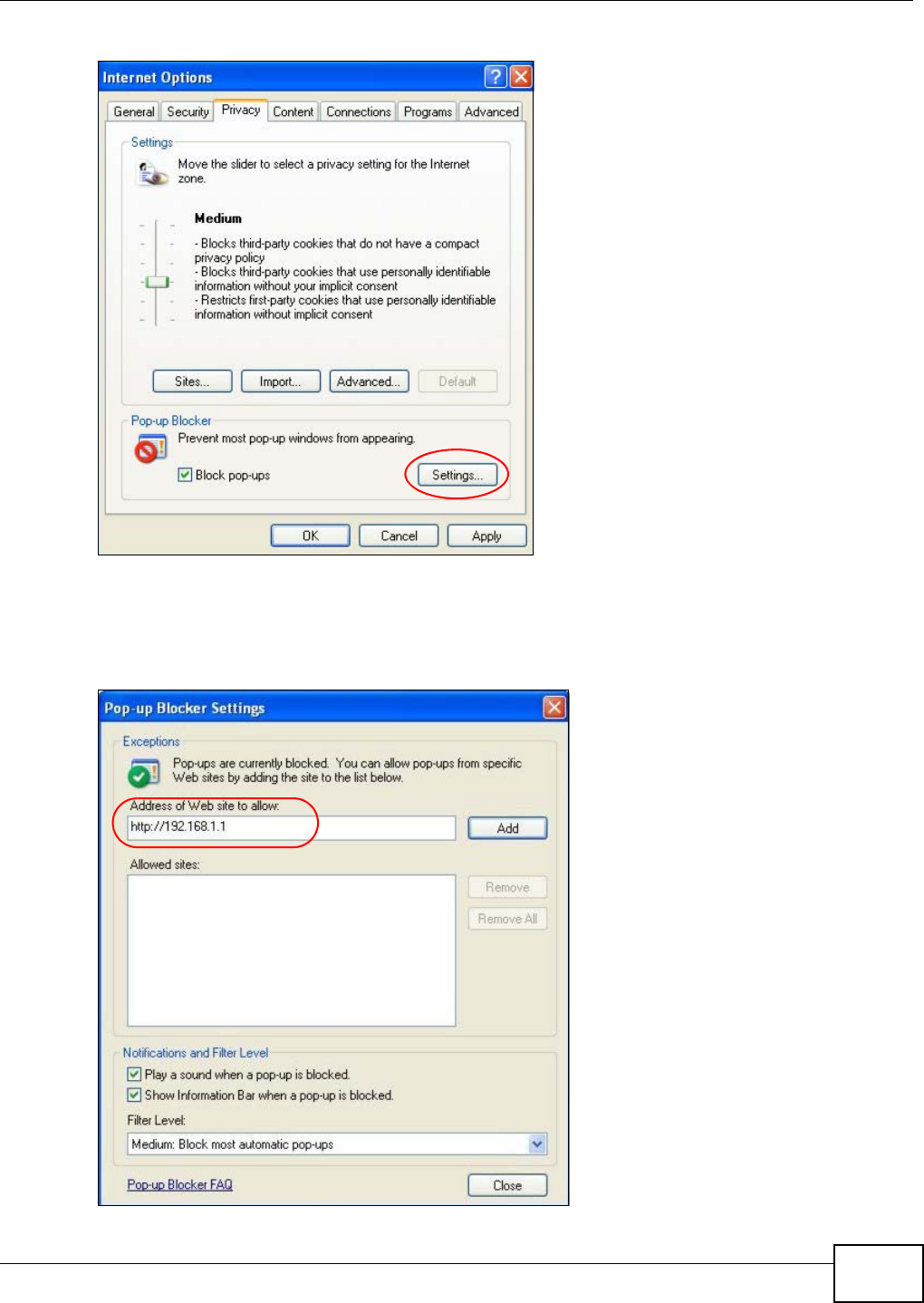
Appendix A Pop-up Windows, JavaScript and Java Permissions
NBG2105 User’s Guide 129
Figure 83 Internet Options: Privacy
3Type the IP address of your device (the web page that you do not want to have blocked) with the
prefix “http://”. For example, http://192.168.167.1.
4Click Add to move the IP address to the list of Allowed sites.
Figure 84 Pop-up Blocker Settings
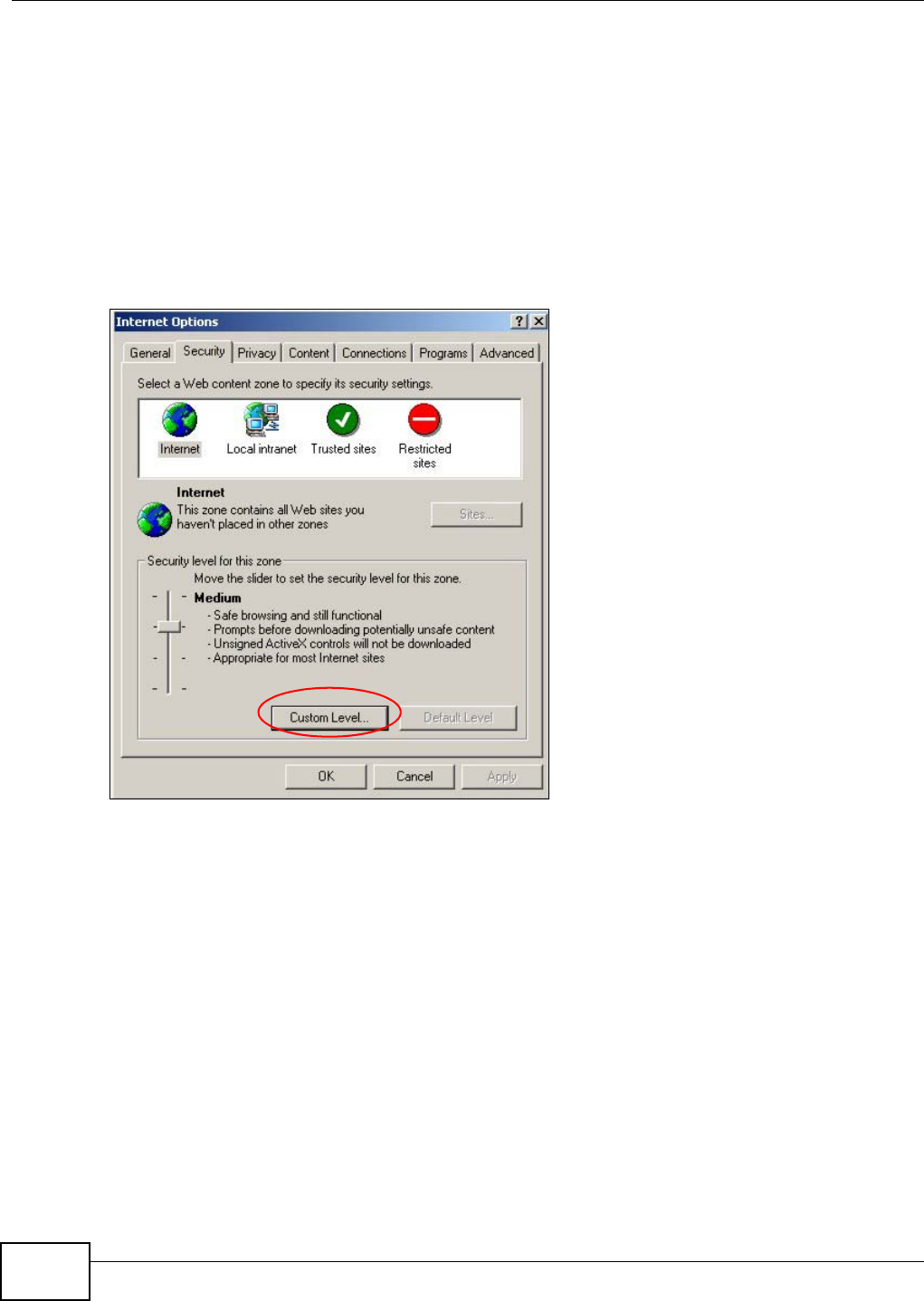
Appendix A Pop-up Windows, JavaScript and Java Permissions
NBG2105 User’s Guide
130
5Click Close to return to the Privacy screen.
6Click Apply to save this setting.
JavaScript
If pages of the web configurator do not display properly in Internet Explorer, check that JavaScript
are allowed.
1In Internet Explorer, click Tools, Internet Options and then the Security tab.
Figure 85 Internet Options: Security
2Click the Custom Level... button.
3Scroll down to Scripting.
4Under Active scripting make sure that Enable is selected (the default).
5Under Scripting of Java applets make sure that Enable is selected (the default).
6Click OK to close the window.
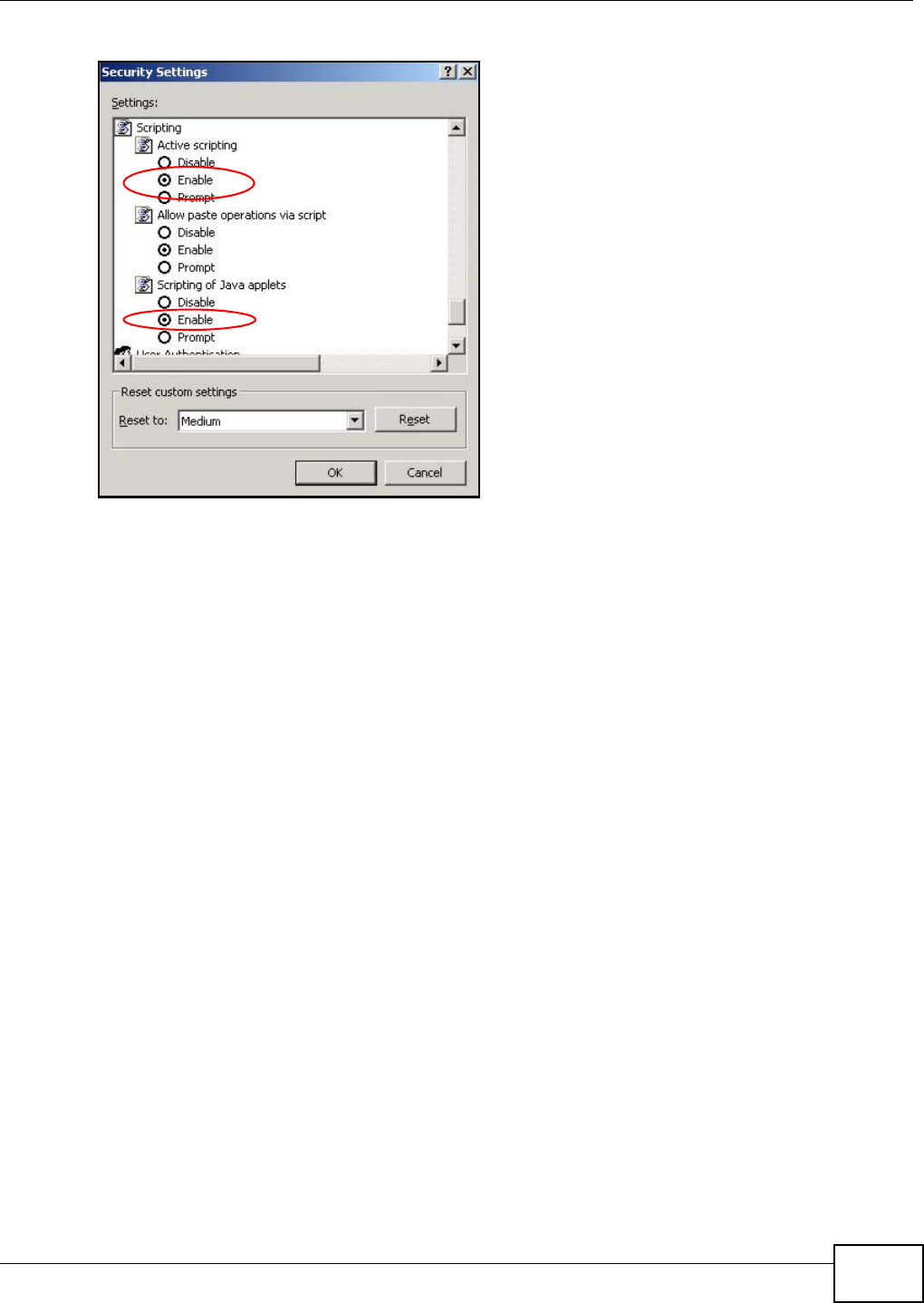
Appendix A Pop-up Windows, JavaScript and Java Permissions
NBG2105 User’s Guide 131
Figure 86 Security Settings - Java Scripting
Java Permissions
1From Internet Explorer, click Tools, Internet Options and then the Security tab.
2Click the Custom Level... button.
3Scroll down to Microsoft VM.
4Under Java permissions make sure that a safety level is selected.
5Click OK to close the window.
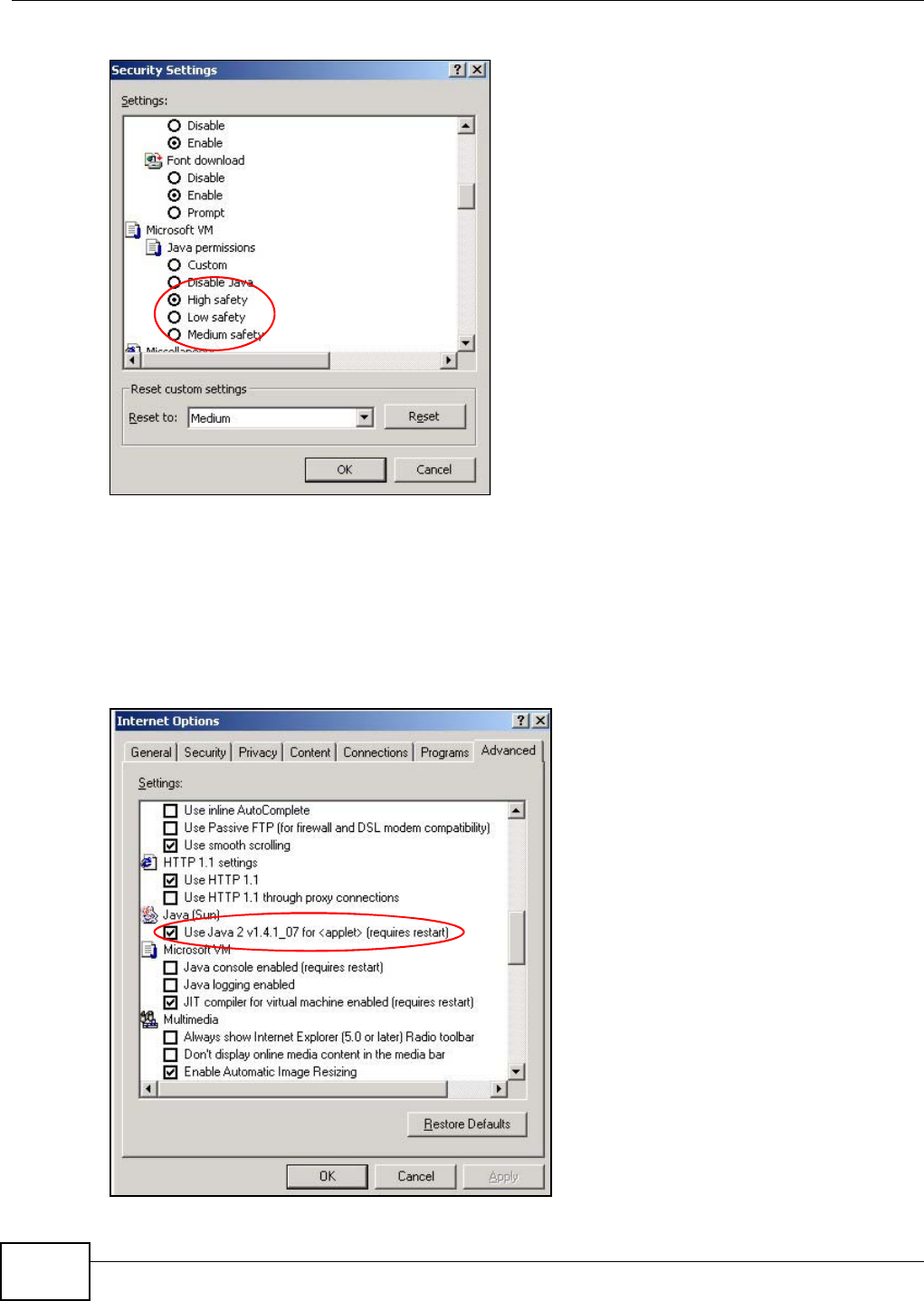
Appendix A Pop-up Windows, JavaScript and Java Permissions
NBG2105 User’s Guide
132
Figure 87 Security Settings - Java
JAVA (Sun)
1From Internet Explorer, click Tools, Internet Options and then the Advanced tab.
2Make sure that Use Java 2 for <applet> under Java (Sun) is selected.
3Click OK to close the window.
Figure 88 Java (Sun)
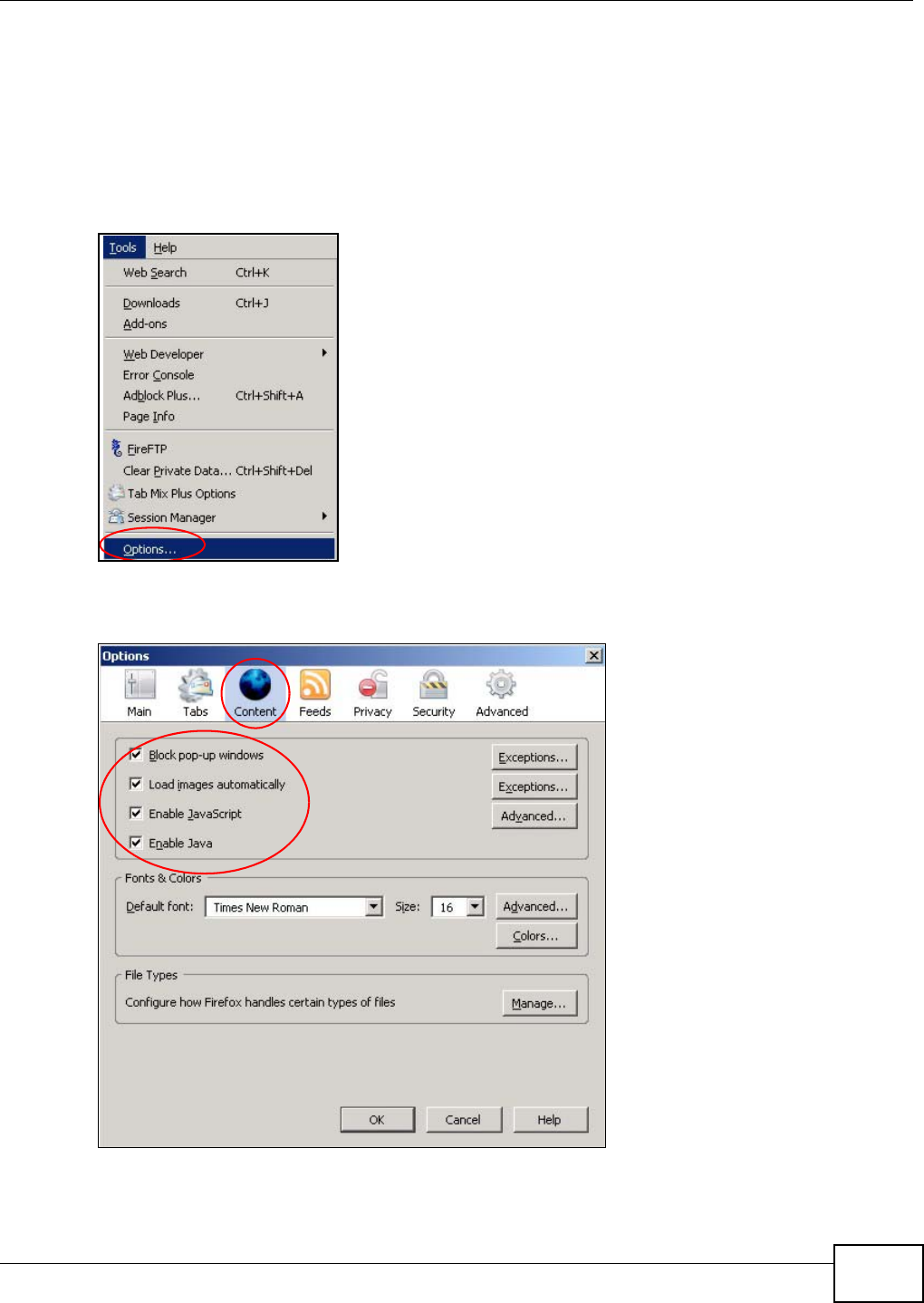
Appendix A Pop-up Windows, JavaScript and Java Permissions
NBG2105 User’s Guide 133
Mozilla Firefox
Mozilla Firefox 2.0 screens are used here. Screens for other versions may vary slightly. The steps
below apply to Mozilla Firefox 3.0 as well.
You can enable Java, Javascript and pop-ups in one screen. Click Tools, then click Options in the
screen that appears.
Figure 89 Mozilla Firefox: TOOLS > Options
Click Content to show the screen below. Select the check boxes as shown in the following screen.
Figure 90 Mozilla Firefox Content Security
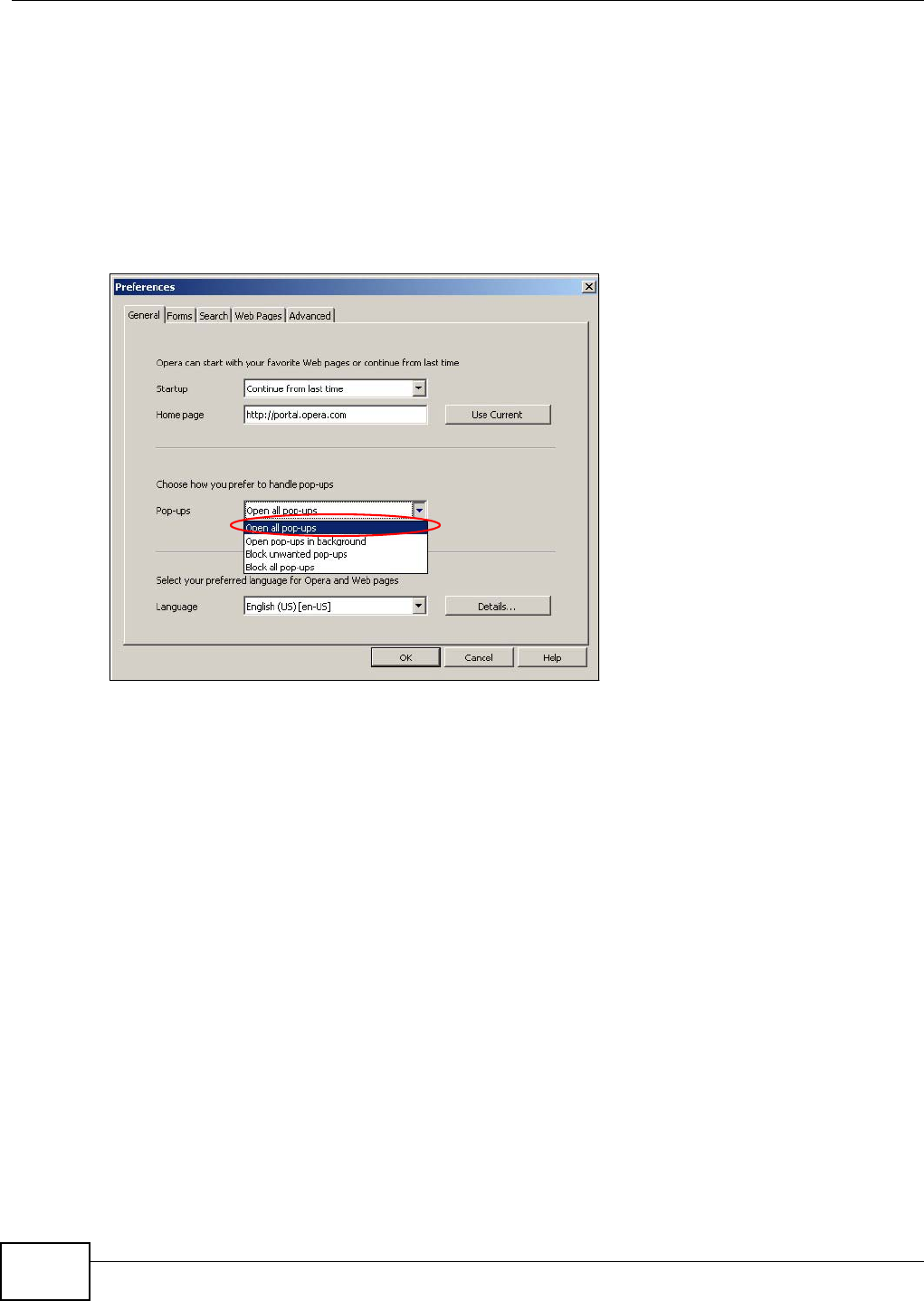
Appendix A Pop-up Windows, JavaScript and Java Permissions
NBG2105 User’s Guide
134
Opera
Opera 10 screens are used here. Screens for other versions may vary slightly.
Allowing Pop-Ups
From Opera, click Tools, then Preferences. In the General tab, go to Choose how you prefer
to handle pop-ups and select Open all pop-ups.
Figure 91 Opera: Allowing Pop-Ups
Enabling Java
From Opera, click Tools, then Preferences. In the Advanced tab, select Content from the left-
side menu. Select the check boxes as shown in the following screen.
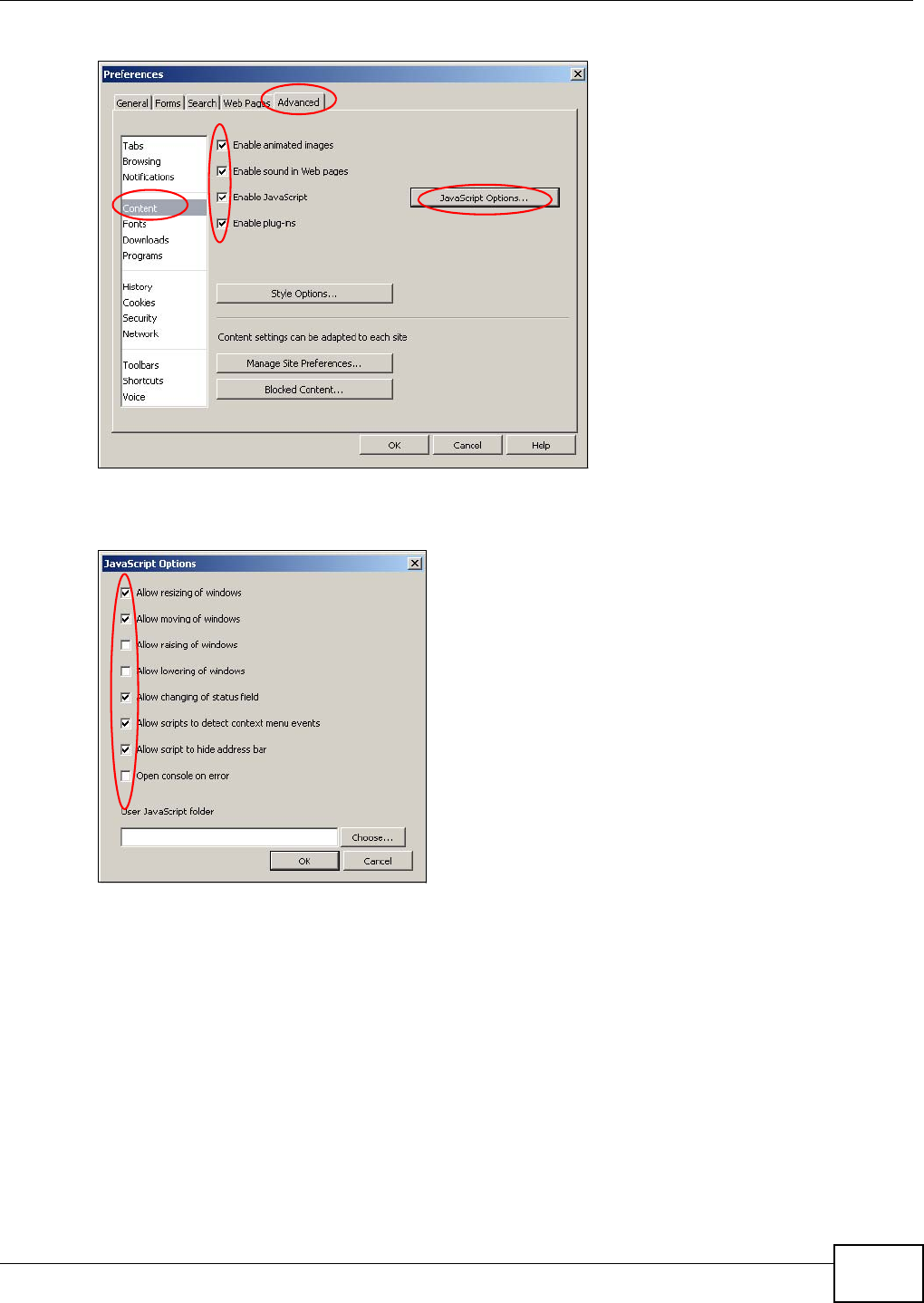
Appendix A Pop-up Windows, JavaScript and Java Permissions
NBG2105 User’s Guide 135
Figure 92 Opera: Enabling Java
To customize JavaScript behavior in the Opera browser, click JavaScript Options.
Figure 93 Opera: JavaScript Options
Select the items you want Opera’s JavaScript to apply.

Appendix A Pop-up Windows, JavaScript and Java Permissions
NBG2105 User’s Guide
136

NBG2105 User’s Guide 137
APPENDIX B
Legal Information
Copyright
Copyright © 2012 by ZyXEL Communications Corporation.
The contents of this publication may not be reproduced in any part or as a whole, transcribed, stored in a retrieval system, translated into
any language, or transmitted in any form or by any means, electronic, mechanical, magnetic, optical, chemical, photocopying, manual, or
otherwise, without the prior written permission of ZyXEL Communications Corporation.
Published by ZyXEL Communications Corporation. All rights reserved.
Disclaimer
ZyXEL does not assume any liability arising out of the application or use of any products, or software described herein. Neither does it
convey any license under its patent rights nor the patent rights of others. ZyXEL further reserves the right to make changes in any
products described herein without notice. This publication is subject to change without notice.
Trademarks
Trademarks mentioned in this publication are used for identification purposes only and may be properties of their respective owners.
Certifications
Federal Communications Commission (FCC) Interference Statement
The device complies with Part 15 of FCC rules. Operation is subject to the following two conditions:
• This device may not cause harmful interference.
• This device must accept any interference received, including interference that may cause undesired operations.
This device has been tested and found to comply with the limits for a Class B digital device pursuant to Part 15 of the FCC Rules. These
limits are designed to provide reasonable protection against harmful interference in a residential installation. This device generates, uses,
and can radiate radio frequency energy, and if not installed and used in accordance with the instructions, may cause harmful interference
to radio communications. However, there is no guarantee that interference will not occur in a particular installation.
If this device does cause harmful interference to radio/television reception, which can be determined by turning the device off and on, the
user is encouraged to try to correct the interference by one or more of the following measures:
1Reorient or relocate the receiving antenna.
2Increase the separation between the equipment and the receiver.
3Connect the equipment into an outlet on a circuit different from that to which the receiver is connected.
4Consult the dealer or an experienced radio/TV technician for help.
FCC Caution: Any changes or modifications not expressly approved by the party responsible for compliance could void the user's authority
to operate this equipment.
FCC Radiation Exposure Statement
• This transmitter must not be co-located or operating in conjunction with any other antenna or transmitter.
• IEEE 802.11b, 802.11g or 802.11n (20MHz) operation of this product in the U.S.A. is firmware-limited to channels 1 through 11. IEEE
802.11n (40MHz) operation of this product in the U.S.A. is firmware-limited to channels 3 through 9.
• To comply with FCC RF exposure compliance requirements, a separation distance of at least 20 cm must be maintained between the
antenna of this device and all persons.
Industry Canada Statement
This device complies with RSS-210 of the Industry Canada Rules. Operation is subject to the following two conditions:
1) this device may not cause interference and
2) this device must accept any interference, including interference that may cause undesired operation of the device
This device has been designed to operate with an antenna having a maximum gain of 2dBi.
Antenna having a higher gain is strictly prohibited per regulations of Industry Canada. The required antenna impedance is 50 ohms.
To reduce potential radio interference to other users, the antenna type and its gain should be so chosen that the EIRP is not more than
required for successful communication.
IC Radiation Exposure Statement
This equipment complies with IC radiation exposure limits set forth for an uncontrolled environment. End users must follow the specific
operating instructions for satisfying RF exposure compliance.
注意 !

Appendix B Legal Information
NBG2105 User’s Guide
138
依據 低功率電波輻射性電機管理辦法
第十二條 經型式認證合格之低功率射頻電機,非經許可,公司、商號或使用
者均不得擅自變更頻率、加大功率或變更原設計之特性及功能。
第十四條 低功率射頻電機之使用不得影響飛航安全及干擾合法通信;經發現
有干擾現象時,應立即停用,並改善至無干擾時方得繼續使用。
前項合法通信,指依電信規定作業之無線電信。低功率射頻電機須忍
受合法通信或工業、科學及醫療用電波輻射性電機設備之干擾。
Notices
Changes or modifications not expressly approved by the party responsible for compliance could void the user's authority to operate the
equipment.
This device is designed for the WLAN 2.4 GHz and/or 5 GHz networks throughout the EC region and Switzerland, with restrictions in
France.
Ce produit est conçu pour les bandes de fréquences 2,4 GHz et/ou 5 GHz conformément à la législation Européenne. En France
métropolitaine, suivant les décisions n°03-908 et 03-909 de l’ARCEP, la puissance d’émission ne devra pas dépasser 10 mW (10 dB) dans
le cadre d’une installation WiFi en extérieur pour les fréquences comprises entre 2454 MHz et 2483,5 MHz.
This Class B digital apparatus complies with Canadian ICES-003.
Cet appareil numérique de la classe B est conforme à la norme NMB-003 du Canada.
Viewing Certifications
Go to http://www.zyxel.com to view this product’s documentation and certifications.
ZyXEL Limited Warranty
ZyXEL warrants to the original end user (purchaser) that this product is free from any defects in material or workmanship for a specific
period (the Warranty Period) from the date of purchase. The Warranty Period varies by region. Check with your vendor and/or the
authorized ZyXEL local distributor for details about the Warranty Period of this product. During the warranty period, and upon proof of
purchase, should the product have indications of failure due to faulty workmanship and/or materials, ZyXEL will, at its discretion, repair or
replace the defective products or components without charge for either parts or labor, and to whatever extent it shall deem necessary to
restore the product or components to proper operating condition. Any replacement will consist of a new or re-manufactured functionally
equivalent product of equal or higher value, and will be solely at the discretion of ZyXEL. This warranty shall not apply if the product has
been modified, misused, tampered with, damaged by an act of God, or subjected to abnormal working conditions.
Note
Repair or replacement, as provided under this warranty, is the exclusive remedy of the purchaser. This warranty is in lieu of all other
warranties, express or implied, including any implied warranty of merchantability or fitness for a particular use or purpose. ZyXEL shall in
no event be held liable for indirect or consequential damages of any kind to the purchaser.
To obtain the services of this warranty, contact your vendor. You may also refer to the warranty policy for the region in which you bought
the device at http://www.zyxel.com/web/support_warranty_info.php.
Registration
Register your product online to receive e-mail notices of firmware upgrades and information at www.zyxel.com for global products, or at
www.us.zyxel.com for North American products.
Open Source Licenses
This product contains in part some free software distributed under GPL license terms and/or GPL like licenses. Open source licenses are
provided with the firmware package. You can download the latest firmware at www.zyxel.com. To obtain the source code covered under
those Licenses, please contact support@zyxel.com.tw to get it.
Regulatory Information
European Union
The following information applies if you use the product within the European Union.
Declaration of Conformity with Regard to EU Directive 1999/5/EC (R&TTE Directive)
Compliance Information for 2.4GHz and 5GHz Wireless Products Relevant to the EU and Other Countries Following the EU Directive 1999/5/EC
(R&TTE Directive)
[Czech] ZyXEL tímto prohlašuje, že tento zařízení je ve shodě se základními požadavky a dalšími příslušnými ustanoveními
směrnice 1999/5/EC.
[Danish] Undertegnede ZyXEL erklærer herved, at følgende udstyr udstyr overholder de væsentlige krav og øvrige relevante
krav i direktiv 1999/5/EF.
[German] Hiermit erklärt ZyXEL, dass sich das Gerät Ausstattung in Übereinstimmung mit den grundlegenden Anforderungen
und den übrigen einschlägigen Bestimmungen der Richtlinie 1999/5/EU befindet.
[Estonian] Käesolevaga kinnitab ZyXEL seadme seadmed vastavust direktiivi 1999/5/EÜ põhinõuetele ja nimetatud direktiivist
tulenevatele teistele asjakohastele sätetele.
English Hereby, ZyXEL declares that this equipment is in compliance with the essential requirements and other relevant
provisions of Directive 1999/5/EC.

Appendix B Legal Information
NBG2105 User’s Guide 139
National Restrictions
This product may be used in all EU countries (and other countries following the EU directive 1999/5/EC) without any limitation except for
the countries mentioned below:
Ce produit peut être utilisé dans tous les pays de l’UE (et dans tous les pays ayant transposés la directive 1999/5/CE) sans aucune
limitation, excepté pour les pays mentionnés ci-dessous:
Questo prodotto è utilizzabile in tutte i paesi EU (ed in tutti gli altri paesi che seguono le direttive EU 1999/5/EC) senza nessuna
limitazione, eccetto per i paesii menzionati di seguito:
Das Produkt kann in allen EU Staaten ohne Einschränkungen eingesetzt werden (sowie in anderen Staaten die der EU Direktive 1995/5/CE
folgen) mit Außnahme der folgenden aufgeführten Staaten:
In the majority of the EU and other European countries, the 2, 4- and 5-GHz bands have been made available for the use of wireless local
area networks (LANs). Later in this document you will find an overview of countries inwhich additional restrictions or requirements or both
are applicable.
The requirements for any country may evolve. ZyXEL recommends that you check with the local authorities for the latest status of their
national regulations for both the 2,4- and 5-GHz wireless LANs.
The following countries have restrictions and/or requirements in addition to those given in the table labeled “Overview of Regulatory
Requirements for Wireless LANs”:.
[Spanish] Por medio de la presente ZyXEL declara que el equipo cumple con los requisitos esenciales y cualesquiera otras
disposiciones aplicables o exigibles de la Directiva 1999/5/CE.
[Greek] ΜΕ ΤΗΝ ΠΑΡΟΥΣΑ ZyXEL ΔΗΛΩΝΕΙ ΟΤΙ εξοπλισμός ΣΥΜΜΟΡΦΩΝΕΤΑΙ ΠΡΟΣ ΤΙΣ ΟΥΣΙΩΔΕΙΣ ΑΠΑΙΤΗΣΕΙΣ ΚΑΙ ΤΙΣ
ΛΟΙΠΕΣ ΣΧΕΤΙΚΕΣ ΔΙΑΤΑΞΕΙΣ ΤΗΣ ΟΔΗΓΙΑΣ 1999/5/ΕC.
[French] Par la présente ZyXEL déclare que l'appareil équipements est conforme aux exigences essentielles et aux autres
dispositions pertinentes de la directive 1999/5/EC.
[Italian] Con la presente ZyXEL dichiara che questo attrezzatura è conforme ai requisiti essenziali ed alle altre disposizioni
pertinenti stabilite dalla direttiva 1999/5/CE.
[Latvian] Ar šo ZyXEL deklarē, ka iekārtas atbilst Direktīvas 1999/5/EK būtiskajām prasībām un citiem ar to saistītajiem
noteikumiem.
[Lithuanian] Šiuo ZyXEL deklaruoja, kad šis įranga atitinka esminius reikalavimus ir kitas 1999/5/EB Direktyvos nuostatas.
[Dutch] Hierbij verklaart ZyXEL dat het toestel uitrusting in overeenstemming is met de essentiële eisen en de andere
relevante bepalingen van richtlijn 1999/5/EC.
[Maltese] Hawnhekk, ZyXEL, jiddikjara li dan tagħmir jikkonforma mal-ħtiġijiet essenzjali u ma provvedimenti oħrajn relevanti li
hemm fid-Dirrettiva 1999/5/EC.
[Hungarian] Alulírott, ZyXEL nyilatkozom, hogy a berendezés megfelel a vonatkozó alapvetõ követelményeknek és az 1999/5/EK
irányelv egyéb elõírásainak.
[Polish] Niniejszym ZyXEL oświadcza, że sprzęt jest zgodny z zasadniczymi wymogami oraz pozostałymi stosownymi
postanowieniami Dyrektywy 1999/5/EC.
[Portuguese] ZyXEL declara que este equipamento está conforme com os requisitos essenciais e outras disposições da Directiva
1999/5/EC.
[Slovenian] ZyXEL izjavlja, da je ta oprema v skladu z bistvenimi zahtevami in ostalimi relevantnimi določili direktive 1999/5/EC.
[Slovak] ZyXEL týmto vyhlasuje, že zariadenia spĺňa základné požiadavky a všetky príslušné ustanovenia Smernice 1999/5/EC.
[Finnish] ZyXEL vakuuttaa täten että laitteet tyyppinen laite on direktiivin 1999/5/EY oleellisten vaatimusten ja sitä koskevien
direktiivin muiden ehtojen mukainen.
[Swedish] Härmed intygar ZyXEL att denna utrustning står I överensstämmelse med de väsentliga egenskapskrav och övriga
relevanta bestämmelser som framgår av direktiv 1999/5/EC.
[Bulgarian] С настоящото ZyXEL декларира, че това оборудване е в съответствие със съществените изисквания и другите
приложими разпоредбите на Директива 1999/5/ЕC.
[Icelandic] Hér með lýsir, ZyXEL því yfir að þessi búnaður er í samræmi við grunnkröfur og önnur viðeigandi ákvæði tilskipunar
1999/5/EC.
[Norwegian] Erklærer herved ZyXEL at dette utstyret er I samsvar med de grunnleggende kravene og andre relevante
bestemmelser I direktiv 1999/5/EF.
[Romanian] Prin prezenta, ZyXEL declară că acest echipament este în conformitate cu cerinţele esenţiale şi alte prevederi
relevante ale Directivei 1999/5/EC.
Overview of Regulatory Requirements for Wireless LANs
Frequency Band (MHz) Max Power Level
(EIRP)1 (mW) Indoor ONLY Indoor and Outdoor

Appendix B Legal Information
NBG2105 User’s Guide
140
Belgium
The Belgian Institute for Postal Services and Telecommunications (BIPT) must be notified of any outdoor wireless link having a range
exceeding 300 meters. Please check http://www.bipt.be for more details.
Draadloze verbindingen voor buitengebruik en met een reikwijdte van meer dan 300 meter dienen aangemeld te worden bij het Belgisch
Instituut voor postdiensten en telecommunicatie (BIPT). Zie http://www.bipt.be voor meer gegevens.
Les liaisons sans fil pour une utilisation en extérieur d’une distance supérieure à 300 mètres doivent être notifiées à l’Institut Belge des
services Postaux et des Télécommunications (IBPT). Visitez http://www.ibpt.be pour de plus amples détails.
Denmark
In Denmark, the band 5150 - 5350 MHz is also allowed for outdoor usage.
I Danmark må frekvensbåndet 5150 - 5350 også anvendes udendørs.
France
For 2.4 GHz, the output power is restricted to 10 mW EIRP when the product is used outdoors in the band 2454 - 2483.5 MHz. There are
no restrictions when used indoors or in other parts of the 2.4 GHz band. Check http://www.arcep.fr/ for more details.
Pour la bande 2.4 GHz, la puissance est limitée à 10 mW en p.i.r.e. pour les équipements utilisés en extérieur dans la bande 2454 -
2483.5 MHz. Il n'y a pas de restrictions pour des utilisations en intérieur ou dans d'autres parties de la bande 2.4 GHz. Consultez http://
www.arcep.fr/ pour de plus amples détails.
Italy
This product meets the National Radio Interface and the requirements specified in the National Frequency Allocation Table for Italy. Unless
this wireless LAN product is operating within the boundaries of the owner's property, its use requires a “general authorization.” Please
check http://www.sviluppoeconomico.gov.it/ for more details.
Questo prodotto è conforme alla specifiche di Interfaccia Radio Nazionali e rispetta il Piano Nazionale di ripartizione delle frequenze in
Italia. Se non viene installato all 'interno del proprio fondo, l'utilizzo di prodotti Wireless LAN richiede una “Autorizzazione Generale”.
Consultare http://www.sviluppoeconomico.gov.it/ per maggiori dettagli.
Latvia
The outdoor usage of the 2.4 GHz band requires an authorization from the Electronic Communications Office. Please check http://
www.esd.lv for more details.
2.4 GHz frekvenèu joslas izmantoðanai ârpus telpâm nepiecieðama atïauja no Elektronisko sakaru direkcijas. Vairâk informâcijas: http://www.esd.lv.
Notes:
1. Although Norway, Switzerland and Liechtenstein are not EU member states, the EU Directive 1999/5/EC has also been implemented in
those countries.
2. The regulatory limits for maximum output power are specified in EIRP. The EIRP level (in dBm) of a device can be calculated by adding
the gain of the antenna used(specified in dBi) to the output power available at the connector (specified in dBm).
2400-2483.5 100 V
5150-5350 200 V
5470-5725 1000 V
R&TTE 1999/5/EC
WLAN 2.4 – 2.4835 GHz
IEEE 802.11 b/g/n
Location Frequency Range (GHz) Power (EIRP)
Indoor (No restrictions) 2.4 – 2.4835 100mW (20dBm)
Outdoor 2.4 – 2.454 100mW (20dBm)
2.454 – 2.4835 10mW (10dBm)

Appendix B Legal Information
NBG2105 User’s Guide 141
List of national codes
Safety Warnings
• Do NOT use this product near water, for example, in a wet basement or near a swimming pool.
• Do NOT expose your device to dampness, dust or corrosive liquids.
• Do NOT store things on the device.
• Do NOT install, use, or service this device during a thunderstorm. There is a remote risk of electric shock from lightning.
• Connect ONLY suitable accessories to the device.
• Do NOT open the device or unit. Opening or removing covers can expose you to dangerous high voltage points or other risks. ONLY
qualified service personnel should service or disassemble this device. Please contact your vendor for further information.
• Make sure to connect the cables to the correct ports.
• Place connecting cables carefully so that no one will step on them or stumble over them.
• Always disconnect all cables from this device before servicing or disassembling.
• Use ONLY an appropriate power adaptor or cord for your device.
• Connect the power adaptor or cord to the right supply voltage (for example, 110V AC in North America or 230V AC in Europe).
• Do NOT allow anything to rest on the power adaptor or cord and do NOT place the product where anyone can walk on the power
adaptor or cord.
• Do NOT use the device if the power adaptor or cord is damaged as it might cause electrocution.
• If the power adaptor or cord is damaged, remove it from the power outlet.
• Do NOT attempt to repair the power adaptor or cord. Contact your local vendor to order a new one.
• Do not use the device outside, and make sure all the connections are indoors. There is a remote risk of electric shock from lightning.
• Do NOT obstruct the device ventilation slots, as insufficient airflow may harm your device.
• Antenna Warning! This device meets ETSI and FCC certification requirements when using the included antenna(s). Only use the
included antenna(s).
• If you wall mount your device, make sure that no electrical lines, gas or water pipes will be damaged.
Your product is marked with this symbol, which is known as the WEEE mark. WEEE stands for Waste Electronics and
Electrical Equipment. It means that used electrical and electronic products should not be mixed with general waste. Used
electrical and electronic equipment should be treated separately.
COUNTRY ISO 3166 2 LETTER CODE COUNTRY ISO 3166 2 LETTER CODE
Austria AT Malta MT
Belgium BE Netherlands NL
Cyprus CY Poland PL
Czech Republic CR Portugal PT
Denmark DK Slovakia SK
Estonia EE Slovenia SI
Finland FI Spain ES
France FR Sweden SE
Germany DE United Kingdom GB
Greece GR Iceland IS
Hungary HU Liechtenstein LI
Ireland IE Norway NO
Italy IT Switzerland CH
Latvia LV Bulgaria BG
Lithuania LT Romania RO
Luxembourg LU Turkey TR

Appendix B Legal Information
NBG2105 User’s Guide
142

Index
NBG2105 User’s Guide 143
Index
A
Address Assignment 74
Advanced Encryption Standard 85
AP 13
AP mode 24
menus 26
navigation 25
setting 25
wizard 41
AP+Bridge 13
authentication type 85
auto 85
open system 85
shared key 85
auto authentication 85
B
bandwidth 79
Bridge/Repeater 13
C
CCMP 85
certifications 137
notices 138
viewing 138
channel 84
client mode 27
menus 28
navigation 27
setting 27
wizard 45
copyright 137
D
DDNS 81
see also Dynamic DNS
disclaimer 137
DNS Server 74
documentation
related 2
Domain Name System. See DNS.
downstream bandwidth 80
Dynamic DNS 81
E
encryption type 85
F
FCC interference statement 137
Firewall 99
Firewall overview
guidelines 99
network security
firewall
IP filtering 101
MAC filtering 101
port filtering 100
URL filtering 102
G
Guide
Quick Start 2

Index
NBG2105 User’s Guide144
L
LAN 69
LAN overview 69
Local Area Network 69
M
MAC address 86
cloning 74
MAC address filter 86
managing the device
good habits 13
using the web configurator. See web configurator.
using the WPS. See WPS.
MBSSID 13
Message Integrity Check (MIC) 85
mode 13
O
operating mode 13
operation mode 21
access point 21
AP 21, 24
client 21, 27
overview 21
router 21
switch 21
WISP+UR 21, 29
other documentation 2
P
packet filtering firewall 99
Point-to-Point Protocol over Ethernet 53, 76
PPPoE 53, 76
dial-up connection
product registration 138
PSK 85
Q
QoS 79
Quality of Service 79
Quick Start Guide 2
R
registration
product 138
related documentation 2
Reset button 14
Reset the device 14
router mode 21
menus 23
navigation 22
setting 22
wizard 33
RTS/CTS Threshold 83
S
security 85
data encryption 85
Service Set IDentity. See SSID.
SSID 84
System restart 110
T
Temporal Key Integrity Protocol (TKIP) 85
trademarks 137
U
universal repeater 29
upstream bandwidth 80
UR 29

Index
NBG2105 User’s Guide 145
W
WAN (Wide Area Network) 73
warranty 138
note 138
Web Configurator
how to access 19
Overview 19
web configurator 13
WEP (Wired Equivalent Privacy) 85
Wi-Fi Protected Access 85
wireless ISP 29
Wireless network
basic guidelines 83
channel 84
example 83
MAC address filter 86
overview 83
security 84
SSID 84
Wireless security 84
overview 84
type 84
Wireless tutorial 59
WISP 29
WISP+UR mode 29
example 29
menus 30
navigation 29
setting 29
wizard 51
WLAN button 14
WPA 85
vs WPA-PSK 85
WPA2 85
vs WPA2-PSK 85
WPA2-PSK 85
WPA-PSK 85
WPS 13

Index
NBG2105 User’s Guide146